

The Cost of Travel in Tunisia: A 2023 Budget Breakdown
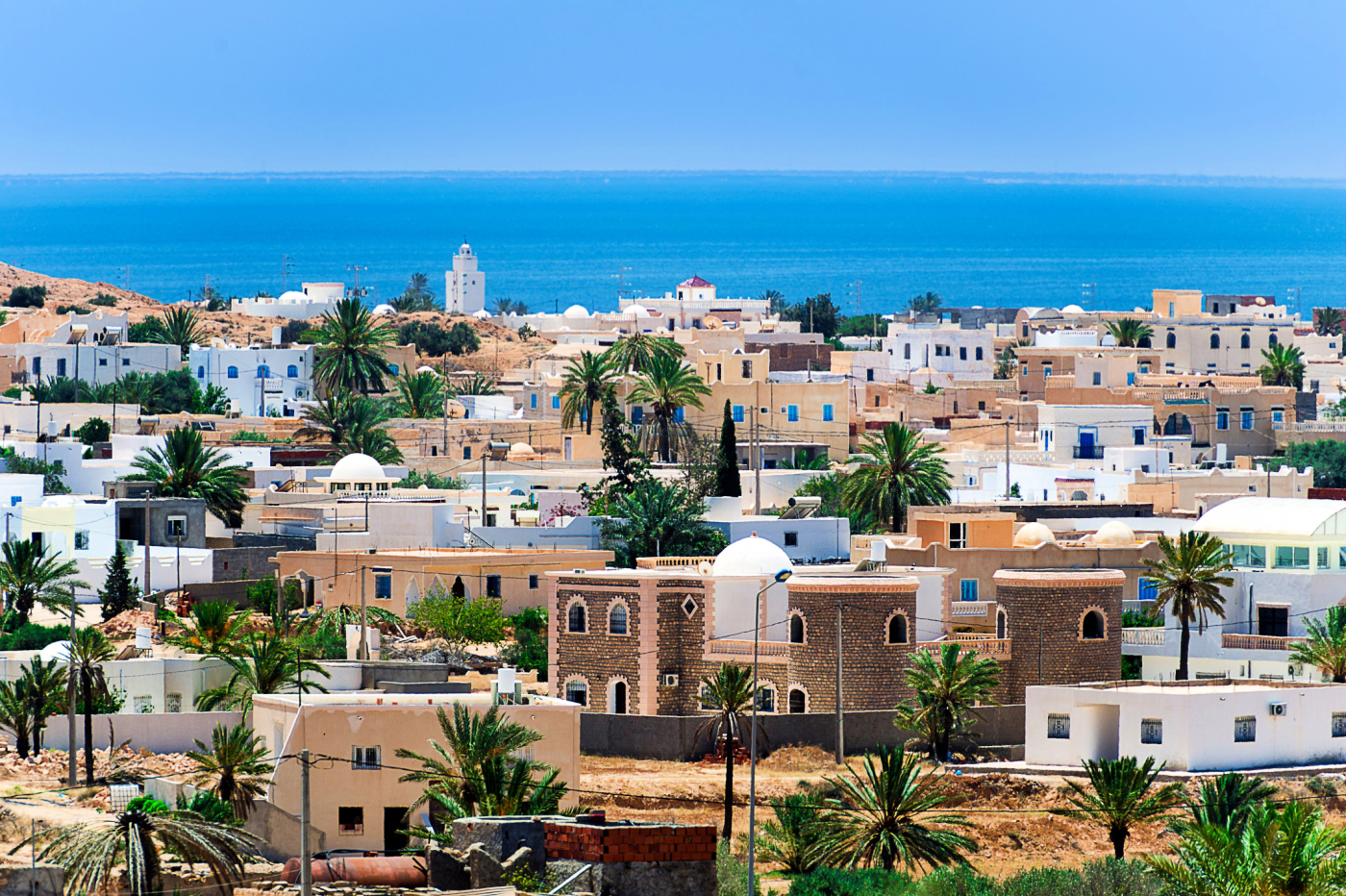
Tunisia is a pretty cheap country to visit. A less visited part of the North African coast, its tourism industry isn’t quite as developed as Egypt or Morocco, which makes it an excellent place to go if you’re somebody who likes to take the road less traveled.
There’s so much to love about Tunisia, starting with Tunis, the country’s capital, which contains an estimated 700,000 people. Easily the most bustling place in the nation, the city is a fascinating mix of architecture, speaking to the shifting history of the area. In the Islamic part of town, you can wander the sprawling alleyways of the medina, replete with beautiful mosques alongside numerous vendors of souvenirs and street food. This abuts the former French colonial district, featuring grand mansion blocks designed in the Belle Epoque style and watched over by the striking Cathedral of Saint Vincent de Paul, completed in 1897.
To the northeast of the town center, you will find the storied ruins of Ancient Carthage, some dating back more than 2,000 years. Perched atop the nearby cliffs, overlooking the sea, are the blue and white buildings of Sidi Bou Said, which lend a Greek island vibe to the city.
Thanks to the network of cheap trains and the availability of affordable taxis in the main cities, transport is wonderfully convenient. You can escape to the white sand beaches of Hammamet in under two hours from Tunis, or head further south, to the cities of Sousse, El Jem and Kairouan, for a deeper glimpse into the country’s past. These parts of the country are home to some impressive 1st millennium AD fortifications and mosques, as well as one of the best-preserved Roman amphitheaters in the world.
To the west, you will find two preserved former Roman settlements, Dougga and Bulla Regia. Situated in quiet countryside, the former was once a buzzing metropolis of 3,500 people, while the latter has some fascinating subterranean villas to excavate.
If you’re coming to Tunisia for the beaches, it’s obviously best to visit during the heat of the summer, when temperatures rise to around 86 degrees Fahrenheit (30 degrees Celsius). Otherwise, it is arguably better to travel to the country in the spring, when everything is less swelteringly hot.
One of the downsides of being a less popular destination is that there tend to be fewer really cheap accommodation options in Tunisia. That doesn’t mean you should expect to spend a great deal of money on your lodgings – unless you want to go for five-star luxury – but it does mean you won’t find hostels for a mere $10-20, as you can in places that have a steady stream of backpackers filtering through.
In this post, I’m going to help you figure out approximately how much you should budget for your trip. I will cover the cost of accommodation, both at the cheaper end of the scale and at the more luxurious end of the scale, as well as how much you should expect to pay for taxis, trains and the local ‘louages’ (more on that later).
Once you have finished reading, you will have a pretty good idea of the cost of food, as well as the entrance fees and tour prices for some of the most popular experiences that Tunisia has to offer.
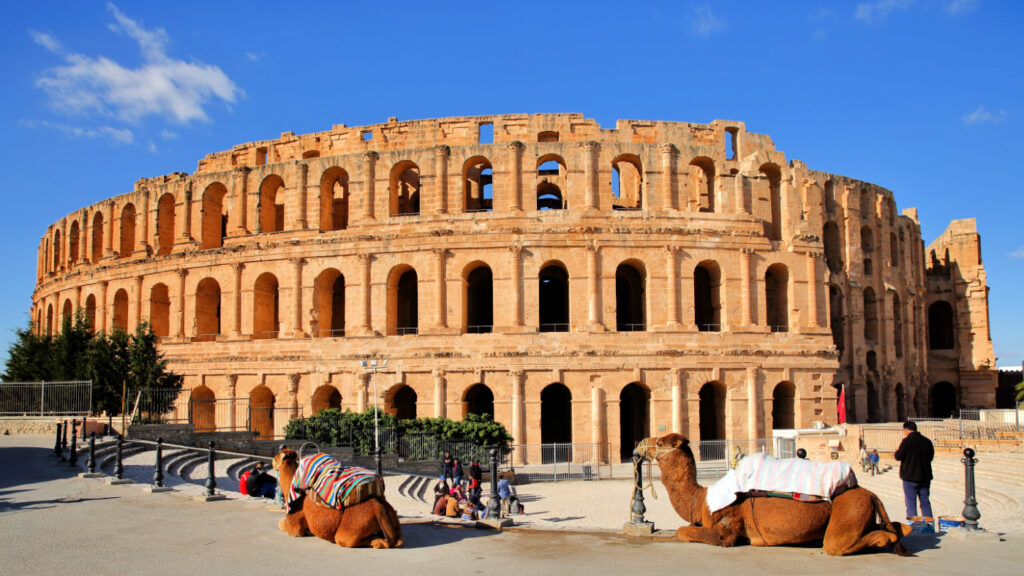
Where to Go
In this post, I will just briefly take you through some of the country’s highlights, before getting onto the amount you should expect to spend on your trip.
In general, I would advocate spending between two and three days in Tunis, followed by a day excursion to the old Roman habitations to the west. After that, you can journey south to see some of Tunisia’s other major cities and towns. I have also included plenty of time for rest and relaxation at the end of the trip, so you return home feeling rested and refreshed.
Since Tunis is the only city with a major airport, it makes sense to begin and end your journey there, with forays west and south of the capital in the middle.
For convenience, I chose to base myself out of just three cities: Tunis, Sousse and Hammamet, though I’ve also included some options for Kairouan stays since there is a bit more to check out there and it’s not as simple to reach on a daytrip as the other places I visited.
You could of course also spend overnight stays in El Jem and Monastir. Just bear in mind that El Jem has very little to explore aside from the absolutely must-see amphitheater, while Monastir is so conveniently reachable from Sousse via the Sahel Metro that there hardly seems much point in changing accommodations just for a day.
- Day One: Tunis
- Day Two: Tunis
- Day Three: Tunis
- Day Four: Dougga and Bulla Regia
- Day Five: Sousse
- Day Six: Kairouan
- Day Seven: El Jem and Monastir
- Day Eight: Hammamet
- Day Nine: Hammamet
- Day Ten: Tunis
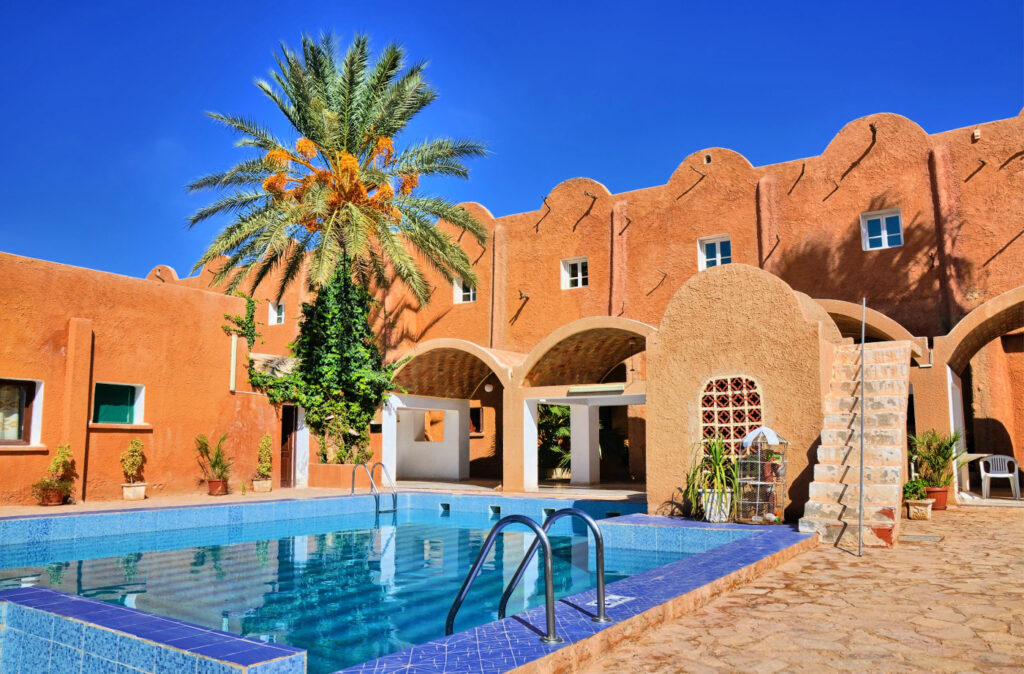
The Cost of Accommodation in Tunisia
Tourism isn’t that developed in Tunisia, which means your options are relatively limited when it comes to accommodation That’s not to say you’re completely devoid of choice, just don’t expect a great deal of hostels or housesitting opportunities.
Overall, the prices are affordable, though you’ll be hard pressed to find the kind of quirky, super cheap spots you can find along more well-traveled tourist routes. On the other end of the scale, it’s also fairly hard to spend a great deal of money, though you can of course splurge if you want a luxurious room at the Four Seasons , located along the most upmarket part of the Tunis coastline in Gammarth.
I opted to stay mainly in the larger cities, and then travel from there on daytrips to other locations. This meant less lugging my luggage around – which is always a bonus!
Before we get stuck into the real meat of the choices, there are a couple of ways you can stay in the country for free. First is through couch surfing. There is of course the pioneering Couchsurfing site, which requires a subscription fee for you to sign up, before allowing you access to the thousands of people in Tunisia willing to host travelers for no cost. A newer entrant on the scene is Travel Ladies , which is an app specifically aimed at female couch surfers looking to stay with other women. There are far fewer people on here, but it’s a solid concept, so worth checking out.
Another free alternative is housesitting . Again, there isn’t a great deal on offer in Tunisia, but still worth a look on the off chance that you find a gorgeous pad and don’t mind keeping an eye on a pet in exchange for free accommodation.
Alternatively, if you are looking for value rather than something completely free, there are some cheap options out there. Sure, you won’t find the same profusion of hostels as you would find in destinations like Vietnam or Peru , but there are some comfortable, basic stays for under $50 a night per person.
- As the capital of Tunisia, Tunis has way more options than anywhere else. If you want something that is cheap and cheerful but that also has plenty of character, Dar Ya is a vision in mint green. Located down a side street right in the heart of the medina, behind a bright blue door, this place comes with not just a lovely internal courtyard but a sunny roof terrace as well where you can gaze out on the surrounding city. The rooms are simple but comfortable, with communal bathrooms and showers. At $32 per night for a standard single, including breakfast, it’s a real steal. If you want a double or a twin, the price jumps to $55 per night .
- In Sousse , Dar Hkaiem is a solid option in a traditional home (‘dar,’ incidentally, means ‘house’). While it’s technically located in Hammam Sousse, a coastal town a bit further north of Sousse proper, you’ll be staying in an authentic residential neighborhood with local eats nearby. Plus, there’s pretty easy access via cheap taxis into the main town and its medina. Single rooms cost US$18 per night , while doubles are $31 per night . Breakfast is an extra $5, though there’s a kitchen that’s available for guest use if you want to make your own meals.
- I personally didn’t stay in Kairouan because I preferred to visit on a daytrip from Sousse, but I did have a peek at the (admittedly limited) accommodation that was available out of curiosity. Of what’s on offer, the Hotel Continental is probably the most comfortable value option. It’s right in the heart of the city, a few steps from the Tourist Information Office and the Basins of Aghlabides (historic reservoirs recognized by UNESCO), and about 15 minutes’ walk from The Great Mosque of Kairouan, which abuts the medina. A single room is $50 per night , including breakfast and access to the pool. Doubles are $65 per night .
- Hammamet is a popular beach destination, so there is a bit more on offer. Hotel Khella is a fairly basic but convenient and comfortable spot, with single rooms for $39 per night and doubles for $62 per night . The property features its own bar as well as a buffet breakfast for $2. It’s fantastically located less than 10 minutes from the beach and the 13th-century kasbah (fortress).
So, for a quick recap: as a single traveler, you probably want to budget about $30-50 per night , while couples or pairs of friends should expect to pay around the $60 per night mark. There are cheaper options out there, but we’ve only included places that actually have a certain degree of comfort, rather than complete dives.
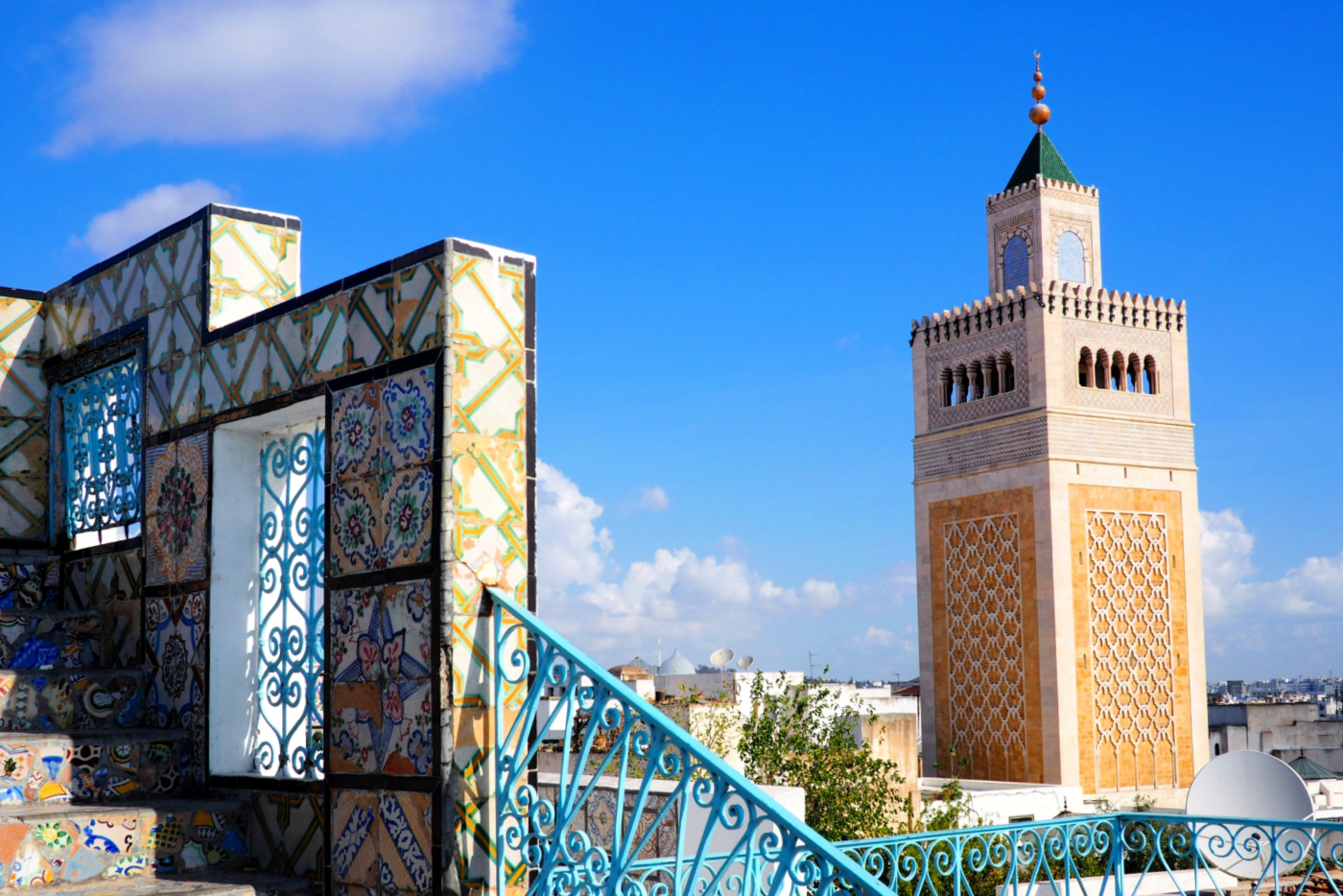
Where to Stay While Traveling in Tunisia
If you’re looking for something with a few more facilities, there are a range of mid-to-high-end options around Tunisia. With these, you can expect a little more comfort – and in some cases, even an in-house spa or outdoor swimming pool.
- Tunis: There are so many pretty options in the heart of the medina to choose from, but Dar El Jeld Hotel and Spa is the creme de la creme. This stylish residence has fantastic views of the city from the rooftop terrace as well as an in-house spa where you can release the tension with massages, scrubs and a hammam. There’s also a restaurant across the street that is part of the hotel and serves up authentic Tunisian meals for lunch and dinner. Situated in a touched up old building, the suites are large and tastefully furnished with a mixture of modern and traditional elements. Prices start from $186 per night , including daily breakfast and free Wi-Fi.
- Sousse: Dar Lekbira Boutique Hotel is a relatively new property in Sousse that only opened at the end of last year. Everything is shiny, new and decorated in loud, bright colors. The $97 per night room comes with free Wi-Fi and daily breakfast, which is served in the internal courtyard. You can also opt to have your dinner here as well if you don’t fancy eating out, which is a bonus for days when you feel too worn out to hit the town. Best of all, the location is fantastic, a short walk from the city’s main attractions and the Sahel Metro station if you want to visit neighboring Monastir.
- Monastir: If on your visit to Monastir you decide the calmer city is more to your taste than Sousse, Dar Benti is a gorgeous property in the heart of the city’s medina, just a short walk away from the beach. Everything here is appareled in a cooling, clean white palette, from the comfortable rooms to the rooftop pool. The accommodation also boasts a shared lounge and a sizable internal courtyard, with free Wi-Fi running throughout the property. Prices start from $140 per night , including breakfast.
- Kairouan: Full of aesthetic little touches – in particular the cute tilework – Dar Alouini is a quintessential old house but jazzed up with bonus features. Alongside the garden and terrace, there’s an indoor swimming pool where you can chill after a long day of touring. Plus, the hotel will rent you bicycles so you can explore a bit further afield without having to try your luck with Kairouan’s public transport system. Rooms are perhaps a little steep at $196 per night , including free Wi-Fi and breakfast.
- Hammamet: Most of my trip was spent in traditional houses located in the medinas of the various cities I visited. The exception was Hammamet, where I went for the excesses of the Royal Azur Thalasso ( $179 per night ) This beach resort has several outdoor swimming pools, easy access to a private beach and lots of dining options, both indoor restaurants and al fresco spots. In short, it’s a full-service five-star property that makes up for a lack of character with a complete set of facilities, including a breakfast buffet, in-house spa and private parking.
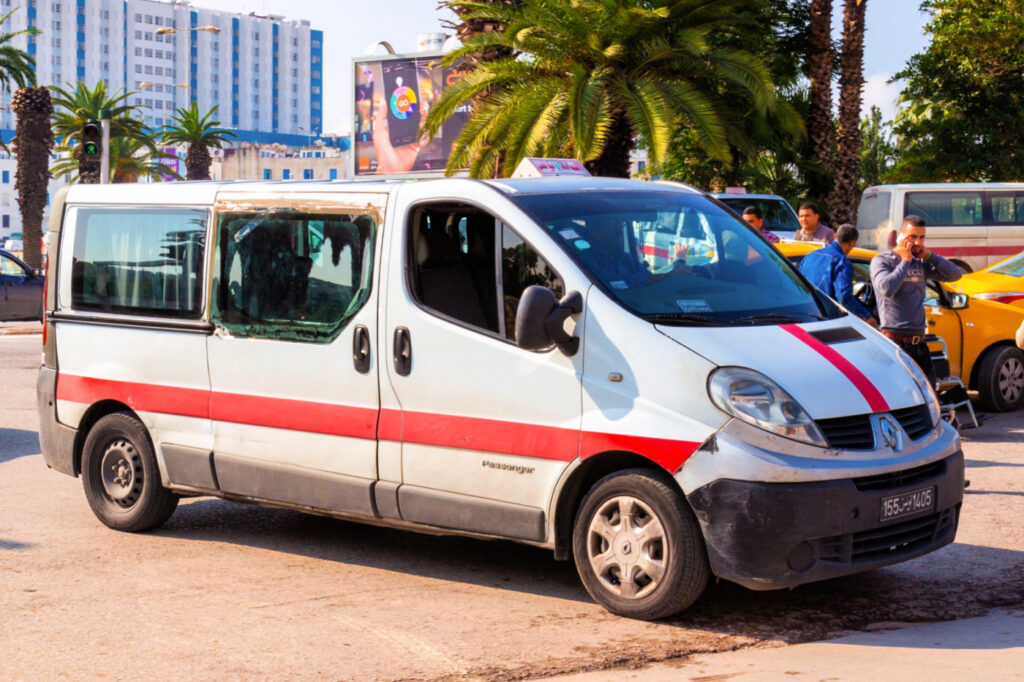
The Cost of Transportation in Tunisia
There are two main transportation aspects I’m going to discuss here: intercity and intracity. Let’s start with intercity, which is a bit more complicated but, for the most part, manageable.
First off, Tunisia is not the easiest country to travel across using public transportation, I assume because tourism hasn’t hit the market as hard as it has in Egypt and Morocco . There were even some places I wanted to go that I ended up skipping just because they seemed logistically risky without renting a car, hiring a private driver or joining a tour – I’m talking getting stuck in a small town in the middle of nowhere, waiting for a bus that may or may not come.
To travel between cities, a lot of locals rely on the network of louages (literally ‘rentals’) that crisscross the country. These minivan taxis are particularly useful – or, indeed, often the only way – to get to rural places like Douz (where overnight stays in the Sahara Desert commence) or Tataouine (the area where remnants of Berber living can be found). If you’re not afraid of a little adventure and aren’t on a tight schedule, these are easily the cheapest way to travel. As a rough guide, you should expect to pay around 5 Tunisian dinar ($1.60 at time of writing) for short intercity routes and about 10 Tunisian dinar ($3.20) for longer ones, give or take.
Louages are absolutely not easy to figure out, unless your bewildered looks at the depot attract a kindly stranger, or you speak either French or Arabic. Bear in mind that for some routes, departures are fairly frequent – louages usually only leave when they are full up. For other less popular intercity connections, there may just be a handful leaving per day, and sometimes only in the morning. The best thing to do is to consult with your hotel and see if they can help you navigate the system. Or, you know, learn French or Arabic.
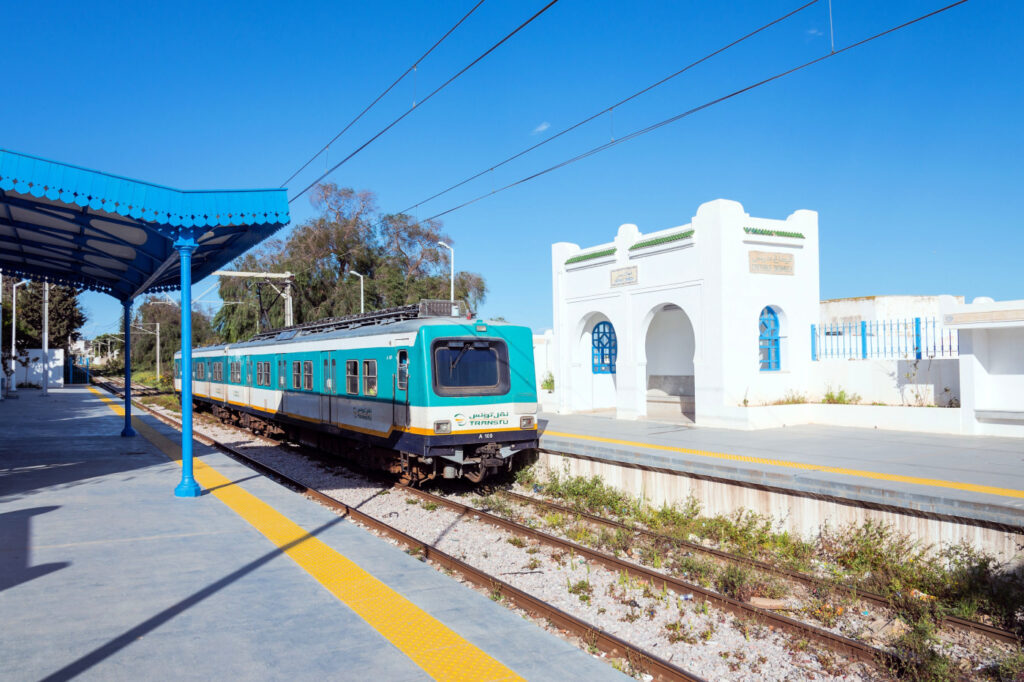
Fortunately, the major cities of Tunisia are serviced by a perfectly reasonable national railway system, the SNCFT (Societe Nationale des Chemins de Fer Tunisiens), overseen by the government. You can check what times trains depart between various cities via the SNCFT website , which has Arabic, French and (phew) English. However , in my experience the English version for some reason is a bit buggy when it comes to showing you all the available trains, so you might still be better viewing the page in Arabic or French in conjunction with Google Translate. Not difficult, just a bit of a pain.
Train journeys between the major cities are very affordable, especially if you travel in second class, where tickets cost between six to 12 dinars ($2-4). You can also upgrade your experience to first class or classe confort for just a couple more dinar, which gives you a little more space and, as the name suggests, comfort.
Within cities, taxis are fantastically easy to use and very cheap. All the rides I took were between six to12 dinars ($2-4), including crossing almost the entirety of Tunis. Drivers on the whole are very honest, though it doesn’t hurt to just double check the fare is being charged according to the meter when you enter the vehicle. Each cab has a sticker pasted on the inside with a number to call if you think you are being gouged.
The one exception to the positive taxi experience is when traveling from the airport in Tunis. Here, you can expect to be massively overcharged, so it might be worth ordering a Bolt instead. Generally, this is a more expensive option, but you will be quoted a price beforehand, which you pay to the driver in cash.
If you want to travel between Tunis and the beach area around La Marsa, the standard-gauge light railway known as the Tunis-Goulette-Marsa (TGM) is a unique experience – and one that has a great deal of history. The line was first opened in 1872 and has been running ever since.
In Sousse, you can hop on the Sahel Metro to visit the coastal town of Monastir, which boasts a beach resort and some old fortifications. Tickets between Sousse and Monastir cost just 1 dinar (33 cents), with the journey taking about half an hour from one downtown area to the other.
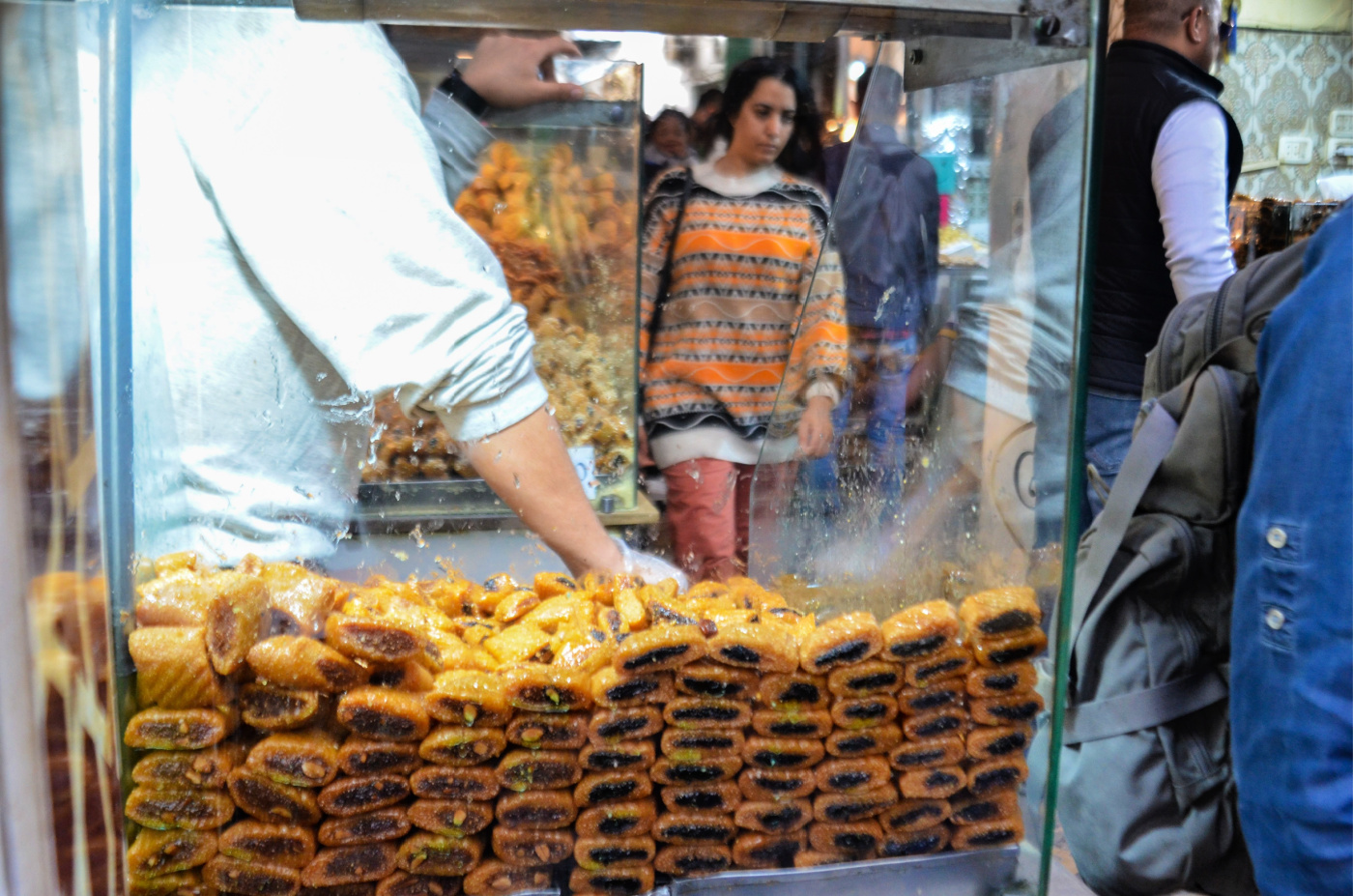
The Cost of Food in Tunisia
Tunisia has a rich culture of street food, a lot of it based around flatbreads, which are eaten for breakfast, lunch and dinner. You can expect to pay around 8-10 dinar (about $3) for staples like a baguette farcie (flatbread stuffed with cheese, mixed veg and either chicken or jambon, then baked) and one to two dinar (about 50 cents) for the smaller fricassee (deep-fried roll containing olives, boiled eggs, canned tuna and potatoes).
For dessert or a sweet snack, make sure you don’t miss the bambalouni, a giant donut-like dough that’s freshly fried in front of you, then covered in sugar. It only costs a single dinar ($0.33)
At restaurants, you can expect to pay a little more – though not much more – for you meal. At your bog-standard, everyday joints, a hearty main like an ojja merguez (tomato-based stew with eggs and spicy lamb sausage, flavored with harissa and garlic) will set you back 12 dinar ($4). At the fancier establishments – particularly the top-notch spots found in Tunis – you can expect to pay about 25 dinar ($7) for a main or 55 dinar ($18) for a three-course meal.
If you fancy cooking your own food, head down to the local market, where you can find fresh veggies, fish, meat and other snacky bits and bobs. For example, at Tunis’ municipal market, you can purchase fresh octopus for about 70 ($23.10) dinar per kilo, complemented by a simple salad of cherry tomatoes (2.7 dinar, 89 cents) and parsley (0.45 dinar, 15 cents).
The same market also has a range of local cheeses to sample, which you can purchase for around 20 dinar ($6.60) for a 250-gram block. Don’t miss out on the heavenly fresh baguettes, which are just a few cents, or the pots of harissa, which is heavily used in various local specialties.
Buying and drinking alcohol is entirely legal in Tunisia, but you will only find it in some specific locations, including luxury hotels and supermarkets like Monoprix. Local wine is particularly affordable – and quaffable – at around 25 dinars ($8.25) for a decent bottle, though you can get the really basic stuff for about half that.
Overall, the average cost of food in Tunisia is 50 dinar ($16.50) per person per day , excluding any alcohol you might choose to imbibe.
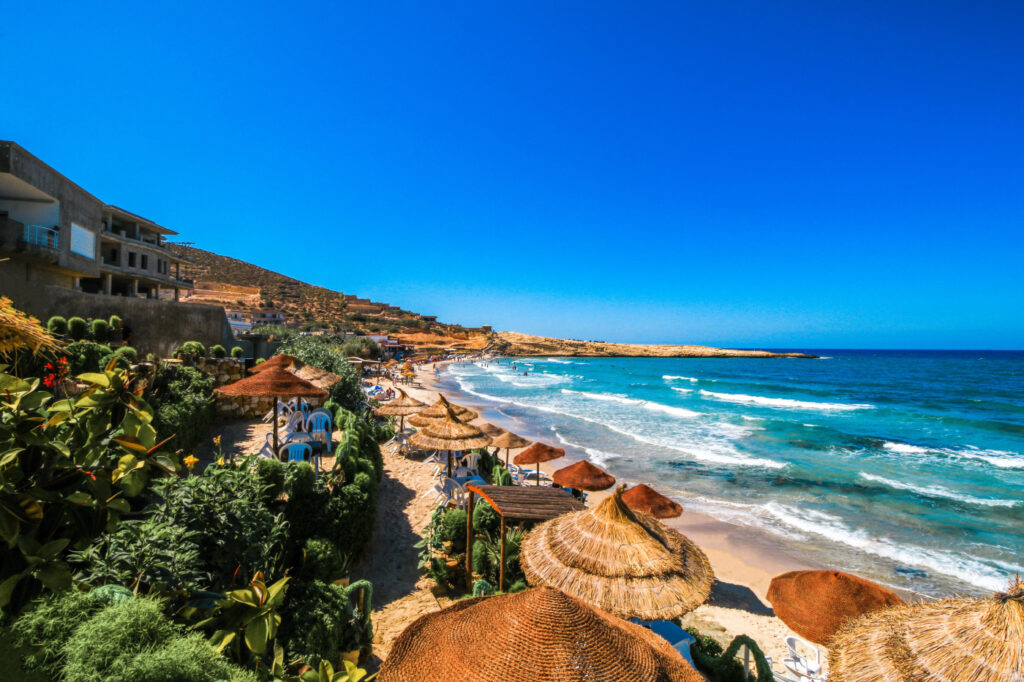
The Cost of Activities and Entrance Fees in Tunisia
One of the most fascinating activities you can do in Tunisia is to explore the medinas scattered across Tunisia’s various cities. Each one offers plenty to see and explore, entirely for free – unless you are seduced by a souvenir vendor into handing over some cash for pottery, clothing or other hand-made handicrafts. That’s particularly true in Tunis and Sousse, which have the most colorful and attractive medinas, as well as the most historical.
Another top free thing to do in Tunisia is to head to the beach and enjoy some sun, sand and sea. Tunis has its share of coastal stretches, though Hammamet’s white sands are what truly draw the crowds.
If there’s one thing people know about Tunisia aside from its beaches, it is that it’s home to the ruins of Carthage. While not a lot remains of this ancient past, what does still exist has been classified as a UNESCO World Heritage Site. For 12 dinars ($4), you can visit the various remnants, which are spread across the northern part of the city of Tunis. The Baths on Antoninus are particularly impressive.
Other highlights in Tunis include the Ennejma Ezzahra Palace (entry 5 dinars, or about $1.65), an impressive homage to Arab-Islamic architecture in the picturesque Sidi Bou Said quarter, and the Bardo Museum (entry 11 dinars, or about $3.60), which has a world-beating collection of ancient mosaics.
Some of the more stunning Ancient Roman ruins are located in rural parts of Tunis, including Dougga and Bulla Reggia, to the west of the capital. Entrance to each one of these sites costs 7 dinars ($2.30), providing access to copious architectural marvels.
Further south, Sousse has an archeological museum located inside a former kasbah (fortress), which you can enter for 9 dinars ($3), as well as an impressive ribat fortification (7 dinars, or about $2.30). In El Jem, the amphitheater is 10 dinars ($3.30) to enter and is one of the most complete arenas from the Roman world still in existence.
While you can’t go inside the prayer halls of a lot of mosques in the country, you can usually enter the courtyards – sometimes for free, sometimes for a price. In Kairouan, for example, you can get a 1-day multi-site pass for 10 dinars ($3.30) that provides entrance to the Kairouan Great Mosque, as well as the Raqqada Islamic Art Museum.
It’s possible to do a daytrip tour from Tunis that squeezes in Sousse alongside nearby El Jem and Kairouan all at once for $139. It is quite an intense amount to do in a 24-hour period, involving lots of driving, so I would instead recommend spreading the cities across several days.
If you want a bit more of an adventure, you can take a 2-day trip into the desert for around $222 per person. It’s a wonderful experience (as long as you don’t mind camels), featuring sunset over the dunes and an overnight stay in a Berber camp.
For an interesting cultural excursion, you can also journey to see the ruins of Tataouine and Chenini, former Berber habitations that inspired Luke Skywalker’s home in Star Wars. Guided visits cost around $61, leaving from the island of Djerba.
Though tours tend to bump up the costs significantly, in general you should budget around 10-15 dinars (about $3-5) per person per day for activities.
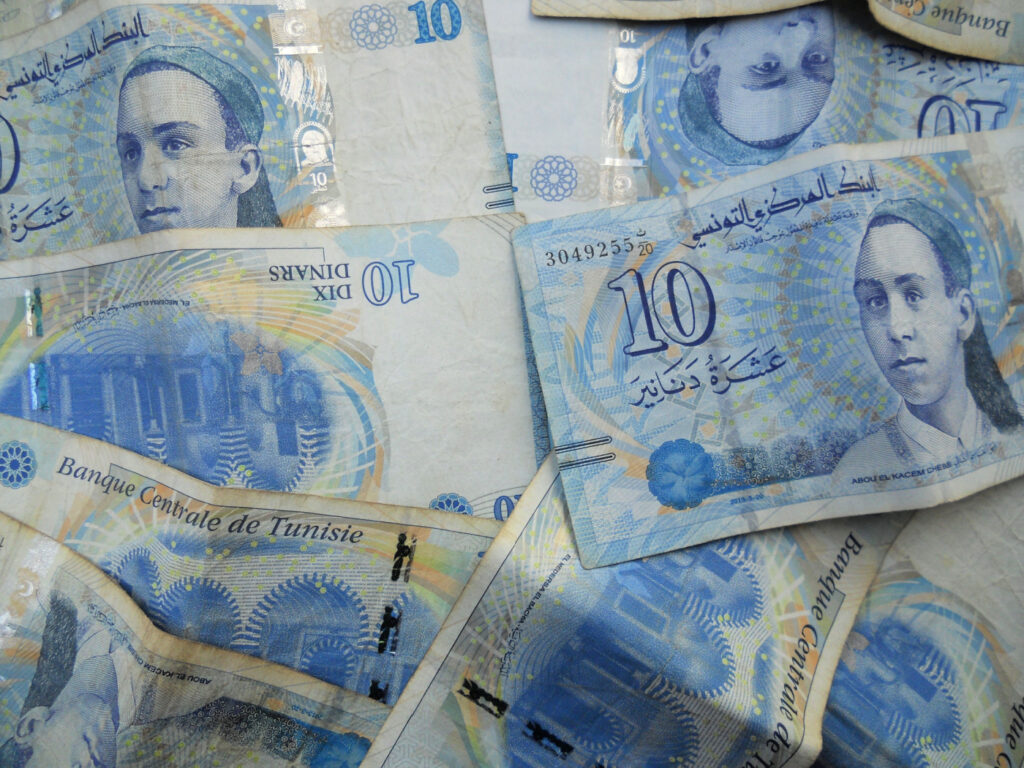
How Much Does It Cost to Travel in Tunisia?
Now I’ve gone through all the main expenses of your trip, it’s time to add everything together, so you can get a good overall idea of what to budget for your trip.
Accommodation: $60 per day for a double
Transportation: 21 dinars ($7) per day
Food: 50 dinars ($16.50) per day
Activities: 12 dinars ($4) per day
Total daily expenses for Tunisia: $87.50

Planning a Trip to Tunisia?
I have put together a guide for how to spend 10 days in Tunisia, covering the main highlights across the country, from ancient ruins to the best beaches.
You can find a list of other African countries I’ve visited with accompanying itineraries here , including information on other North African coastal locations like Egypt and Morocco . If you are able to take a little more time off, you could visit them all, as part of a comprehensive trip that takes you along the Barbary Coast.
You can also check out the price of travel for other destinations across the globe through my master list , which has detailed expense reports, covering the cost of visiting over 60 countries around the world!
Lauren Juliff
Lauren Juliff is a published author and travel expert who founded Never Ending Footsteps in 2011. She has spent over 12 years travelling the world, sharing in-depth advice from more than 100 countries across six continents. Lauren's travel advice has been featured in publications like the BBC, Wall Street Journal, USA Today, and Cosmopolitan, and her work is read by 200,000 readers each month. Her travel memoir can be found in bookstores across the planet.
Related Posts

The Cost of Travel in Mauritius: My Detailed Budget Breakdown

The Cost of Travel in Thailand: My Detailed Budget Breakdown

2023: My Travels in Review

How to Spend One Week in Mauritius: An Itinerary for First-Time Visitors

The Cost of Travel in South Korea: My 2024 Budget Breakdown

Why You Need to Take a Game Drive in Swaziland/eSwatini
Leave a reply cancel reply.
Your email address will not be published. Required fields are marked *
Meet Lauren Juliff
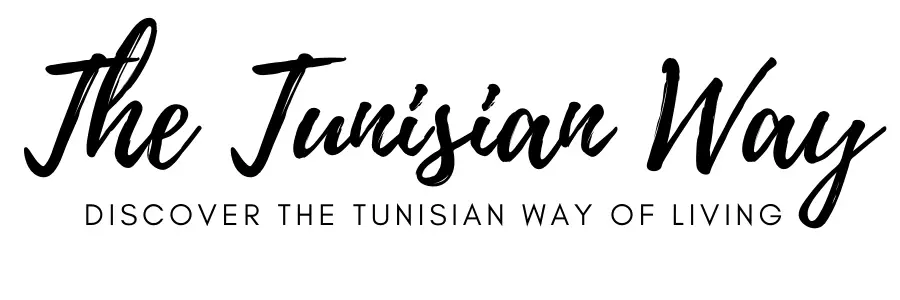
The Tunisian Way
Learn about Tunisian life
Travel budget guide – Is Tunisia expensive or cheap?
Heya all, Could someone tell me how expensive Tunisia is, please? And what sort of budget is needed for a week’s holiday? In this article you find the answers to common money-related topics; the currency of Tunisia, exchanging and withdrawing money, is Tunisia expensive or cheap, cost of food, transportation, and accommodation. Now let’s talk about money, money, money.
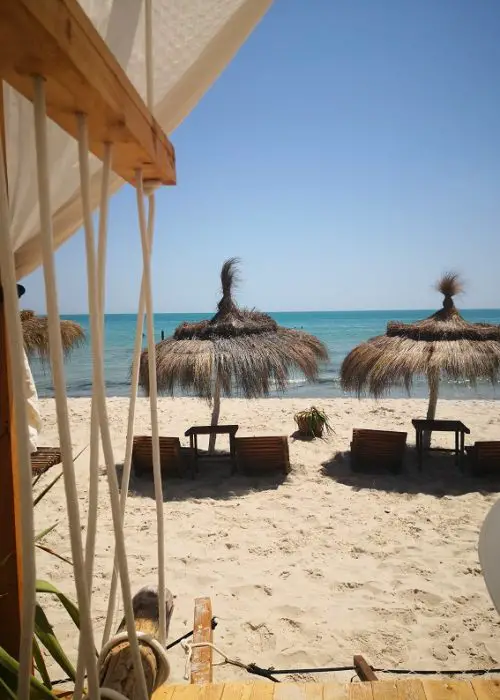
Currency of Tunisia
The currency in Tunisia is called dinar, Latin symbol DT, and currency code TND. One dinar equals 1000 millimes. The most used notes are 5, 10, 20 and 50 dinars and coins are ½, 1, 2, 5 dinars and 50, 100, 200 millimes. The Tunisian dinars are called a closed currency which means that currency is only available in Tunisia. You can’t purchase Tunisian dinars in advance from your home country and bring those to Tunisia. Actually, it’s illegal to import and export Tunisian dinars.
Exchanging and withdrawing money in Tunisia
Cash is the most useful in Tunisia, so sooner or later you need to exchange or withdraw some money. If you need money already at the airport, you will find money exchange points or ATMs to withdraw dinars. In case you don’t need dinars immediately, the money exchange points are located in big hotels, banks, post offices, or on the street. Often the airports are the worst place to exchange money because the exchange rate isn’t good. So, my advice for the airport is to exchange a small amount of money (just for transportation) or if possible don’t exchange at all.
Exchanging money in Tunisia
When exchanging currency, it’s important first to compare the exchange rate between companies to get the best deal for you. Also, pay attention to possible additional fees and tips. You don’t necessarily need any cash as you can pay the exchange with a credit card. Always count the money which you receive and check that the amount matches the receipt. Also, save the receipt as you need it if you want to convert dinars back to your home currency. So don’t go overboard as you can’t take dinars out from Tunisia!
Withdrawing money in Tunisia
Instead of converting the currency I normally prefer to use ATM. Finding the ATM isn’t too difficult in bigger cities. Remember to ask your home bank about foreign transaction fees and be aware of other smaller fees when using a foreign bank network. Normally I withdraw a bit larger amount of dinars for once. That I don’t need to pay excessive fees. But carrying too much money with you isn’t advisable in case something happens.
You don’t always need cash either and you can ask about paying in euros, dollars, or pounds. When paying larger amounts at once or shopping in malls and international clothing stores you can normally pay by credit card. In restaurants, cafes, bars, small boutiques, and souks it is easier to pay by cash.
When leaving Tunisia, you should use your remaining dinars or exchange them back to your currency. As I mentioned before it’s illegal to take dinars out from Tunisia and authorities have the right to search your belongings at the airport.
What does a flight to Tunisia cost?
The price of the flight depends on where are you flying and if it’s high or low season. The closer you are to Tunisia the cheaper the flight is. Flights from central Europe to Tunisia during the low season (not in summer months) will cost 200-300 euros and during the high season about 350-600 euros. Flights from North America or Asia can easily cost 1000-3000 euros. Another great option is hotel + flight- deals. If you find a good package you can save a significant amount of money.
The earlier you book the flights the cheaper it will be for you. When searching flights from the internet it’s important to clear your cookies and use incognito mode, that’s how you avoid cookies which normally raise the prices. Another bit crazy tip I have based on my own experience. I was looking for a flight to Tunisia from Lufthansa’s official website and I had chosen the English language for this website but when I changed the language to German the prices of flights dropped quite much! I don’t speak any German but I managed to buy the tickets.
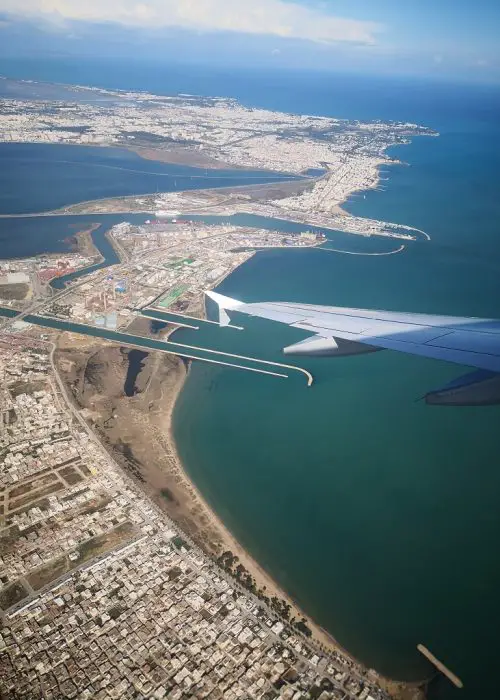
How much accommodation will cost?
One of the most important income sources for Tunisia is tourism, due to this there are thousands and thousands of hotels and hostels available. The prices of hotels range from 20€/night to 500€/night. For sure you will find accommodation which will fit your taste and a budget.
Hotel prices in Tunisia depend on the season, the number of nights, the location of the hotel, the city, the hotel you choose, and the number of people. That’s why it is hard to estimate how much your accommodation will cost. I have been very pleased with the price-quality level of hotels in Tunisia. To get a room from a nice hotel with access to the beach or pool is not too expensive!
Booking an apartment through Airbnb is a great option. Getting a hotel room from an expensive area during the high season might be costly, so go ahead and check Airbnb. There are many great options at an affordable price. And don’t stress about breakfast or cooking, eating outside is cheap, and is there any better way to start the day than having breakfast in a local café.
Food in Tunisia is cheap – How much to budget for restaurants?
Tunisian food is super delicious: fresh seafood, fruits and vegetables full of flavor, spicy sauces, the bread which is baked in the morning, refreshing lemonade, and much more! And the best part is that food, in general, is very inexpensive. Eating outside is cheap and also all the groceries are cheap.
Dining in a restaurant where also locals are eating, the meal for two persons cost just a couple of euros. There are also many street food restaurants where you can grab a sandwich and soft drink at the price of 1-2 €. Eating in a high-end restaurant will cost more but it is still very affordable compared to many other countries. We had dinner in Sidi Bou Said in a stunning hotel called La Villa Bleue. The place itself is very beautiful and the view is stunning! We ordered 2 main courses, a bottle of red wine and a plate of cheese. All of this cost around 70-80€.
Eating out prices in Tunisia
My advice is to go to places where also Tunisian locals eat. This way you will get real Tunisian food made from fresh ingredients. The prices are also very inexpensive. So how much to budget for restaurants? Here I have listed some common prices to help you to plan your budget. Nb! Prices are in Tunisian dinars.
A meal in an inexpensive restaurant for 2 persons (a lof of food + soft drinks) 10-15 DT.
A meal in a mid-range restaurant for 2 persons (main courses + bottle of wine) 60-70 DT.
A meal in a high-end restaurant for 2 persons (main courses + bottle of wine) 150-300 DT.
A plate of fresh seafood for 2 persons 45-150 DT.
Sandwich/ Mlawi + soft drink 3-5 DT.
Espresso 1-3 DT.
Cappuccino 1,20-3,50 DT.
Salty pastry 0,60-1,50 DT.
Sweet pastry 1-3 DT.
Beer in bar 3-9 DT.
Wine in restaurant 20-160 DT.
Soft drink 0,33l 1-2,50 DT.
Water Bottle 2l 0,8-3DT.
If you have been wondering is Tunisia expensive or cheap? At least we can say that food is cheap.
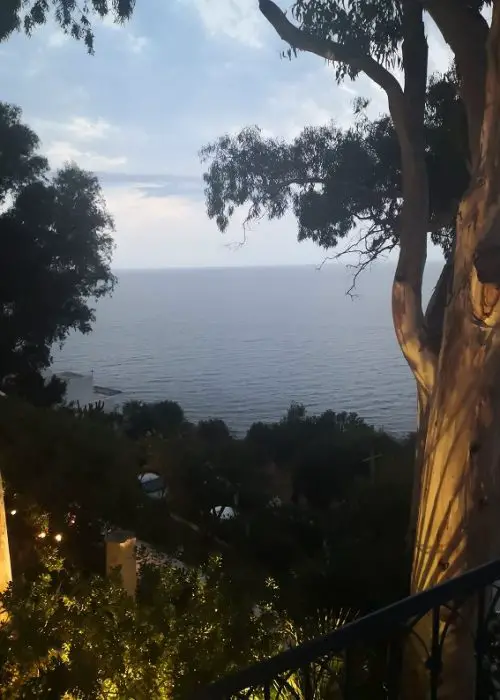
How much partying will cost in Tunisia?
Tunisia is a good option for having a great but cheap party. In tourist places such as Sousse and Hammamet, the nightclubs and bars are everywhere and that’s why you don’t need to spend money on taxis or transportation. In the capital, the nightclubs are out from the city center so some kind of transportation is needed. The nightclubs and bars are normally without an entry fee but if they have a special event then buying a ticket is needed. If there is a special event, I advise buying tickets beforehand or make a reservation.
The prices change a lot between the nightclubs, lounges, and bars. A bottle of wine will cost around 20-100DT, beers 3-9DT, cocktails 10-15DT, and shisha 5-40DT. Some restaurants have happy hour when drinks are cheaper during some hours. Most of the time I have paid 5 DT for a beer and 50DT for a bottle of wine but it really depends where are you and which kind of nightclubs, lounges, and bars you like to go to.
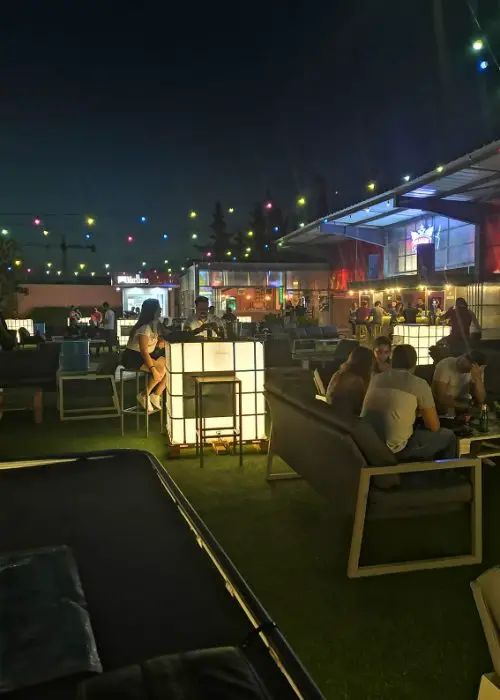
How much activities will cost in Tunisia?
The price of activities and entertainment aren’t high in Tunisia. Massages and different kinds of beauty treatments (manicure, hair care, pedicure, gel nails, facial care) are cheap. As mentioned before having dinner or drink outside is also cheap and if you are planning to go to the cinema after dinner it will cost about 30 dinars per two tickets.
One great idea is to buy an entertainment package, there are plenty of those available. Once we booked a short boat ride to the small island + chairs and table by the beach + meal and soft drinks + a boat ride back and it cost around 20DT/person. There are also many guided tours available, some cheaper and others more expensive: 3 days trip can cost 500-1000DT.
Is Tunisia expensive or cheap? Transportation and renting a car
If you plan to discover many places inside Tunisia then I recommend renting a car. Moving around by car is much more comfortable than using public transportations, especially on hot summer days. It also gives you much more freedom. But if you are mainly staying in one city then using a taxi is the best idea.
Whichever transport you decide to use it won’t cost a lot. The public transportation bus, train, and metro are the cheapest options to use. I rather use a taxi which is not much more expensive and it is faster. Renting a car is not too expensive either and the price of gasoline is also low. The rental price will depend on the season, size of the car, equipment of the car, and for how many days you are going to rent the car. Renting a car will cost 120-300DT/day and 800-2300DT/week.
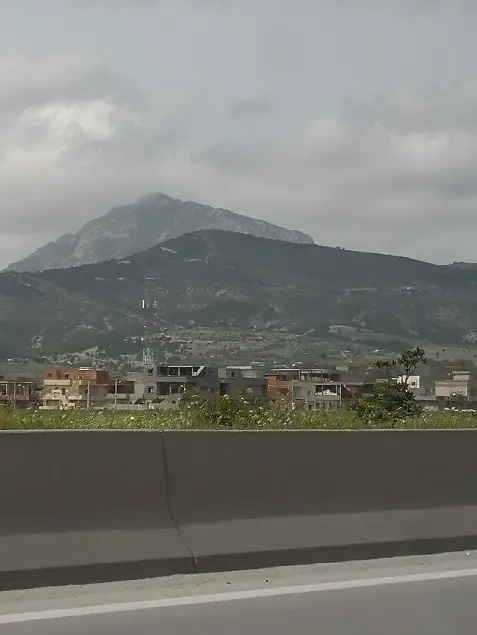
So Is Tunisia expensive or cheap?
The size of the holiday budget is one of the factors which impacts where are you heading for a holiday. One common question is Tunisia expensive or cheap? To answer this question is a bit complicated as many things affect it. A thing that is cheap for one person might be expensive for another.
In Tunisia cost of living is low when we compare it to the other countries. In my opinion and own experience, Tunisia is cheap. What sort of budget you will need, depends on what kind of traveler you are and what kind of holiday you are planning to have? Are you looking for a 5-star beach resort or backpacker hostel? Are you having a trip alone or with family? If we compare the prices in Tunisia to other popular holiday destinations, we can conclude that Tunisia is cheap actually.
The great thing about Tunisia that you can easily have a low-budget holiday or luxury holiday and everything between those. Tunisia is a destination for nomads, backpackers, families, couples, groups of friends, and luxury lovers. You can manage one week with very little money if you are a bit adventurous. And you can easily spend thousands of euros if you are looking for luxury. You will find many great all-inclusive hotel+ flight package with good prices if you are looking for an easy solution.
I hope that this Tunisian budget guide – is Tunisia expensive or cheap? is useful for you and it answered at least some of your questions. Feel free to ask some more questions below! After all of this, I just want to wish you an amazing holiday in Tunisia!
Check also these before your trip Tunisia!
Tunisia bucket list- 40 things to do and see in Tunisia
10 Traditional foods you need to eat in Tunisia
What to wear in Tunisia
2 Comments on Travel budget guide – Is Tunisia expensive or cheap?
Thank you for all the information you share with us. Hope to travel there one day.
Thank you for your kind words 🙂 I hope that you will visit this beautiful country one day.
Leave a Reply Cancel reply
Your email address will not be published. Required fields are marked *
Save my name, email, and website in this browser for the next time I comment.
Tunisia: 6 Unique Things to do? & Budget Calculator $
Explore Tunisia's top attractions & calculate your trip costs with our guide. From Sahara horse rides to Tunis medina tours, find unique activities & budget tips for savvy travelers.

Tunisia is a picturesque land which borders both the Mediterranean sea and the Sahara desert!
With many cheap flights to Tunisia its no wonder many are flocking to visit. From the popular tourist spots of Sfax and Kairouan to the ancient roman city of Dougga
and the laid back mountain town of Le Kef, Tunisia has alot to offer!
In this article, I will answer some Frequently asked questions submitted by readers of Town & Tourist, these include the following:
- 6 Unique Things to do in Tunisia?
- Is Tunisia cheap to Travel?
- Tunisia Travel Budget Calculator
- Tunisia Costs (Detailed)
- Is Tunisia Safe for Tourists?
- Do you need a Visa to Enter Tunisia?
- When is the Best time to Visit Tunisia?
- Where to stay in Tunisia?
- 3 Essential Travel Tips? (Packing Guide)
A. 6 Unique things to do in Tunisia?
1. visit tunis for a weekend.
Tunis is the large capital of Tunisia, sometimes referred to as "Grand Tunis" due to its size. It is located along Lake Tunis
inland from the Mediterranean Sea’s Gulf of Tunis. Here you will discover the centuries old Medina,
which offers a series of ancient landmarks from Roman artifacts in the local museum to an 8th century Mosque.
The modern part of Tunis (Ville Nouvelle), has a tree lined promenade with many hotels & restaurants.

tunis-sidi-bou-said-tunisia
2. Take a horse ride across the Sahara Desert

tunisia-horse back rides
3. Visit a holy site.
Be sure to visit the Islamic holy site of Kairouan.
This will give you insight into a different side of Tunisia

tunisia-kairouan-great-mosque
4. Haggle in the Markets of Sfax
Have a go at haggling at one of the busy markets or Souqs as they are known

Souq Tunisia
5. Experience the Festival of Sahara
Visit Douz at the end of December to experience the Festival of Sahara.

Festival of Sahara Tunisia. Photo by Sony Stark (the great gonomad.com)
6. Relax & Cleanse in an Hammam
A Hamman is a Turkish style baths which is associated with the culture of the Ottoman Empire and the Islamic world.
Inside you can cleanse, relax and even take a spa treatment!

hammam Tunisia
B. Is Tunisia cheap to travel?
Tunisia is mid range when it comes to travel costs. A budget traveller should budget $60 (USD) per day ,
while a mid range traveller should budget $80-90 (USD) per day.
This includes the cost of accommodation, food and transport!
The Prices in Tunisia are more expensive than its northern african friends, Egypt & Morocco .
However the prices here are cheaper than the USA & western Europe, UK , France , Germany , Italy.
Insider Tip:
Always use licensed cabs , especially is coming from the airport, and ask around first for approximate prices.
If you don't fancy haggling, head to one of the government run Socopa shops. There you can pick up some quality souvenirs without having to haggle.
C. Tunisia: Travel Budget Calculator
To help you budget your next adventure to Tunisia
Dive into our interactive Travel Budget Calculator below
User Guide: Simply select your “Travel Style”, ” Number of Persons” and Number of Days Traveling.
Top Tip: “Group” travel budget gives the total budget for 4 people! To find out how much that is each simply divide by 4.
Family Budgets:
Families would be best using the Group selector, or those with small children should select “Couple” if the children are young enough to share a room.
We have compiled the data in the table above from our vast travel experience & other reliable sources.
What is the Currency in Tunisia?
The Tunisian Dinar is the currency of Tunisia
1 USD =2.80 TND
1 GBP = 3.70 TND
1 EURO =3.15 TND
D. Tunisia Travel Costs (Detailed):
I. budget backpacker travel costs:, ii. mid range travel costs:, iii. luxury vacation travel costs:, e. is tunisia safe for tourists.
According to the UK Government & US Government , You should be cautious when traveling in Tunisia
Avoid large gatherings, festivals and demonstrations due to a possible terrorist attack.
Here is a helpful map provided by the UK Government, with the areas you should & shouldn't travel.

Tunisia Travel Advice - Map of dangerous zones & safe zones
Be sure to not carry too much cash and exercise caution in crowded areas such as,
train and bus stations, airports to avoid danger.
I recommend purchasing a hidden money belt, I take mine everywhere. See: Travel Accessories
F. Do you need a visa to enter Tunisia ?
Many countries require an EVisa or Electronic Travel Authority (ETA) to enter Australia.
US Citizens:
According to the US Department of state:
A valid passport is required . For U.S. passport holders, a visa is not necessary for stays up to 90 days
UK & EU Citizens :
According to the UK Government:
British and all EU citizens (except Cyprus) can enter Tunisia without a visa from 90 days to 3 months depending on your nationality.
All governments advise on a valid Travel Insurance policy before traveling.
I always recommend World Nomads , I’ve used these for years.
G. When is the Best time to visit Tunisia ?
The best time to visit Tunisia is during the spring months between March and June and the fall between September and October.
H. Where to Stay in Tunisia ?
For a complete list of our recommend hotels in Tunisia, follow the link HERE

tunisia-Hotels-resorts-sunset
I. 3 Essential Travel tips?
1. invest in a quality travel camera.
Capturing the Memories of your adventure is essential!
You will be able to show your friends, family and even grand kids all the wonderful photos captured.
For more info see, our recommend Travel Photography Gear
Make sure you are equip with some great Photography Gear!
2. Important! Are you insured?
Be aware that you will need separate travel insurance if you are traveling to Tunisia!
If you get ill or have an accident it will be a very costly experience!
All travellers to Tunisia should have a robust travel insurance to avoid paying out thousands of dollars.
I always recommend World Nomads , I’ve used these for years,
they are the best and most reliable insurance, they also provides an unlimited medical budget!

Getting hit with a large hospital bill after getting sick or injured, could really add to your worries! Get some Travel Insurance
CLICK HERE TO GET YOUR FREE QUOTE FROM WORLD NOMADS
For more info see: Why you NEED Travel Insurance?
3. Be sure you have your Travel Essentials
(Things You can’t travel without!)
A high quality Tent & backpack can also be great investments to help you cut costs and have more of an adventure while traveling!
- Recommended Backpacks
- Recommended Camping Gear
- Recommended Hiking Boots.
To learn about our secret Hotel Hacks check out: How to find the Best Hotel Deals??
Egypt: Budget Calculator & 8 Unique adventures!
Egypt Travel budget calculator
Morocco: Travel Budget Calculator

Morocco Travel Budget Calculator (Goats in the TRees)
73 Basic Dutch Phrases for Your Next Trip to Netherlands 🇳🇱
Learn essential Dutch phrases for a smooth trip to the Netherlands. Perfect for travelers looking to connect with locals and enrich their experience.
Win a $500 Flight!
Embark on the adventure of a lifetime! Enter our Dream Journey Sweepstakes for a chance to win a $500 travel voucher, redeemable with any major US airline. Whether it's sandy beaches, bustling cities, or tranquil mountains, your dream destination is just an email away!*

August Adventures: Top African Destinations to Explore Before the Rush
August is a magical time to explore Africa. You've probably heard how huge and diverse it is, right? Well, that means there's a ton of cool places to check out, especially when the weather's just right in August. From wildlife safaris to beautiful beaches, Africa's got it all.

Ultimate Guide: Top Places to Live in Africa for Every Demographic - Discover Your Perfect Spot
Thinking about making a big move to Africa? You're in for a treat! Africa's got some of the most vibrant, culturally rich, and scenic places you could call home. From bustling cities to tranquil seaside towns, there's a spot for every taste and lifestyle.

Best Time to Visit Tunisia: Seasonal Festivals & Local Secrets Unveiled
Thinking about hitting up Tunisia for your next adventure? Great choice! This North African gem is packed with history, stunning beaches, and mouth-watering food. But when's the best time to visit? Well, that depends on what you're after.

72 Basic Arabic Phrases for Your Next Trip to Tunisia 🇹🇳
Learn 72 essential Arabic phrases for your trip to Tunisia, from greetings and basic conversation to food, shopping, and culture. Make your Tunisian adventure unforgettable with this comprehensive guide to Tunisian Arabic.
You may also like...

Best Time to Visit Lithuania for Seasonal Adventures & Local Festivals
Planning a trip to Lithuania and wondering when's the best time to go? You're in the right place. Lithuania, with its stunning landscapes and rich history, offers a unique experience no matter the season. But, if you're looking to make the most of your visit, timing is key.

Best Time to Visit Hungary: Seasonal Secrets for an Authentic Experience
Deciding when to visit Hungary can be tricky, but don't worry, we've got you covered. This beautiful country shines in every season, but knowing the best time to go can make your trip even more special.

Best Time to Visit Estonia: Discover a Winter Wonderland Like a Local
Deciding when to visit Estonia? You're in for a treat, no matter the season. But if you're looking for the best experience, timing is key. This Baltic gem offers something unique with each season, from white winters to sunny summers.

Best Time to Visit Armenia: Winter Wonderland & Cultural Fests Unveiled
Deciding when to visit Armenia? You're in for a treat! This hidden gem has got it all - from cool, snowy winters to warm, sunny summers. But to get the best out of your trip, timing is key. Let's dive into when's the perfect moment to pack your bags for Armenia.

Best Time to Visit Havana: Seasonal Guide for Cultural Festivities
Planning your dream trip to Havana? You're probably wondering when's the best time to pack your bags and go. Well, you're in luck because we've got the inside scoop to help you make the perfect choice.

Best Time to Visit Oaxaca: Uncover Seasonal Secrets & Local Celebrations
Deciding when to visit Oaxaca? It's all about finding the perfect balance. You want great weather, fewer crowds, and lots to do, right? Well, you're in luck because Oaxaca has got it all, but timing is key.
The travel site inspired by travelers and locals alike. Find amazing destinations, unique trip ideas, the best hotels, and most comfortable resorts.
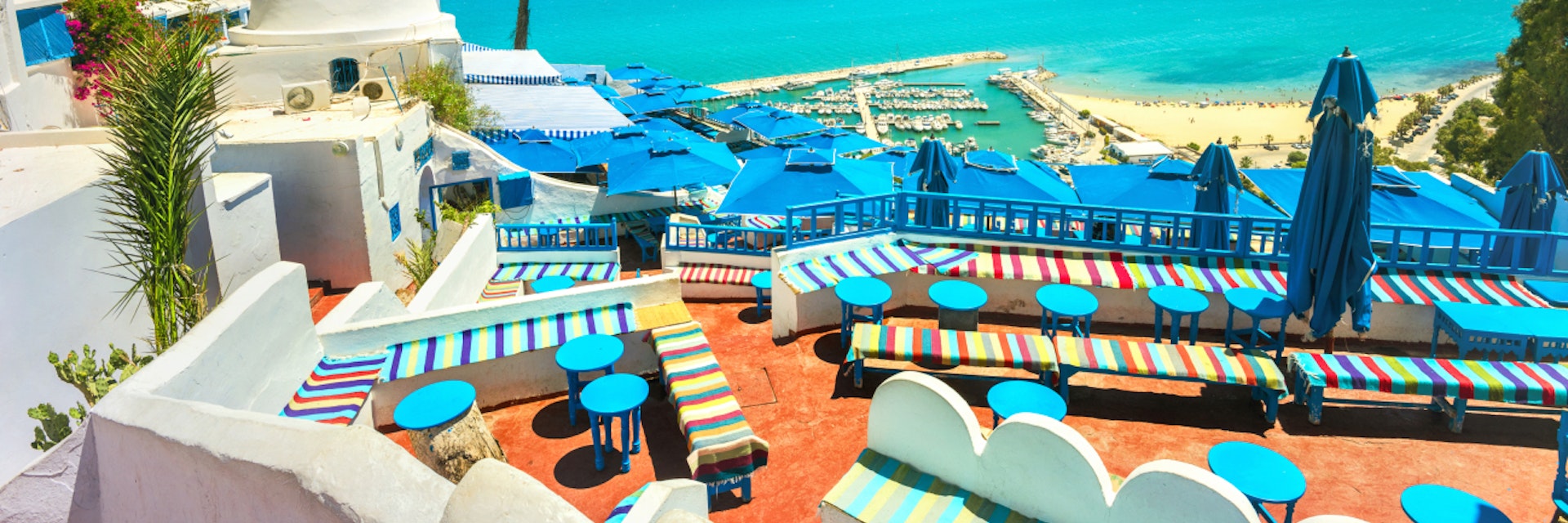
Shutterstock / Valery Bareta
It may be but a slim wedge of North Africa’s vast horizontal expanse, but Tunisia has enough history and diverse natural beauty to pack a country many times its size. With a balmy, sand-fringed Mediterranean coast, scented with jasmine and sea breezes, and where the fish on your plate is always fresh, Tunisia is prime territory for a straightforward sun-sand-and-sea holiday. But beyond the beaches, it’s a thrilling, underrated destination where distinct cultures and incredible extremes of landscape – forested coastlines, Saharan sand seas in the south – can be explored in just a few days.
Attractions
Must-see attractions.
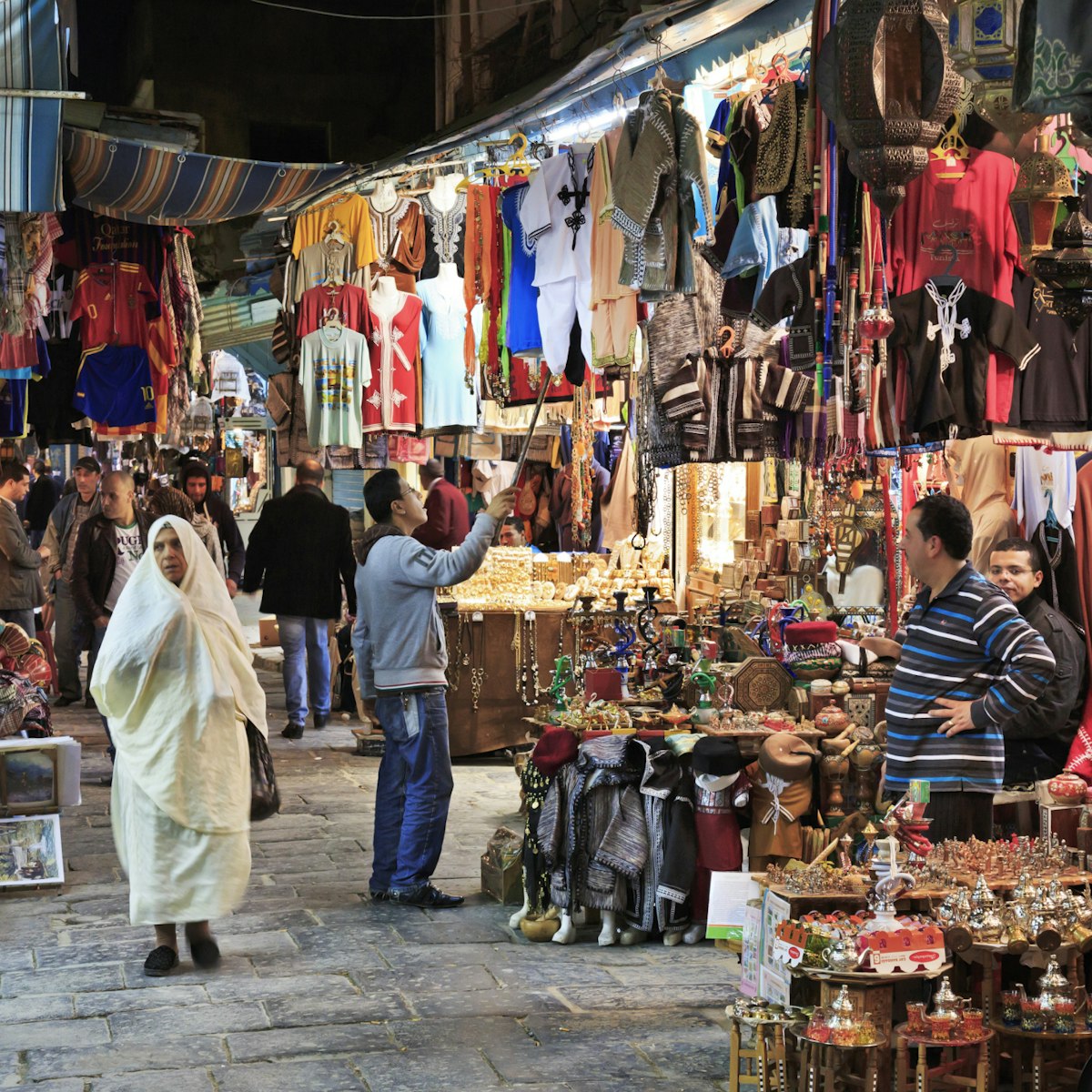
This sprawling maze of ancient streets and alleyways is one of the most impressive medieval medinas in North Africa and one of Tunisia's great treasures…
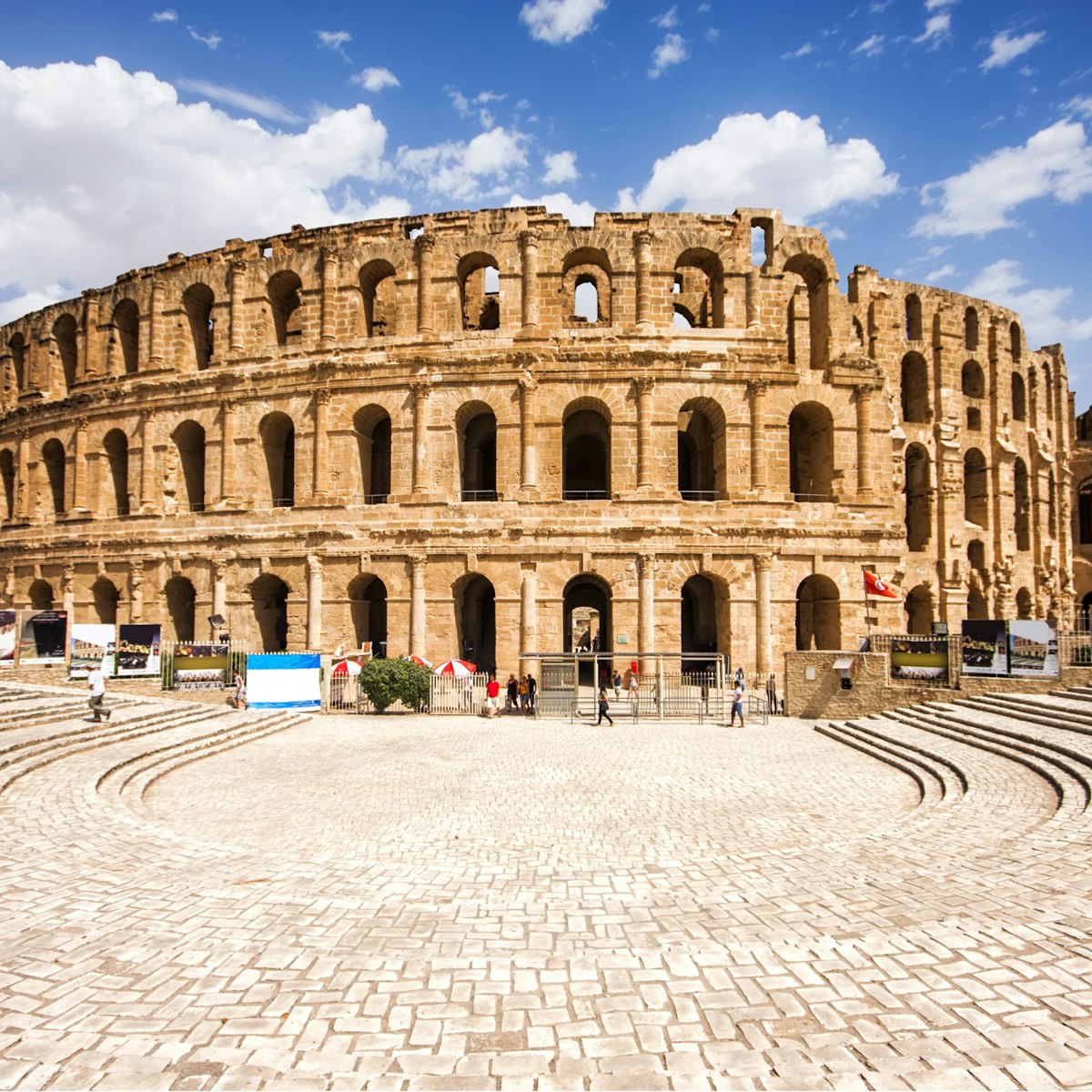
El Jem Amphitheatre
This Unesco World Heritage–listed colosseum was the second-largest in the Roman world (after Rome's); it was 149m long by 124m wide, with three tiers of…
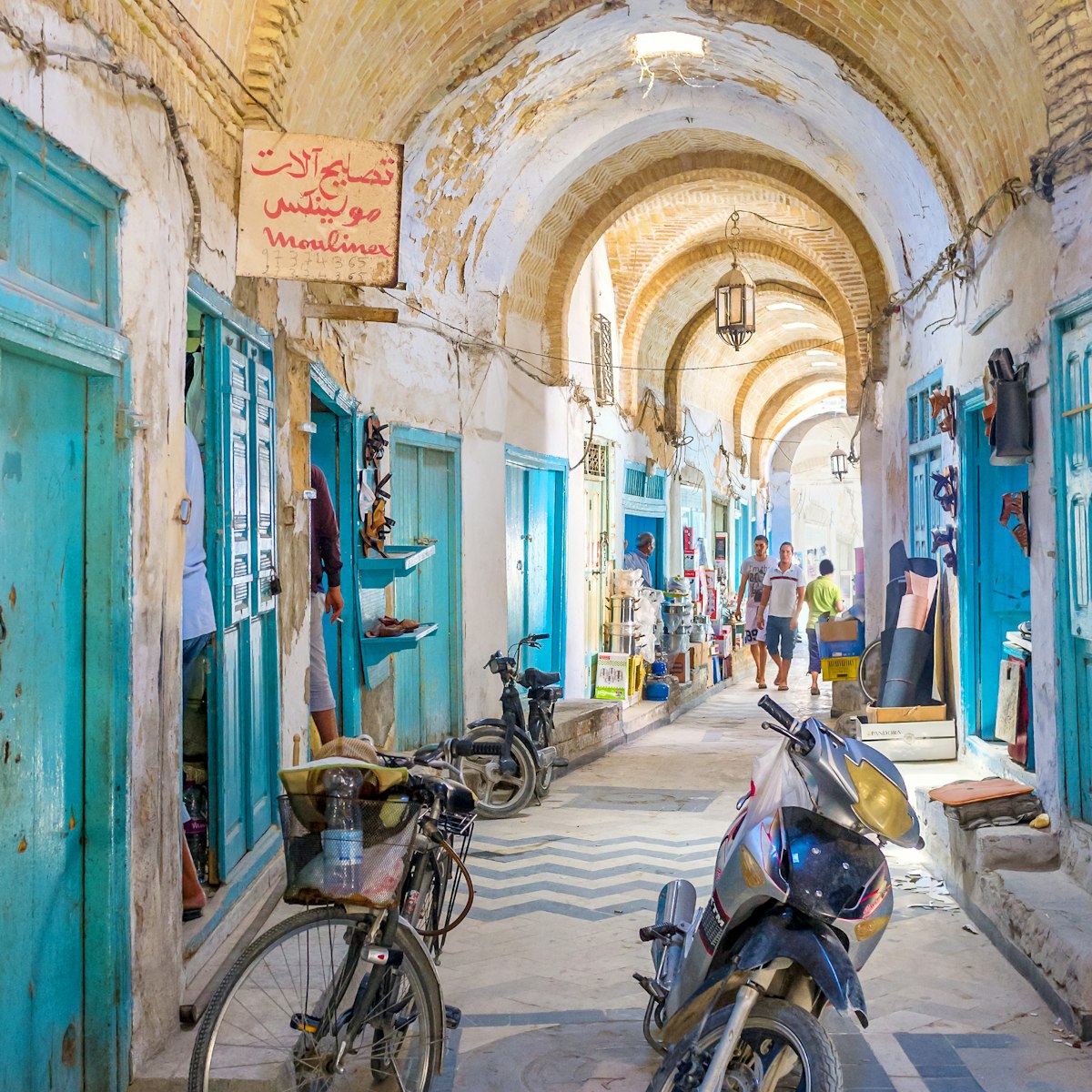
Kairouan’s medina feels like it ebbs and flows to a different rhythm to modern Tunisia. Long protected by its monumental walls and babs (gates), most of…

Sousse Archaeological Museum
Located inside the 11th-century kasbah, this museum showcases an extraordinary collection of 2nd- and 3rd-century Roman mosaics, one of the best in the…
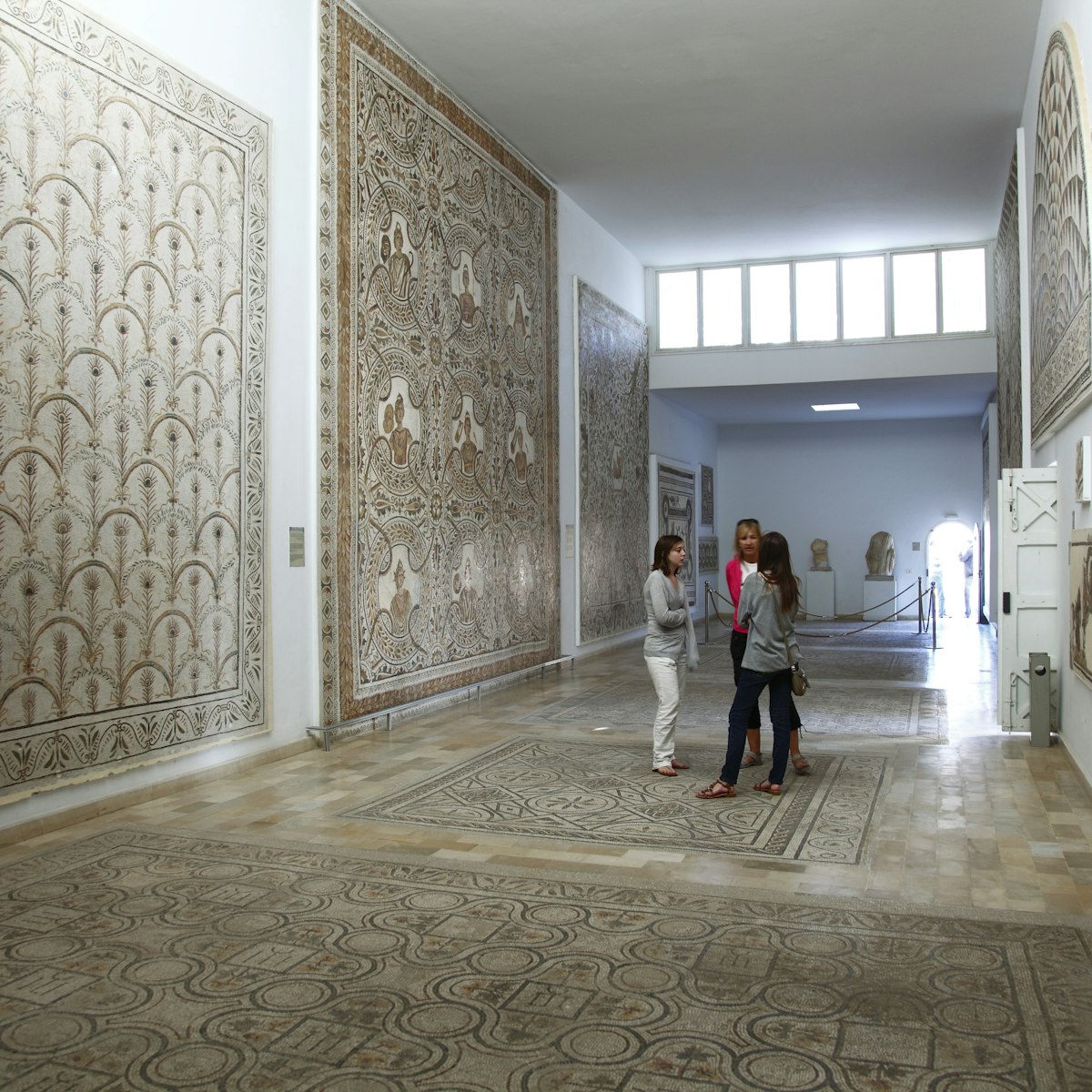
Archaeological Museum
A 1km walk from the El Jem Amphitheatre (follow the signs), this museum showcases an exceptional collection of Roman mosaics. All are richly coloured, in…
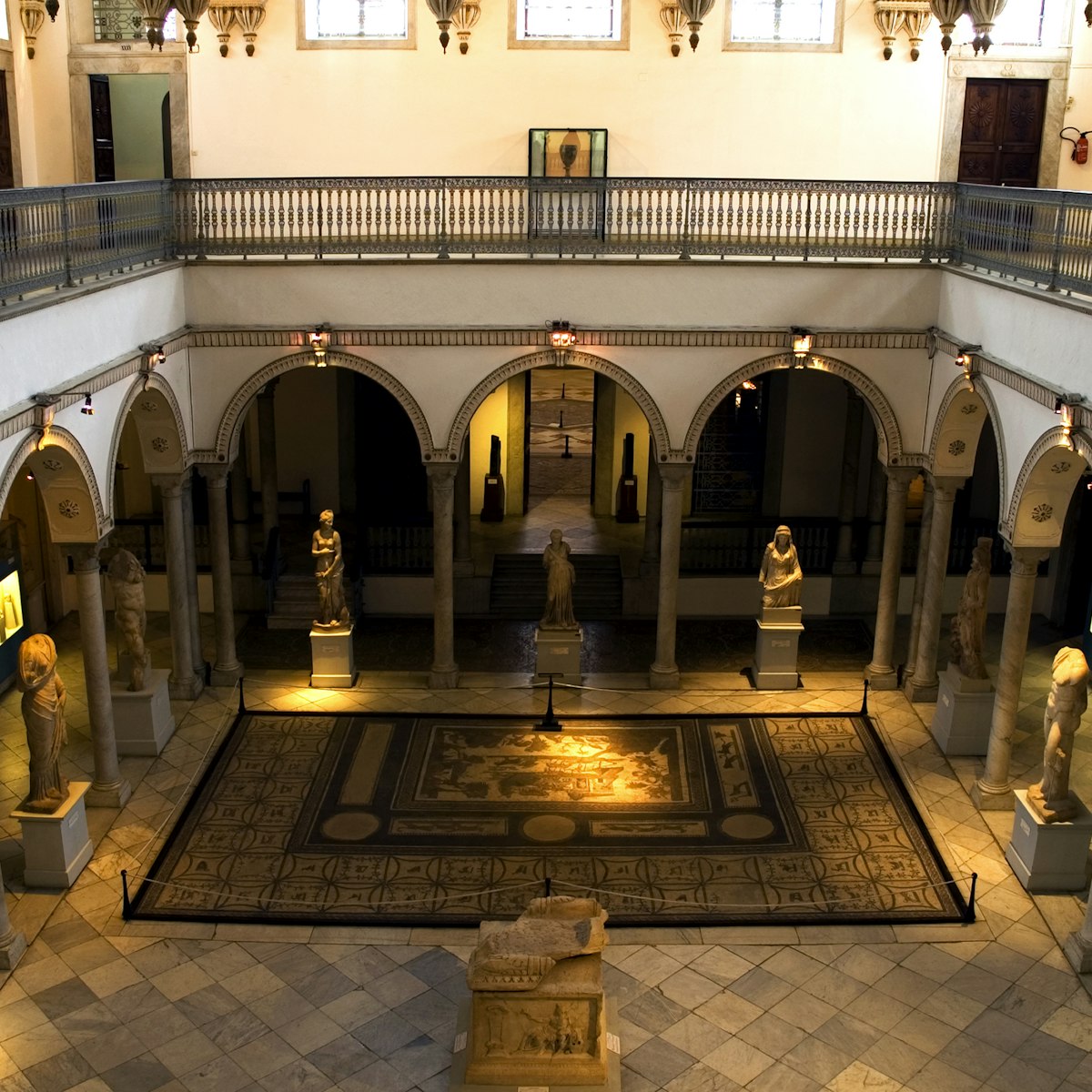
Bardo Museum
The main draw at the Tunisia's top museum is its magnificent collection of Roman mosaics. These provide a vibrant and fascinating portrait of ancient…
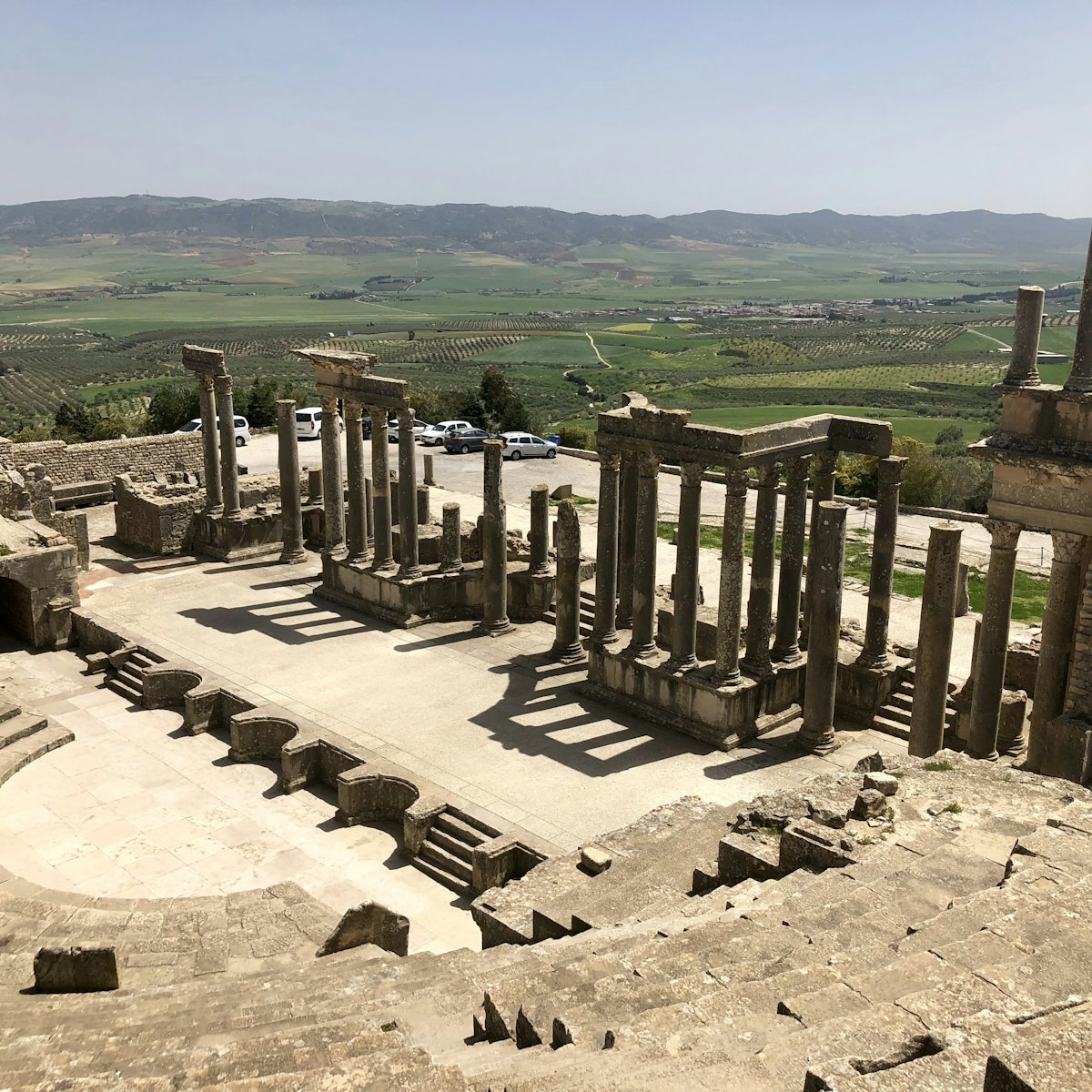
Arguably the most magnificent Roman site in Africa, Dougga’s ancient remains – a Unesco World Heritage site since 1997 – are startlingly complete, giving…
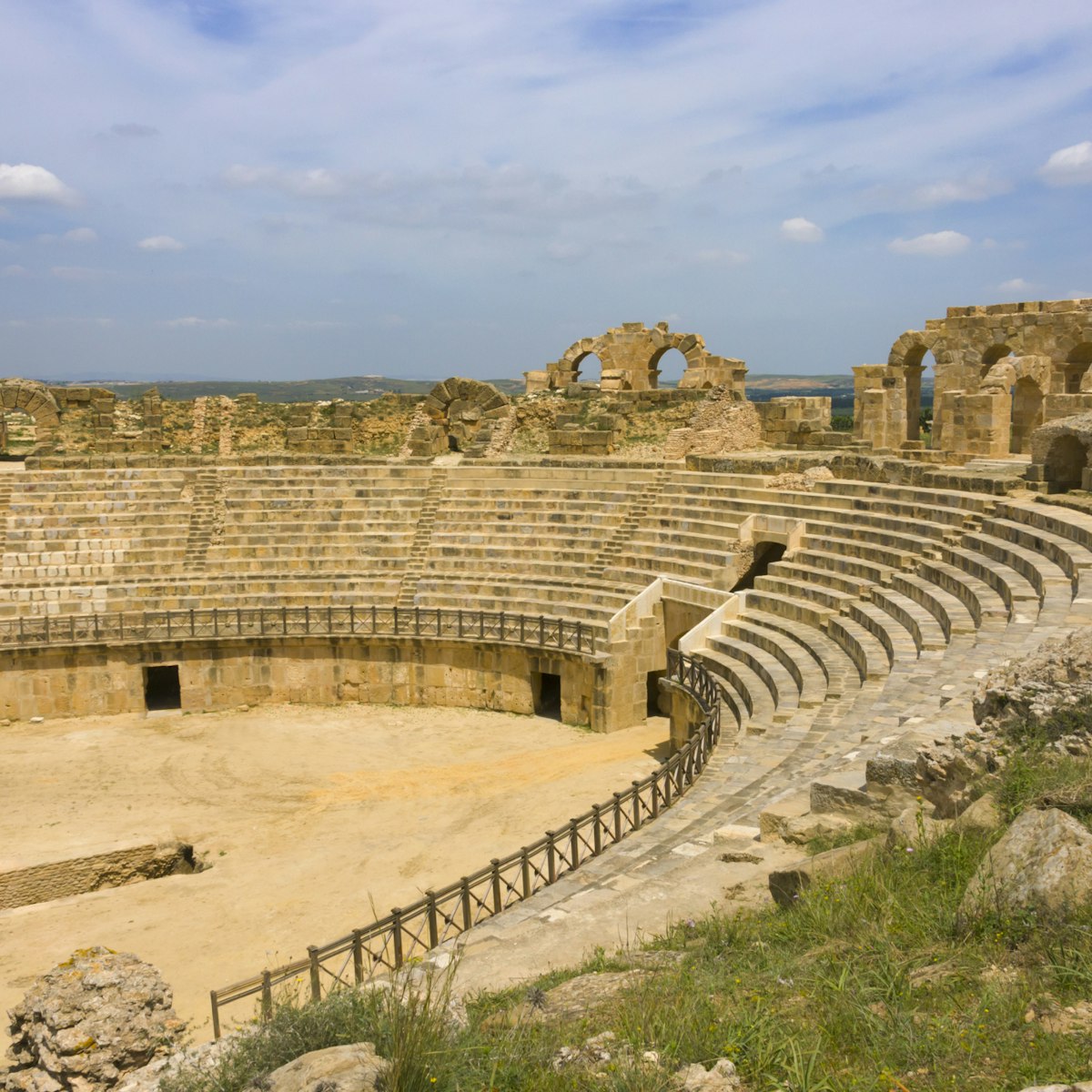
On the cultivated amber slopes of Mt Mekrima, the fascinating but little-visited ruins of ancient Uthina are the remains of one of the Roman Empire's…
Latest stories from Tunisia
Filter by interest:
- All Interests
- Adventure Travel
- Art & Culture
- Beaches, Coasts & Islands
- Food & Drink
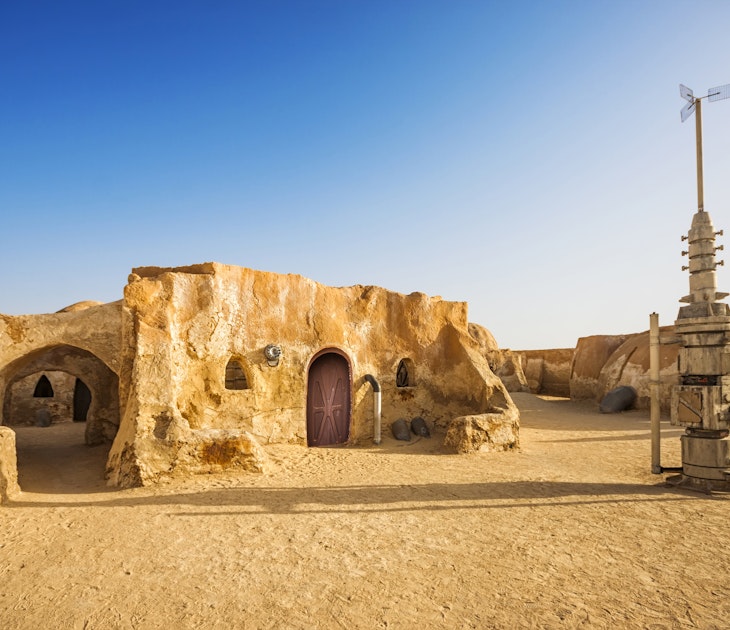
Dec 7, 2020 • 2 min read
It will cover more than 15 sites across 10 regions and will highlight films including Star Wars, Monty Python: The Life of Brian and Indiana Jones.
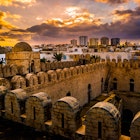
Jun 12, 2020 • 1 min read
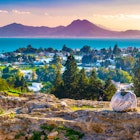
Nov 20, 2019 • 6 min read
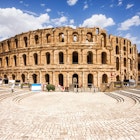
Nov 13, 2019 • 5 min read
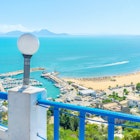
Apr 17, 2019 • 6 min read
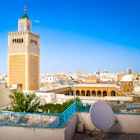
Mar 14, 2019 • 7 min read

Feb 22, 2019 • 5 min read
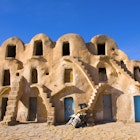
Feb 19, 2019 • 8 min read

Jan 4, 2019 • 5 min read
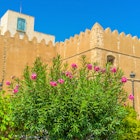
Nov 8, 2018 • 6 min read
in partnership with getyourguide
Book popular activities in Tunisia
Purchase our award-winning guidebooks.
Get to the heart of Tunisia with one of our in-depth, award-winning guidebooks, covering maps, itineraries, and expert guidance.
Tunisia and beyond
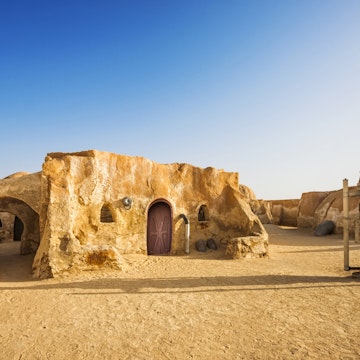

IS TUNISIA CHEAP TO TRAVEL?
02 Sep 2023 || TUNISIA
Tunisia is well away from the typical backpacker trail. It’s the northernmost country in Africa, just across the Mediterranean Sea from some of the most expensive, least budget-friendly countries of Europe. Despite millions of tourists flocking to the European continent every year, only a fraction visit Tunisia – and they’re all missing out. This, despite the country being notable for not just everything Star Wars, but impressive beaches, Roman ruins and energetic markets too. Moreover, everything in Tunisia is competitively priced for backpackers and budget travellers.
After spending a month in Tunisia on a kind of backpacker budget and, as always, recording exactly what we spent, we tallied it all up to get an accurate portrayal of what the country costs to travel. We’ve broken down our totals into transport, food, accommodation, attractions, alcohol, sim cards and more to help you budget your own epic budget/backpacking trip around Tunisia!
Hopefully we can answer the (slightly subjective) question – is Tunisia cheap to travel?
IN THIS GUIDE //
Is Tunisia Cheap to Travel?
Currency in tunisia, closed currencies.
CASH AND CARD IN TUNISIA
– ATM CHARGES IN TUNISIA
– MONEY EXCHANGES IN TUNISIA
I S TUNISIA CHEAP TO TRAVEL?
– TRANSPORt PRICES IN TUNISIA
– ATTRACTION PRICES IN TUNISIA
– FOOD AND DRINK PRICES IN TUNISIA
– ACCOMMODATION PRICES IN TUNISIA
– MISCELLANEOUS PRICES IN TUNISIA
OUR EXACT COSTS
HOW TO SAVE MONEY ON A TUNISIA BUDGET
FINAL THOUGHTS – IS TUNISIA CHEAP?
Tunisia’s currency is the Tunisian dinar, sometimes denoted as DT or TND. It is then divided into a thousand millimes or millim. Tunisian currency comes as both notes and coins, with the 5, 10, 20 and 50 notes most frequently used. Tunisian dinars and millimes both feature Latin numbers on them (although the coins can be difficult to read!).
At time of writing (September 2023), the rates against various well-used currencies are as follows (check xe.com or Google for up-to-date rates):
1 GBP = 3.8 Dinar
1 EURO = 3.3 Dinar
1 USD = 3.1 Dinar
If you are planning on exchanging money in Tunisia, we would recommend taking either British pounds, euros or U.S. dollars as these are readily accepted at money exchanges.
Similar to currency in countries like the Maldives and Laos (and many others around the globe), the Tunisian dinar is a closed currency. This means it is a criminal offense to import or export Tunisian currency in or out of Tunisia. If exchanging money at the end of a trip, proof of withdrawal from a bank is needed to exchange into another currency. An ATM receipt will not suffice.
We’ve heard of situations where border control have checked tourists for dinars on departure – everything in Tunis International Airport is priced in euros (and particularly expensive).
Try and only take out as much cash as you need!
A WEEKEND IN TUNIS | STREET ART OF DJERBAHOOD
CASH OR CARD IN TUNISIA?
Credit cards are accepted in many places in Tunisia, such as supermarkets, hotels and restaurants, however we would always advise having some cash accessible for small purchases.
Tunisia’s tourist infrastructure is continually improving since the pandemic and is improving on the 12,000 point of sale credit card machines World Bank reported in 2011. However, the reality is that in local shops, taxis and small restaurants, it isn’t possible to use credit card yet.
Supermarket chains such as Carrefour, Monoprix and Geant, any tourist-leaning stores, most larger hotels and restaurants will all take credit cards. Of these, Visa and Mastercard are widely accepted but American Express is also usable in some places. Most gas stations accept credit card (although sometimes there’s a wait for the card machine).
Although card payments are prevalent, we still had to wait to pay for our car hire because the machine wasn’t charged up!
We didn’t actually use a huge amount of cash – local food is inexpensive and visiting during Ramadan meant we didn’t frequent too many restaurants. Most of our currency was used at gas stations and for attraction tickets (although you can often pay on card for these too).
⋅ ATM CHARGES IN TUNISIA ⋅
ATMs in Tunisia typically charge between 10-12 dinars (around £3) per withdrawal. We paid 11.9 dinars when withdrawing the maximum 300 dinars from a Tunisian ATM (the maximum varies per bank).
There are apparently some ATMs that don’t charge at Tunis Airport so if you find one, please let us know in the comments section!
⋅ MONEY EXCHANGES IN TUNISIA ⋅
Money exchanges in Tunisia (Bureau de Change) can be found in the airport and in a few places across the cities. There are lots around Tunis , Sousse has a few and there are also some in Djerba.
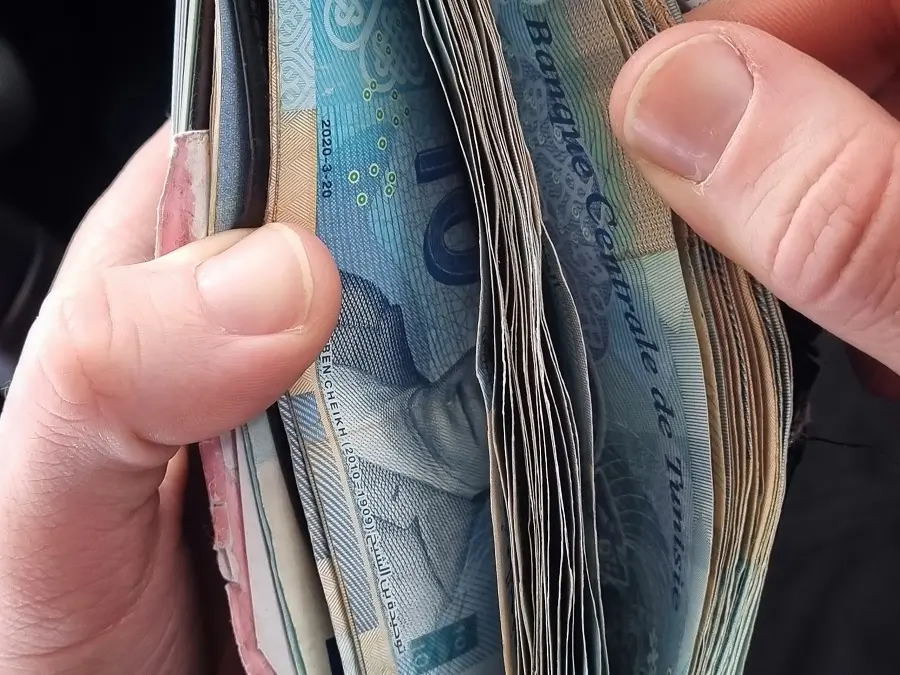
As with many other popular backpacker countries, Tunisia can be as expensive or as cheap as you want it to be. There are high-end luxury hotels, especially in Tunis, which can run as high as £400-500 a night; homestays in local dars are generally very affordable, even for a bargain-basement backpacker. Food costs are incredibly cheap at the lower end; a quality glass of wine in a rooftop bar in Tunis could set you back a pretty penny.
It’s a fantastic country in that respect – if you want a classy, wine-fuelled beach resort or a homestay with a local family – Tunisia can offer you both for a fraction of the price of Europe.
⋅ IS TUNISIA CHEAP - TRANSPORT ⋅
Tunisian transport is very affordable. Whether you hire a car, take the public minivans or catch a train, getting where you need to be is easy, efficient and inexpensive. For a little more information on getting around Tunisia, check out our backpacking in Tunisia guide.
Out-of-season car hire in Tunisia can be quite cheap but, from our experience, it gets more expensive in the summer months and closer to the booking date. Automatic cars typically cost more than manual cars.
We actually stayed in Tunisia longer than originally planned. This meant extending our original Tunisia car hire several times and also hiring from a different company towards the end of our trip due to a lack of vehicle availability. The car rental extensions and second booking cost a *huge* amount more than our initial reservation. Book *well in advance* for best rates.
In Tunisia, we do recommend taking the full insurance from whoever you use as your rental broker for peace of mind. This adds on an extra cost (we pay for the extra insurance in every country we’ve driven in across the world – it’s saved us a few times!). We use Discover Cars for all our car rental – their insurance actually pays out in the event of an accident.
If you are interested, check out our post on self-driving in Tunisia . Hopefully it’ll settle any unsure thoughts and persuade you that it’s an excellent idea!
CAR HIRE FOR YOUR TUNISIA ITINERARY
We always rent our vehicles all over the world, including our recent trips in Tunisia, Oman, Saudi Arabia and Jordan with Discover Cars . They’re often the most affordable, plus they paid out immediately on an insurance claim we made when our car took some heavy damage in Sicily. We fully recommend them.
If you book through the link below, we make a small profit, at zero cost to you, which helps us write these posts with no advertising! We only endorse products and companies we *actually* use regularly. For more information, read our position on affiliates .
TAKE A LOOK BELOW OR CHECK CAR RENTAL
The Tunisian shared taxi or ‘Louage’ is a fantastic budget method of getting around and between any city or town in Tunisia.
For example, travelling from Sousse to Tunis costs around 12 dinars (about £3.10) for about a two-hour trip. From Djerba to Kairouan is about 24 dinars (£6). These run all over the country and are easy to figure out – most cities will have at least one Louage station – ask your accommodation and check Google!
Train routes cover the northern part of Tunisia, down to Gabes. They are a very affordable option for any route in Tunisia (although Louages are considered faster and more efficient).
The most popular train route is within Tunis, called the Tunis-La-Goulette-Marsa line (TGM), which runs from Tunis Ville Nouvelle to the tourist attractions at La Goulette, Carthage, Sidi Bou Said and La Martha. Single trips start from under a dinar (although *I think* we were sold a return and it was all a bit confusing).
Taxis in Tunisia are very reasonable, especially compared to most cities in Europe. We only used taxis in and around Tunis and our most expensive taxi was just under 20 dinars (£5.20) for a 45-minute journey.
We would recommend downloading the Bolt app in Tunisia if you’re planning on getting many taxis. It functions just like Uber, so you order a taxi online and with a predetermined destination. At time of writing, this app did not accept credit cards as payment. Bolt is particularly useful for those who don’t speak much French or Arabic (like us!).
Petrol/Gas Prices in Tunisia
In Tunisia, gas is extremely affordable. For us, it was priced around 2.52 dinars per litre (£0.65) during our visit. Tunisia is a reasonably compact country anyway, so with low gas prices, it is a cheap place to road-trip. Gas is sold by the litre in Tunisia.
Highway Tolls in Tunisia
We drove a considerable distance on our four-week itinerary in Tunisia and took the toll roads any time it made sense to because they were substantially faster (and empty and well-paved).
The prices were extremely reasonable. In total, we paid 17.8 dinars (£4.70) on tolls in Tunisia during our 4000-kilometre trip. The fees are payable at booths by the exit of your toll-road stretch. There were often screens displaying the cost and the attendants spoke French. We always paid by cash.
Parking Prices in Tunisia
This was an amazing thing about Tunisia – we paid zero parking fees, anywhere! There were almost no parking restrictions apart from in major cities, which also usually had plenty of free street parking. There are no roving parking attendants, like in Morocco, and we never struggled to find parking.
All hotels had free, often private, parking.
Don’t drive in the Tunis medina area, it’s the one place that has almost no parking options – you’ll have a shit time trying to drive around it, let alone find parking.
⋅ IS TUNISIA CHEAP - ATTRACTION PRICES ⋅
Generally, we found that everything was priced very reasonably for access to sites in Tunisia. The only entry fees we paid were to (many) Roman ruins and the incredible mosque in Kairouan.
The archaeological sites we visited (Utique, Uthina, Thurburbo, Carthage, El Jem and Dougga) are at a fixed price by the government and most cost 8 dinars (£2.10). The entry fees for Carthage (full site ticket) and El Jem were 12 dinars (£3.10) each. Kairouan’s Mosque (Sidi Okba Mosque) also cost 12 dinars (£3.10).
Everything else we visited was free, including parking around medinas and beaches.
We didn’t do any tours whilst there as we self-drove.

⋅ IS TUNISIA CHEAP - FOOD AND DRINK PRICES ⋅
As we visited during Ramadan, we ate a lot from supermarkets and made the absolute most of any free food provided for breakfast. Below are some details of our costs.
Supermarkets
Our experience was that products from supermarkets like Monoprix and Carrefour were moderately priced. Certain items, such as cheese, were surprisingly expensive in Tunisia though, with few good options available. Some prices of things we bought (or spotted) include:
Large baguettes – 0.85 dinars (£0.22)
Small baguettes – 0.29 dinars (£0.08)
Water (1.5 litres) – 0.65 dinars (£0.15)
Coke Zero (1 litre) – 2.24 dinars (£0.58)
Jars of tomato pasta sauce – 14.79 dinar (£3.84)
Small peach Greek yoghurts – 0.98 dinar (£0.25)
Gouda cheese (small block) – 10.38 dinars (£2.70)
Fruit and Vegetable Markets
We found these often had cheaper options than the big supermarkets, though a more limited variety. In Ayn Darahim, for example, we bought three huge tomatoes for 0.45 dinars (£0.12) that lasted us two meals.
Boulangeries and Patisseries
French cuisine is commonplace in Tunisia and none more so than the baked goods department, both sweet and savoury. A selection of pastries and cakes can be found for incredibly reasonable prices. Large fresh baguettes, for example, were often only 0.2 dinars (£0.05), a quarter of the supermarket equivalent (and much nicer).
Restaurants
Because it was Ramadan during our visit, we didn’t dine in at as many restaurants as a typical tourist usually would. Most were closed until the Iftar meal and some only offered an Iftar buffet option in the evenings.
We saw lots of Iftar menus advertised at 70-75 dinars (£18-20) each (day-after-day of this would have made us both incredibly fat and poor!).
Some examples of restaurants we did visit: one charged 39 dinars (£10.15) for 2 medium vegetarian pizzas and another charged 21 (£5.50) dinars for two vegetarian paninis.
This was moderately priced on hotel bar menus (the only place you could buy alcohol during Ramadan). We didn’t buy any, but the national Tunisian beer, Celtia, was usually priced at 7.5 dinars (£2.00) for a 330ml bottle and a 750ml bottle of Tunisia’s ubiquitous Magon red wine was around the 40-47dinar (£10-12) mark. These prices, because they were in hotels, would almost certainly be far more than in smaller, local places.
Outside of Ramadan, alcohol is commonly served in various restaurants, but we didn’t get to see this.
⋅ IS TUNISIA CHEAP - ACCOMMODATION PRICES ⋅
This was one of the most expensive parts of our Tunisia budget. It was at the end of a nine-month trip (that felt like three years), and we couldn’t be bothered to budget too hard.
During our one-month road-trip around Tunisia we stayed in a super fancy (read: budget destroying) place for our last two nights. We highly recommend this stunning, traditional dar, with incredible original heritage features but super modern, classy suites – it’s got the best of both worlds. The rooftop bar is one of the best we’ve ever been too as well. It is called Dar El Geld – take a look, it’s exquisite and worth the money. There are not that many rooms, so don’t book too late.
For 10 days, we rented apartments with kitchens so we could prepare meals (due to Ramadan).
We also stayed in some (far cheaper) homestay-style dars, which really helped balance out the cost!
Our accommodation was often booked last-minute (commonly as a walk-in) to maintain flexibility. It is certainly possible to save money by booking further ahead and also by not having a kitchen.
In Tunisia we used a cashback app for any online accommodations. It saved us loads – from 4-15% per night on platforms like Agoda and Booking.com.
⋅ IS TUNISIA CHEAP - MISCELLANEOUS ⋅
The largest miscellaneous cost we had in Tunisia was our local Tunisian sim cards and an Airalo e-sim. We also paid one ATM fee of 11.9 dinars.
There are three mobile networks in Tunisia to choose from – Ooredoo, Orange and Tunisie Télécom. We bought a 5 Gb and 25 Gb sim card at Tunis airport for 45 dinars (£11.85) total from Ooredoo, who we’ve used before in places like Oman and the Maldives .
Ooredoo worked fantastically apart from in a few areas of Ayn Darahim in the far north-west of Tunisia.
If you aren’t coming into Tunisia by plane (for example, arriving by ferry like we did) you could also consider getting an E-sim. These are simple and start working as soon as you’re in the range of the country. Airalo currently offer E-sims starting at just $5 – we purchased one of these for our midnight arrival and it worked brilliantly.

IS TUNISIA CHEAP? OUR EXACT COSTS
Below is a breakdown of all the sections discussed above, showing the exact costs for 28 days in Tunisia during the month of April.
In the end, our total was 9550.30 dinars (£2480.60) , which is 4775.15 dinars (£1240.30) per person, a total of 170.54 dinars (£44.30) per person, per day.
Miscellaneous – 56.9 dinars (£14.78)
Accommodation – 4164.6 dinars (£1082)
Car hire – 3589.86 dinars (£932)
Tickets and sightseeing – 114.6 dinars (£29.77)
Petrol – 692.00 dinars (£180)
Other transport (taxis, trains, louages and tolls) – 96.2 dinars (£24.98)
Food and drink – 836.11 dinars (£217)

Although we are happy with how much we spent on this one-month trip, it is absolutely possible to cut costs substantially. Below are a few ways we think our Tunisia budget could be reduced.
⋅ HOW TO SAVE MONEY ON OUR BUDGET ⋅
Plan ahead (better than us).
Whilst we love to travel spontaneously and be flexible, it does often increase expenditure. There are several things that could save you money – specifically renting a car well ahead of time, securing accommodation before the day of arrival, and having a proper itinerary to save backtracking and messing about.
One day I’m sure we’ll start planning more efficiently, but apparently Tunisia was not the time for it!
Cheaper Accommodation
As much as I fully endorse the incredible dar we stayed in during our final few nights, it was, without a doubt, a crazy luxury purchase (of several hundreds of pounds). A few other hotels we stayed in were more expensive than we’d usually pay because we were exhausted and didn’t do much research.
Accommodation, especially outside of Tunis, is incredibly good value in Tunisia – we feel like you could easily halve the total we spent and still stay at comfortable places.
Food and Drink
This was a pretty good section of our budget for us because we rarely ate out. Ramadan was a major contributor to this as most places were closed when we’d normally eat dinner.
Our biggest weakness was snack foods for the car drives, although these were still pretty cheap.
I drink an inordinate amount of coke (zero) and Nick loves coffee. It would certainly be easy to reduce our food and drink budget by having just water instead.
We bought a large, 25 GB sim card so we could tether from it whilst working and keep our billions of photos backed up on the cloud. If you do not take 283,567 pictures an hour then a smaller sim card will more than satisfy a month in Tunisia, even without any hotel Wi-Fi.
I know it was briefly mentioned above about saving money by planning, but I thought I’d reiterate *how extreme* the cost was to add extra days on to our car rental – It was mildly obscene (way more than double). Book ahead for car rental, as far as you can, to save money. Our first rental was really great value so it kind of shocked us!
Another thing to mention is that manual transmission cars are the norm in Tunisia. It’s far easier and cheaper to rent a manual than a car with an automatic transmission. Also, we found that they ran out of automatics quite quickly (it’s why we booked with a different rental company at the end). You can definitely cut our car budget down if you’re comfortable using a manual! (We are British, so drive a manual at home, but on the left side of the road!).
Obviously, it is possible to use louages for the entire trip which is far cheaper, but you lack in flexibility and it will take longer to see the sights.

FINAL THOUGHTS - IS TUNISIA CHEAP
Tunisia was as affordable as we’d hoped, considering the minimal research we did before arriving. It’s a great value destination, with magnificent sights, beaches, medinas and ancient ruins, all for a fraction of the price in Europe, just across the Med.
Our best budget ‘award’ during our Tunisia trip goes to all the free parking! I know it’s not much, but parking in every city and town can really add up after a while and the ease of driving and parking was just amazing. The second big win for Tunisia, finances-wise, were those incredible 5p fresh-baked baguettes. Although not hugely nutritious, they were top-notch and saved our food budget (plus they were sometimes the only available food)!
We really loved our road trip around Tunisia . Considering the number of places we visited and the amount we got to see (despite our appalling planning), we’re really pleased with what we spent and think it was absolutely worth it.
So, in our opinion, Tunisia is cheap to travel as a wonderful, slightly alternative, backpacker destination.
We hope you have a fantastic trip and spend far less than we did! Let us know in the comments if you have any questions.
Hi, thanks for visiting our blog! If this post has been of help to you, or you’ve just enjoyed our random ramblings and musings, say thank you by buying us a coffee ! It helps keep The Restless Beans blog up and running without ads.
Thank you, Claire + Nick

Leave a Comment Cancel Reply
Your email address will not be published. Required fields are marked *
Save my name, email, and website in this browser for the next time I comment.

Backpacking in Tunisia – A Complete 2023 Guide

Tunisia Itinerary: a 2-4 Week Detailed Route

Is It Safe to Drive in Tunisia? A Complete Guide
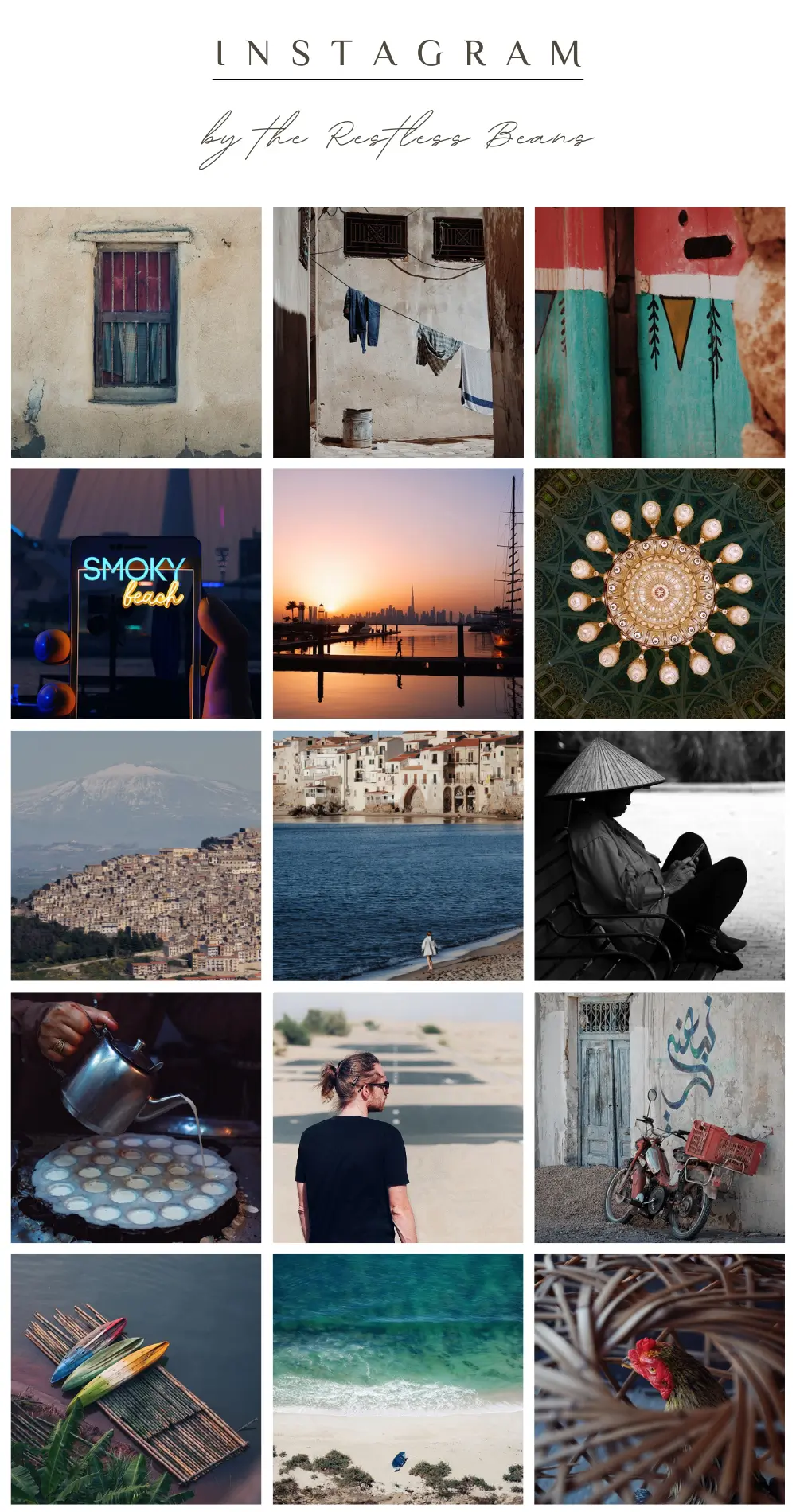
Privacy Policy

SUBSCRIBE FOR A MONTHLY UPDATE.
NEW POSTS + ROUND-UP + TRAVEL NEWS
Planning a Trip?
BARGAIN FLIGHTS
CHEAP CAR HIRE
DESTINATIONS
INTERNATIONAL LUGGAGE STORAGE
S.E. ASIA TRAVEL
CASHBACK ON HOTELS
PACKING LIGHT
ETHICAL TRAVEL
If you book through the links above, we make a small profit, at zero cost to you, which helps us write these posts with no advertising! We only endorse products and companies we *actually* use regularly. For more information, read our position on affiliates .
Copyright © 2024 The Restless Beans
Welcome to The Restless Beans!
Sorry for the annoying pop-up. Just click on out if it’s not for you.
Sign up for a monthly round up of new posts, travel updates, guides, tips and quirky travel news – never any junk or spam. We hate that stuff.
– Upcoming content from: Morocco, Oman, Sri Lanka & Saudi Arabia –
Thanks, Claire + Nick
- South Africa
- El Salvador
- Bosnia and Herzegovina
- North Macedonia
- Czech Republic
- Transnistria
- Liechtenstein
- North Cyprus
- New Zealand
- Map with posts
- Alternative Guides
- Architecture Guides
- Cafe Guides
- Itineraries
- Neighborhood Guides
- Travel Guides
- Travel Tips
- Photo Galleries
- Photo Locations
- Solo female travel
- Train Travels
- Work with me
- Privacy Policy
Tunisia Travel Guide – All About Visiting Tunisia
Planning holidays in Tunisia? You will not be disappointed! The country was one of my best travel discoveries recently; I was so impressed with all the remarkable monuments, historical sites, UNESCO World Heritage Sites, beautiful landscapes, hospitable locals, and friendly vibe. Whether you are traveling to Tunisia to relax on the beach or to explore this fascinating country, you are in for a treat.

I put together this Tunisia travel guide to help you prepare for your trip to Tunisia with all the info you might need. In this article, you will find all you need to know about visiting Tunisia and having a hassle-free time there. Read on, plan your trip, and enjoy Tunisia!
Planning a trip to Tunisia?
Here are the services I always use and personally recommend:
- Accommodation : I always book a place to stay on Booking.com
- Tours: when I decide to go on a tour I use either Viator or Get Your Guide .
- For transportation and booking tickets online , I usually use 12Go or Omio
- Looking for the airport pickup ? Check Welcome Pickups!
- If you plan to rent a car during your trip to Tunisia check Discover Cars to compare prices and find the best deals
- Get insured for your trip to Tunisia with SafetyWing
Table of Contents
Basic information on Tunisia
Where is tunisia.
Tunisia, a country of over twelve million inhabitants, is located in North Africa, on the shore of the Mediterranean Sea. It neighbors Algeria on the west and Lybia on the east.
Why visit Tunisia
For some reason, Tunisia isn’t as popular among tourists as nearby Morocco and Egypt , yet the country offers exceptional sights and monuments and perfect opportunities for relaxing holidays at the sea. It is also not so spoiled by tourism as the two countries mentioned above, which makes visiting Tunisia so much easier and more pleasant.
If you are looking for exceptional Roman ruins, vibrant yet charming medinas, beautiful architecture, stunning views, or even some alternative sites – Tunisia is a place for you. There are so many great places to visit and things to do in Tunisia that you will be impressed with all the country has to offer!

Planning a trip to Tunisia
Best time to visit tunisia.
The best time to visit Tunisia is spring (April-May) or autumn (October-November). The weather is good then, perfect for relaxing on the beach and sightseeing. Summer months can be too hot even for sun lovers.
I visited Tunisia in early January, and it was perfect for sightseeing, with mostly sunny days and temperatures around 15-20C (sometimes even more). There were also very few tourists around, making sightseeing much nicer.
Insurance for Tunisia
I believe you should always have insurance when you travel as you never know what might happen, and better safe than sorry. And the same goes for a trip to Tunisia. You can buy travel insurance with the trusted company, SafetyWings, here .

Visa for Tunisia
Most nationalities don’t need a visa for a stay of up to 90 days. If you are from some countries in Africa, Asia, or South America, chances are you need a Tunisian visa before entering the country. You can get it in the embassy of Tunisia near you.
Before planning a trip to Tunisia, be sure to consult the website of the Tunisian embassy or your local Ministry of Foreign Affairs to check if a visa is required.
How to get to Tunisia
Unfortunately, Tunisia is not on the route of low-cost airlines, so getting there might be a bit tricky and expensive (that’s the most budget-consuming thing about visiting Tunisia). I flew with Air France via Paris, but you can also fly directly to Tunis from Rome, Cairo, Casablanca, Doha, Frankfurt, Istanbul, or Dubai. Check the local airline Tunisair, too, as it serves many direct flights to European airports.
Another good option to fly to Tunisia might be a charter flight. They serve primarily tourists who decide to go for resort holidays, but you don’t need to buy the whole package to use them; you can get the flight ticket only and use them too. Charter flights usually go to popular holiday destinations in Tunisia, which include the airports of Djerba, Enfidha–Hammamet, and Monastir.
I was considering flying charter to Tunisia, but flights from Poland were only once a week, on Thursdays, and the price wasn’t much lower than Air France that I used (where I could choose the dates that suited me). It’s worth checking charter flights, but in the end, the regular flight might still be your best option.

How many days for visiting Tunisia
The optimal time for visiting Tunisia is 10-14 days. This way, you can see all the highlights and best attractions in Tunisia as well as relax a bit at the seaside. Of course, the more, the better, but even with only one week in Tunisia, you can see a lot.
I spent ten days in Tunisia and was satisfied with what I saw then. Still, I wouldn’t mind spending an extra day or two simply doing nothing and enjoying the laid-back atmosphere of the seaside.
You can read my detailed 10-day Tunisia itinerary here.

What to see in Tunisia
Tunisia offers so many amazing places to visit, and what makes it a great destination is the diversity of attractions. Spectacular Roman ruins, incredible vibrant medinas, long sandy beaches, charming towns, and so much more – Tunisia has it all!
Some of the best places to visit in Tunisia (that I was lucky to see) are:
- Tunis – the capital of the country, with beautiful, UNESCO-listed medina and interesting architecture from the French colonial period
- Carthage – impressive ruins of the Phoenician city from the 6th century BCE and the most significant trade metropolis of the antique world, another UNESCO World Heritage Site
- Sidi Bou Said – a charming town on the coast just outside of Tunis, famous for its traditional white-blue houses and winding lanes
- Bulla Regia – an impressive archeological site known for its Hadrianic-era semi-subterranean housing and numerous mosaics still left in place
- Dougga – one of the best and most well-preserved Roman ruins I’ve ever seen, a massive site packed with original buildings from ancient times, another UNESCO site
- Testour – a 16th-century shelter for the Muslim and Jewish refugees from Andalusia who gave a distinctive look to the town
- El Jem – home to one of the best preserved Roman amphitheaters in the world, dating back to the 3rd century, included on the UNESCO World Heritage List
- Sousse – the third largest city in Tunisia, with UNESCO-listed medina and a great Archeological Museum, famous also for its long and sandy beach
- Kairouan – another UNESCO place, the town is known as a holy city in Islam, with incredible medina and stunning Great Mosque, among other attractions
- Djerba – the island is popular as a holiday destination for its long and sandy beaches, but you can also find there some alternative sites such as the town with over 200 murals or numerous abandoned hotels
- Ksar Ghilane – an Oasis on the edge of the Sahara desert
- Chenini – an old Berber village built into the mountains, partly abandoned
- Tataouine – the city is known primarily thanks to the Star Wars movies; you will find in and around the place numerous inspiration and filming locations for great films
Other interesting places that I missed but are still worth visiting include numerous seaside towns perfect for relaxing holidays (Hammamet, Nabeul, or Monastir), Chott el Djerid (the vast salt lake), Sbeitla (another ancient town), Matmata (the Berber village and the Star Wars filming location), or Tozeur and nearby mountain oasis villages.

How to get from Tunis airport to the center
Apparently, some infrequent buses run between the airport and the center of Tunis, but I’ve never seen them (and in total, I was four times at the Tunis Carthage airport). The best option is to take a taxi. The fair prices I found online are 30 TND in the day and 45 TND at night, but everything depends on the negotiation skills and meter use.
Fortunately, in Tunis, you can use Bolt cars and find the ride in the app. That’s what I did in Tunis, and I never paid more than 10 TND (that included my tip) for the ride between the airport and the center, doesn’t matter what time of the day I was going (once I had to be at the airport around 5 in the morning and price for Bolt was 6 TND at that time).
Since the area around the airport can be confusing for finding the car, I suggest going outside to the roundabout and getting the ride there (here is the exact location). It is so much easier and stress-free this way. When I arrived, I couldn’t find my driver at the airport, and eventually, we met at the roundabout; the second time, I went directly there and ordered my ride from that point.

How to get around cities
Again, taxis are your best option. In Tunis and Sousse, you can use Bolt, and that makes everything so much easier. In other places, like Djerba, you can use regular taxis. I found the taxi drivers in Djerba honest, and I wasn’t scammed even once there; usually, I even paid less than I assumed for the ride.
How to get around Tunisia
Tunisia doesn’t have very well-developed railway lines; however, you can use the train during your trip, especially on the Tunis – Sousse – El Jam route. You can find the schedules here, at the official website of Tunisian Railways.
The trains are a bit old but surprisingly comfortable, and the journey doesn’t take that long, although delays happen. There are two classes on the train, and I recommend getting tickets for the 1st class as they are not much more expensive, but the comfort level is much better.
Since I’m used to getting tickets in advance, just to be sure I have a seat secured, I went to the train station in Tunis shortly after arriving to get all my tickets. As it turned out, there was no need for that as everyone got the tickets just before the departure. You can go to the train station 15 minutes before the train and get the ticket there.
While the coach and seat are indicated on the ticket, no one cares about that, so sit wherever you want to, as long as the class is correct.
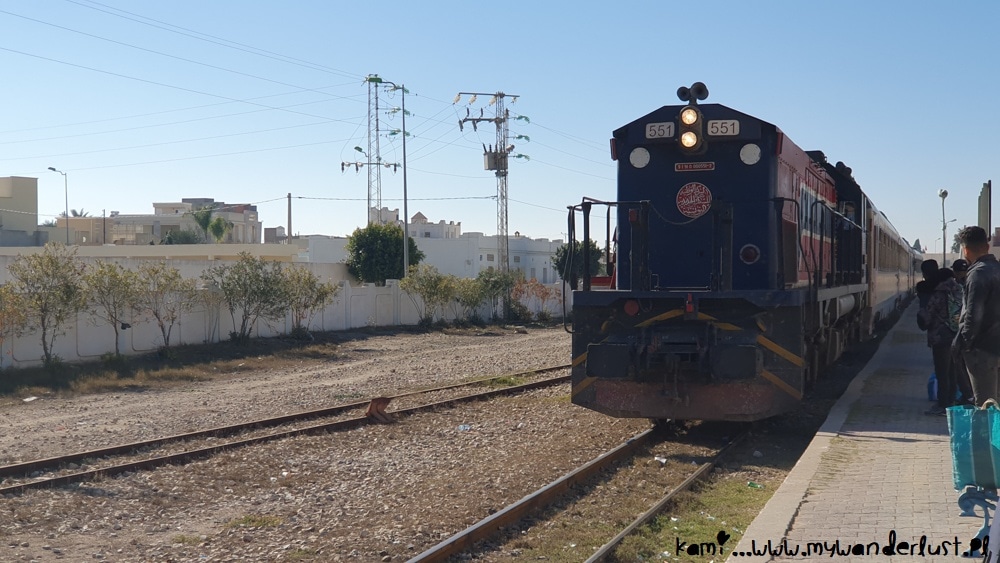
You can also take the suburban train from Tunis to Carthage and Sidi Bou Said. They depart frequently from the small Tunis Marine station, just a short walk away from the clocktower in the center of the city.
You buy the ticket in the window just before entering the platform – the same system works everywhere on this line. The ticket is really cheap, less than 1 TND for the ride from Tunis to Carthage or Sidi Bou Said.

Louages are the most popular way to travel around Tunisia. These minibusses can fit up to 10 people and depart when full. The whole system might look hectic, and the louages station can be a bit overwhelming, but everything is relatively straightforward and easy.
In bigger stations, you can find the signs with destinations, but even if they are not there, someone will tell you where to go so you won’t be lost for too long. You buy the ticket for the route you are interested in, and then you are pointed to the right car; once all the passengers arrive, you are ready to go.
I took louages from Sousse to Kairouan and back, and I never had to wait more than 5 minutes to go. As for the comfort, it depends on what kind of car you will get. On the way to Kairouan, the louage was jammed, and even if it was only an hour-long journey, my knees weren’t happy. However, on the way back to Sousse, it was spacious, and I could have easily gone in this kind of car for a few hours.

If you are short on time in your itinerary or don’t want to spend too many hours in louages, consider flying within Tunisia. At first, I was planning to take a louage from Sousse to Djerba, but it takes around 6 hours, leaving me with not enough time to explore the island, so I’ve decided to take the plane from Tunis to Djerba. And it was a perfect decision.
The flight was operated by Tunisiar Express and served by smaller planes – ATR 72. There is no online check-in, so you still need to wait in the queue at the airport, but at least you get checked luggage in the price. The flight time between Tunis and Djerba is around one hour.
Another place you might consider flying to/from is Tozeur, right in the heart of the Sahara, in the central part of the country, some 450 km away from Tunis.
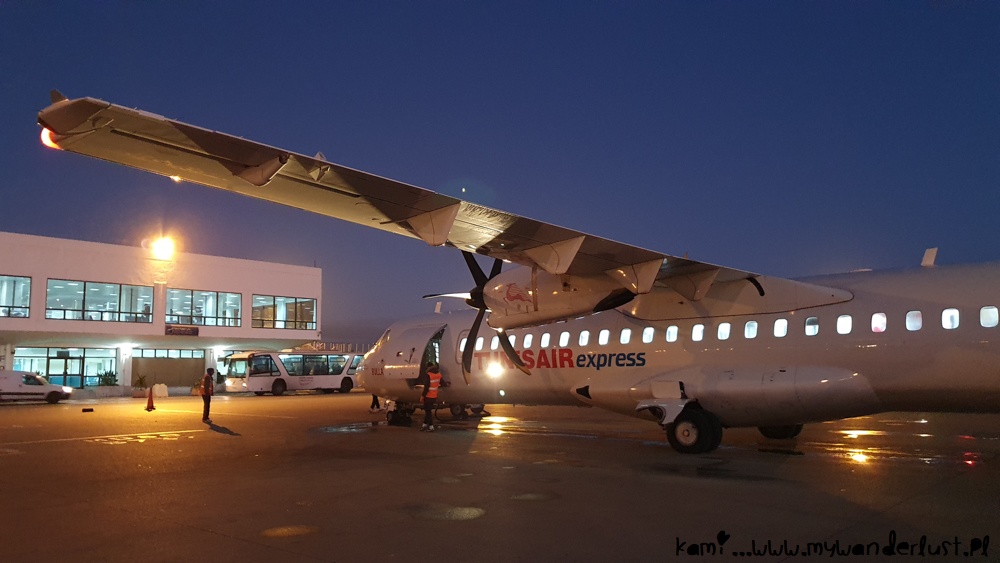
Unfortunately, not every interesting place and tourist attraction is reachable by public transport in Tunisia (or it’s too much hassle if you’re in the country only for a short time). That’s why it’s worth considering the tour. They might be a bit expensive, but in most cases, they are definitely worth it as the places you visit are pretty impressive, and it would be a pity to miss them when visiting Tunisia.
I went on two tours during my trip, from Tunis to Dougga and Bulla Regia and from Djerba to the Sahara desert and Chenini. I booked both of them in advance on Viator , and I was really satisfied with the choice as both tours and all the places were incredible. I booked both tours in advance, before arriving (that’s my preferred way of planning a trip), but I think you might also get them organized by your hotel when you are in Tunisia.

Language in Tunisia
The official language in Tunisia is Arabic, but French is widely spoken due to its history and connections with France. If you know French, you are good to go. I had to try really hard to remember some basic French from when I learned it at school some 20 years ago.
Getting around with English can be complicated as it’s not that popular, and sometimes it’s a bit hard to communicate with people only in English. But everyone is friendly, and they will do their best to help you and make you feel welcome even with the language barrier.
Money in Tunisia
The currency of Tunisia is the Tunisian dinar (TND). At the time of writing this article, 1 TND was worth 0,30€ or 0,33$. The banknotes are 5, 10, 20, and 50 TND; the coins are 5, 10, 20, 50, 100, 200 millimes, and 1/2, 1, 2 and 5 dinars.

Getting money in Tunisia
There are plenty of ATMs around where you can get money in Tunisia. Most of them charge a small fee for withdrawing money, usually 10-12 dinars – what’s interesting is that sometimes the fee varies even among the ATMs of the same bank. The only ATM that didn’t take a fee was the STB bank ATM in the arrivals at Tunis airport, just after the passport control but before collecting the luggage.
I used ATMs a few times and never had any issues, but I always use ATMs located at the bank, just in case. I also used my Revolut card.
Payment by card
Unfortunately, paying by card isn’t very common in Tunisia, so having cash with you is better; consider it when taking money from an ATM. I used a card only a handful of times, in hotels and at the airport; everywhere else, I paid by card.

Prices in Tunisia
Tunisia is, in fact, a very affordable country, and I was surprised by the prices there. To give you a few examples: a 3-star hotel in Djerba, with breakfast, was less than 30€/night, the first class train ticket from Tunis to Sousse was a bit over 3€, a hearty meal in one of the best restaurants in Sousse medina was 10€ and a quick fast food lunch was around 3€. The bottle of water is around 0,40€ and the bottle of cola around 0,80€. The fresh orange juice is around 1€. The cappuccino in Tunis cafe with the exceptional view of the medina is 2€.
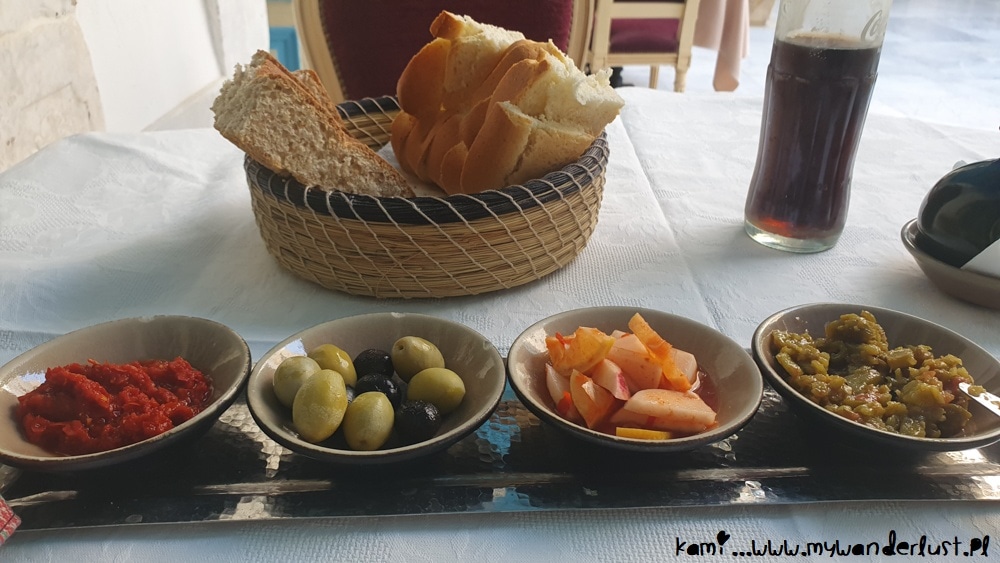
Entrance fee to attractions
Most attractions and monuments require a ticket, which is another really affordable thing in Tunisia. I paid between 5 and 12 TND for entrance fees.
If you decide to go to the Sahara desert, most likely you will go to the oasis Ksar Ghilan. You can go a bit into the desert on a camel or a quad there. The prices for around a 45-minute trip are 10€ for a camel or 30€ for a quad.

Safety in Tunisia
The most common question I got about traveling to Tunisia was about safety. As you might remember, in 2015, Tunisia was targeted by ISIS. Two of three terrorist attacks that took place then were aimed at tourists (in the Bardo Museum in Tunis and the seaside resort near Sousse). Since then, tourism in Tunisia really collapsed as people were afraid to travel to a potentially dangerous zone.
But a few years have passed, and Tunisia slowly gets back on the travel map, with more and more travelers deciding to visit the country. Most of them are, however, going on resort holidays or organized tours.
During my trip to Tunisia, I’ve barely seen independent tourists besides me, and exploring such an unpopular place was an interesting experience. But I’ve never really felt unsafe there. Quite the contrary, actually, as everyone was friendly and welcoming. I was expecting a bit of the hassle in tourist spots, similar to those you get in Morocco or Egypt, but during my whole stay there, I had only one encounter with the annoying local who insisted on showing me around the medina in Kairouan – he was quickly yelled at by the local lady from the shop and run away.
That said, you must follow safety rules like everywhere else and use common sense. Before your trip, check the warnings of your local Ministry of Foreign Affairs to see if there is any part of Tunisia that you should avoid.
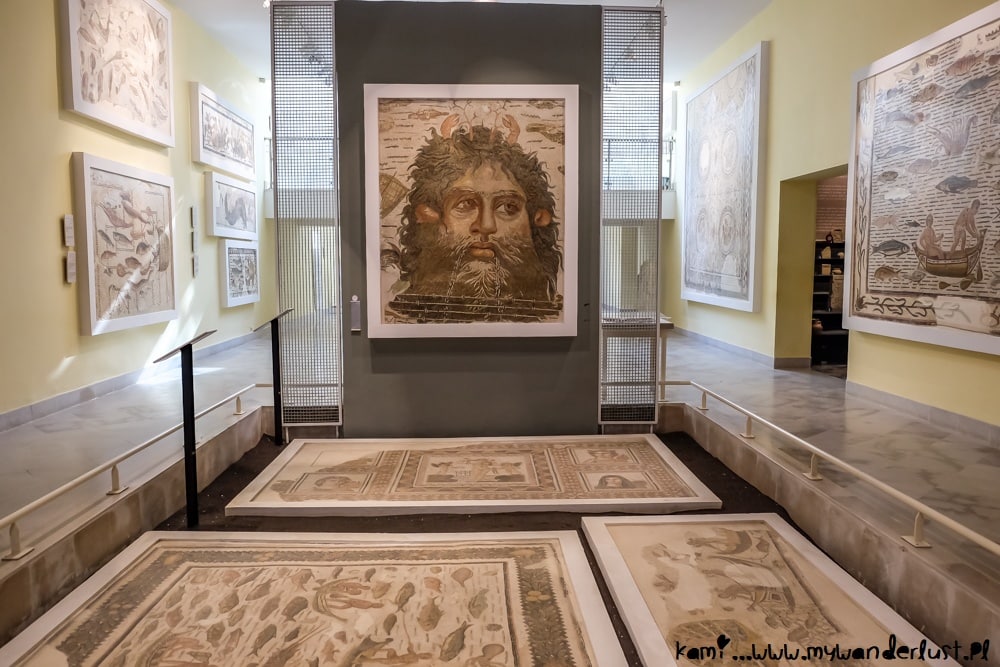
Solo female travel in Tunisia
I can’t count how many times I’ve heard the question of why I’m traveling solo in Tunisia (my usual answer was, “Why not?”). The concept of solo female travel isn’t popular there, and people couldn’t get why I’ve come there alone. But even if they didn’t fully understand, they were still very friendly and hospitable.
I didn’t have a single situation where I felt unsafe. The only time I felt more self-conscious than usual was when I was exploring abandoned hotels in Djerba, but it had nothing to do with the danger and more to do with my mind playing tricks. If you follow basic safety rules and your intuition, you will be fine.

Internet in Tunisia
Internet in Tunisia isn’t as widely available as you might wish. You can connect to wifi in hotels or some restaurants and cafes, but I would generally not rely on it too much. In two out of three hotels I’ve stayed at, I used my mobile data to surf online as wifi was too poor or acting up.
SIM card in Tunisia
As soon as I landed at Tunis airport, I got myself a local SIM card with internet data. There are three mobile phone networks you can choose from (Ooredoo, Orange, Tunisie Telecom), I went for Orange as their stand was the first one, just after passport control. There, I got a free SIM card with only a few bites included, but I went to the Orange shop in the arrivals, where they put the local SIM card in my phone and added extra bites. I paid 20 TND for 6 GB, which was more than enough for my trip. Maybe I overpaid, but then I saved the money on the Bolt ride from the airport versus taking the taxi, so I was good with that price.
When traveling around Tunisia, I didn’t complain about the network coverage. The only place where my Orange network didn’t work, but the other one (Tuntel) did, was the Sahara desert and near it.
You can also get a eSIM with Airalo for your trip to Tunisia, this way you will stay connected without all the hassle of getting a local SIM card. Click here to get the Airalo eSIM.

What to eat in Tunisia
The most popular food you can try in Tunisia is couscous, apparently the best in the world. It is prepared with spicy tomato sauce; you can choose different additions: meat, fish, or vegetables. Other dishes you might want to try include ojja – spicy tomato sauce with poached eggs and merguez; soups (like chorba or lablabi); tajine – the Tunisian version is made of eggs, potatoes, onion, garlic, parsley, grated cheese, happy cow cheese, salt, pepper, and turmeric (and then some extras, such as chicken, shrimps, or spinach), omek houria (spicy carrot salad), and tabouna (a traditional Tunisian bread).

Vegetarian in Tunisia
I was surprised by the challenge of being a vegetarian in Tunisia. In many of the restaurants, there was not a single vegetarian option on the menu, but as I quickly learned, it was not a problem at all. Everywhere I asked, they did something vegetarian for me – usually couscous with vegetables, which was so delicious I didn’t mind eating it every second day. Sometimes, it was a less fancy meal – an omelet or rice with salad, but the point is, I never was hungry.
Just a word of warning – if you can, treat the local pizza as a last resort. I had it twice, as it was the only option, and in both cases, it wasn’t the best food I’ve ever had. It was edible, of course, and I didn’t feel bad afterward; it just wasn’t very tasty, and I think the cheese was to be blamed for it.
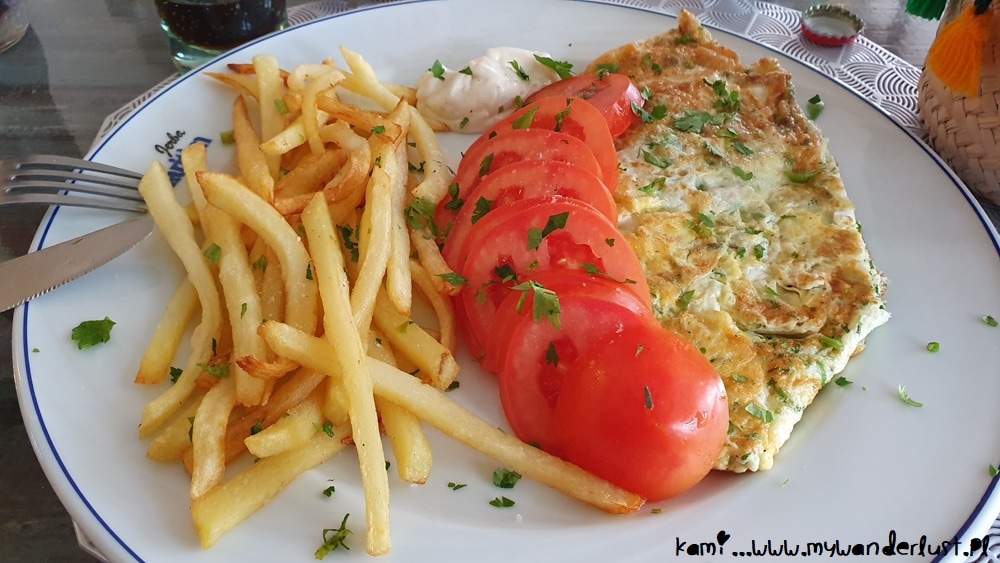
What to drink in Tunisia
The absolute best thing you can drink in Tunisia is freshly squeezed juice, most often orange, but sometimes you can also find pomegranate. You can get it in most cafes and restaurants as well as from random vendors around, and usually, it’s very cheap, like 2-3 TND for a cup. I had it every single day (sometimes a few times), and it never got boring!
Another local drink I enjoyed was the mint tea. I’m a huge black-tea-no-sugar drinker, but somehow, I enjoyed this overly sweet drink. I was familiar with this kind of tea already from Morocco, but I still ordered it numerous times during my trip and enjoyed every single cup.
Alcohol in Tunisia is legal, but you are not allowed to drink it in public spaces, such as beaches, parks, etc. You can buy it in bigger stores; alcohol is also served in some restaurants and resort hotels in popular tourist destinations.

Where to stay in Tunisia
Since Tunisia is a popular seaside destination, you can find numerous hotels, including big resorts, along the Mediterranean coast. When it comes to staying in less popular places, the choice is smaller but still there.
You can find a place to stay and book your accommodation on Booking , that’s what I did too.

Power plugs in Tunisia
Tunisia uses type C and E power plugs; the European plugs work fine there.
Useful apps
The two most useful apps for me in Tunisia were Bolt for ordering taxis in Tunis and Sousse and Google Translate, which I downloaded in French and Arabic before the trip. I also used a lot of maps.me and Google Maps when getting around.

I can’t recommend visiting Tunisia enough. It was like a better version of Morocco or Egypt, with great ancient sites and bustling medinas but without many scams, overwhelming tourism, and annoying situations. It’s a matter of time before the country becomes a tourist hotspot again, so hurry up and visit Tunisia soon and enjoy all the greatness it has to offer.

Travel Resources
Below you can find the brands I trust and use when planning trips:
- You can find the best accommodation options at Booking . They have many discounts and excellent customer service. Click here to look for the place to stay in Tunisia
- I recommend joining organized tours to get to know the place better and to visit more places during your trip. You can find a great selection of tours at Viator or Get Your Guide .
- To always stay connected I use Airalo eSim cards – click here to get yours!
- Never travel without travel insurance , you never know what might happen and better safe than sorry. You can check the insurance policy for Tunisia here.
- Make sure to have the offline map always installed on your phone, they can save you so many troubles. I always use the free app Maps.Me .
For the end I left a few announcements that might interest you:
- Sign up to my newsletter or follow me on Bloglovin to get updates about the new posts
- Join my Facebook group about Eastern Europe, the Balkans and former USSR and connect with fellow travellers and enthusiasts of these regions – just click here!
- I’ve included a few handy links of services and products I personally like and use so you can plan your own trip to Tunisia too. They are often affiliate links. This means I will get a small commission if you book/purchase anything through my links, at no extra costs for you. Thank you!
LIKED IT? PIN THIS POST FOR LATER!

If you enjoyed that post why don't you share it with your friends? That would mean so much to me! Also be sure to join 30.000+ fellow travelers and follow me on Facebook , Twitter , or Instagram for travel updates and even more pictures! If you don't want to miss new posts sign up to my newsletter or follow on Bloglovin !

12 Comments
ALI KHAMMASSI
Hi Kami, I’m a licensed tunisian guide, i just want to thank you for the great job that you did and that you are doing. You’ve been a very good ambassador for my country .
Thank you. I really enjoyed my trip to Tunisia and I’ll gladly recommend the country to other travelers.
Hi Kami yours are the most helpful infos i found on tunisia. Just 1 question. Aren’t there any mini buses? I know them from kenya and türkiye. One can get on and off anywhere. No bus stop needed. Have you seen those too?
There are no minibuses like for example in Eastern Europe but there is a shared public transport with louages. I wrote about them in this article.
Thank you so much for writing this blog! We just visited Tunisia, and there isn’t a lot of quality information out that. Super appreciation all of the information, we used your blog non stop as a guide to help!
Thank you for your kind comment, I’m really happy you found my blog useful for your trip. All the best!
Charles Stewart
Hi Kami –
I’ll be in Tunisia in March and just read your travel guide. You’ve provided some very helpful tips and answered any question I might have at the planning stage. Excellent intro to an unfamiliar country…thank you!!
I’m very glad you found it useful. Have a wonderful trip to Tunisia! I’m sure you will enjoy this fascinating country!
BENJAMIN ABOSI
Thank you for sharing your tourism experience in Tunisia, the information is very interesting and I will like to get more of your traveling experiences. I wish to be your friend because I love traveling a lot.
I’m glad you found this article useful. All the best!
Jennifer diPretoro
Thank you for such a great article about Tunisia–I’m planning a trip in early April and this is enormously helpful !
I’m glad to hear that! Have a wonderful trip!
Leave a Reply Cancel Reply
Sign me up for the newsletter!
Let’s become friends!
Join me on Facebook for even more travel updates!
Kami and the rest of the world
Travel to Tunisia in 2024: Tips + Itinerary
By Joan Torres 20 Comments Last updated on April 12, 2024

From the most epic Roman ruins in Africa to crystal Mediterranean beaches, the Sahara and a great Berber culture, Tunisia is a small piece of land with a lot to offer and is a great alternative to Morocco as, basically, you get a similar Maghrebi culture with the difference that many parts of Tunisia remain unvisited and the country is mostly free of the classic scams.
The golden era in which Tunisia used to be a prime tourist destination came to an end with the 2015 terrorist attacks – unfortunately – but, even during those times, the vast majority of visitors were resort-like tourists, the most adventurous ones visiting the most typical tourist attractions on an organized tour.
Even my parents visited Tunisia for a few days many years ago, but went there with everything organized.
This means that Tunisia hasn’t really witnessed the arrival of independent travelers and I believe this is one of the things that make any trip to Tunisia a great travel experience, as you will be continuously meeting curious, kind-hearted locals everywhere you go.
No more than a few hours from any European city by air, this is perhaps, the closest and easiest exotic, offbeat destination to visit during your 1 or 2-week holiday.
This guide contains everything you need to know to travel to Tunisia , including travel tips and a compelling 2-week itinerary.
I also recommend you read: How to visit Tunis in 3 days
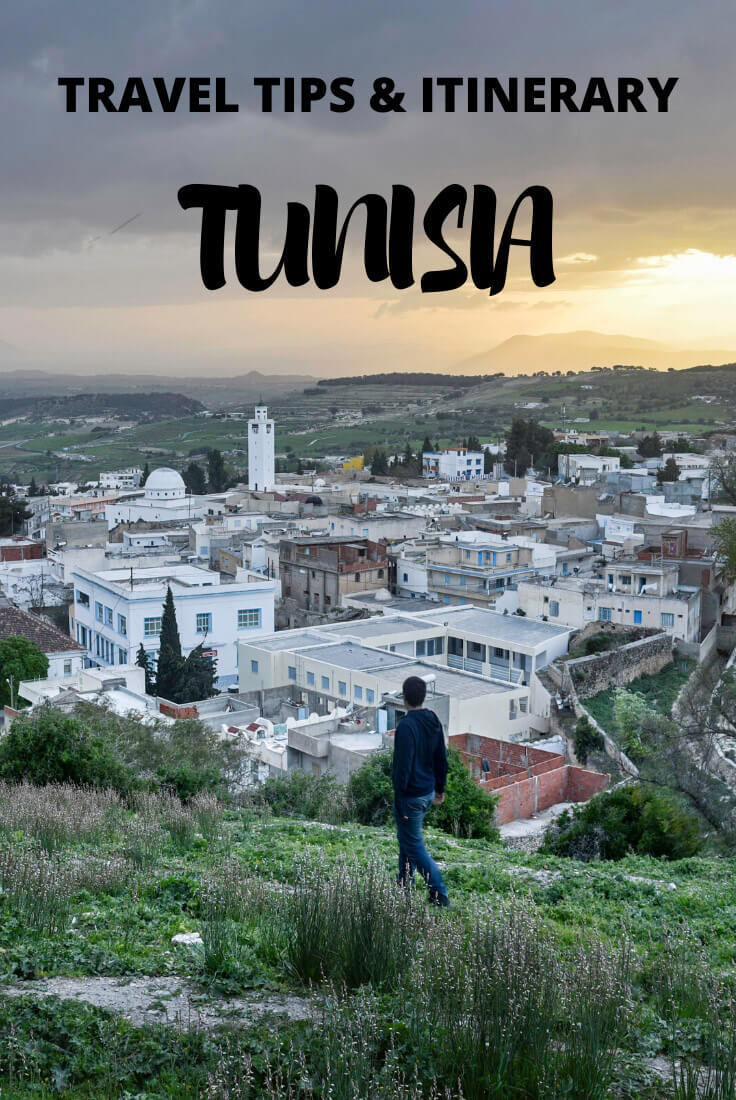
In this Tunisia travel guide you will find:
Table of Contents
- Getting there
- Travel insurance
- Best time to visit
- Tour or not?
- The people, the country
- Moving around
- Is it safe?
- Day 1, 2 – Tunis
- Day 3 – Sousse
- Day 4 – Monastir
- Day 5 – Kairouan
- Day 6 – El Jem
- Day 7 – Sfax
- Day 8, 9 – Tataouine & around
- Day 10, 11 – Tozeur & around
- Day 12 – El Kef
- Day 13 – Jugurtha Tableland
- Day 14 – Dougga
- More information
eSIM for browsing, calling and planning your itinerary in Tunisia
With Holafly , you can now get an electronic SIM card for Tunisia from home with just 2 clicks.
5% discount with the following code:
AGAINSTTHECOMPASS
🪪 How to get a tourist visa for Tunisia
Pretty much any nationality can get a 3-month visa-free on arrival.
🛫 How to get to Tunisia
How to travel to tunisia by air.
Tunis International Airport has connections with several European cities and other major cities in Africa. I recommend you check on Tunisair and Skyscanner. I personally flew from Barcelona with Tunisair.
How to travel to Tunisia by land
Tunisia has a border with Algeria and Libya .
- Algeria – You can travel to Tunisia from Algeria and use the entry point near Tabarka – not sure if foreigners can use the other borders.
- Libya – You can’t really cross from Libya, not because the border is closed but because, currently, Libya is not issuing tourist visas and the only way to get in is via an agency who will fake a business visa for you, and they don’t recommend you enter or exit via Tunisia, as it would not be credible that you came to Libya for business purposes.
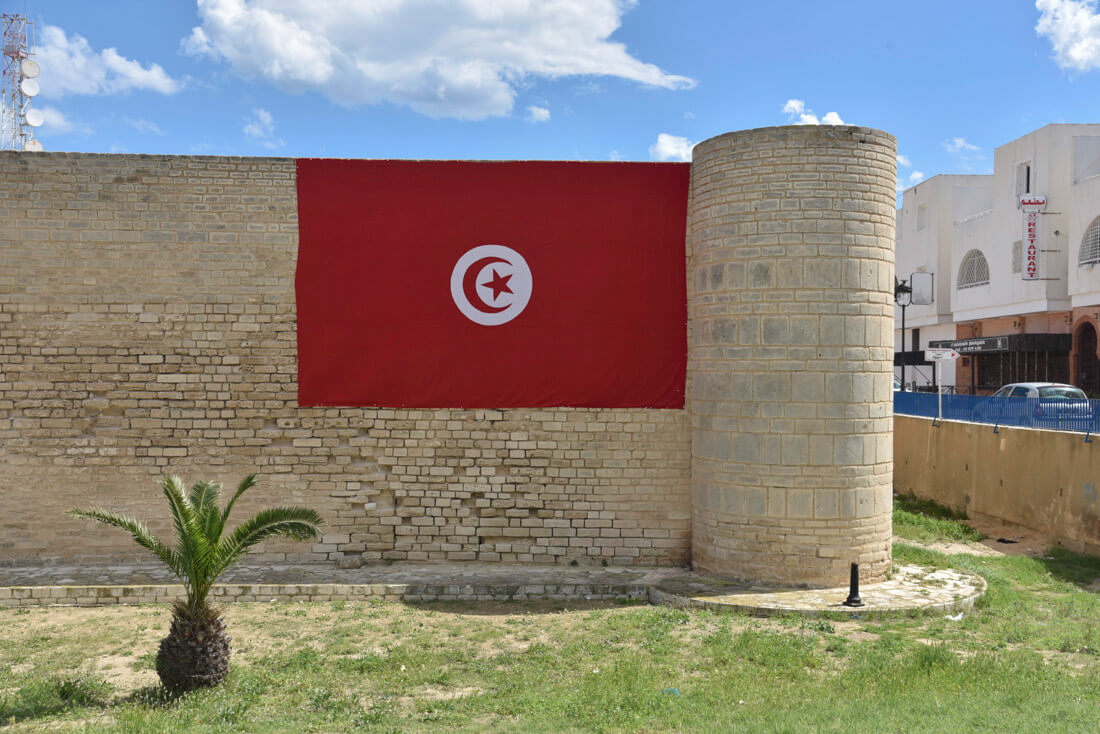
🚑 Travel Insurance for Tunisia
For Tunisia, get IATI Insurance :
- All types of plans: from families to budget backpackers
- Covers both short-term trips and up to 1-year long trips.
- Covers senior citizens too
- Readers of this blog can get a 5% exclusive discount
⛅ Best time to visit Tunisia
The best thing about Tunisia is that this is really a year-round destination.
The northern part of the country is purely Mediterranean, with mild winters and hot summers so, if you fancy the beach, July and August should prove best, and towns and cities are great to visit any time of the year. The arid south, however, is best visited in winter, otherwise, the heat might not let you enjoy it that much.
I visited Tunisia for 3 weeks from mid-April to the beginning of May and it was the perfect time. The weather in the northern part was absolutely pleasant, with a little rain sometimes, and the heat in the southern part was still quite bearable.
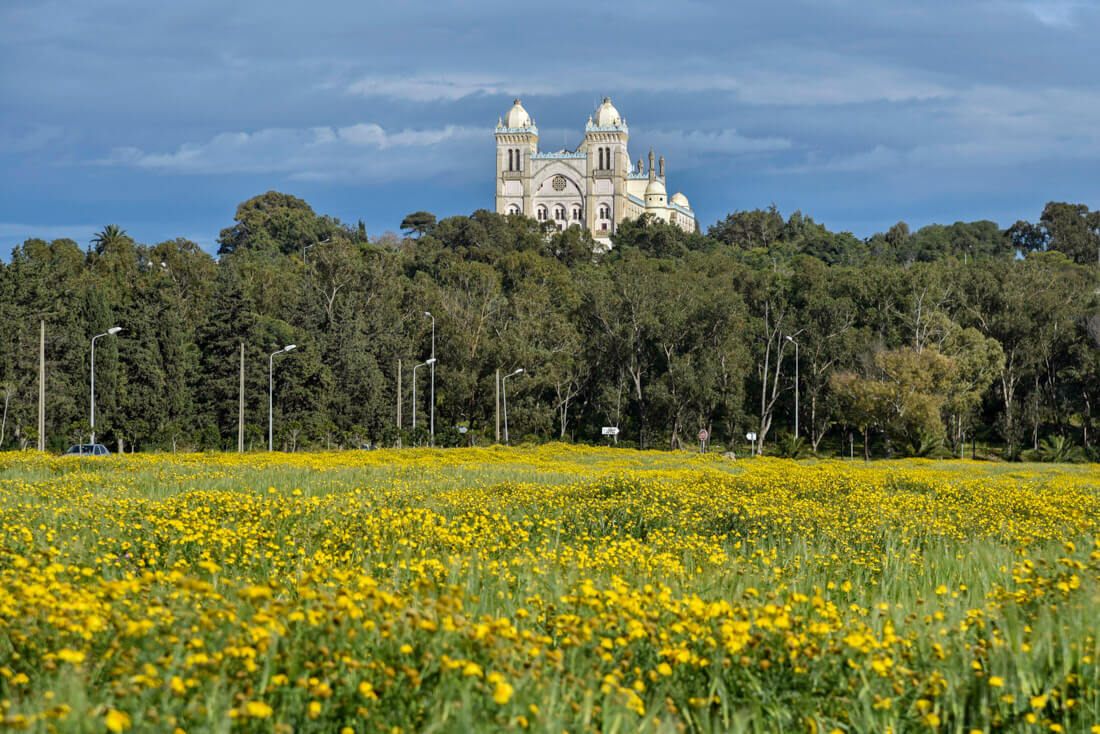
Should you travel in Tunisia independently or on an organized tour?
I visited Tunisia 100% independently, and I recommend you do the same.
However, if you are short of time and want to visit specific places on organized tours, I recommend you use GetYourGuide , a website where you can book any type of tour, from half-day trips to several-day tours with just one click.
🕌 The people and the culture
They are too African to be considered European, but they are too European to be considered African.
These are the words from an expat American woman living in the city of Tunis who I had the chance to meet during my trip to Tunisia.
Along with Beirut , Tunis might be the most secular and open-minded Arab city and you just need to go to the city center and see how people dress.
You find traditional, religious people too, of course, but the beauty of Tunis, and Tunisia in general, is that everybody is free to practice Islam the way they please and, on most occasions, you won’t be judged.

This is why in Tunis you are likely to see a young girl with a short skirt walking in a local market among other women wearing the full hijab, a mix you will rarely see in other Arab countries.
Sousse, Monastir and Sfax are other modern cities with a significant number of liberal people, especially among the young generation.
However, religion still plays an important role in Tunisia’s society. Even Tunis has its traditional districts and the rural areas are very conservative.
But what is true is that in Tunisia there isn’t much fundamentalism compared to other Arab nations and countries in the Middle East.
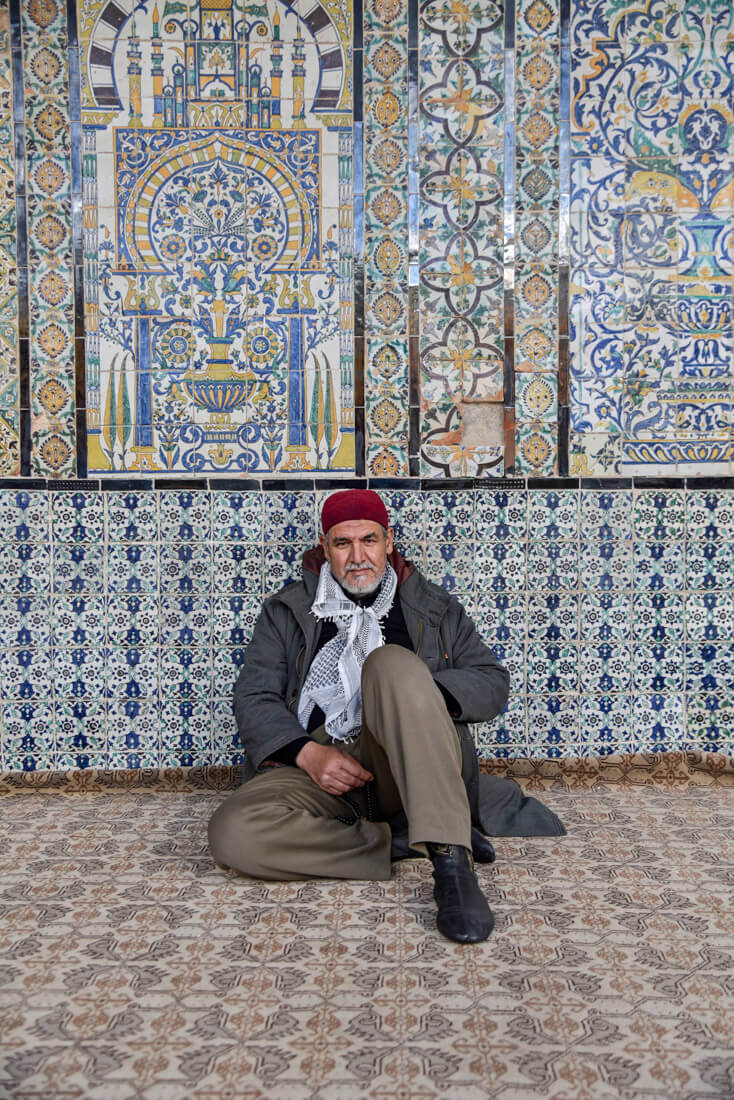
Arabic is the official language in the country, and I believe it is quite similar to the Arabic spoken in Morocco and Algeria.
However, it is very different from other Middle Eastern countries, from Egypt to Oman .
In fact, they don’t even understand each other. When I was living in Dubai, in my office there were Arabs from all the Arab countries and Tunisians would always address Middle Easterners in English.
French & English – Given this used to be a French colony, except for uneducated people from rural areas, pretty much everybody in the country speaks impeccable French, and the best educated Tunisians also have good English, so traveling in Tunisia doesn’t imply any language barrier.

🍲 Food: What can you eat when you visit Tunisia?
Just before my trip to Tunisia, I had spent around 5 weeks in Morocco, so I wasn’t really expecting to taste many different flavors, but I was very wrong.
First of all, Tunisian food is extremely spicy. Like a lot spicy, sometimes Indian-level spicy.
I don’t know why, but Tunisia must be the only Mediterranean country that uses chilis in their cuisine. They love it and also a chilli sauce named harissa , which they put everywhere.
One Tunisian lady told me that every time she travels to Europe, even if it is just for a few days, she always brings some harissa .
Moreover, due to its proximity to Italy, Italian food is a thing here, and the truth is that spaghetti with tomato sauce is a staple, something you can order in any local eatery for less than $1 sometimes, but it isn’t very good pasta to be honest.
Overall, Tunisian food is good, however, whereas in the city of Tunis (and Sousse as well) I had quite a few feasts, in the rest of the country most places would only serve very basic stuff, especially in the south, Tozeur and El Kef.

Must-try dishes in during your trip in Tunisia
- Brik – The most popular snack in Tunisia consists of a filled fried pastry, usually with egg or tuna. By the way, Tunisians love tuna.
- Ojja – Sort of a tomato stew that comes in different versions, from local sausage ( mergez ) to seafood. Ojja is available in pretty much any local eatery.
- Cous-cous – Maghrebi star-dish, and the Tunisian version is very spicy.
- Seafood – In the coastal towns of Tunisia you can find some really great seafood, the most remarkable I ate being some stewed octopus in a tomato gravy, absolutely tender and delicious. I ate it in Sousse, in a restaurant called Cafe Bellar.
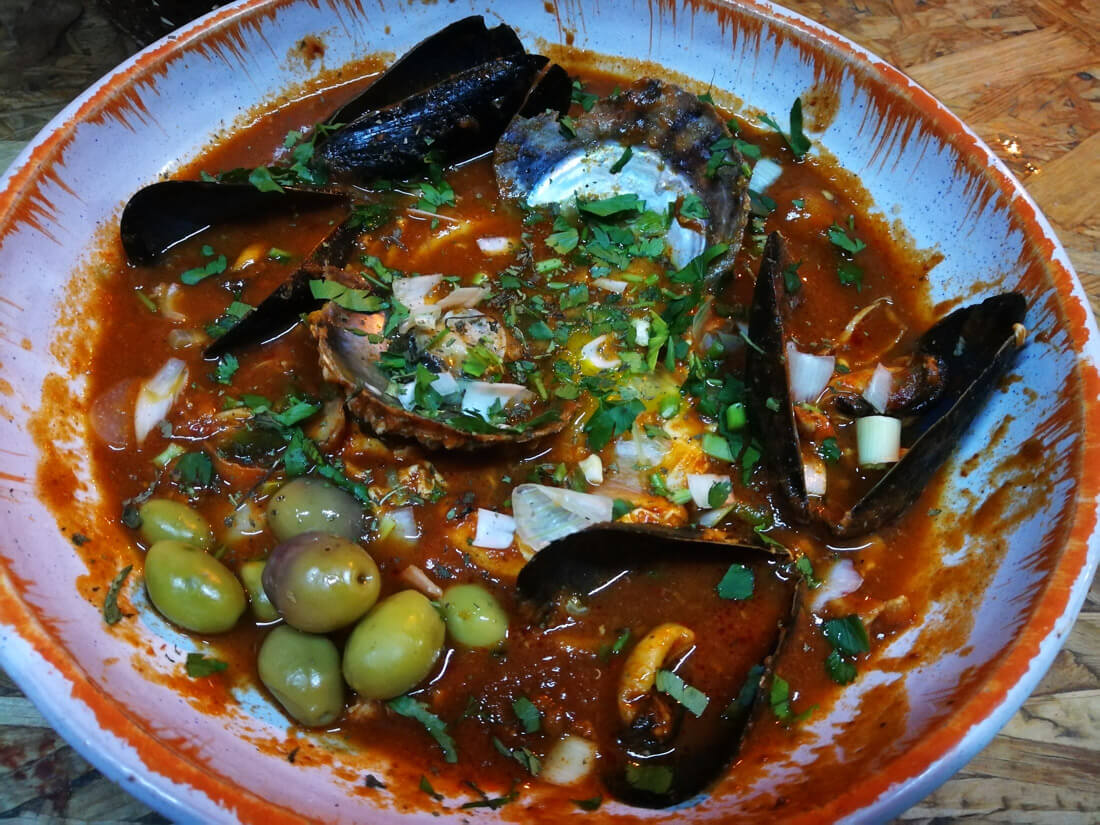
🛺 How to move around: transportation
Remember to get travel insurance for Tunisia I strongly recommend IATI Insurance as it has COVID-19 coverage + 5% discount 5% discount if purchasing via this link
Typically, there are 2 ways to travel around Tunisia:
Traveling around Tunisia by train
The Tunisian train is great. It is reliable, relatively fast and just soooo good. There is a train line that goes along the coast all the way to Gabés and, as far as I am concerned, the whole line is fully operational.
During my visit, however, the line that connects Tunis with Gabés through Tozeur, in the west of the country, had been closed for several years, but it seems they have already resumed all trains. In any case, you can check timings on the official railway website .
Traveling around Tunisia by louage
Louages are the local mini-vans which basically, you will ride for traveling to places you can’t reach by train. I used them to travel to Kairouan, El Kef and Tozeur and some places in the south. They are very cheap.
💰 Money, budget and costs
In Tunisia, they use the Tunisian Dinar (TND) and approximately:
1 USD = 3.15 TND
Most cities will have ATMs and changing either € or USD should be very easy.
How much does it cost to travel to Tunisia?
Tunisia is cheap, much more than Morocco, mainly because of the currency’s devaluation after the massive drop in tourism. Cost of the most typical things:
- Street sandwich (falafel) – 1-2 dinar
- Local meal (1 ojja) – 5 dinars
- Meal in a good restaurant – 20 dinars
- Entrance fees to places like Dougga ruins, ribats, fortresses, museums – 8 to 12 dinars
- Budget hotel – 20-30 dinars
- Mid-range hotel – From 40-50 dinars
- Transportation – I paid around 4-7 dinars for most train journeys, same for louage.
On a tight budget, I seriously think you can go backpacking in Tunisia for $ a day 20.
Please note that the below table is just an approximation.

⚠️ Is it safe to travel to Tunisia?
Tunisia has had some safety concerns in the past, especially throughout 2015, and that was the main reason why tourism dropped dramatically.
However, the situation has improved drastically and for a better understanding, I recommend you read my analysis:
Is Tunisia a safe country to visit?
Tunisia Itinerary – Places to visit in 2 weeks
How long should you go backpacking in Tunisia for?
I personally spent almost 3 weeks, went a bit slower than the suggested itinerary and visited one or two additional places not included here such as Djerba Island.
Tunisia 2-week travel itinerary map
Day 1, 2 – Visit the capital of Tunis
A third Mediterranean, a third European and a third North African, Tunis is a city with many cultural contrasts and most likely, the starting point of your Tunisia travel itinerary.
On the one hand, the old city is composed of an African, Maghrebi medina, not very different from the ones you would find in Morocco, but without the feeling of being in a tourist trap.
And, on the other hand, you also have the European part of town, which is filled with French-style facades, boulangeries and a relatively Westernized atmosphere.
In addition, think about all the nightlife, nice restaurants, the Roman ruins of Carthage and the Mediterranean-like district of Sidi Bou Said, and I seriously believe that traveling to Tunisia just for visiting Tunis is truly worthwhile.
Things to do in Tunis
I spent whole 5 days in Tunis, and managed to squeeze the things I visited in a 3-day travel guide
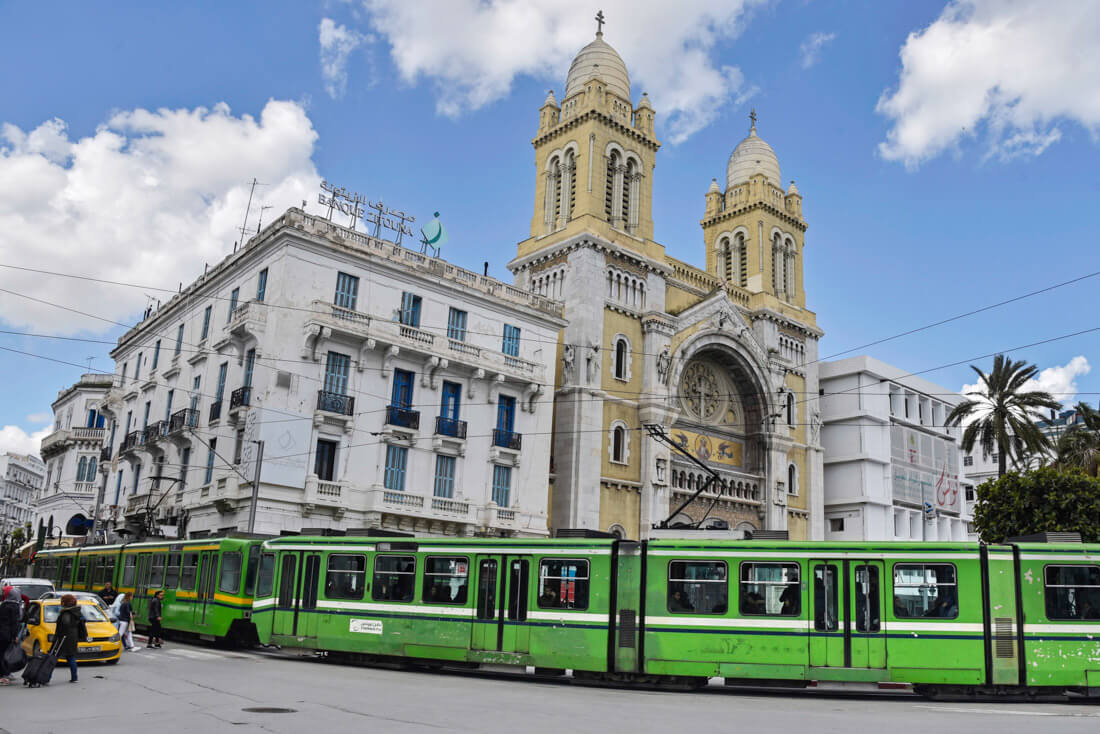
Where to stay in Tunis
Backpacker Hostel – Medina Youth Hostel – Located in the heart of the medina, this is the most backpacking-friendly hostel in Tunis.
Mid-range hotel – Dar La Leila – Super nice, traditionally decorated lovely hotel, the top-rated hotel in Tunis, and super charming staff.
Top-end hotel – Dar El Jeld Hotel and Spa – A 5-star but traditional hotel that offers all the luxuries.
Best tours in Tunis
I recommend you look for tours via GetYourGuide .
Carthage and Sidi Bou Said – Roman ruins of Carthage and the Santorini-like city of Sidi Bou Said.
Bardo Museum & Medina – The classic medina + the museum containing one of the largest collections in the world of Roman mosaics.
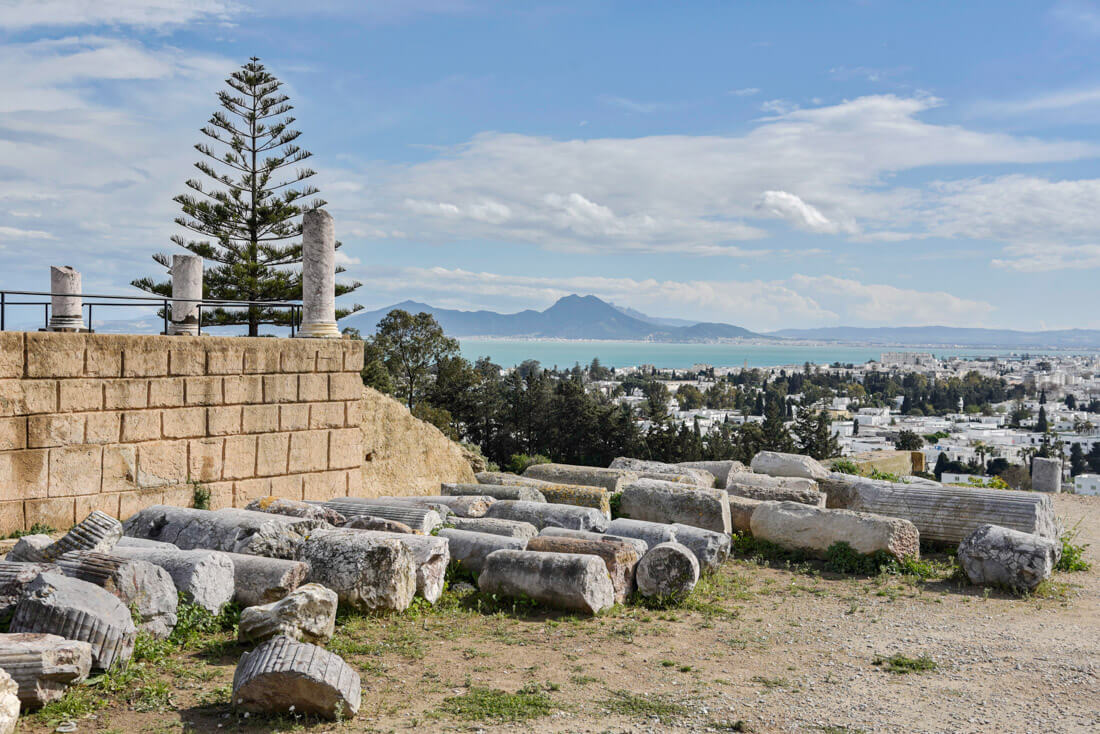
Day 3 – The resort-like town of Sousse
This is the prime tourist destination in the country, for foreigneirs and Tunisians alike, but for independent travelers, it feels a bit odd.
It feels weird because the coastal front line of the new part of town is composed of ugly, mass tourism-like buildings, restaurants with over-priced menus and just the kind of trashy tourism I would try to run away from.
However, Sousse is the city that witnessed all those unfortunate terrorist events from 2015 , so during my visit in the month of May, it felt like a real ghost town and, in any case, the old part of Sousse is a great place to get lost in, among its narrow alleys.
Moreover, Sousse is a good base to explore a few places around such as Kairouan, Monastir or El Jem. I mean, you can find accommodation in those cities but Sousse has the largest offer of hotels, restaurants, and cafés so, for me, it made sense to hang out there for a while.
Looking for visiting Sousse on a tour? CLICK HERE TO CHECK ALL AVAILABLE TOURS IN SOUSSE
Things to do in Sousse
- Medina – Like all medinas in Africa, the medina of Sousse is a maze of streets where the highlight is getting lost and escaping from the main souvenir area.
- Great Mosque – From the 8th century. They make you pay an entrance fee, a bit unusual for being a regular mosque, but Tunisia is mostly like that.
- Ribat – Old Islamic fortress from the 8th century. It contains one of the oldest praying halls in Africa.
- Sousse Archaeological Museum – I am the least museum-friendly person but I loved the museum of Sousse because it contains some of the largest collections of Roman mosaics, including a massive one of Medusa . Check the official website for timings.
Ribat – A ribat is a small Arabic fortress typically found along the northern African coast, and built during the first years of the Muslim conquest. Most coastal towns in Tunisia have their own ribat and they tend to be pretty well-preserved. The word ”ribat” means ”defense of Islam”.

Where to stay in Sousse
Budget/backpacker – Hotel Paris – Basic hotel with relatively good Wi-Fi inside the medina. I stayed here.
Mid-range – Dar Antonia – Traditional, fancy dar in the medina.
How to get to Sousse from Tunis
There are several trains a day running to Sousse from Tunis central station.
A ticket would typically cost 10,000 dinars and it takes a bit more than 2 hours.
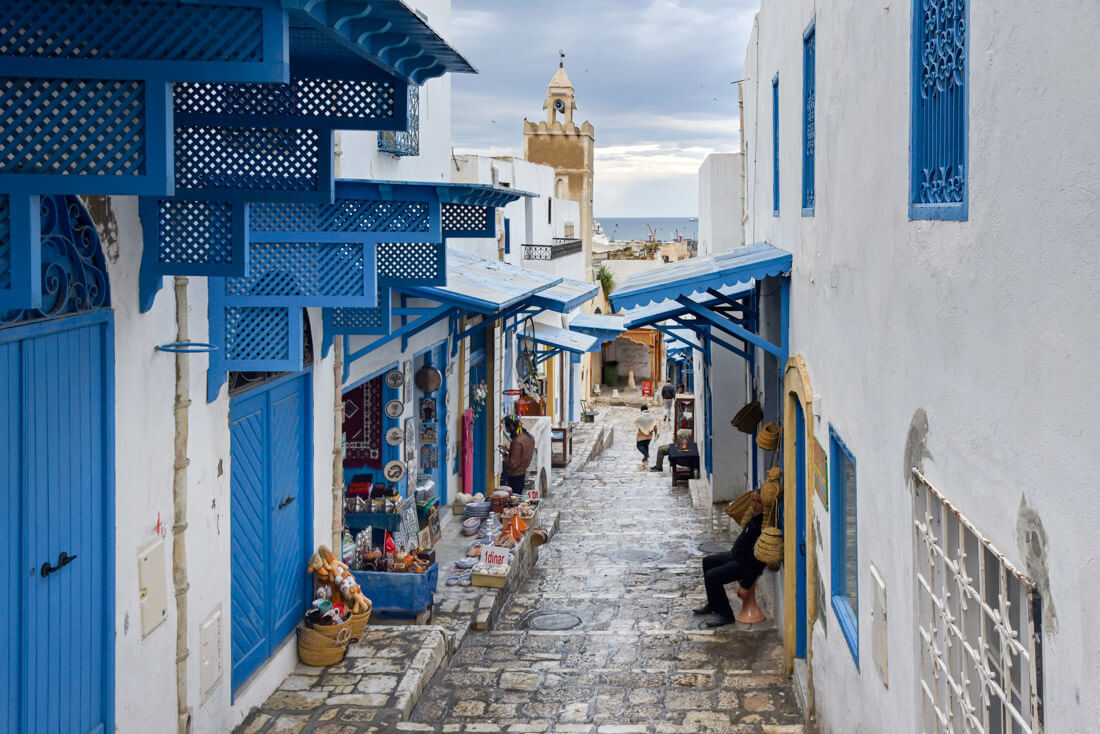
Day 4 – Day trip to Monastir
If you have the time, Monastir is a pleasant town that was founded as a Phoenician trading settlement more than 2,000 years ago.
Monastir is a peaceful, free-of-crowds town, as the touristic area is quite far away from the center, so it has managed to keep a certain charm, plus in my opinion, Monastir has the most well-preserved ribat in the country, a set of labyrinthic passages and stairways that seem taken from a movie.
Moreover, Monastir is the birthplace of Habib Bourguiba , the man who lead the country to independence from France and ruled the country from 1956 to 1987.
Other than that, Monastir is an all-right place to hang around for a while.
My visit here was a peculiar one. After visiting the ribat , I met with one local lady who had contacted me through Instagram and she took me to the local radio station’s offices – she was working there – and I kind of kept staring at what they were doing for a while.
Then, we went to Habib Bourguiba’s mausoleum.
You can also visit Monastir on an organized tour (along with Sousse) from Tunis. CLICK HERE TO LEARN MORE
How to get Monastir from Sousse
Monastir is a 20km train ride from Sousse and trains run continuously throughout the day for $1 or less.
The Great Roman Civil War Do you know about the famous Roman Civil War between Julius Caesar and Pompey ? It was the war that led Rome from a Republic to an Empire, and the last stage that guided Julius Caesar to victory occurred on the battlefield between Sousse and Monastir. The coolest thing about it is that today’s Monastir was Caesar’s base, and Sousse was Pompey’s. They even made a TV series on Netflix.
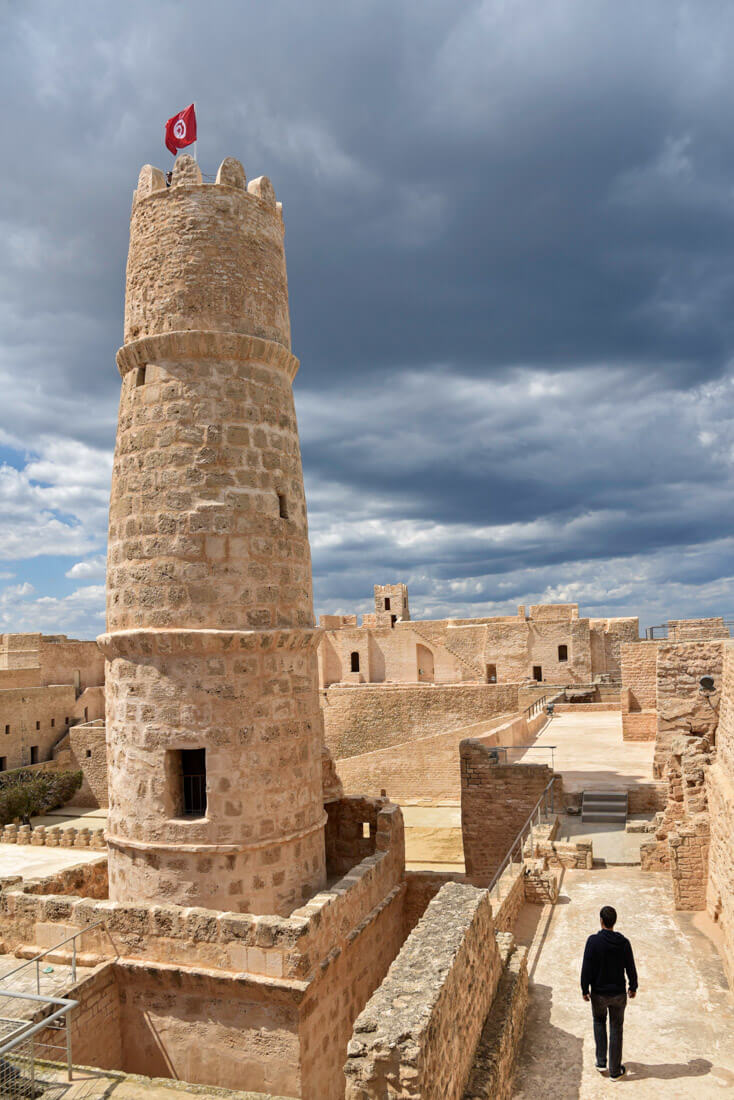
Day 5 – Day trip to Kairouan, the holiest city in Tunisia
Some sources claim Kairouan is the holiest Islamic city in Africa, and the fourth in the world after Mecca, Medina and the Dome of the Rock in Jerusalem.
I am not sure about that, however, because I have been to other places in the Middle East and Africa with the same claim but it is a fact that this is the holiest place to visit in Tunisia and the atmosphere is so different from anywhere along the coast, so low-key, so traditional and overwhelmingly welcoming.
Interested in visiting Kairouan on a guided tour? CLICK HERE TO SEE ALL AVAILABLE TOURS IN KAIROUAN
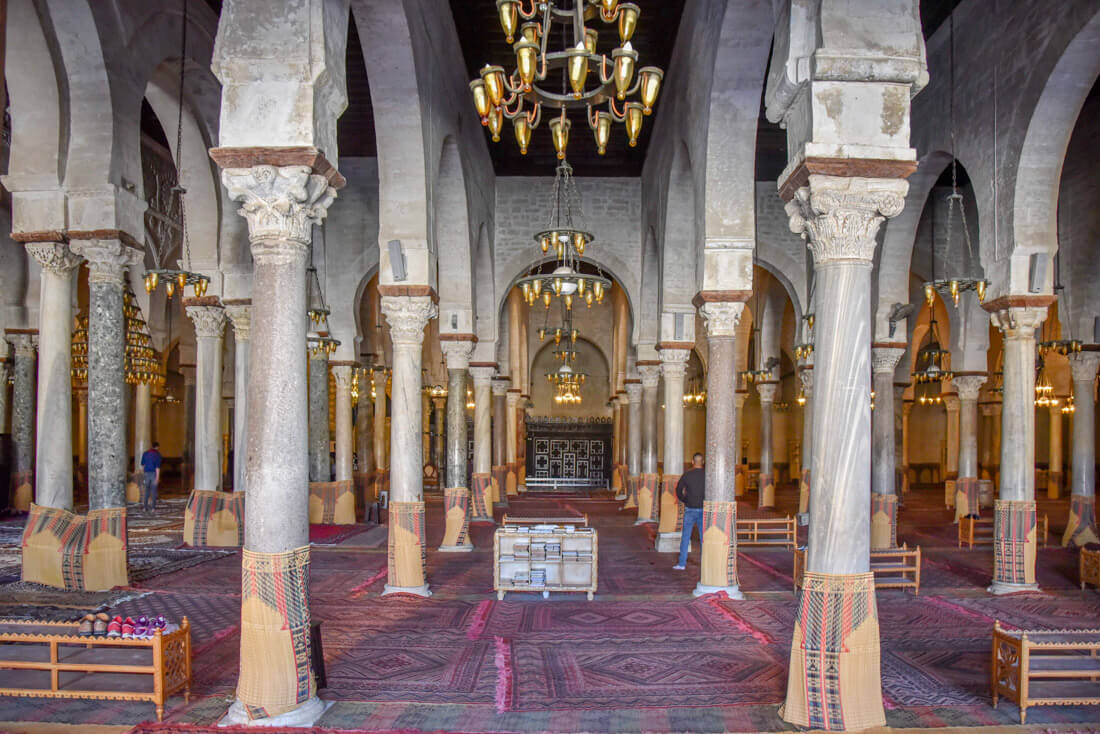
Things to do in Kairouan
At the Great Mosque, you can purchase one ticket that allows you to visit several sites and these are the ones I visited:
- Great Mosque – From the 7th century, one of the holiest Islamic places in Africa.
- Bir Barouta – An Ottoman-era building that was built around a well which apparently, connects to another well in Mecca. Sadly, they enslaved a poor camel that spends his day turning the well’s wheel.
- Zaouia of Sidi Sahab – Very beautiful Muslim complex with Andalusian-style tiles.
How to get to Kairouan from Sousse
There isn’t a train line passing through Kairouan, so you need to take a louage , which takes a bit more than 1 hour.
Sousse bus station is outside of town, here: 35.809717, 10.636374.
Mullah stories In Kairouan (in Zaouia of Sidi Sahab) I was approached by a kind Tunisian who gave me a 30-minute Islamic lesson in an attempt to persuade me to consider converting to Islam, and it was only 30 minutes because very kindly, I told him I had to leave. A very intense man, but I have bumped into many of those in my travels, and they always tell you the story of a British or an American who found God, hence inner-peace and happiness, after listening to his words.

Day 6 – Day trip to El Jem, an impressive Roman amphitheater
El Jem was one of my favorite places in my Tunisia itinerary.
This is home to one of the most epic Roman amphitheaters in the world, in fact, the 3rd largest one, built in the 2nd century, but for obvious reasons, it is much less crowded than the one in Rome.

Around 1km from the amphitheater, there is an archaeological museum also containing plenty of Roman mosaics, many of whom feature the scene when wild animals were released into the arena to eat convicts.
You must get the ticket at the amphitheater’s office, and it also includes the museum entrance.
Since it is on the way to Sfax, I took a train from Sousse early in the morning, visited El Jem for a few hours, and then I could easily get a train to Sfax.
Next to El Jem’s train station, there is a fancy hotel whose staff were kind enough to keep my backpack while I visited the city.
How to get to El Jem from Sousse
It’s a 1-hour train journey from Sousse central train station
Looking for guided visits to El Jem? CLICK HERE TO SEE ALL AVAILABLE TOURS TO EL JEM

Day 7 – Sfax, the coolest medina in Tunisia
Before traveling to Tunisia, I had read in a guidebook that the locals of Sfax were believed to be very thrifty hard-workers.
In my experience, most guidebooks are always filled with unlikely quotes but upon my arrival in Tunis, I spent some time discussing my Tunisian itinerary with a local guy who told me the exact same thing.
And, perhaps, this is the reason why, despite being untouched by tourism, Sfax has some sort of cosmopolitan feel by African standards, and many people there seem to be very open-minded.
Additionally, Sfax is also home to the best medina in the whole Tunisia, very big and authentic which hasn’t been spoiled yet by the arrival of tourists.
Things to do in Sfax
- Getting lost in the medina – As I said, this purely African medina is very traditional and authentic.
- Abandoned Synagogue – Tunisia used to be home to a large Jewish community and, in Sfax, there is an abandoned synagogue.
- Place de la Republique – French-style buildings at the entrance to the medina.
Where to stay in Sfax
There are 2 budget auberges (one next to other) 2km north west outside of the Medina.
For more hotel options in Sfax,
Jews in Tunisia Tunisia today has one of the largest Jewish communities in the Arab world, mainly living in Tunis city and Djerba Island. Of course, most of them migrated to Israel after the Israel-Palestinian war but many of them remain and a few synagogues are still functional, another fact that proves overall the tolerance in Tunisia.
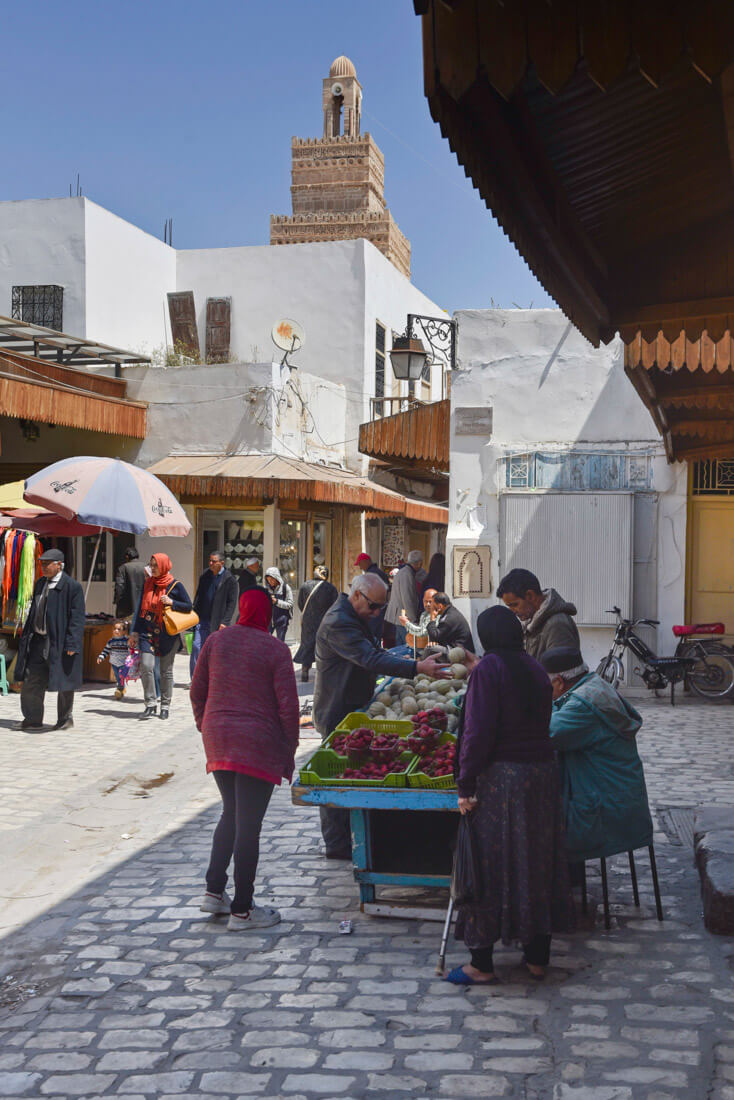
Day 8, 9 – Tataouine & around: southern Berber lands
The lesser-visited southern part of Tunisia is an arid territory that extends all the way to the Libyan border.
Berber villages, camels, ancient ksars (fortified Berber villages), and just remoteness and inhospitality, no wonder why George Lucas decided to shoot Star Wars in these lands.
This is just so different from any place you visited in Tunisia, way more conservative and home to the Berbers, the indigenous people of North Africa before the Arabs came.
How to visit Tataouine The area is vast, touristic sites are scattered, and there is no public transportation. I mean, there are a few buses but it is not a convenient way to move around, not even for backpackers. The best way to explore this area is by either renting a car or going on a tour. I rented a car for a day in a rental car office in Medenine and paid less than $25.
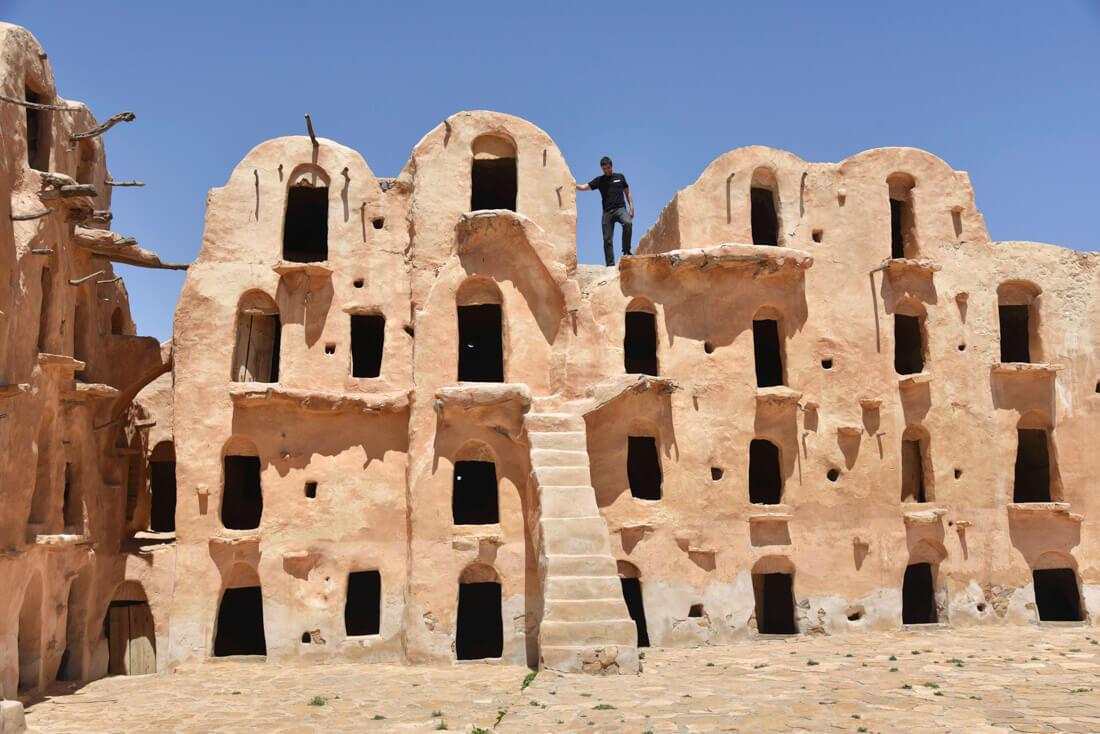
Things to do in Tataouine & around
On a normal path, you will need an entire day to visit these places, and still, you may have to rush a bit. If you want to leave early in the morning, I suggest you rent the car on the day before, as rental car shops didn’t open until 9-10am.
The ”green pins” from the previous interactive map mark the following places:
- Ksar Ouled Soltane – The most well-preserved ghorfas in the area. Ghorfas are ancient 4-story buildings that Berbers used to store the grain.
- Chenini – For me, this was the best place to visit in Tataouine. A massive ancient ksar from the 12th century sitting on a hilltop. Gorgeous.
- Guermassa – Another great ksar, not as epic as Chenini’s but still great. I only saw it from the bottom because it takes almost 1 hour to go up and I didn’t have time. The top, however, can be reached by 4WD.
- Ghomrassen – Off the beaten track modern town with pretty cool local architecture, and the ideal place to stop for lunch.
- Ksar Hadada – This ksar used to be a movie set for Star Wars. I am not a big Star Wars fan, so for me, it was not that interesting, as it was nothing more than some commercial, over-restored ghorfas .
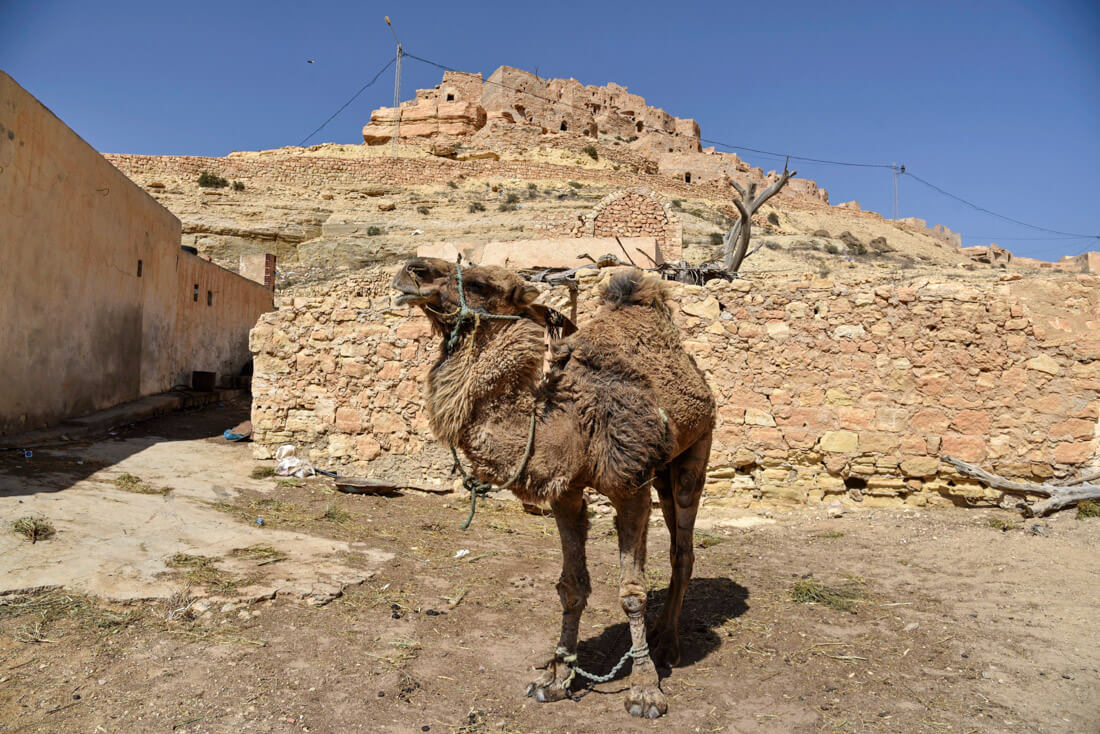
Where to stay in the area
I recommend you stay in Tataouine.
Budget – Auberge Alferdaus – An all right auberge/pension for budget travelers and backpackers.
Apartment – Dar Essadeg – Full traditional apartment.
Mid-range – Sangho Privilege Tataouine – For a comfortable stay, this oasis hotel has great facilities, including a pool, and it is not expensive at all for what you get.
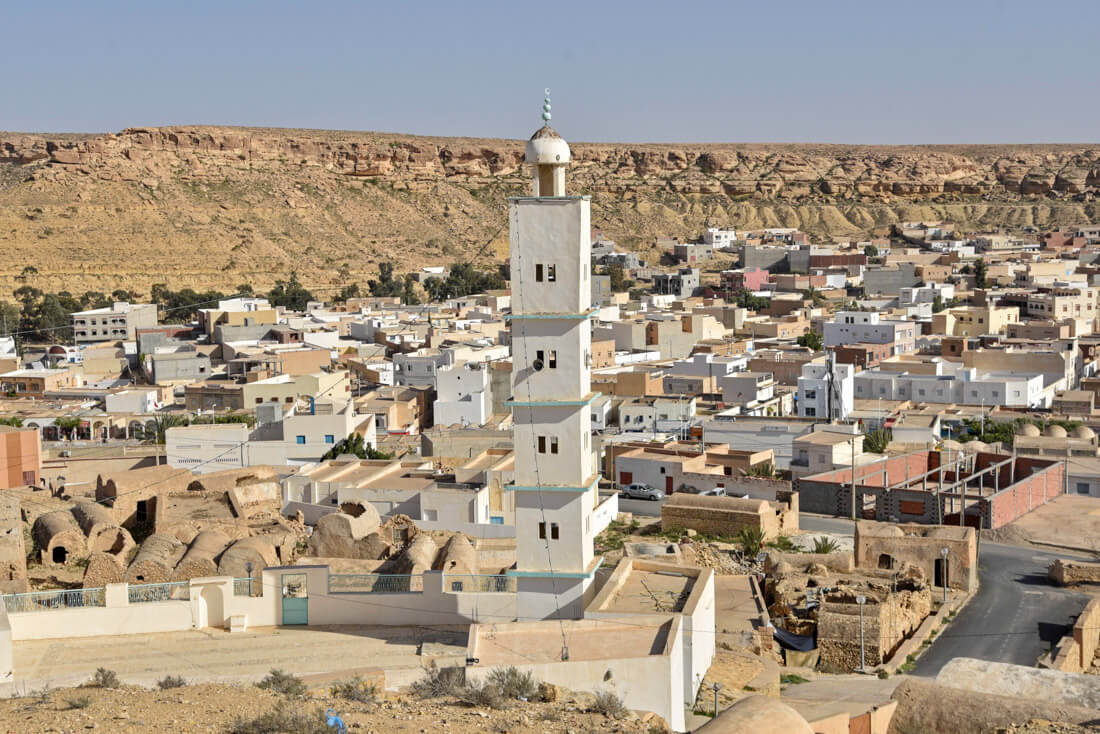
Day 10, 11 – The oasis-town of Tozeur & around
Tozeur is a pleasant oasis town with a very unique old quarter whose buildings are made of bricks (hand-made apparently) and a base from which to explore other mountain oases and check out potential camel caravans.
They claim that those oases have been inhabited for 10,000 years.
If you have been reading my blog for a while, you will know that I like to be honest, and the truth is that this was my least favorite part of my trip to Tunisia.
First of all, because all those landscapes are in my opinion, a small version of the ones you find in north Oman , a country I visited multiple times. And second of all, because this was the only place where the main sites were just packed with tourists, many of them being the irresponsible type. But to be fair, it also didn’t help that the weather was awful (loads of wind and sand).
But anyways, traveling is extremely subjective and you might have a different experience.
Like Tataouine, the area around Tozeur is best explored by car or on an organized excursion. Most hotels can arrange it for you. I personally explored all places with a local friend I had met on Instagram.
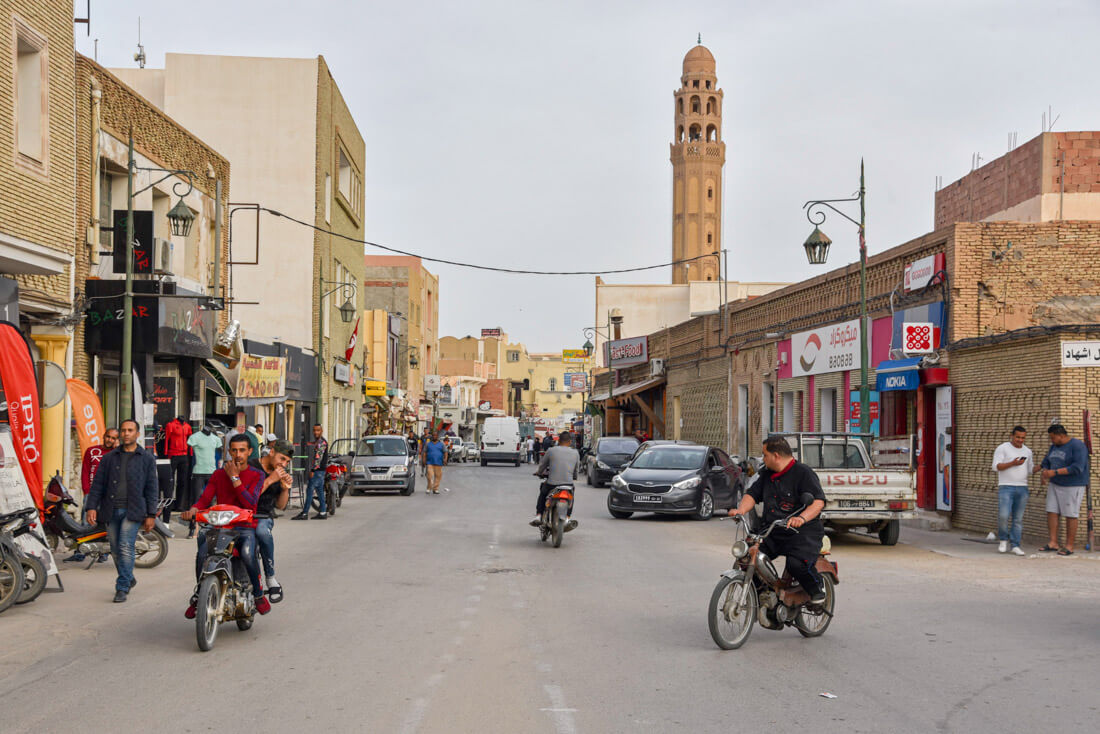
Things to do in Tozeur
Please see the ”orange pins” from the previous interactive map.
- Chebika – A small village home to a massive palmeraie.
- Tamerza – Another small village with a palmeraie, a small canyon, and a waterfall.
- Midès – And another small oasis village but the highlight is the stunning views you get to see from the road that leads to it.
- Ong Jemal – A desert famous for its sunsets and the location of a Star Wars movie set, where the original decoration still remains. Tour agencies will tell you need a 4×4 to reach the place but it is not true.
Where to stay in Tozeur
Budget – Residence Warda – A budget pension good for backpackers.
Mid-range – Residence Loued – A very pleasant traditional hotel at the heart of the Old City.
How to get to Tozeur from Tataouine
The journey is rather more than 300km.
From Tataouine, you need to take a louage to Medenine and from Medenine, another one to Gabés (not sure if you can find a direct one from Tataouine).
If you are lucky and trains are functional, you should be able to take a train from Gabés to Tozeur. Otherwise, take a louage from Gabés to Gafsa and from Gafsa to Tozeur.
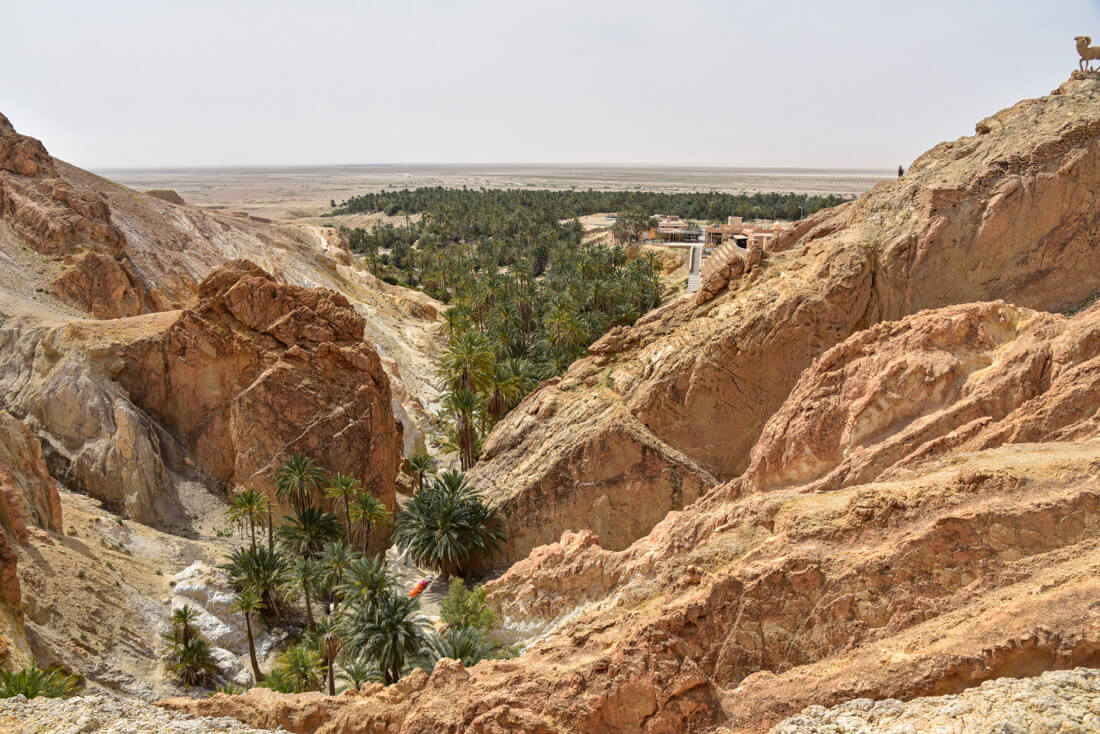
Day 12 – El Kef, traditional off the beaten track town
El Kef and the area around was my favorite part of my Tunisia itinerary.
It is a barely visited town and the top of the medina features a kasbah from where you get stunning views of the city and the green meadows surrounding it.
It has a very authentic, traditional atmosphere as well. I spent 3 nights here – as I used it as a base to explore some places around – and didn’t bump into a single tourist.
Where to stay in Le Kef
There aren’t many options, but I stayed in a hotel close to the Medina named Hotel Sicca Veneria , where I paid $15 a night. It was good!
How to get to Le Kef from Tozeur
It’s a long way, around 330km.
From Tozeur, you need to first get a louage to Gafsa. From Gafsa, a second louage to Kasserine and from Kasserine to Le Kef. It takes the entire day.
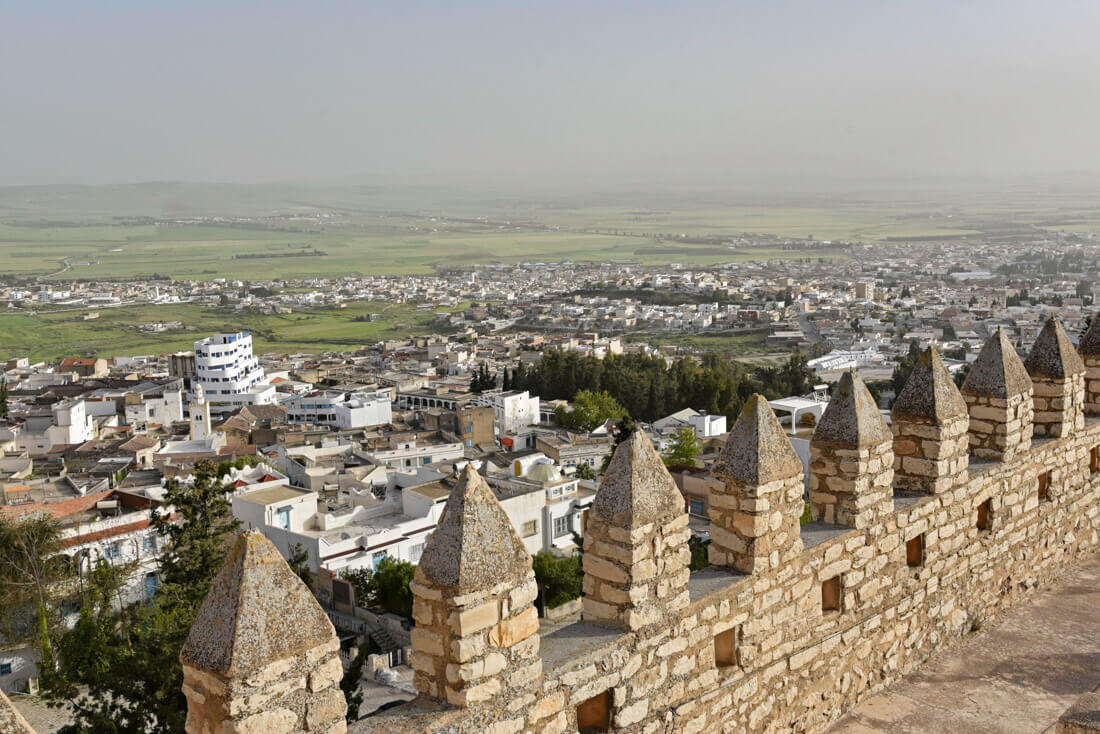
Day 13 – Day trip to Jugurtha Tableland
This off the beaten track gem was the top attraction I visited in Tunisia.
A natural military fortress, Jugurtha Tableland is a massive flat-topped mountain that rises above 1270 meters, and that has been used as a fortress for centuries, from the Romans to today’s Tunisian Army.
That’s why this is kind of a sensitive place, especially because this is a border area from where you see Algeria – stunning views of Algeria, by the way – so having a guard with you all the time is a must (free of charge).
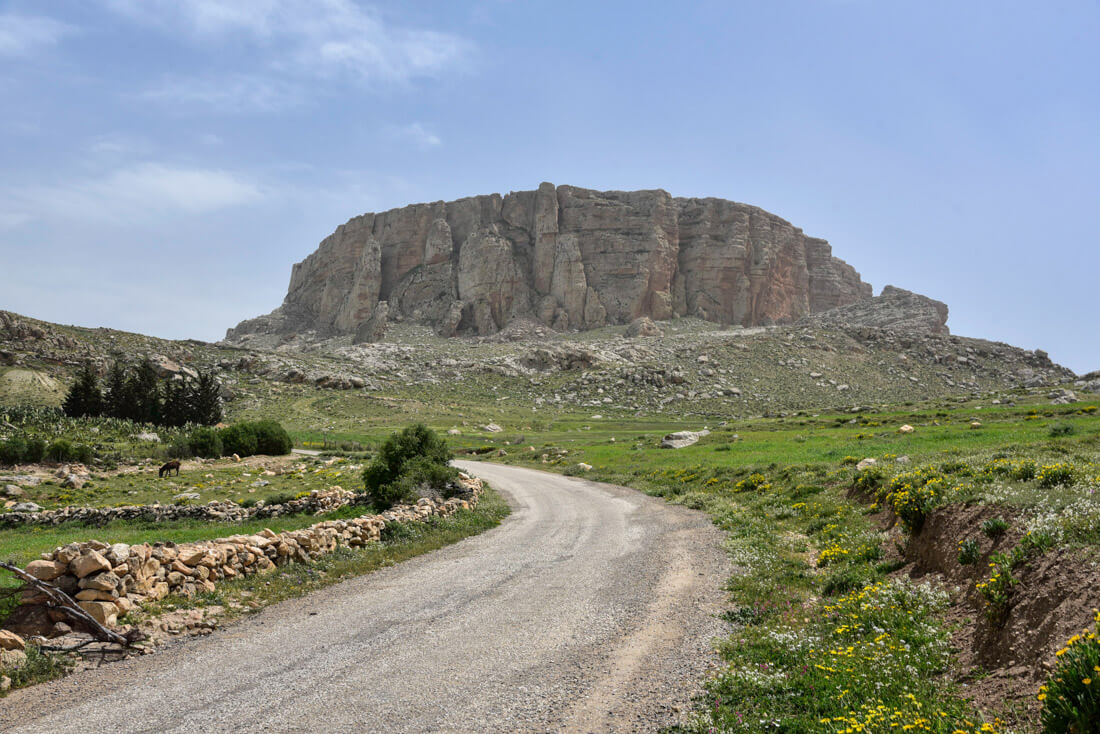
How to get to Jugurtha Tableland from El Kef
From El Kef bus station, you can take a louage to the border town with Algeria named Qalat as Sanan.
Most likely, the driver will already know about your intentions, so he will drop you at the police station, where they will make you answer a few questions and register for visiting Jugurtha.
I was extremely stupid to forget my passport in El Kef but, luckily, my Spanish ID was enough for them.
Then, the police helped me looking for a taxi to take me to the bottom of Jughurta (4km), and I paid the equivalent of around $10.
Once you arrive, an official guide will welcome you and take you to the top.
It also possible to camp at the top, but you will have to get permission at the police office, and a guard will be with you all night – I mean, they have their own huts. However, be aware that it is extremely windy.
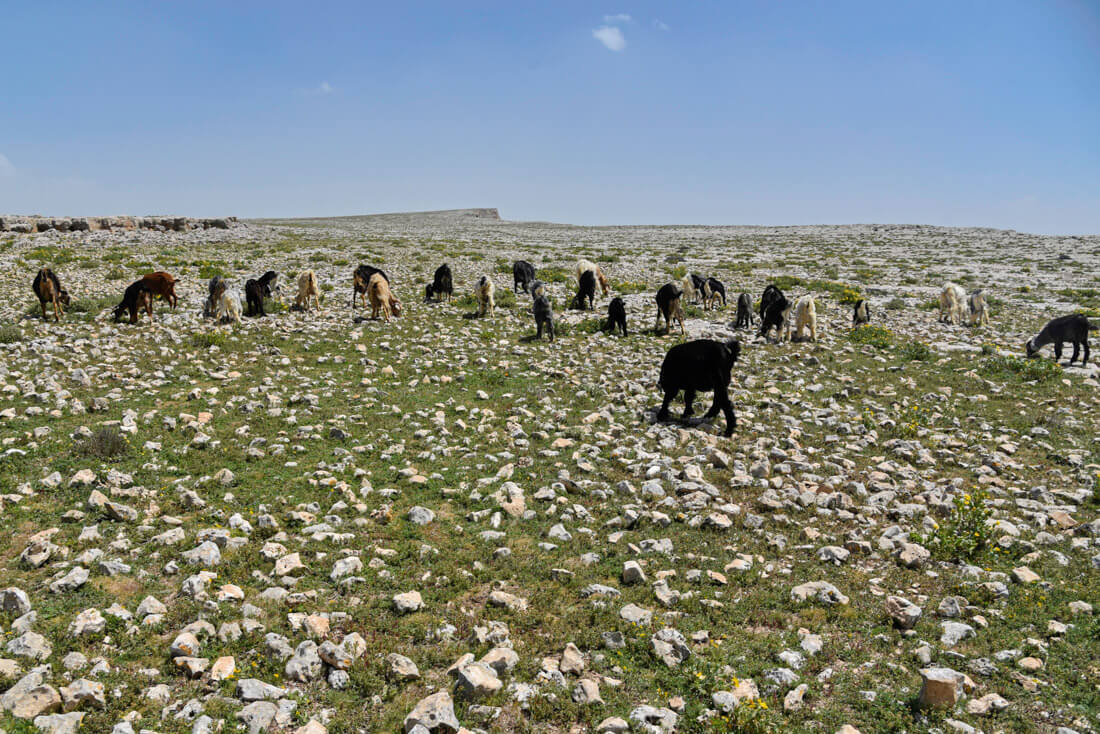
Day 14 – Day trip to Dougga Roman ruins
When I traveled to Tunisia, I also got the chance to check out this amazing place, a UNESCO World Heritage site since 1997 named Dougga,
Dougga has some of the most impressive Roman ruins I have ever seen outside of Rome, probably more stunning than the ruins of Baalbek in Lebanon , or Jerash in Jordan , not only for the ruins themselves, which are in great conditions but also because Dougga was set up in a prime, fertile location, today surrounded by beautiful olive trees and wheat plantations.
Absolutely gorgeous.
Dougga is dominated by the perfectly well-preserved Capitol, dedicated to Jupiter, but you can also find many other temples in good conditions and an amphitheater.
Allow yourself a few hours to visit the area and try to come by the end of the day, when little crowds are gone and, if possible, on a weekday.
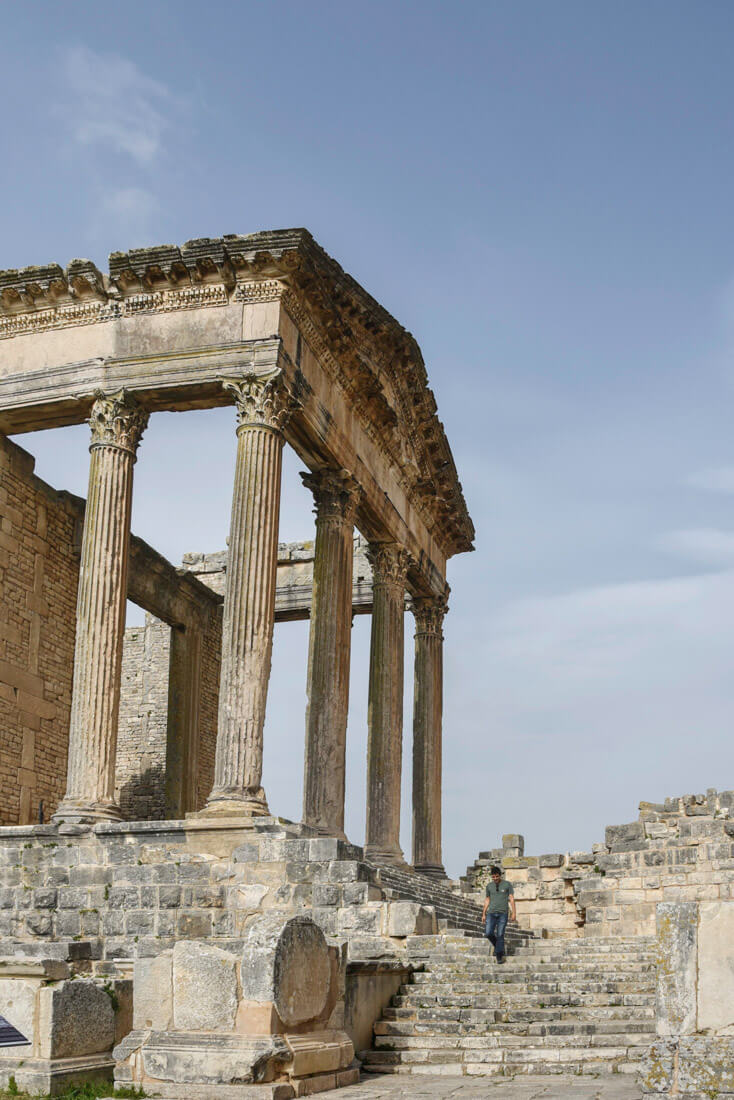
How to get to Dougga from El Keff
It was a bit complicated.
From El Kef, I took a louage to a village named Al Karib. Once in Al Karib, I asked for a louage going to Dougga town, which is 4km from the ruins, but everybody kept me saying there weren’t any, so I decided to hitchhike the remaining 20km, but it was a bit hard, as nobody would stop, don’t know why.
Then, on my way walking from Dougga town to the ruins, a kind man – a worker – picked me up.
Coming back to El Kef was fairly easy, as I just got in the first louage that passed by. By the way, from Dougga, you could easily go back to Tunis.

❗ More information for backpacking in Tunisia
📢 In my Travel Resources Page you can find the list of all the sites and services I use to book hotels, tours, travel insurance and more.
Get the Tunisia Travel Guide by Lonely Planet – A bit outdated but so far, the only one available.

All guides and articles for traveling in Tunisia destination
- Tunis Travel Guide
- Is Tunisia Safe?
Travel guides to other countries in Africa
- Ethiopia Travel Guide
- Eritrea Travel Guide
- Somaliland Travel Guide
- Travel Guide to Sudan
- Travel Guide to Egypt
- Libya Travel Guide
- Mali Travel Guide
- Travel Guide to Mauritania
PIN IT FOR LATER
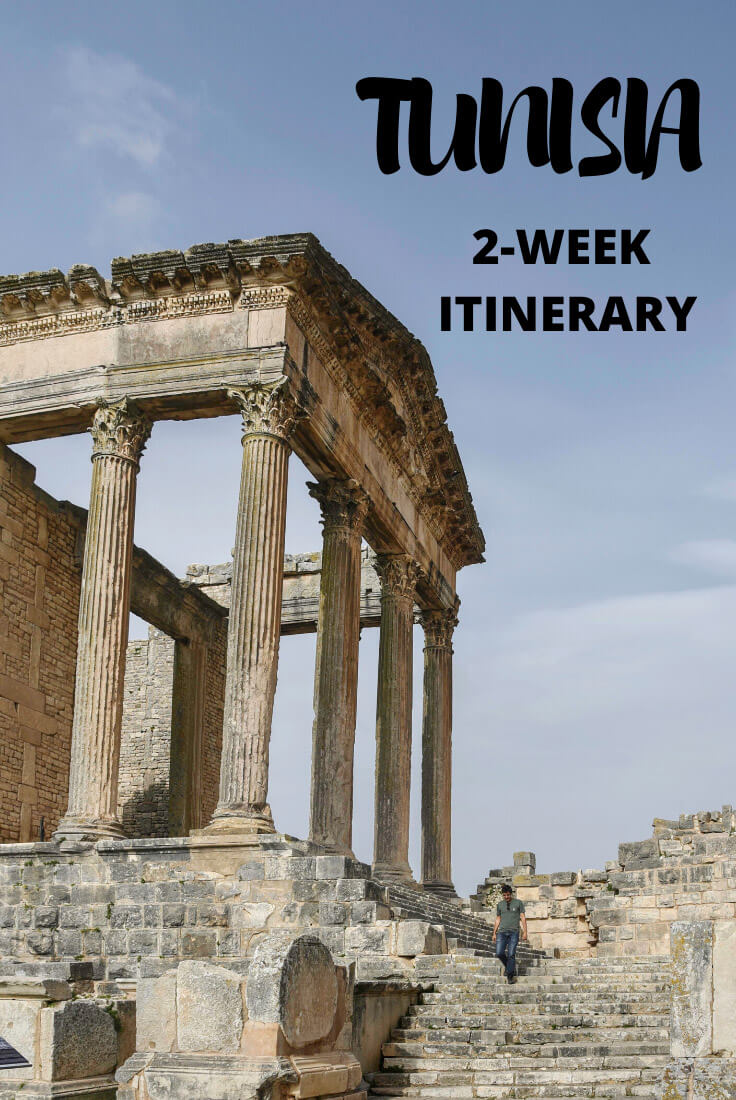
20 comments
Great blog and info as always:)Am supposed to go to Tunisia in october for 2,5 weeks ,still plan on going if……
Love reading your post, as it brings so many great memories. We have done 2 weeks roadtrip around the country too, but left the northern part for next time – I sure hope to be able to return soon and that these crazy times will be just a bad memory. All the best!
Has anyone rented a car and drove around Tunisia independently?
I did, in the south. Very easy
Man, let me tell you something and you can take it as a fact: any Arabic speaker can speak freely with another Arabic speaker from anywhere in the world. Yes, there are diferences and they can tell roughly from where the other dude is. Like I can tell a Texan from an Australian.
Hey Joan: Another great trip report. Currently planning my itinerary for my summer trip to Tunisia. This will largely be a RnR/beach vacay but looking to include some side excursions. Will likely position ourselves in Sousse and wondering if Dougga is doable as a day trip via public transportation? Also how does it compare to the amphitheatre in Busra, Syria?
Just want to make sure, the train to Sousse from Tunis is 10,000 Dinars or more than 3,000 USD for a 2 hour train ride?
Hi Joan, Thank you for a great introduction to Tunesia. Being European I typically spend my vacations at tourist hotspots in Spain, Greece, or Italy. It’s nice – but far from the adventure you’re describing. Need to convince the rest of my family to become a bit more adventourous 🙂
Mega helpful. Thank you.
Is there anyway to get from Sousse to Dougga?
Thank you for the information. Planning on a 2-week trip end of April 2023. Trying to source information about the Northern part especially traveling from/to Tunis – Bizerte – Cap Engela – Tabarka – Tunis
I’d love to visit Dougga. You said it’s possible to get back to Tunis from Dougga, is there a louage going between the two?
Hi Sarah, not from Dougga, since that is an archaeological site, but from nearby villages or towns.
Good evening, Hope everything is fine. I am planning to go to Tunisia and I wonder if there is a way to go from Medénin to Djerba Island by public transportation. If you know if there is a way I would like you to confirm it to me. Thank you in advance
Hey, I don’t remember exactly but I did go there by bus. It should be easy, just go to the bus station and ask for it
hello joan . i am planning to visit tunisia in august and move around with louages. in your article you mentioned that you visited tozeur with a louage. do you remember if it was direct ( tunis – tozeur ) or i have to change a bus in another city ? also , the station in which louage leave ( from tunis ) is called moncef bey , right ? any information will be helpful . thanks in advance and also thank you for sharing all these travel informations for countries that are not so visited . greetings from greece 🙂
Hi Konstantina! I traveled slowly from Tunis to Tozeur, stopping in many places in between, so I can’t really tell!
Hola Joan, qué tal?
A ver si hay suerte y ves el mensaje a tiempo. Estoy en Túnez y en unos tengo pensado visitar la zona alrededor de Medenine/Tataouine y estoy buscando un sitio para alquilar coche un día. Me podrías pasar el nombre, la ubicación o algún contacto aún mejor del sitio dónde alquilaste tú?
Muchas gracias, saludos!
Hola Jack, lamentablemente jamás me apunté la dirección, pero todo lo que hice fue buscar en Google Rent a Car
hello , thank you for writing about Tunisia but I think you should update your prices for the food , those prices must be from 10 years ago !
They are from 2019 but if you have any updated prices, they are most welcome 🙂
Leave a Comment Cancel reply
Your email address will not be published. Required fields are marked *
Notify me when new comments are added.
Join our Expeditions
From Syria to Iraq in Pakistan, Against the Compass is finally running expeditions to the most epic and off-the-beaten-track countries.
We have scheduled expeditions for every month of the year.
Latest posts
- Backpacking Venezuela Travel Guide (2024)
- How to travel to Afghanistan during Taliban rule (2024)
- How to visit Los Llanos in Venezuela
- How to visit Angel Falls and Canaima National Park
- Things to do in Haiti in a 1-week itinerary
- Work With Me

- Sierra Leone
- South Africa
- United States
- New Zealand
- Falkland Islands
- Netherlands
- Accommodation
- Electrical Gear
- Essential Gear
- Working Abroad
- Blogging Resources
Africa , TUNISIA
11 top tips when you travel tunisia: key things to know before you go.
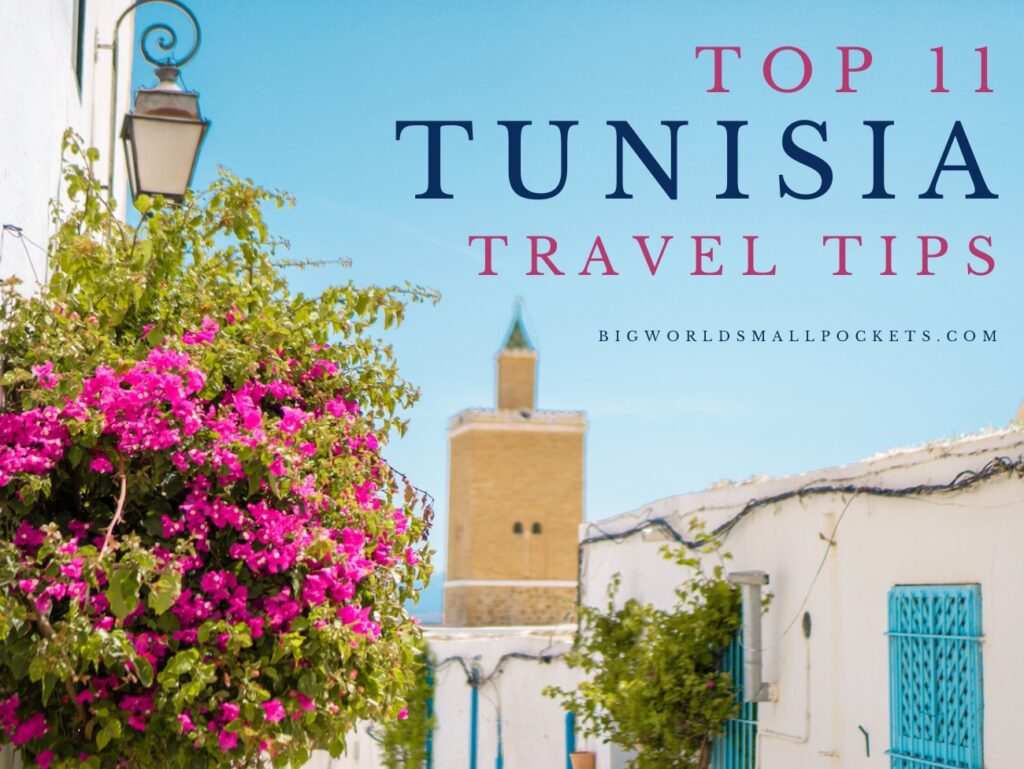
If you plan to travel Tunisia, then here’s 11 key things you should definitely know before you go!
From what to eat and how to find the best accommodation, through to the best way to get around, what to pack and some top tips for solo female travellers, this is my full guide to prepping, planning and enjoying your travels in this fantastic country.
While Morocco and Egypt may be stealing the lion’s share of tourists in north Africa, Tunisia’s charm lies precisely in the fact that large parts of the country remain wonderfully undiscovered by foreign tourists.
And from beaches to deserts, ancient historic sites to quaint cobbled-street towns, trust me when I say there’s a lot to discover here!
So if you’re heading to this fab country soon, take a read of my following top Tunisia travel tips and start planning your adventure there asap…

Related Posts
- Egypt vs Tunisia: Which is Best to Travel?
- Sidi Bou Said, Tunisia: Full Travel Guide
- 55 Best Things to Do in Africa
My trip to Tunisia was sponsored by the Authentic Tunisia campaign but, as always, all views are my own.
This page contains affiliate links meaning Big World Small Pockets may receive a small commission on any purchases at no extra cost to you.
#1 When to Travel Tunisia?
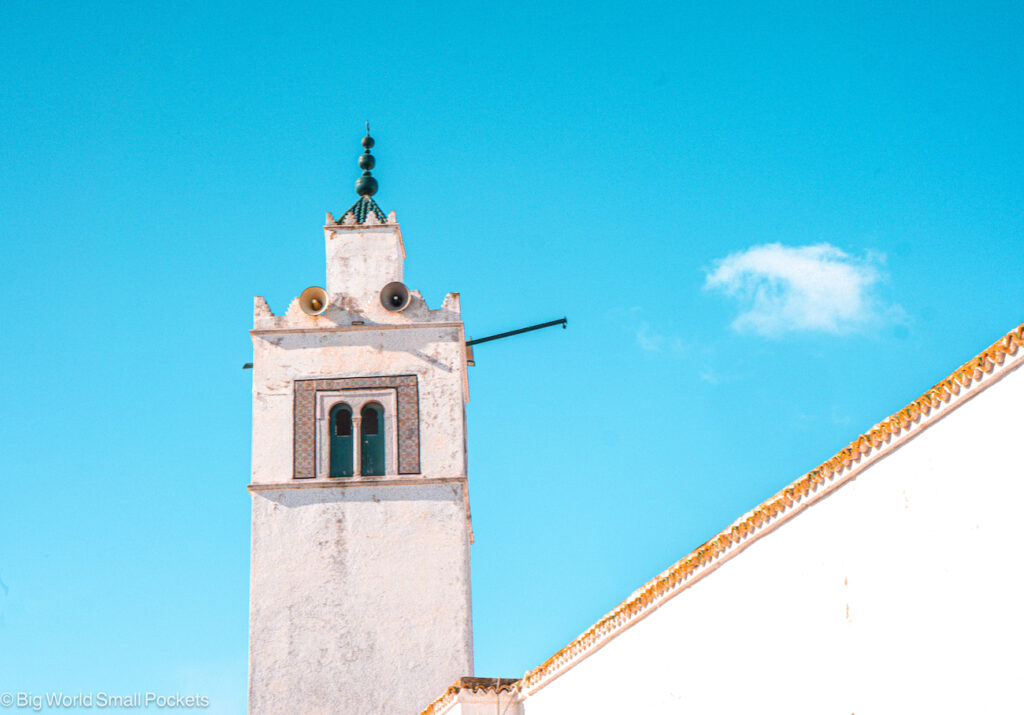
I really recommend travelling Tunisia in either the spring or autumn months.
Like other countries in North Africa, May June, September and October are ideal months to visit Tunisia because temperatures are still warm enough for sightseeing and the beach, but you’ll avoid the scorching temperatures of the summer.
Winter months are a great time to travel Tunisia if you want to avoid the crowds and get a real bargain, but do beware that, especially in the north of the country, it can be wet and cold during these months.
Learn more about when to visit each area of Tunisia, as well as a month by month overall weather breakdown, in this article I wrote all about the best time to visit Tunisia .
#2 How to Get to Tunisia?
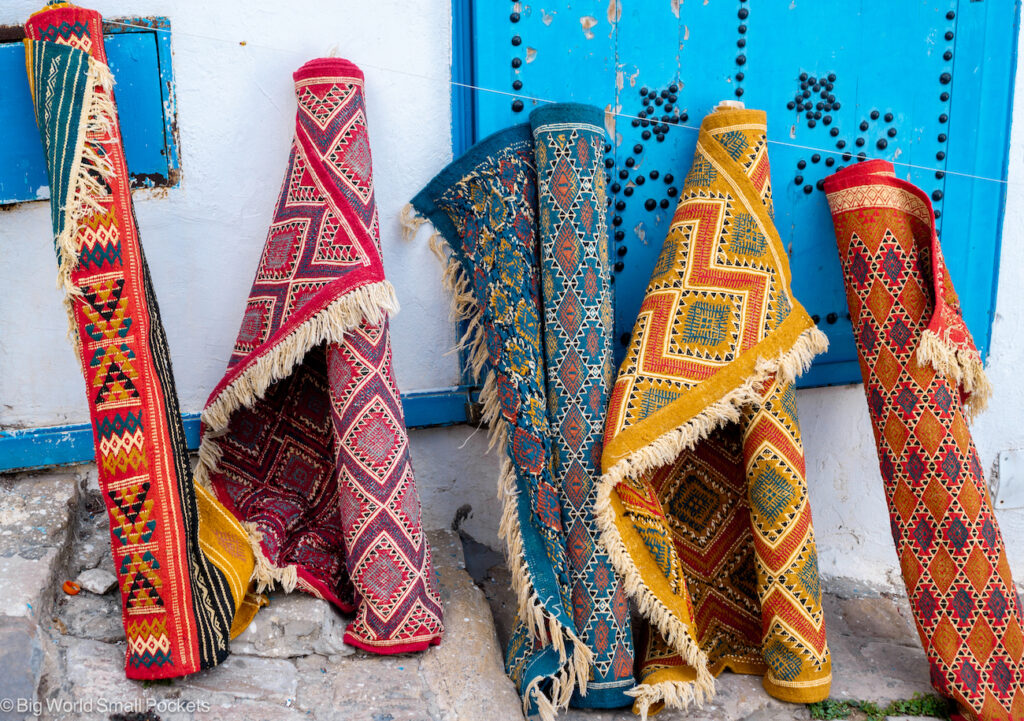
Unless you’re travelling overland from Algeria (which while is possible, is certainly not common!), the vast majority of travellers arriving into Tunisia will come by air.
There’s several international airports in this country, but the main ones are…
#1 Tunis-Carthage – best if you want to begin your travels in the capital Tunis or nearby Sidi Bou Said
#2 Enfidha-Hammamet International Airport – best option if you’re heading for a beach holiday at the Hammamet resort
#3 Djerba Zarzis International Airport – located on the beautiful island of Djerba
#4 Monastir Habib Bourguiba International Airport – situated near the coastal city of Sousse
#5 Sfax Thyna International Airport – best for exploring the south of the country
The great news is that from most European cities, flights to Tunisia only take around 2-3 hours.
As always I use Skyscanner to find the best prices.
#3 How Best to Travel Around Tunisia?
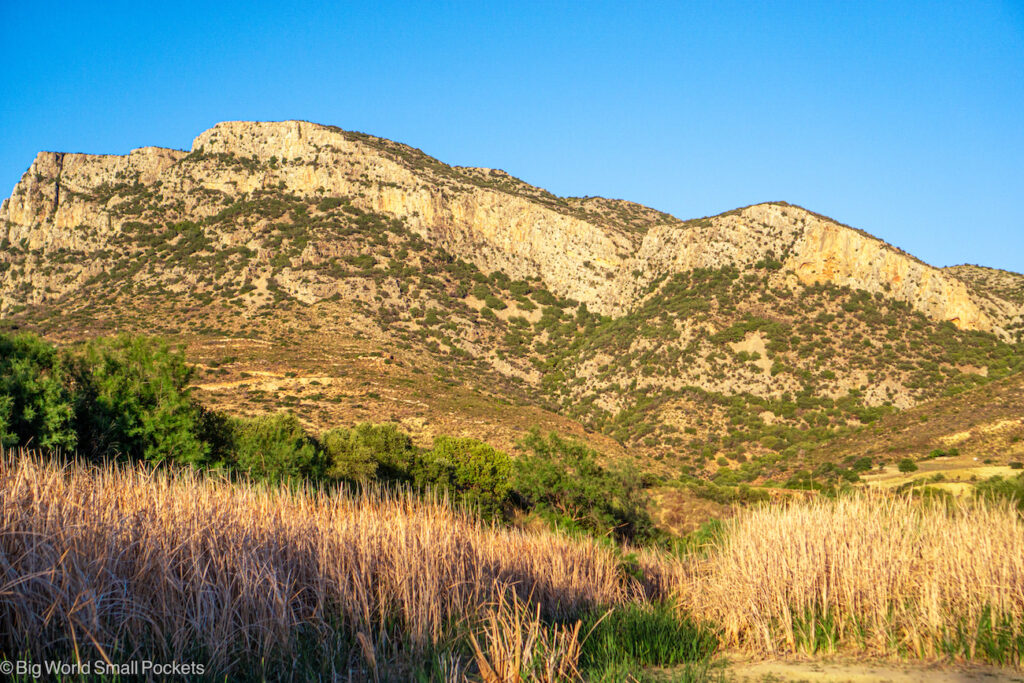
In the Tunis-Carthage area, there is a handy metro and regional light train service that gets you between the main areas.
The Bolt rideshare app (like Uber) also exists in this area and is a great idea for getting around without having to worry about language barriers and confusing prices!
Beyond that, long distance trains service major cities in Tunisia including Sousse, El Jem, Sfax, Bizerte and Gabès.
For smaller towns, buses or shared minivan taxis, known as louage , are common modes of transport.
Bookaway is a great site for booking train, bus and private transfer options in Tunisia.
Public transport can be a bit patchy here sadly, so isn’t always ideal for using if you’re on a short itinerary and want to explore a lot.
As such, I really suggest hiring a car to explore this country – especially the north and east regions – and highly recommend Discover Cars for the job.
Alternatively, if you feel more confident travelling Tunisia as part of a group, or with a guides, check out these top Tunisia tours .
#4 How Long to Travel Tunisia For?

I really recommend a minimum of 7 days to travel Tunisia.
Tthis will allow to you to enjoy a couple of destinations located close to each i.e. Tunis, Carthage, Bizerte and Dougga.
If you want to travel more widely across the north of country, including exploring fab destinations such as Al-Huwariyah, Sousse and Zaghouan, then I suggest at least 10 days for your time in Tunisia.
Check out this epic 10 day itinerary I wrote for the north of Tunisia for more ideas.
If you’d also like to explore the south of Tunisia, including the islands of Djerba and some of the key Star Wars sites in the desert, then you’ll need to allow at least 2 weeks for your travels in this country.
#5 What to Pack for Your Tunisia Travels?
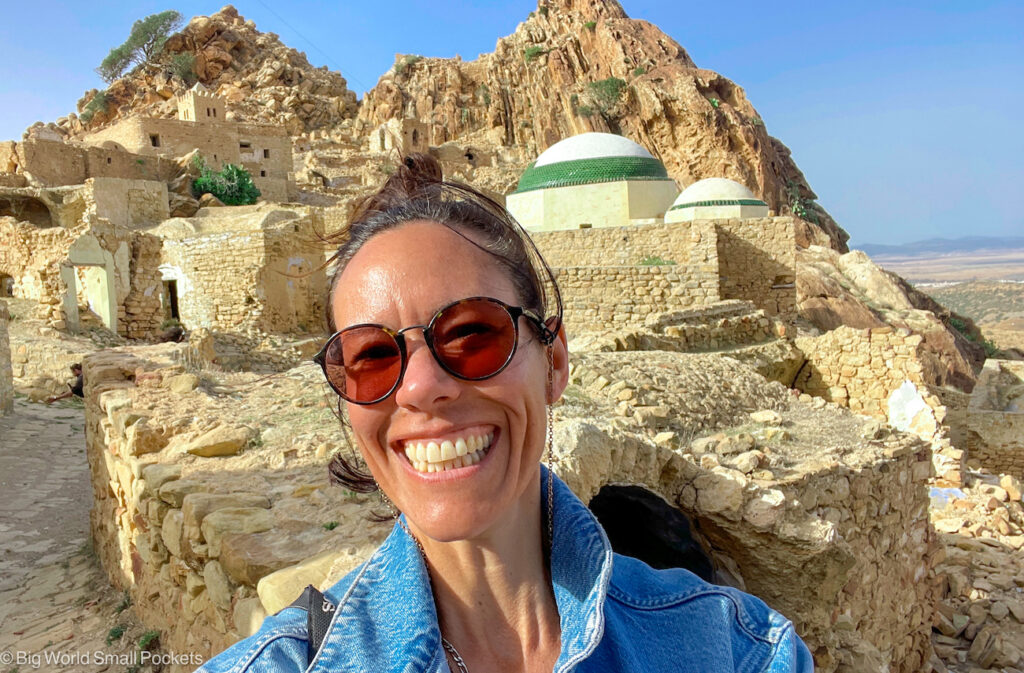
What many people don’t realise is that temperatures in Tunisia can be fresh across the country even in the spring and autumn months.
This is especially true in the more mountainous north of the country, but even in the desert at night it can get cool at these times.
As such, I certainly advise bringing some warmer layers with you, including a wind and water proof thin jacket , as well as a denim jacket and a couple of warm jumpers or fleece.
Trainers or sneakers are a great idea as well, so you can enjoy sightseeing and some active pursuits in this country, and don’t forget some longer trousers for cooler days as well.
For beach days in Tunisia, you’ll need swimwear, sunscreen, sunhat and a sarong, while for deserts and religious sites, thin light clothing that covers the knees, chest, shoulders and upper arms is required.
Outside of these items, don’t also forget a good day pack , a filter water bottle , a good camera , a decent guidebook and an Arabic or French phrasebook .
Learn more in this complete Tunisia packing guide I wrote.
#6 Travel Insurance for Tunisia

Alternatively, if you’re a long-term traveller, digital nomad or frequent remote worker seeking travel health cover, check out Safetywing’s Nomad Insurance policies.
#7 Best Things to Do in Tunisia
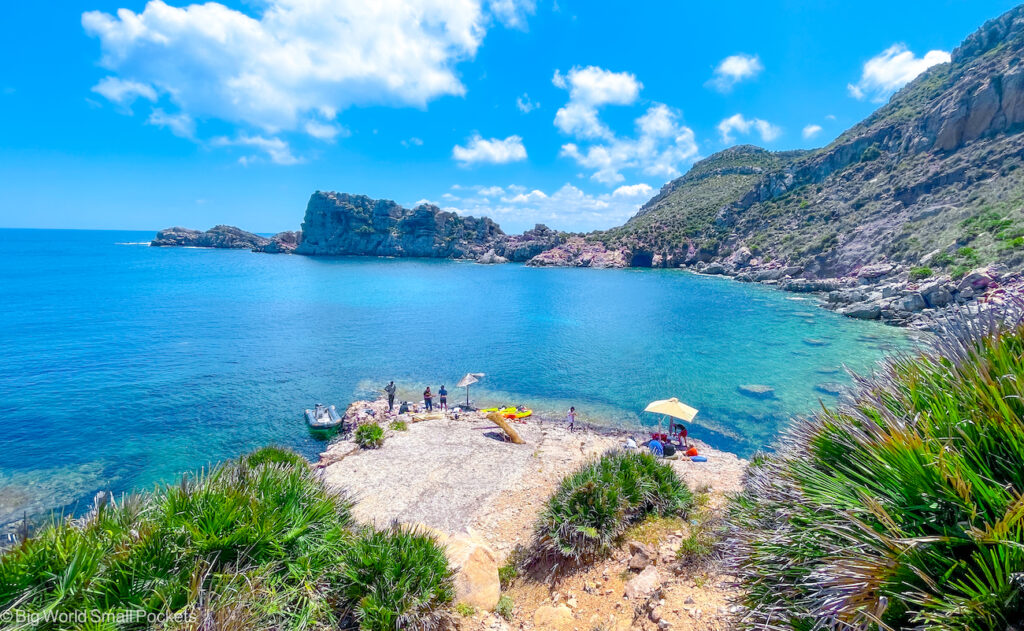
As most people are aware, Tunisia is filled with some fantastic beaches and stunning stretches of the Sahara, so if you want to get a good dose of sun, sea and sand (especially outside of the peak summer months), this country makes a great choice!
But did you know that Tunisia also offers tons of great stuff to do away from these classic pursuits, including a huge range of active and historic attractions.
Heading to ancient UNESCO-listed sites, such as the Carthage ruins, El-Djem amphitheatre, Dougga archaeological site and Kairouan’s Grand Mosque are some great examples, but between these you can also enjoy a range of outdoor adventures such as kayaking, climbing, caving, cycling, hiking, sailing and diving.
My favourite spots for outdoor activities in this country include the region of Cape Bon, Zaghouan and Siliana.
The latter of these also boasts an amazing array of traditional craft workshops with local women, from cooking to weaving.
Learn more about all these in this list of top 21 things to do in Tunisia .
#8 Is Tunisia Safe to Travel?
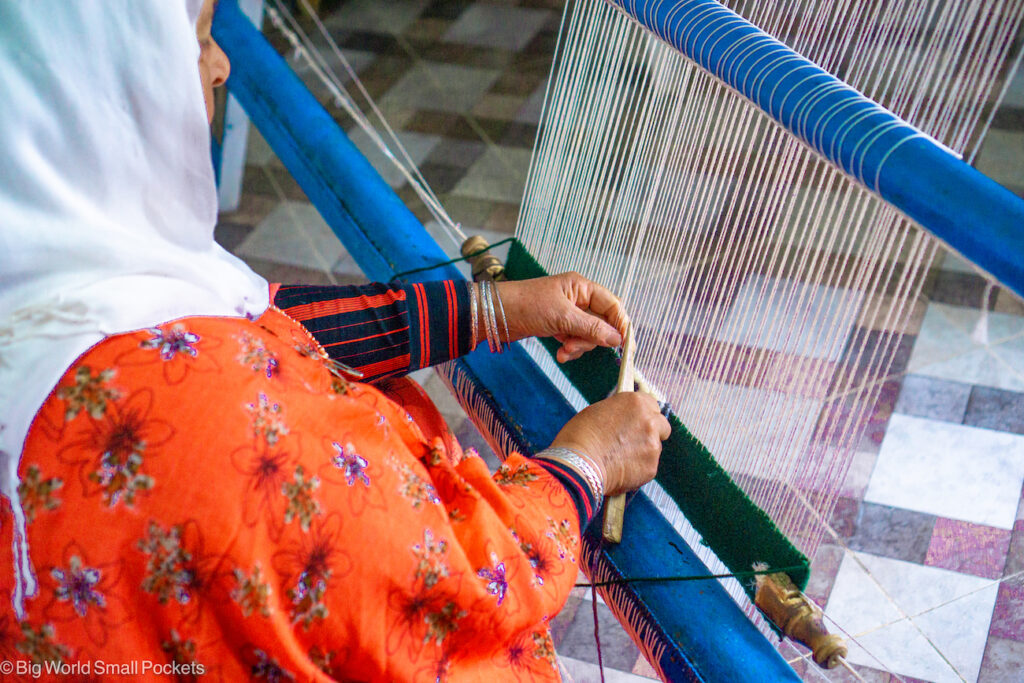
I found Tunisia incredibly safe to travel and never felt hassled, watched or pestered when adventuring here, even as a solo female.
In smaller towns especially, I felt comfortable wandering around in the evening and, generally speaking, found the country to be more liberal than other countries I’ve visited in North Africa.
In particular, alcohol was available in hotels across the country, and I found wearing three quarter-length trousers with singlets and a thin scarf to be totally adequate.
While there has been some events that have targeted tourists in the past, in general, I’d say Tunisia feels very safe to travel as long as you follow the usual common sense precautions.
Taking a SIM card is a great way to feel reassured when travelling in less familiar parts of the world too – it’s super handy for Google maps, Whatsapp and Rideshare apps, all of which help keep you safe.
aloSIM is a great solution as you can buy it online before you arrive and then ensure you’re connected as soon as you touchdown in Tunisia.
#9 Is Tunisia Expensive?
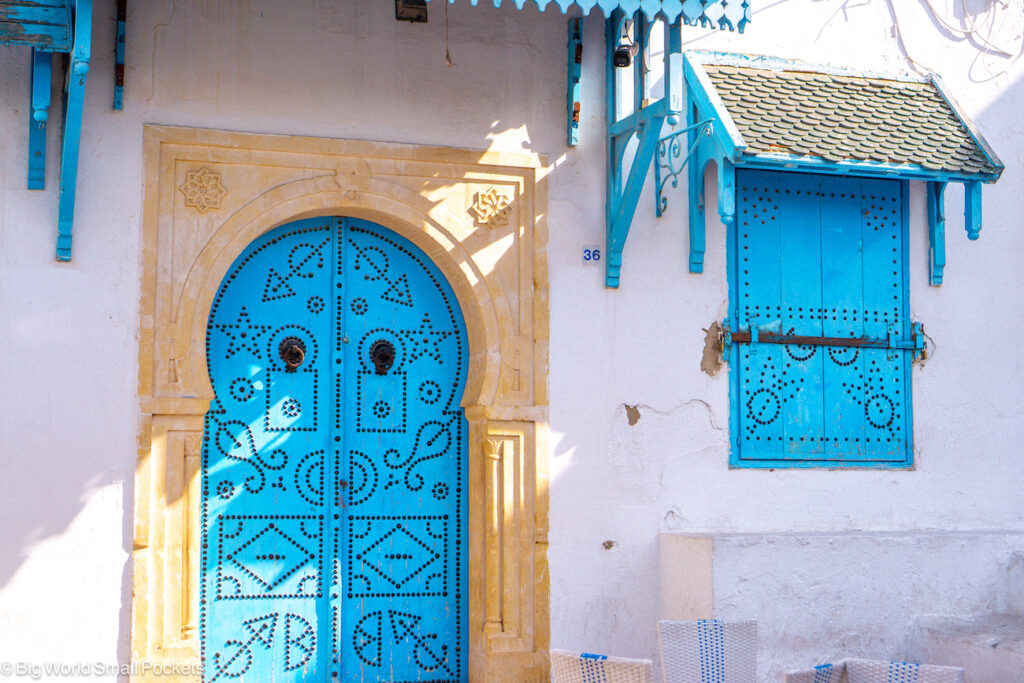
I found Tunisia incredibly cheap to travel, in fact I’d rate it as one of the cheapest countries I’ve ever been to (probably only behind Armenia, Georgia, Egypt and Turkey).
Food here is very affordable, as is accommodation, and getting around via public transport costs next to nothing.
As nightlife isn’t a big deal in this country (it’s actually non-existent in many towns!), you won’t spend much on alcohol or going out in the evening here.
The things you will spend a bit more on however are flights to the country (sadly no budget airlines fly here), as well as car hire and tours if this is how you choose to get around the country.
At the most basic end of things, you can easily travel Tunisia on $50 USD a day.
At the top end (eating in fancy resort restaurants and staying in 5* hotels), you’re looking at $300 USD+ a day.
And when it comes to spending money in Tunisia, you want to ensure you’re not being charged overseas transaction fees or getting poor exchange rates when using your card here, which is why I always take my Wise card away with me wherever I travel.
The easy way to spend abroad with real exchange rates, no markups and no sneaky transaction fees, you can use your Wise card just like a debit card in Tunisia… and it links easily with Google and Apple pay – sold! Grab yours here .
#10 Where to Stay in Tunisia?
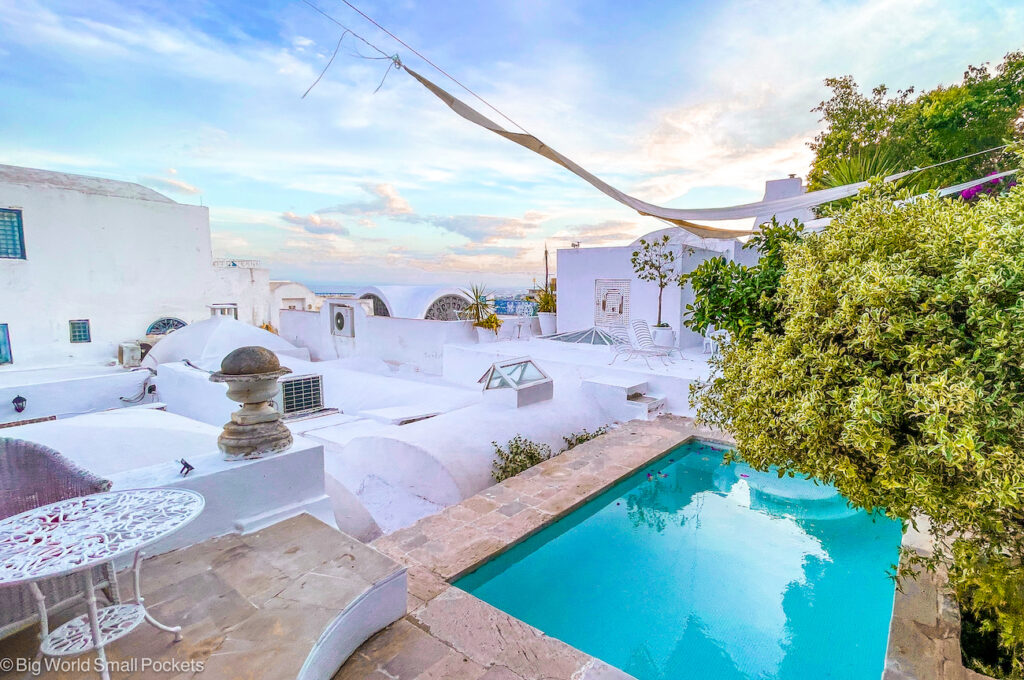
While Tunisia doesn’t have any hostels, it does however have a good selection of hotels and resorts across its main cities and resort areas.
For the best accommodation outside of these major destinations however, I high recommend the network of traditional guesthouses known as “dar”.
These are homestay like set-ups, usually in a traditional Tunisia home or guesthouses.
Small and boutique, they generally feature a few rooms, modern comforts and tend to offer homecooked meals in the evening, as well as breakfasts in the morning, which makes them even better in my opinion!
I really loved staying in these Dar properties across Tunisia because they all give a wonderful sense of the culture of this country, as well as comfortable and unique stays.
My top picks include…
Dar Aida in Zaghouan
Dar Villa Zembra in Al Huwariyah
Dar Khadijaa in Hergla
Dar Essid in Sidi Bou Said
Message these accommodation choices direct through the Instagram links above for the easiest booking process – it’s really hard for small Tunisian business to register with Booking.com or Airbnb FYI, so Instagram is the best way to book direct and get the best prices.

#11 Food and Drink in Tunisia
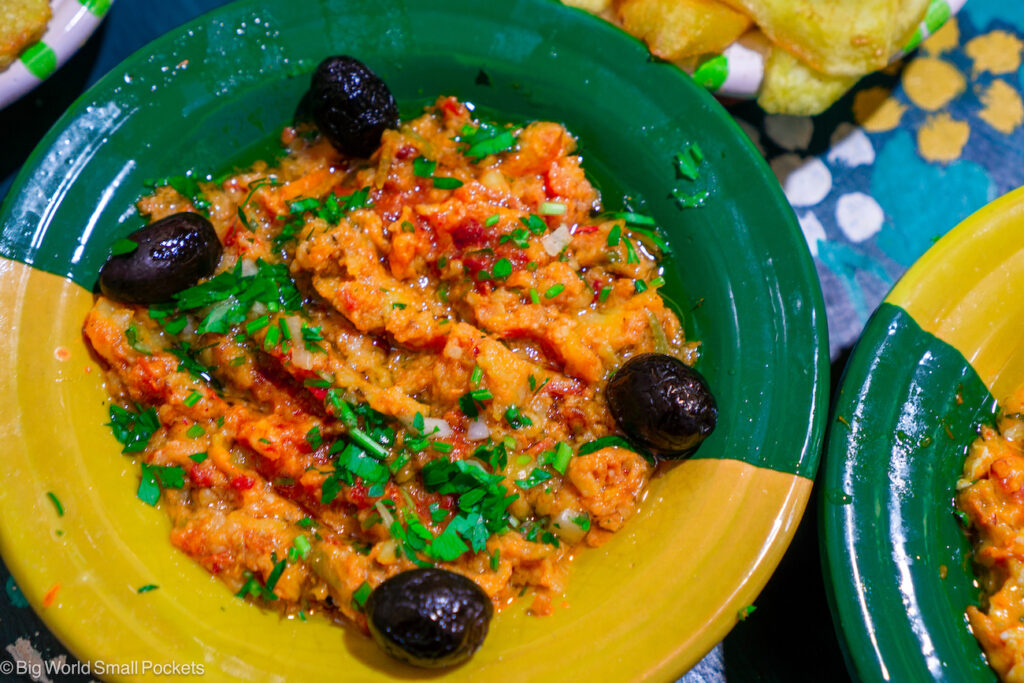
If you weren’t in the know about Tunisian food, then you’re in for a great surprise when you travel this country, because it’s honestly fantastic!
Spicy, fresh and delicious, a huge amount of food is produced in this country, which makes for a wonderful culinary tradition and almost everywhere you adventure here, you’ll get to enjoy seriously great meals.
With most Tunisian food containing either meat or fish, you’ll need to make sure you specify you don’t want either if you’re a vegetarian, but this is simple to do and most places are very happy to cater for non-meat and fish eaters I found.
Bread is a huge staple here (so non-gluten folk beware!) and spice is too, with homemade harissa being heaped on pretty much every meal… much to my delight!
Most meals are a few course long – soup, then salad, then main, then fruits, the tea and cakes! – and you’ll quickly learn Tunisian meal sizes are not small, so you have been warned!
As a majority Muslim country, alcohol is not commonly served in Tunisia and most meals are accompanied by water and finished with sweet tea.
Alcohol is not easy to find across the country, but can be sourced in tourist-orientated restaurants and hotels, which are found in most of the major towns and cities.
Tourist-dominated areas, as such as the resort of Hammamet, have lots of hotels with bars for alcohol-seeking holiday makers.
You can’t drink the tap water in Tunisia, but bringing a Water To-Go bottle with you, will allow you too safely!
Learn more about these amazing water filter travel products here .
Just enter your email address below and I'll send it to you for FREE!
Information will be sent to the email provided above
PIN IT TO PINTEREST!
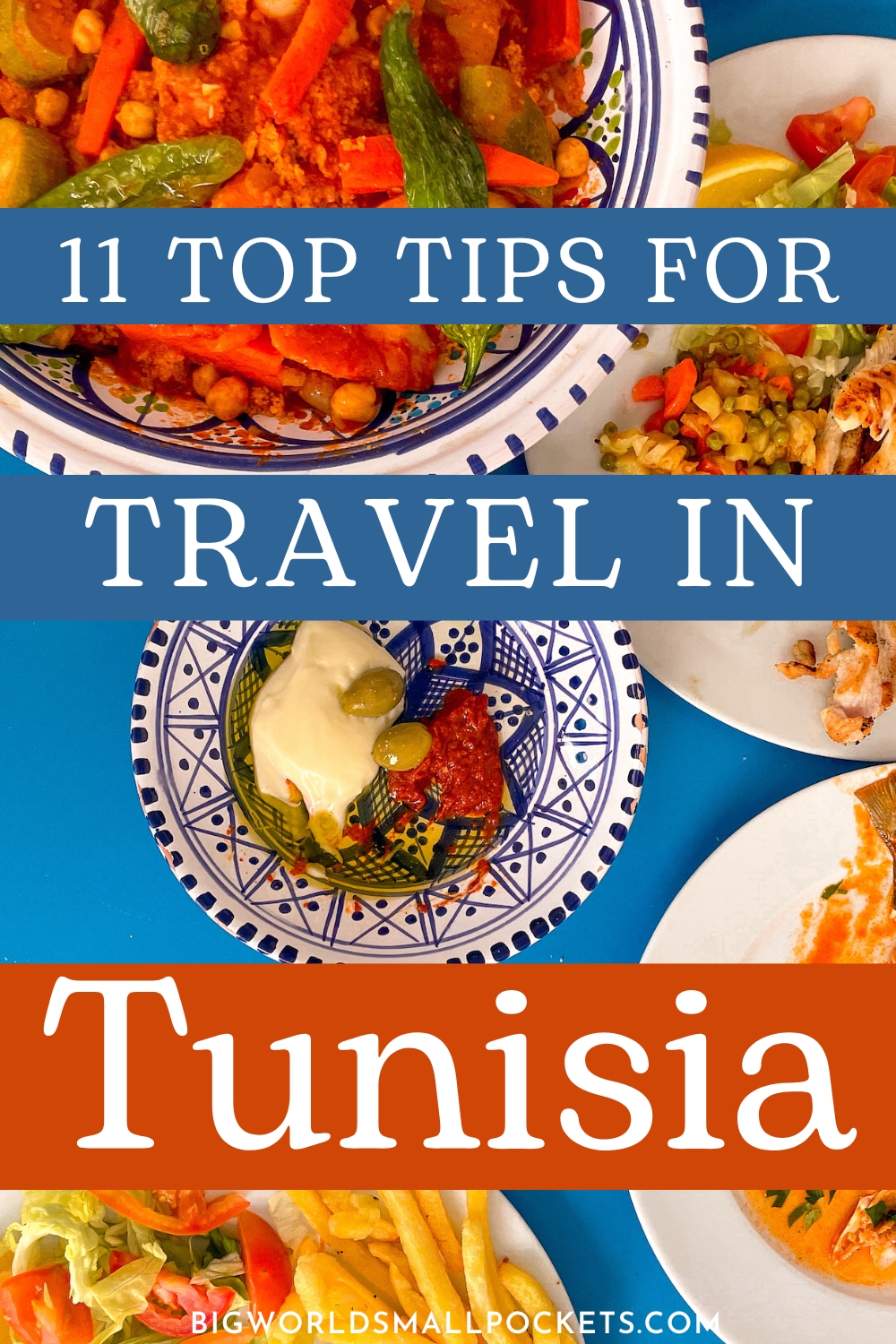
So there you have it, my top travel Tunisia tips!
If you’re looking to get off the beaten track in North Africa and away from the tourist crowds of Egypt and Morocco, then this country is for you!
Have any questions about travel in Tunisia still?
Then don’t hesitate to drop them into the comments box below and I’ll get back to you…
Creator of Big World Small Pockets, Stephanie Parker is a travel addict! Originally from Jersey in the Channel Islands, Stephanie adventures the world collecting tips, advice and stories, to share with a smile
2 thoughts on “ 11 Top Tips When You Travel Tunisia: Key Things to Know Before You Go! ”
Such a remarkable country. Thanks for all the tops and great images! Definitely going to add it to my bucket list. Safe travels 😉 Donovan
Ah so fab to hear this Donovan! Defo get Tunisia on your bucket list! Happy travels and best wishes, Steph 🙂
Leave a Reply Cancel reply
Your email address will not be published. Required fields are marked *
This site uses Akismet to reduce spam. Learn how your comment data is processed .
- Meet the Team
- Work with Us
- Czech Republic
- Netherlands
- Switzerland
- Scandinavia
- Philippines
- South Korea
- New Zealand
- South Africa
- Budget Travel
- Work & Travel
- The Broke Backpacker Manifesto
- Travel Resources
- How to Travel on $10/day
Home » Africa » Backpacking Tunisia Travel Guide (BUDGET TIPS • 2024)
Backpacking Tunisia Travel Guide (BUDGET TIPS • 2024)
Nestled in a dreamy corner of Africa, lies a small but mighty land boasting sand, sea and copious amounts of tea.
Sublime scenery . Unforgettable hospitality.
Tunisia is a special, special place.
Lush forests disappear South into the stillness of the Sahara , flanked by a coastline of pristine beaches and fascinating islands.
Home to a unique blend of North African and Mediterranean cultures, surreal archeological sites and access to the desert on a budget, Tunisia is a broke backpacker’s dream.
Navigating this cultural and physical landscape may appear tricky, but with a few tips and tricks, you’ll have all the tools you need to venture off and explore this tasty slice of North Africa, which is exactly what you’ll find in this backpacking Tunisia travel guide .
… The desert calls!
(And any Star Wars fans, do add an extra week…)
Why Go Backpacking in Tunisia?
Being honest, visiting Tunisia hadn’t crossed my mind, until I found myself heading down Italy and wondering what to do next.
As it turns out, Tunisia is home to the world’s most magnificent front doors. If this isn’t enough, behind those doors, live the most fantastically friendly people: nowhere else have I felt such a universally-warm welcome.
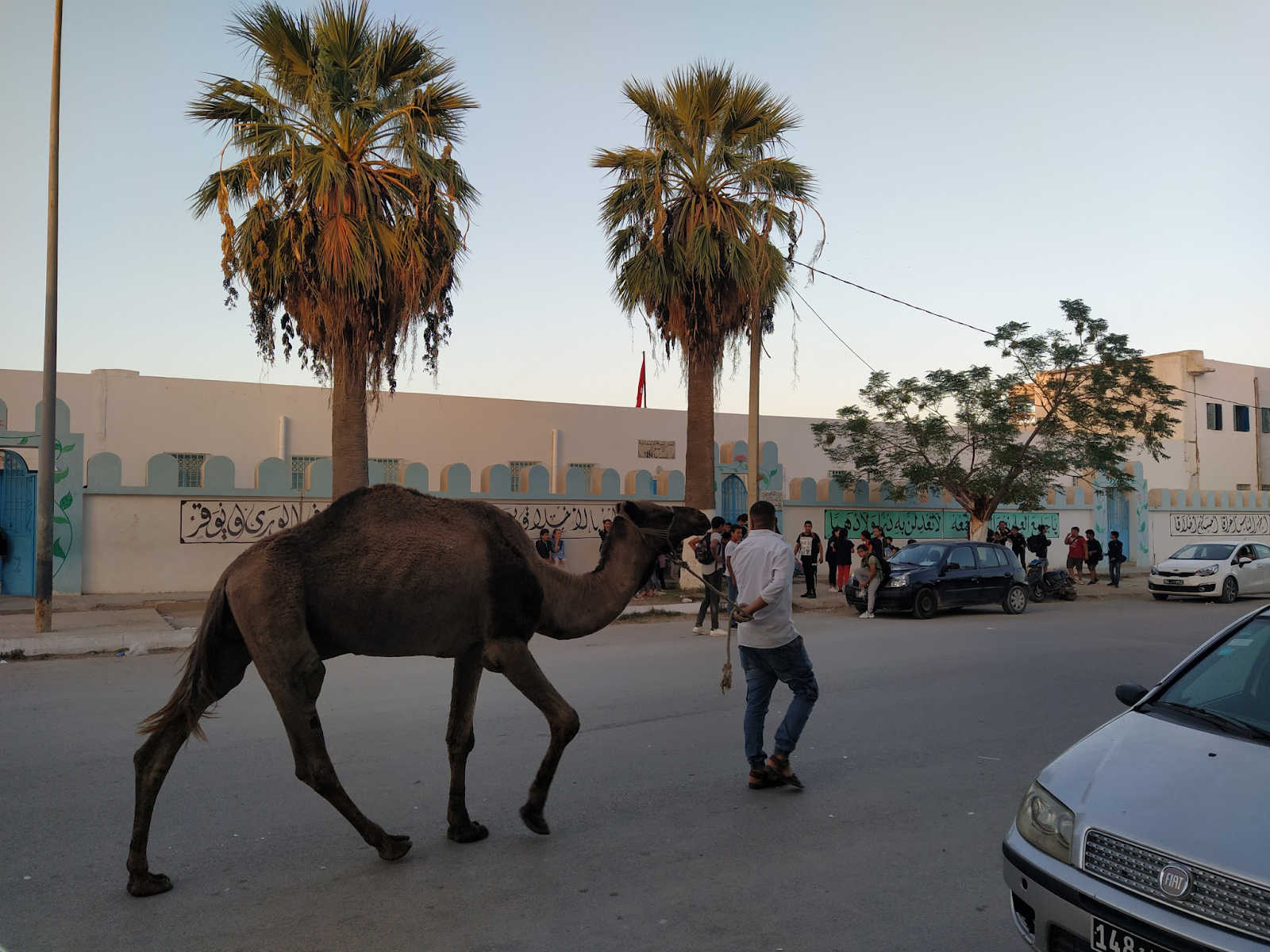
My main tip for backpacking Tunisia is to be open to adventure: you never know where the day may take you, and that is part of the beauty of travelling here. I could fill this guide exemplifying the kindness of Tunisian people, but that’s best discovered yourself.
So don’t think twice: book that ferry or flight, and head to North Africa. Chats with locals over tea will capture your heart, and the Saharan landscape will take your breath away. I guarantee you that budget backpacking Tunisia will leave you wanting to return.
Best Travel Itineraries for Backpacking Tunisia
If you have a week or even less to explore, there’s good news: the desert dream is remarkably accessible. You’ll have time to set forth across the countryside, to and from Tunis in the North .
A month would allow you to cover both the wide range of historical sites and natural beauty spots on offer pretty extensively.
Either of these itineraries will ensure you experience the best of Tunis, the tranquillity of the south, and immerse yourself in Tunisia’s rich history.
However, don’t be afraid to construct your own route. Using these itineraries as a guide, but sporadically wandering off, would be a juicy way to explore.
Plus, have a go on various modes of transport during your trip. Trains, buses and louages (don’t worry, all will be explained … ), each deserve their place on a Tunisian adventure.
You may even find yourself hitching a lift on a tractor, if your heart so desires…
A word of caution: Tunisian summertime is VERY warm, particularly in the desert. Some tours may not operate from June to August, so if you’re set on the Sahara, the summer months are best avoided.
1 Week in Tunisia: A Descent to the Desert…
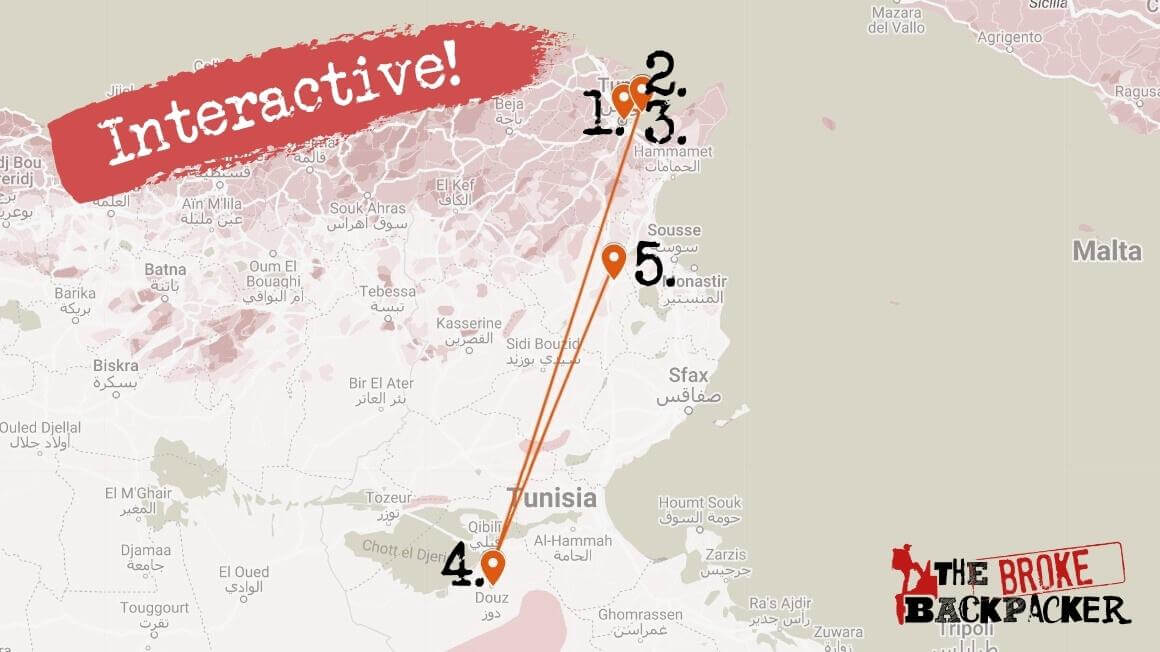
Most travellers will arrive in Tunis , either by air or sea.
Wander the vibrant capital and suburbs: Sidi Bou Said is a beautiful seaside town, with buildings of white and brilliant blue. Carthage , an ancient capital, is home to a remarkable span of ruins from days of former glory. Both are a short metro ride from Tunis.
To reach the Sahara, take a louage (shared minivan) down to Douz for a sandy excursion. From here, experience a night in a traditional Bedouin camp.
Make time for a visit to the extraordinary Kairouan and the Great Mosque, founded over 13 centuries ago.
Return to Tunis for most onward travel options. It’s probably around this time you’ll be thinking about when your next Tunisian adventure might be.
That’s one week, and no less than THREE different Unesco World Heritage Sites!
1 Month in Tunisia: A Legendary Loop
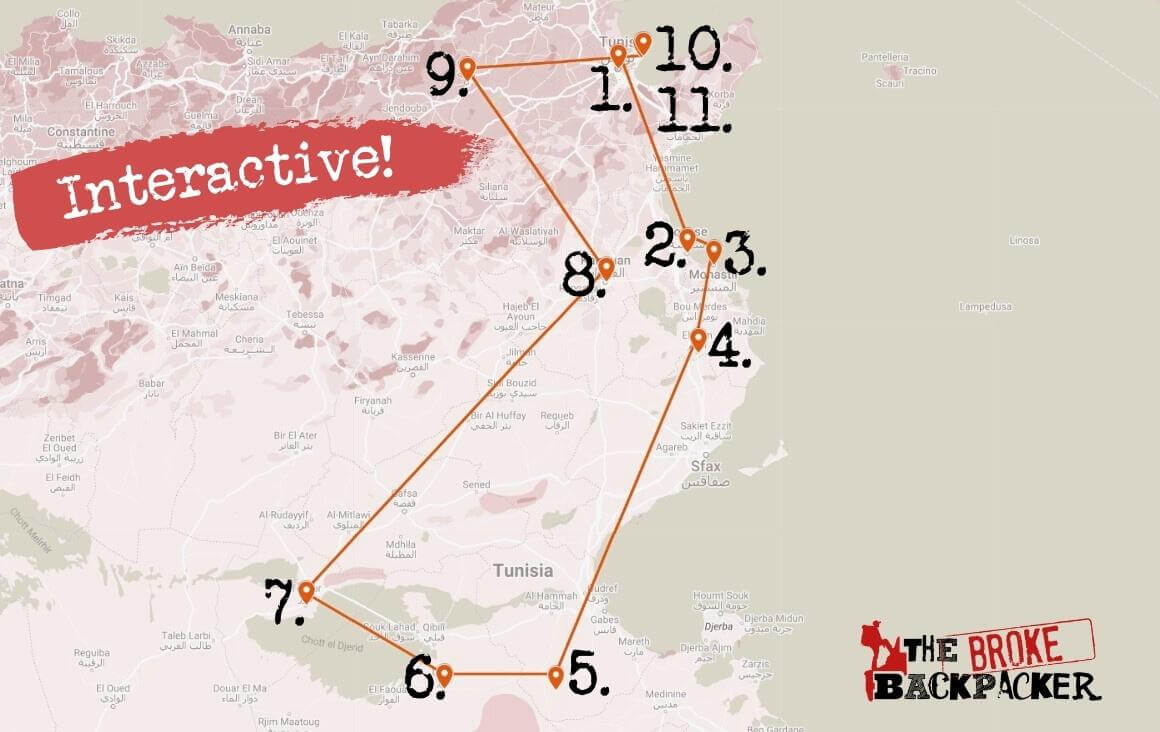
For those with longer on the road, the range of historical sites and natural wonder on offer could fill a month or more.
This itinerary forms a loop from Tunis , hugging the coast through the beachside hangouts of Sousse and Monastir , and the marvellous Amphitheatre of El Jem .
Explore the southern region’s Berber culture of Matmata and Douz, and of course, the Sahara itself.
Check out Touzeur and the abandoned villages nearby. Then head North to magical Kairouan and its Great Mosque, on the way to Sousse for another medina wander.
Finally, spend a couple of days in the Beja governorate for some scenic sights and a glimpse into life in Antiquity. (Plus pomegranates. And if it’s October, a festival celebrating pomegranates.)
Return back to Tunis to round off the circuit with a mooch around Carthage and ridiculously attractive Sidi Bou Said .
Best Places to Visit in Tunisia
These are the backpacking Tunisia destinations that you just shouldn’t miss…
And if you can – do take your time. Tunisia is a fantastic place to slow travel .
Backpacking Tunis
Tunis is a marvellous blend of old and new.
Get lost in a maze of alleyways in the medina , explore the souks and shop for souvenirs, before settling into a rooftop cafe for sunset. For a capital, Tunis is very walkable, and locals will help you in the right direction.
Check out the Bardo Museum , brimming with Roman mosaics, and the Zitouna Mosque, ( although non-Muslims aren’t able to enter inside).
The Royal Mausoleum Of Tourbet El Bey is one of the most incredible sights I’ve ever seen. Ushered inside from a quiet side street, we entered a network of rooms covered in intricate Ottoman decoration. Here, many Husainid Dynasty rulers are laid to rest in marble tombs.
Also, be sure to make time for a trip out to these ‘suburbs’, easily reachable from the heart of Tunis:
In Carthage , the archeological ruins of a powerful trading empire are not to be missed. On a very affordable ticket, you can access seven fantastic sites including the Roman Villas and the Baths of Antoninus (my personal favourite.)

Nearby Sidi Bou Said is genuinely stunning. It’s a beautiful seaside town, with buildings of white and brilliant blue, where you can enjoy panoramic views for lunch. Peruse the decorative doors found throughout the town, then head to the beach and paddle board through the sunset (rentals available from ‘Lucky Boy’s .’)
If you’re after some weekend nightlife, head to Gammarth! You’ll find what feels best described as a little ‘clubbing village’, with a super friendly atmosphere. There’s an awesome selection of bars and clubs pumping music from reggae to hard rock. And it’s right by the beach, so you can round the night off with a swim if you feel so inclined.
Backpacking Douz

Douz, a.k.a. ‘ the gateway to the Sahara, ‘ is a town set amongst palm trees, and a former stop on Trans-Saharan caravan routes. Today, it’s the ideal launching point for desert trips.
In Douz itself, you can pick between luxury hotels and simple camps, tailored to your budget. You’ll find options to continue south by camel, jeep, quad bike and more. Even taking to the skies with some ‘ultralight flying’ is a possibility.
Heading into the desert, you’ll look out over the vast Chott El-Jerid, the largest salt pan in the Saharan.
Most travellers will opt for an overnighter in the desert, an excellent way to appreciate both the natural beauty of the environment, and gain insight into traditional Bedouin life. Dig into some cous-cous and settle in by the campfire for a truly magical experience.
Backpacking Gabes and Matmata
Gabes is a pretty unique place, home to one of the last remaining coastal oases in the world. Unless coastal oases are your thing (sincerely hoping there’s an enthusiast out there), the biggest attraction to the area is the Berber village of Matmata .

Explore the ‘troglodyte’ houses, cave dwellings, and discover why Matmata has made its way into two editions each of both Star Wars and Call of Duty. There’s a compact but informative museum behind Hotel Sidi Driss (a.k.a. the Lars Homestead).
Backpacking Kairouan
Kairouan is a must-see focal point of ancient Tunisia. It’s a majestic town of great importance, both in Tunisia and the Islamic world. Built in 670AD, the Great Mosque served as an epicentre of worship and education for centuries to come, and today is home to the oldest surviving minaret in the world. It is a truly impressive masterpiece.
Shopkeepers to the West side of the Great Mosque have rooftops with fantastic views over its courtyard (some may expect you to buy a souvenir in exchange for the benefit).

Kairouan has long been famous for its sublime craftsmanship, making it Tunisia’s carpet capital. You can find some incredible pieces for very reasonable prices, their designs rich in symbolism. Keep an eye out for the Kairouan Cross.
Like in Carthage, a single ticket grants access to a range of sites. A highlight of these was the Mosque Sidi Sahbi, with its endless beautiful artistry.
Note : Louages directly to Tunis are available, but onward travel to El Jem requires a change in Sousse.
Backpacking El Jem
Introducing the Rome Colesseum’s cooler cousin: the Amphitheatre of El Jem.
This small village was once home to gladiatorial battles of epic proportions, with crowds of 35,000 marvelling at the spectacle.

Spend some time exploring its underground network of tunnels and ‘beast cages’. You’ll be pretty much free to roam all over one of the biggest amphitheatres on Earth.
There’s not a lot else to do except chill out in a nearby cafe and enjoy watching the camels roll on by. For the Amphitheatre alone, El Jem is undoubtedly worth a visit.
(Note: El Jem is on the direct train line between Tunis and Gabes, but onward travel to Kairouan by louage requires a change in Sousse).
Backpacking Sousse
Sousse is fascinating: you’ll find an exemplary medina (another UNESCO World Heritage Site) and some stupendous front doors.
Check out ‘ Bab El Gharbi’ – the Western Door to the medina – and ‘Souk el Caied’, an historic area of the market.
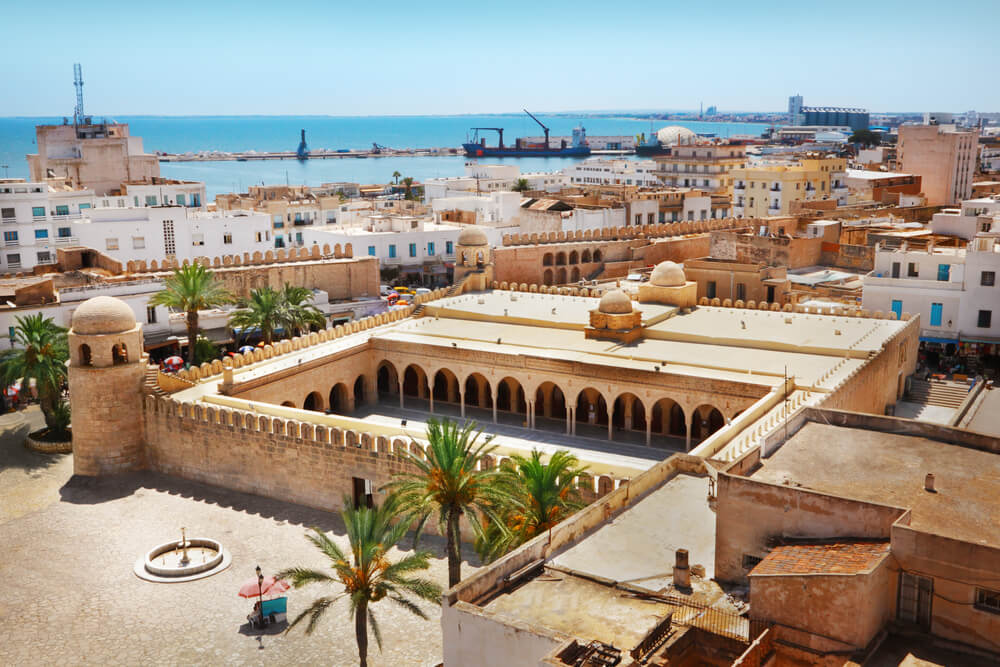
The Ribat of Sousse contains an inscription from the year 821, with impressive towers and walled construction. It’s a rather novel place, being an early Islamic city with a coastal kasbah (fortress) to protect it from piracy in the Med…
You may come across some very friendly ‘tour guides’ around the medina. I seem to recall ending up in a factory surrounded by thousands of Tunisian police jackets. Just be clear if you do not wish to pay for guiding services.
Backpacking Monastir
Monastir is an absolute gem of the Tunisian coast.
Pristine beaches reach far from the town, with ample sun to bask in. While home to a range of excellent holidaying provisions, Monastir is an ancient city. Its colossal ribat dates all the way back to the 9th century, vital in protecting the peninsula from oncoming enemy ships. Nowadays it’s just the occasional rogue pedalo from Sicily.
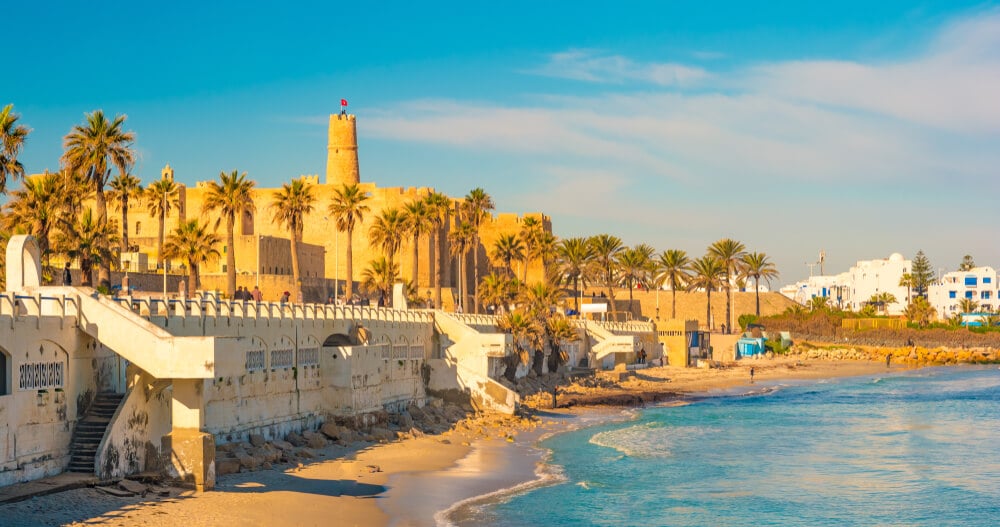
Lounge on the beach, sample the seafood, and stroll the marina, admiring the yachts. Make time for the Habib Burguiba Museum and the mighty mosaic collection there. And if you’ve ever seen Monty Python’s Life of Brian , some parts may seem familiar.
Backpacking Beja Governorate
I’ve called this section Beja Governorate, because while Beja itself is pretty interesting, it’s the surrounding areas within reach from the city that are especially special.
Dougga was inhabited across periods of Berber, Roman and Arab control. It’s an unbelievably well-preserved example of life long-gone; like visiting a great aunt and finding tins of beans from a previous century, but on steroids (the ancient artefacts, not your aunty). Explore the city ruins on foot, taking in the forum, baths, arches, marketplace and much, much more. You could try hitching; most visitors take a taxi from Beja or Tunis.
Beja Bridge is a much younger but still impressive structure, stretching between hilltops in the rolling countryside. Again, hitching here would definitely be an option, lying just 10km outside o Beja city. Half an hour northeast of Dougga, you’ll find Testour .

This small town, oozing Spanish influence, is set in the hills against a wonderful green backdrop. If you’re lucky enough to be here in October, you may just catch the annual Testour Pomegranate Festival, which has placed the town firmly on the pomegranate map (if such a thing exists).
A Side Note for Star Wars Fans…
I’ll be honest, sci-fi is not my forte. But when I showed this list to a mate who knows his ewoks from his lightsabers, he seemed suitably impressed.
Tunisia is home to many Star Wars filming locations that fans can visit, including:
- Mos Espa – Located near Tozeur, this is where the slave quarters in Episode I: The Phantom Menace were filmed.
- Ksar Ouled Soltane – This fortified granary near Tataouine was used as a backdrop for the slave quarters in Episode IV: A New Hope.
- Matmata – The underground Troglodyte homes of Matmata were used as the filming location for Luke Skywalker’s childhood home on the planet of ‘Tatooine’ in Episode IV. (The planet itself was inspired by the Southern city of ‘Tataouine’, its name adapted by Lucas.)
- Medenine – The town of Medenine served as the filming location for the exterior of the home of Anakin Skywalker in Episode I.
- Onk Jemal – This salt lake near Tozeur was used for the podrace scenes in Episode I. These locations offer fans a chance to immerse themselves in the world of the Star Wars saga and experience the unique Tunisian landscapes that contributed greatly to the films.
Getting Off the Beaten Path in Tunisia
In Tunisia, I would urge you to venture boldly, to places Google Maps’ Street View hasn’t made it to. Conveniently, this is practically everywhere.
As an underrated paradise for off the beaten path travel, getting off the tourist track is easy as. I’m convinced Tunisia would be an ideal country for hitchhiking around; walking through the countryside in Beja Governerate, I had all manner of vehicle (and animal) driver stop for a chat and offer a lift.

Bikes, tractors, cars, donkeys; getting off the beaten track is Tunisia is one mighty adventure.
You could try catching a train to a ‘random’ stop between well-known destinations, or scouting out cool places on longer louage journeys. People from more rural spots are likely to be super keen to show you their hometown, with unrivalled Tunisian hospitality.
Top Things to Do in Tunisia
Don’t visit Tunisia without checking off these must-sees…
1. Sleep in the Sahara!
Embark on a dreamy adventure into the heart of the Sahara . Spend an afternoon under the Saharan sun, or get stuck into a multi-day getaway. Sleep in a Bedouin-style tent or outside, under the stars. Whether you opt for a camel, jeep, quad bike or your own two feet, it’s bound to be an unforgettable foray amongst the dunes.
2. Visit The Amphithreatre of El Jem
It’s like the one in Rome but different.
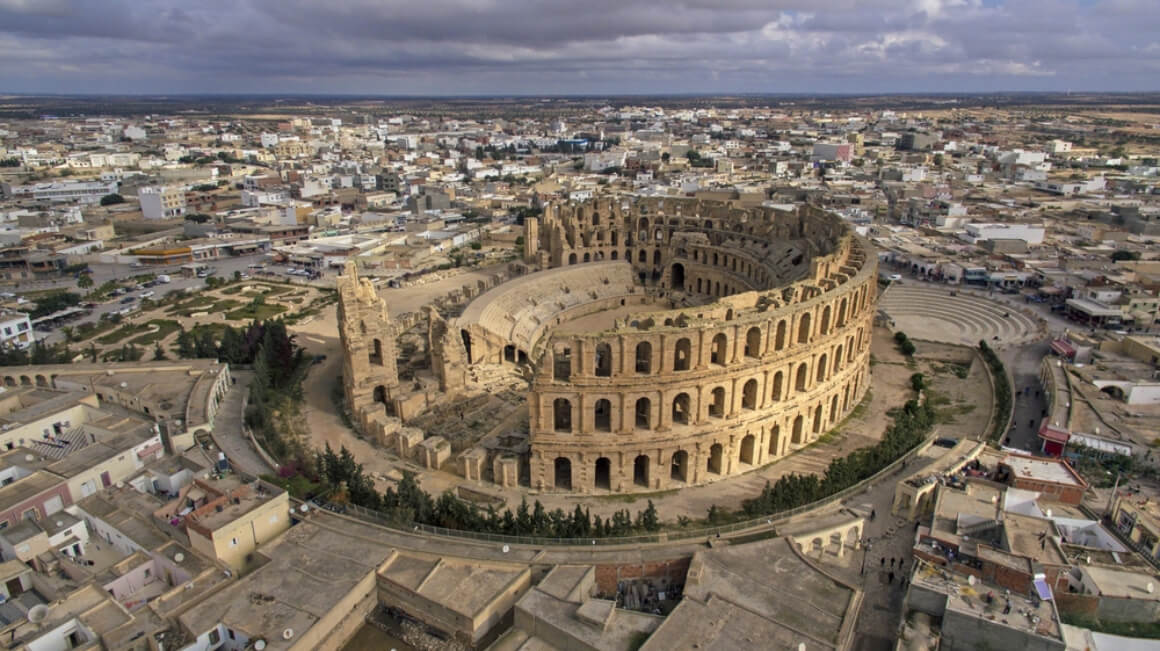
The Amphitheatre of El Jem is a sight to see. Marvel at the superbly preserved infrastructure that has stood the test of time, surviving seventeen centuries to be here today. It’s not hard to envisage scenes of immense scale and ferocity, when reading about the gladiators and animals battling here for the purpose of entertainment.
3. Dig into some Tunisian cuisine
Tuna. Harissa. Olives. Three inescapable tenets of Tunisian life. Whether or not these flavours tickle your fancy, you’re guaranteed to find some downright incredible dishes on any Tunisian menu. Sampling a range of local delicacies across the country is a pastime worthy of your hard-earned Dinar.
4. Wander aimlessly around Tunis Medina
Go and get lost. With over 700 monuments in the medina arena, you’re bound to stumble across something remarkable. The area is a composite of souks, mosques, mausoleums and more, guaranteed to satisfy your intrigue.
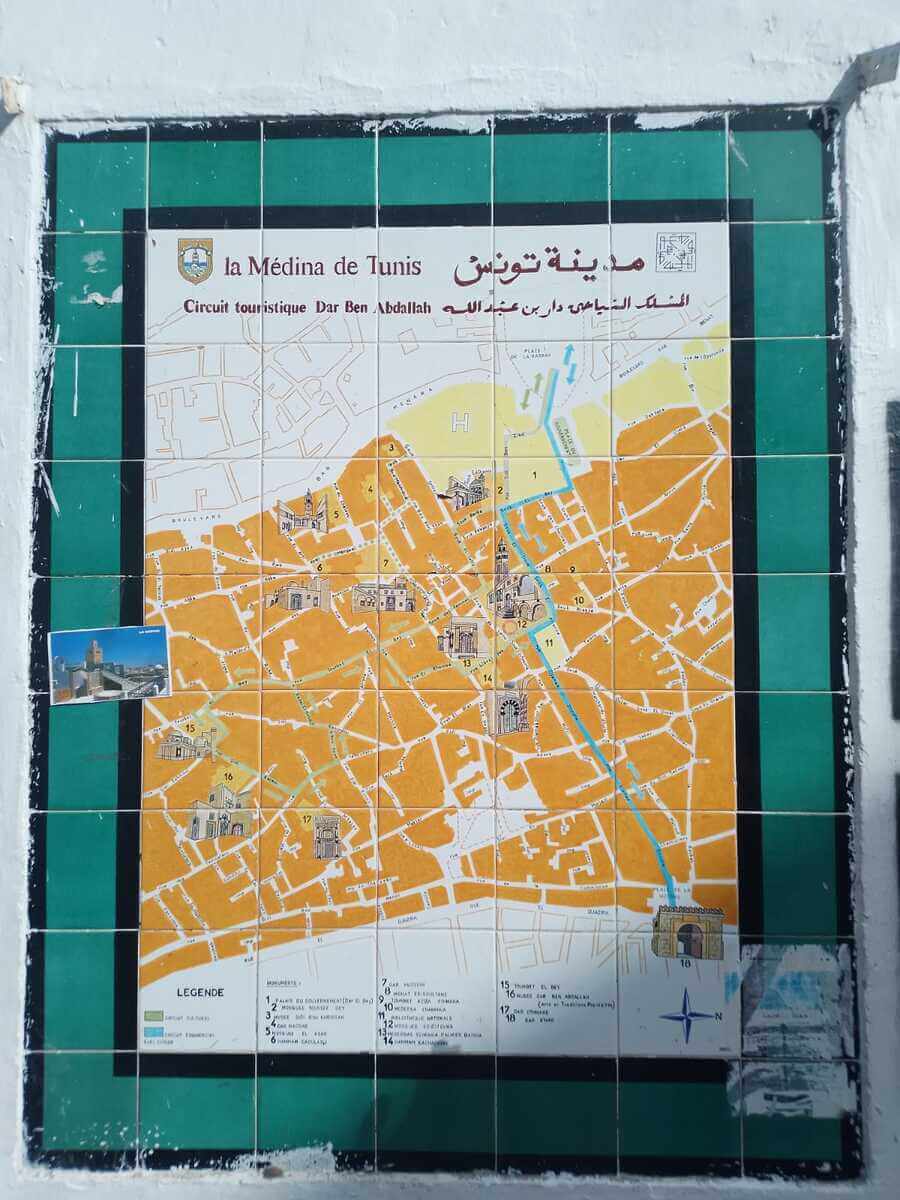
5. Lay eyes on the Great Mosque of Kairouan
Wandering and chatting your way through Kairouan, you naturally pick up on a sense of stature surrounding the place. The town is incredibly symbolic for Muslims, held as the fourth most holy city in Islam. For those that are unable to make it to Mecca itself, seven trips here is considered equivalent. Laying eyes on the Great Mosque is truly special.
6. Explore Sidi Bou Said and Carthage
In most cities, a day in the ‘suburbs’ may not sound too invigorating. Tunis is different.
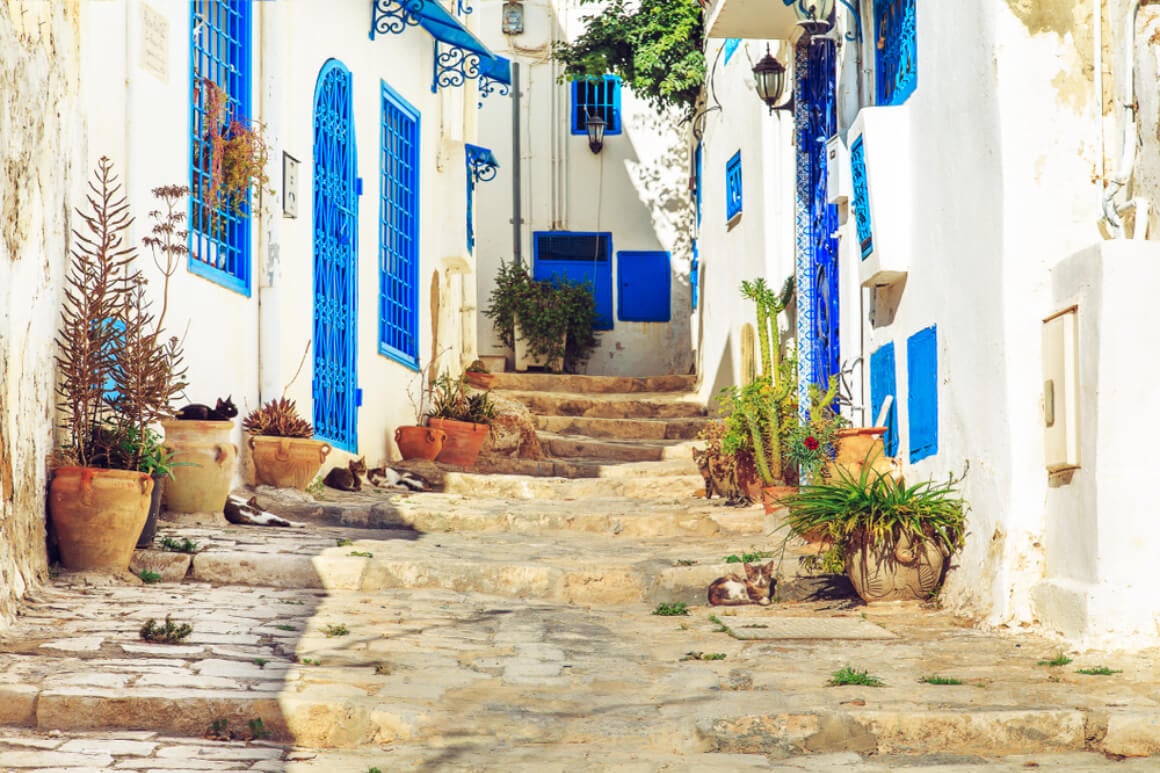
Sidi Bou Said is as picturesque as anywhere, a maze of blue and white houses, overlooking a tremendous beach for both paddleboarding and cotching. The ruins of Carthage are rather awesome and not to be missed. Take the TGM for a top day out.
Backpacker Accommodation in Tunisia
Now, when it comes to budget accommodation in Tunisia, there’s not a huge hostelling scene…
However, it is incredibly encouraging to see two BRAND NEW abodes appear on Hostelworld in early 2023 in Tunis and Djerba – here’s to hoping this is the start of a hostelling revolution in Tunisia.
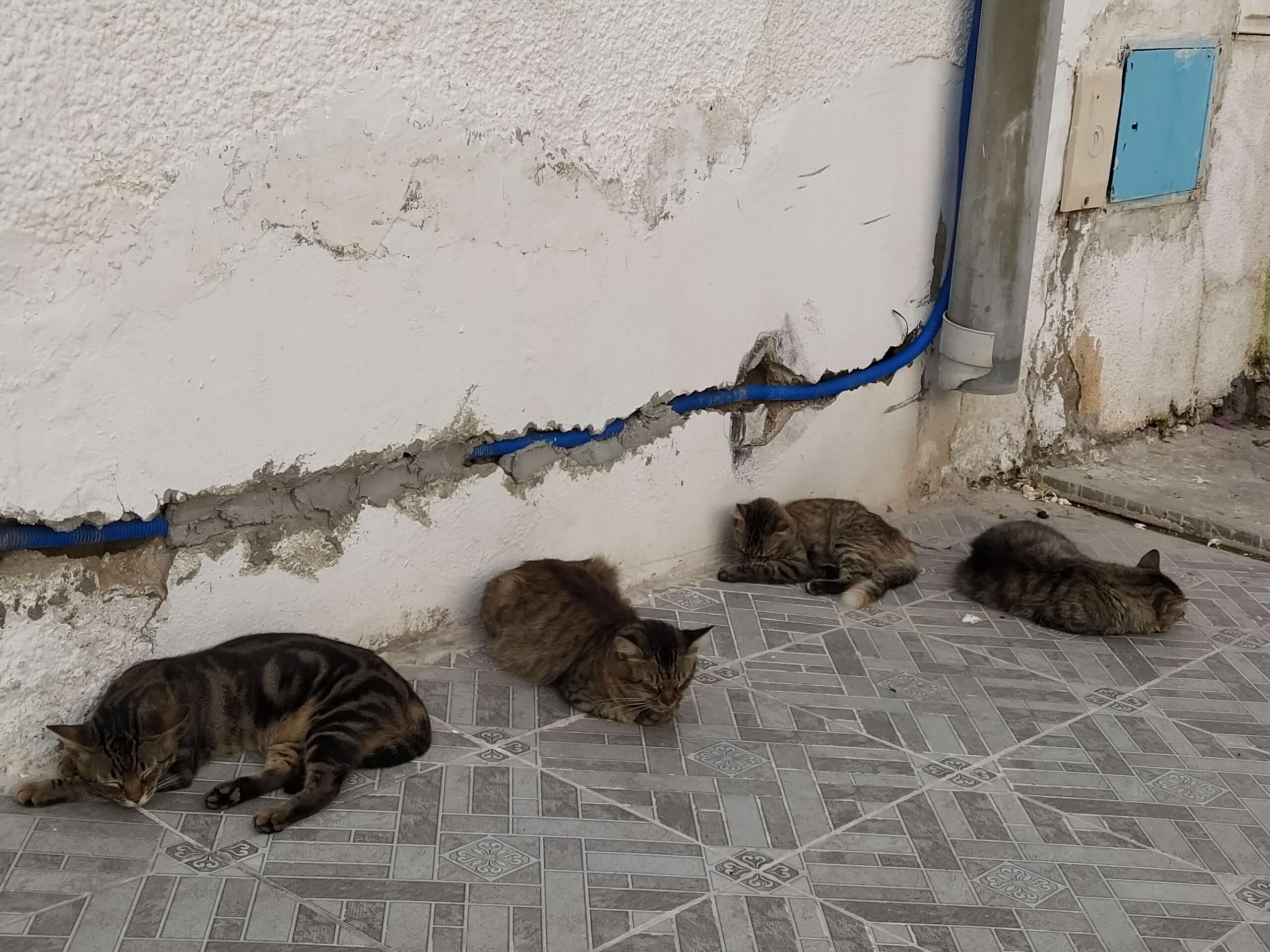
Outside of these places, you’ll most likely be scouting out a guesthouse of your liking, many of which are very affordable.
We’re not talking Asia cheap, but there are certainly options around for Broke Backpackers.
And for the occasional ‘cheat night’, upping the budget slightly will unlock some magnificent places to stay…
Tunisia Backpacking Costs
Tunisia is an underrated gem for cheap and incredible adventures !
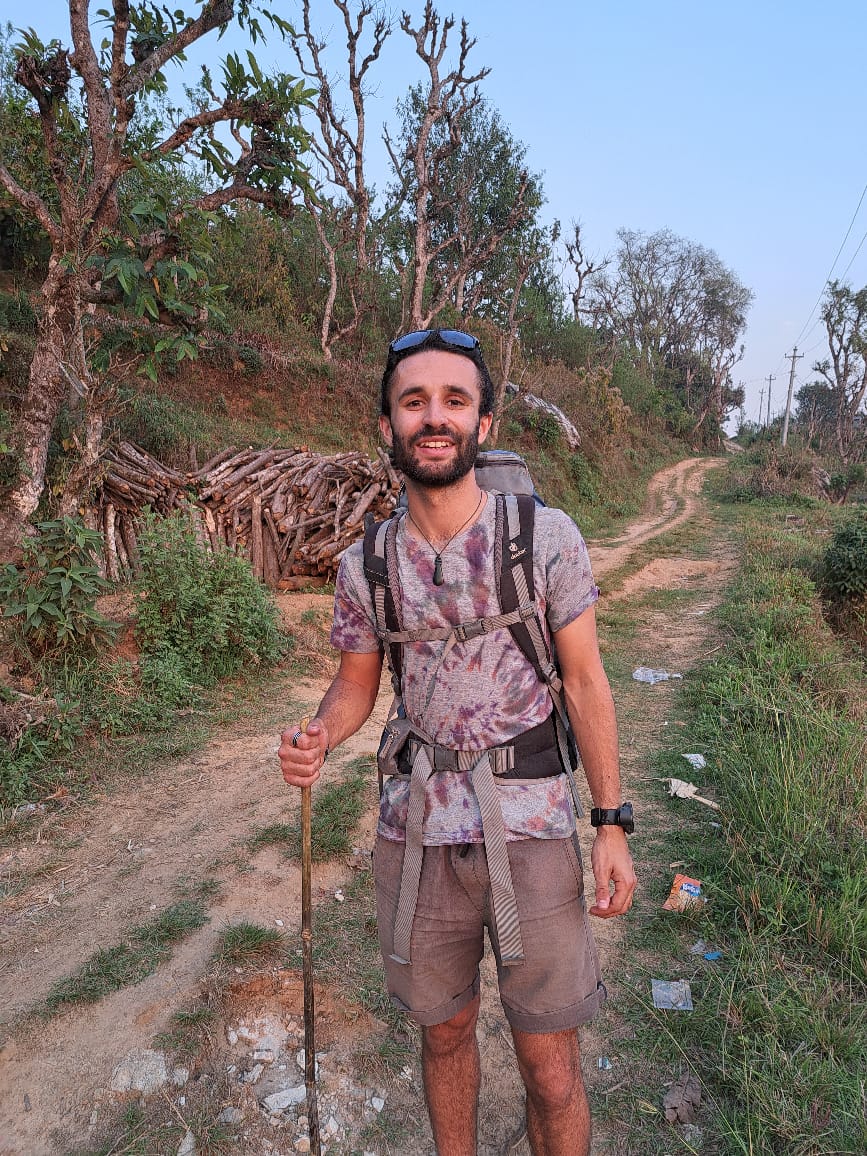
Particularly when you consider its proximity to Western Europe, costs for all backpacker basics are very reasonable. If you know where to look, there is some splendid food available for super low prices, and taking the louage won’t set you back a great deal.
Budget accommodation may sometimes appear elusive, but there are very cheap options around. Seek, and you shall find.
Tickets to main attractions are also extremely good value. You can be amongst some of the most incredible archaeological sites in the world, for less than the price of a Starbucks.
If you’re ever feeling like ‘splashing out’, sampling an upmarket eating establishment will absolutely not break the bank and there are some pretty fancy options.
Plus, if you want to go the whole hog and throw in some hitchhiking, couchsurfing or camping, you really could explore Tunisia on a shoestring budget…
A Daily Budget in Tunisia
Money in tunisia.
To get your first plate of cous cous, you’re going to need to get your hands on some Tunisian Dinar. At the moment, one Dinar is worth approximately 3 US dollars.
You may see the abbreviation DT, occasionally TD, or TND. Same thing; these are all references to the local dinero.
For some prices, particularly on the low end, you’ll see a number followed by several zeros. This is just to show the ‘milim’ (thousandth) denomination for extra precision. Don’t panic, that chapati omelette is still an absolute bargain.
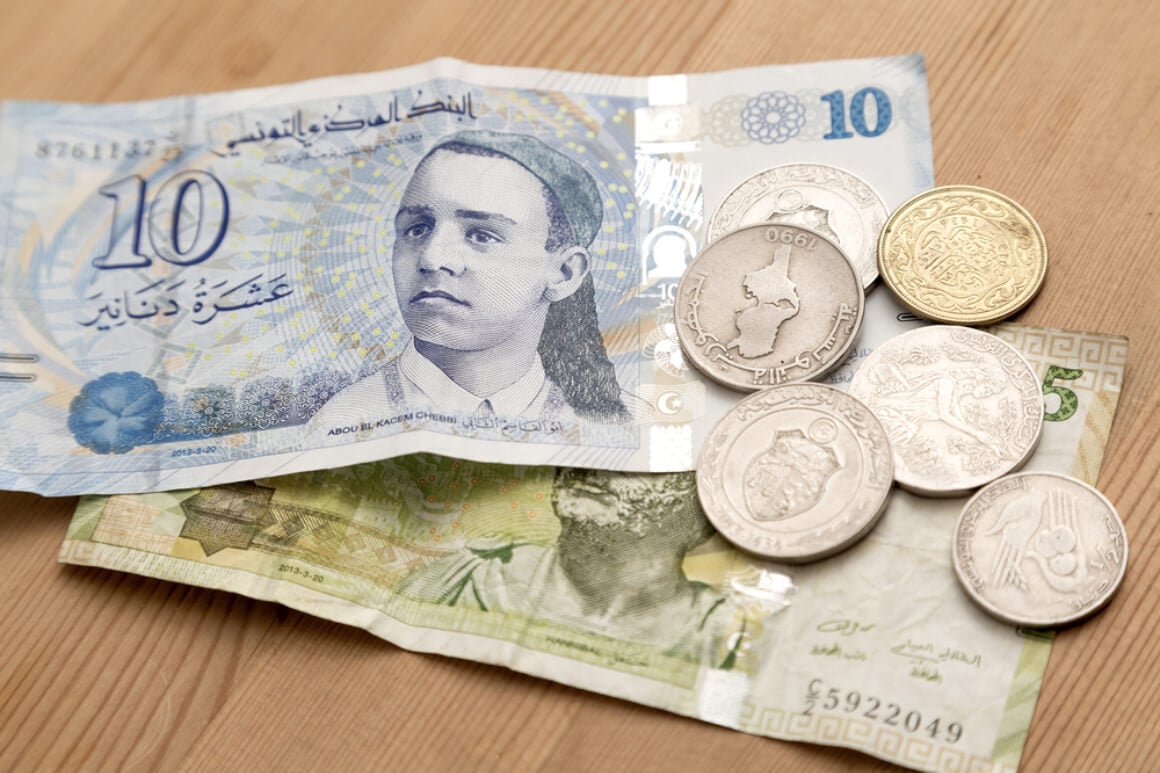
There’s also a coin in circulation with THIRTEEN flat sides. As far as I can tell, only the Czech Republic can claim to match it. Some excellent coinage to be found in Tunisia.
You can’t take Dinar out of the country though, so enjoy examining them while you can.
ATMs are pretty easy to find, but charge a few dollars for withdrawal, so it’s best to take out reasonably large chunks at a time. Otherwise, you can exchange currencies without much hassle (US dollars being the most simple).
For all matters of finance and accounting on the road, The Broke Backpacker strongly recommends Wise – The Artist Formerly Known as Transferwise! Our favourite online platform for holding funds, transferring money, and even paying for goods, Wise is a 100% FREE platform with considerably lower fees than Paypal or traditional banks. But the real question is… is it better than Western Union? Yes, it most certainly is.
Travel Tips – Tunisia on a Budget
As seen in the daily budget above, you could spend quite a hefty sum in Tunisia, living a life of absolute luxury.
Rest assured, however: with a few tips and trips, you’ll be able to keep expenses very low if that’s a priority, and have an unforgettable adventure.
In fact, I strongly believe that following any of these, at least on occasion, will lead to a much richer travel experience than splashing out on fancy hotels every night.
- Eat local street food. Street food is incredibly affordable if you know where to look. We’re talking lunch for less than a dollar. Rest assured, you won’t being going hungry. Seek out the likes of chapati omelette, leblebi, and brika (more on these to follow).
- Hitchhiking. Don’t get me wrong, the louages, buses and trains are very well priced. But for an extra dose of both adventure and savings, Tunisia would be awesome for thumbing lifts. I recall turning down many offers because I was enjoying walking. It certainly seemed catching a ride wouldn’t take much waiting in a lot of places.
- Couchsurfing. There are no less than 60,000 hosts listed on Couchsurfing within Tunisia! You’re likely to make new mates and be treated extremely well as a guest, while keeping costs down.
- Workaway. There are some beaut looking Workaways in Tunisia. Most involve helping out for a few hours a day in exchange for a bed and board, while garnering unique insight into everyday life in Tunisia.
Why Should You Travel to Tunisia with a Water Bottle?
As travellers, we have a joint responsibility to reduce the environmental impact of our excursions, and plastic waste is one of the biggest problems facing countries across the globe.
While local water quality has improved greatly in Tunisia, for peace of mind, travelling with a water filter is a wise move. There’s no better option than the Grayl Geopress: this water bottle and filter system removes all manner of threat, including viruses and heavy metals – no mean feat.
It’ll last for years, reduce plastic waste, and save you money. The Grayl Geopress is a sound investment for any intrepid adventurer.

Drink water from ANYWHERE. The Grayl Geopress is the worlds leading filtered water bottle protecting you from all manner of waterborne nasties.
Single-use plastic bottles are a MASSIVE threat to marine life. Be a part of the solution and travel with a filter water bottle. Save money and the environment!
We’ve tested the Geopress rigorously from the icy heights of Pakistan to the tropical jungles of Bali, and can confirm: it’s the best water bottle you’ll ever buy!
Best Time to Travel to Tunisia
Beach lovers are in for a treat: there’s an abundance of sunrays to be sought in Tunisia, and swimmable water temperatures for most of the year. Just don’t accidentally backstroke into Libya.
The best times for a Tunisia trip are probably around the fringes of summer. Spring and early Autumn mean the North is still very pleasantly warm and beach days are comfy, while the desert isn’t stiflingly hot, like in the peak of Summer.
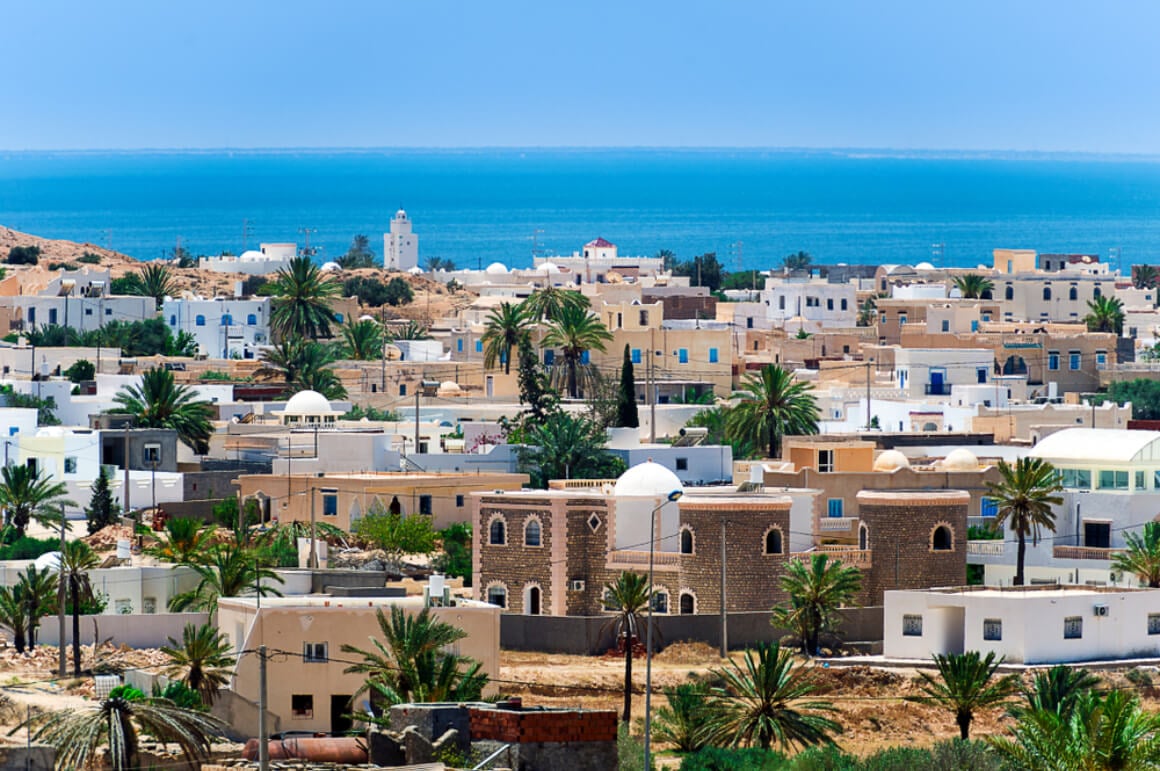
In fact, most desert excursions won’t run from June to September; the heat around this time does not sound remotely enjoyable. You’d be sweating like ( insert favourite unacceptable innuendo). Plan accordingly to fulfil any Saharan dreams.
The months from October to May inclusive are optimal for Tunisia trips, if you want to have all options on the table during your travels.
What to Pack for Tunisia
You won’t need to add anything too out of the ordinary to your backpacking packing list .
On the clothes front, just pack some stuff that’s both loose and cool (temperature-wise; I’m not here to judge on fashion.) Tunisia is liberal compared to other Arabic nations, but it’s a good idea to make an effort to dress more conservatively – outside of Tunis especially – with some long sleeves and trousers.
Also throw in a warm layer or two for a night amongst the Saharan zephyr.
As always, investing in some trusty gear will improve life on every backpacking trip, and last ages. Here’s a pick of the bunch:

Travel Security Belt
This is a regular looking belt with a concealed pocket on the inside – you can hide up to twenty notes inside and wear it through airport scanners without it setting them off.

Microfiber Towel
Hostel towels are scummy and take forever to dry. Microfibre towels dry quickly, are compact, lightweight, and can be used as a blanket or yoga mat if need be.

Petzl Actik Core Headlamp
A decent head torch could save your life. If you want to explore caves, unlit temples, or simply find your way to the bathroom during a blackout, a headtorch is a must.

‘Monopoly Deal’
Forget about Poker! Monopoly Deal is the single best travel card game that we have ever played. Works with 2-5 players and guarantees happy days.
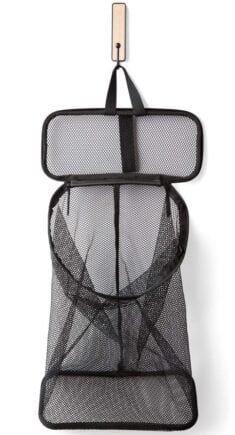
Hanging Laundry Bag
Trust us, this is an absolute game changer. Super compact, a hanging mesh laundry bag stops your dirty clothes from stinking, you don’t know how much you need one of these… so just get it, thank us later.
Staying Safe in Tunisia
Yes – there are some regions best left alone – but on the whole, Tunisia really feels safe to travel.
I consistently felt the Tunisian people were always there to help, and never felt at risk.
Tunisia was the catalyst for the emergence of the Arab Spring in 2011, and heralded as a relative success story from this period of immense change.
However, 2015 saw three tragic incidents occur, when terrorist shootings in Sousse and Tunis led to a significant loss of life. Since then, much work has been done on improving safety and security, and thankfully nothing like the tragedy of 2015 has occurred in the aftermath.
It’s important to contextualize terrorism risk. Even countries like the United Kingdom have not escaped terrible incidents over the last decade. Personally, I believe Tunisia is a safe country to travel to, and the overwhelming majority of trips to Tunisia will be filled with kindness and a very warm welcome.
Be a bit sensible and follow your usual travel safety tips , though: the borders with Libya and Algeria should be avoided, as should the vicinity of any protests.
Sex, Drugs, and Rock ‘n’ Roll in Tunisia
Tunisia may not be the first place that springs to mind when you think of wild nights out.
While a relatively new development, there is an excellent party scene in Tunis. Many young Tunisians like to go out on the toon. My mate even found her way to a desert rave, which looked highly exuberant…
Being a predominantly Muslim country, most people don’t consume alcohol. It is available for sure, but there are restrictions, and we should make efforts to be cognizant of cultural norms. As such, alcohol sales are restricted on Fridays in most places, and during Ramadan.
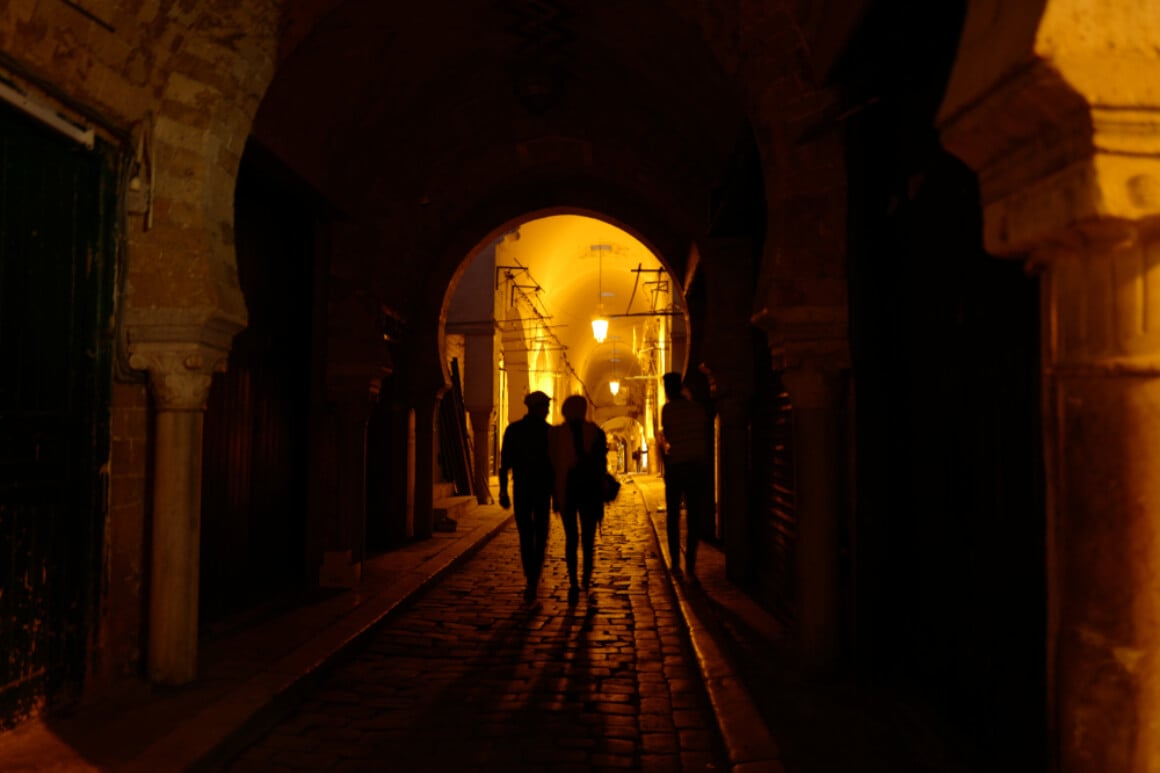
Cannabis is the most commonly used drug, but laws are tight – as of a few years ago, something like a quarter of all prisoners were being locked up for drug offences. Personally, I’d avoid the drug scene while in Tunisia, but if you do decide to risk it great caution should be urged.
Tunisia is forging an accommodating compromise, whereby tourists and locals can drink their way through the witching hour if they so please, with a tea or cool lager.
But just remember to be respectful . Tunisia is a very welcoming country, and really quite liberal compared to other Arabic societies, so let loose and have a blast with the locals, but be mindful in your jollification…
Getting Insured BEFORE Visiting Tunisia
Now, it may not be the most thrilling part of trip planning, but getting properly insured BEFORE travelling is a wise addition to any backpacking to-do list.
ALWAYS sort out your backpacker insurance before your trip. There’s plenty to choose from in that department, but a good place to start is Safety Wing .
They offer month-to-month payments, no lock-in contracts, and require absolutely no itineraries: that’s the exact kind of insurance long-term travellers and digital nomads need.

SafetyWing is cheap, easy, and admin-free: just sign up lickety-split so you can get back to it!
Click the button below to learn more about SafetyWing’s setup or read our insider review for the full tasty scoop.
How to Get Into Tunisia
Tunisia is very well connected by air, with flights running every day from across Europe and beyond. Most flights will go into Tunis Carthage airport, but there are also options to fly directly into the likes of Monastir, Djerba and Sfax.
Another great option is to sail from Europe across to Tunis – there are several options from Italy (Palermo, Genoa, and Salerno) and France, with 5 weekly crossings departing from Marseille.
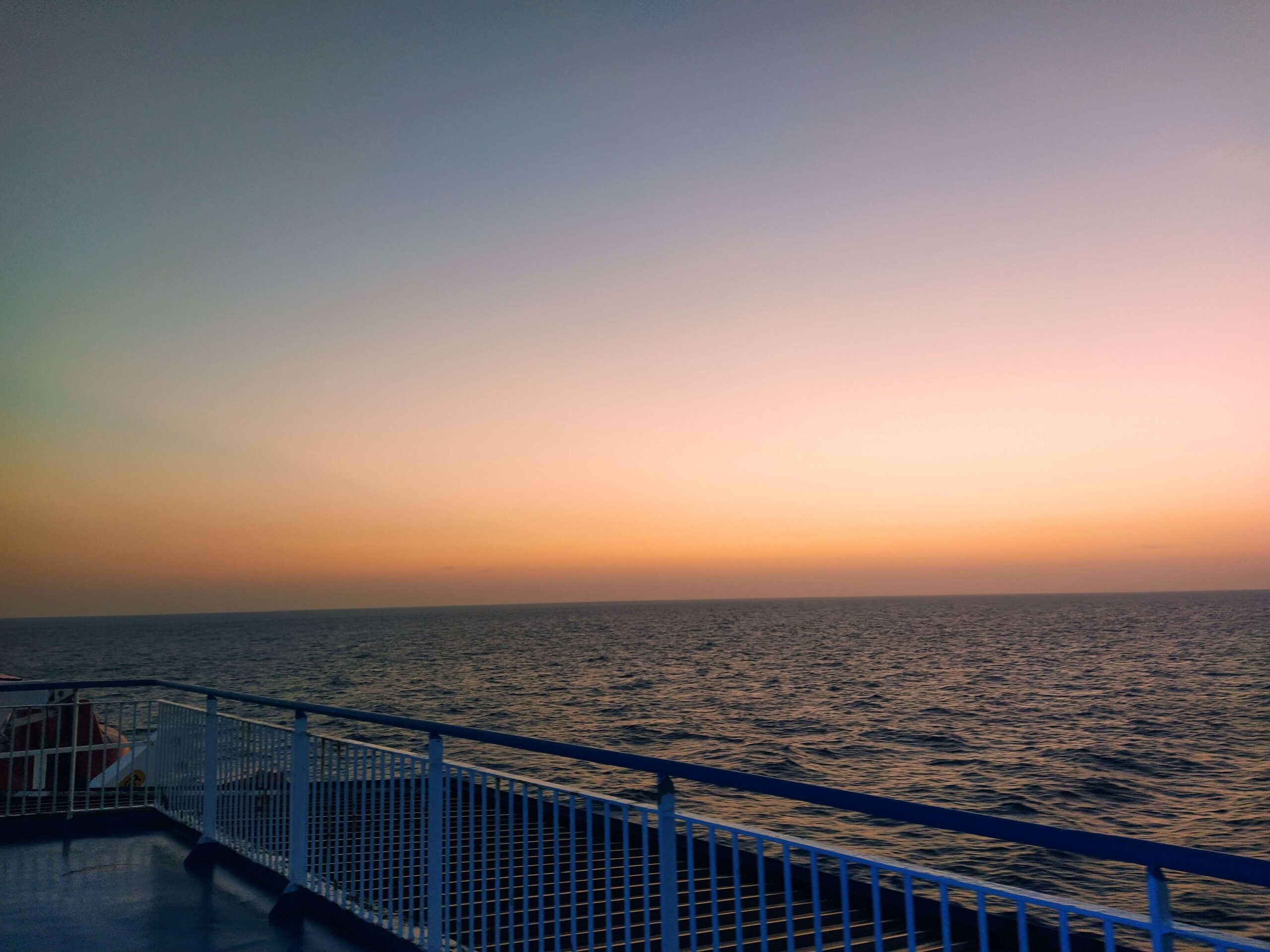
Don’t expect a luxury cruise liner, but voyage by boat is a very exciting way to arrive in North Africa. It’s affordable – especially for budget backpackers who don’t fork out on a cabin – and tickets can be booked online.
(One word of advice – don’t turn up late for check-in. To no avail, a good-natured Tunisian policeman called the ferry captain, who replied: “ you know how you have a Plan A and a Plan B? Well, it’s now time for Plan B.” Next boat leaves Wednesday…)
Entry Requirements for Tunisia
More dreamy news – travellers from most countries can receive a visa on arrival, free of charge!
Check your government’s travel guidance for relevant details, but for lots of travellers, the Tunisia visa on arrival is valid for three months!
The government also recently announced the removal of all Covid-19- related requirements, such as proof of vaccination or recent testing.
Apparently going through passport control at Tunis Airport isn’t the most pleasant experience, but stay strong. It’ll all be worth it.
Officially, you need to provide an address for your initial stay on arrival, but it’s luck of the draw whether this is questioned. I’d just recommend having the address of a hotel lined up to provide if requested.

Get 15% OFF when you book through our link — and support the site you love so dearly 😉
Booking.com is quickly becoming our go-to for accommodation. From cheap hostels to stylish homestays and nice hotels, they’ve got it all!
How to Get Around Tunisia
Trains, camels, quad bikes, to name a few. Tunisia has some brilliant transportation, the shining star of which is undoubtedly the louage. Read on for the low-down on how to plan your trip …
While journeys may take a smidgen longer than planned, and/or be a bit toasty, the locals in Tunisia will make sure you get to wherever you’re heading.
Travelling By Louage In Tunisia
I genuinely loved these. So bloody much.
In most Tunisian towns and cities, you’ll find a building or area, full of minivans. These are louage stations.
Every day, hundreds of these vans ferry people back and forth between settlements, forming a network that links nearly all areas of the country together.

You turn up at the station and buy a ticket, at the ticket counter. (In smaller places, it may be an individual roaming between vehicles, or in the louage itself.) The big stations may appear rather Byzantine, but there are signs showing the destination of each louage, and you’ll be helped on your merry way.
One thing to note: the driver will wait until all seats on the van are filled before setting off. This is usually pretty quick, but can take a while on routes-less-travelled.
On longer forays across the country, you’ll likely have a break for some grub. These pitstops in potentially more remote places were super cool experiences. When travelling with Tunisians, friendliness, warmth and good food abounds.
As you’d expect, not all towns are connected directly by louage. For example, to travel between Kairouan and El Jem, one must change first in Sousse. Ask around at the station for optimal routing choices.
Travelling By Train In Tunisia
Train travel in Tunisia is superb.
You can see the landscape changing in real-time as you venture down the coast, and tickets are good value.
In Tunis, the ‘TGM’ runs from the city centre to La Marsa, with stops at places like Carthage and Sidi Bou Said en route. This is a fantastic way to get around the capital, and makes the suburbs easily accessible for day trips. Tickets are extremely cheap, and come in the form of a little blue paper slip.
It may be useful to visualise your travel options in Tunisia, so click here for a map of the railway network run by SNCFT, and here for the timetables of scheduled departures. Advance warning, however: do not expect Japanese-style punctuality. On longer journeys in particular, you may end up hanging around for a while with delays, but just settle in with some snacks and watch the world go by.
And if delays do cause you any difficulty, locals will help you out. For example, arriving late in Sousse, a gentleman asked where I was headed. He insisted I share his taxi, which he rerouted for a drop-off at some budget accommodation, and refused point blank to accept any monetary contribution for the trouble. True hospitality.
During your Tunisia trip, taking to the railways at least once is a must.
Onwards Travel from Tunisia
Unfortunately, onward travel by land from Tunisia is rather limited by its proximity to unstable neighbouring Libya…
Tunisia’s only other border, shared with Algeria, has reopened since Covid, but all travel to this area is advised against by most governments.
If you’d like to continue on an African Odyssey, there are reasonably cheap flight options available across the North, to Morocco or Egypt, perhaps Mauritania or even beyond.
- Backpacking Egypt
- Backpacking Ethiopia
- Backpacking South Africa
- Backpacking Italy
Working and Volunteering in Tunisia
Volunteering is a brilliant way to have a positive impact while on your travels and immerse yourself in real Tunisian life. You’re likely to make special connections, help drive real change, and save money. Helping out on a locally-led project can be a real win-win situation for both volunteers and hosts.

Worldpackers: connecting travellers with meaningful travel experiences.

A new country, a new contract, a new piece of plastic – booooring. Instead, buy an eSIM!
An eSIM works just like an app: you buy it, you download it, and BOOM! You’re connected the minute you land. It’s that easy.
Is your phone eSIM ready? Read about how e-Sims work or click below to see one of the top eSIM providers on the market and ditch the plastic .
Tunisian Culture
Tunisian culture is a unique intermingling of Mediterranean, Arabic, and African influences. Being predominantly Muslim, Islam plays a large role in everyday Tunisian life, as does the value of family.
The region, originally inhabited by Berber tribes, has had parts ruled by Phoenicians, Romans, Arabs, Ottomans and French, to name a few. It’s been home to cities of trade for vast empires, numerous bloody wars, and was mainly Christian for centuries before transitioning towards a Muslim society. The result today is an incredibly rich cultural landscape.
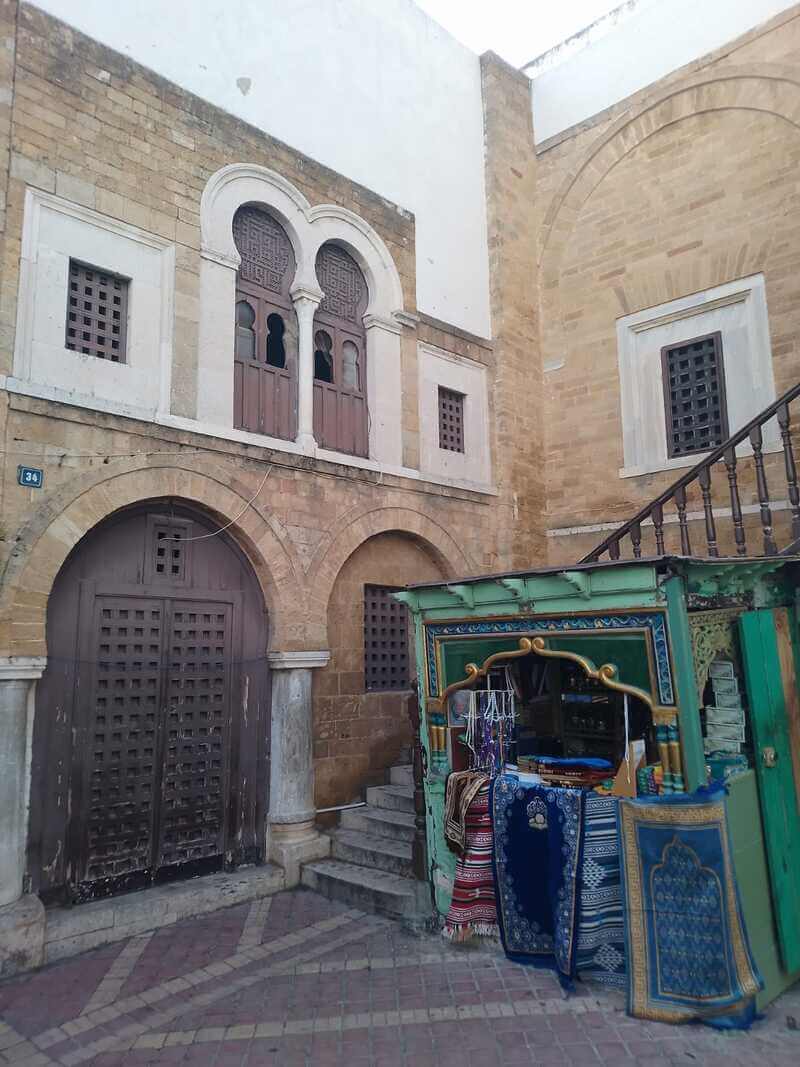
You’ll find an eclectic range of sights to see, food to sample, and people to learn from. Many of the ruins in Tunisia beautifully showcase what life might have been like in a civilisation so different from our own. The best examples are in Carthage and Dougga, the latter a supremely preserved settlement from Berber, Roman and Punic times.
In terms of cuisine, Tunisians proudly hang on to the spicy legacy of their Arab influence. Seriously, you may want to ask them to go easy on the harissa. Seriously. That stuff can cause damage.
By wandering around practically anywhere in Tunisia, you can sense the history of the place. The large mosaics, intricate weavings on carpets, and decorative front doors all point to its illustrious past. In addition, Tunisian life is underpinned by a culture of hospitality and goodwill, that you’re bound to uncover.
Simply get stuck in: delve into the history, artwork, poetry and music. There’s a quite magical heritage to be found practically everywhere.
Useful Travel Phrases for Tunisia
Learning a bit of the language (Tunisian Arabic) can be useful before your trip…
Hello = A – sleh – ma
Goodbye = bi – sle – ma
How are you? = le – be -ss?
Good, thanks! = le – be – ss!
Yes = ay / naam
Please = aish – ik
Thank you = aish – ik
Sorry = asif (from male) asifa (from female)
No problem = mush mushkil
I would like = n’ Hib
I would not like = ma n’ Hib-sh
Can I have___ = mumkin ___
Where is ___? = Way-n ___?
What to Eat in Tunisia

Can’t lie, I’m usually not a huge fan of two-thirds of that set. But somehow, in Tunisia, it just works. There’s some sensational grub to dig into.
Of course, this ingredient list isn’t exhaustive, but you’ll find these quite a lot throughout the Tunisian culinary scene. Harissa is a paste, blended from a range of spices and herbs including chilli, garlic and cumin,. UNESCO names it as part of Tunisia’s ‘Intangible Cultural Heritage’: it’s very, very popular throughout the land.
Like so many other things in Tunisia, the cuisine has been sculpted by numerous cultural influences from its history. The main features, however, are hearty stews , some grilled meats and vegetables, and a healthy dose of spices .
Do your insides a favour, and ask for a modest allocation of harissa for your first outing, and work your way up from there. Sadly, I could never hack it like the Tunisians, but it was still bloody delicious.
Street food stalls are a top place to investigate the local delicacies, and are super cheap. Given the variation in climate and culture, Tunisian food can change greatly between regions, so asking locally for pointers in the right direction on the menu can be fruitful.
Look out for some of these popular options below which are certainly worth sampling, but don’t be afraid to get stuck into some untranslatable soup or seemingly improbable flavour combination. It may well become a firm favourite.
Popular Dishes in Tunisia
- Cous-cous : A Tunisian and North African staple, made of steamed semolina. Usually served with stewed meat, vegetables (and of course, some harissa.)
- Lablabi : Another staple. Chickpea stew, heavy on the garlic and cumin, topped with egg and bread. Can be an acquired taste.
- Kafteji : A hearty dish packed with fried vegetables, sometimes topped with fried egg and/or merguez (Maghrebi lamb sausage). And harissa. Obviously.
- Brik : Very popular, often an appetiser. Thin pastry encasing some kind of filling in a triangular formation. Cheese, egg, meat, tuna. It varies.
- Ojja : This is a top, top feed. Hearty, thick, soupy, tomato-based dish with eggs and vegetables. Often served with merguez. And harissa.
- Chapati Omelette : Chapati, but not as you know it. Thick, round pieces of bread, served warm and fresh, hugging an omelette. IMHO, the best cheap lunch in the land.
A Brief History of Tunisia
I’ll keep it brief, but this section could have been encyclopaedically long. With a rich history that spans thousands of years, there’s a lot to be uncovered.
This land has seen the rise and fall of whopping great empires, and its history is evident in its diversity.
Rewind a long way.
Tunisia is inhabited by Berber tribes, but later becomes part of the Phoenician Empire, a powerful city-state to rival Rome.
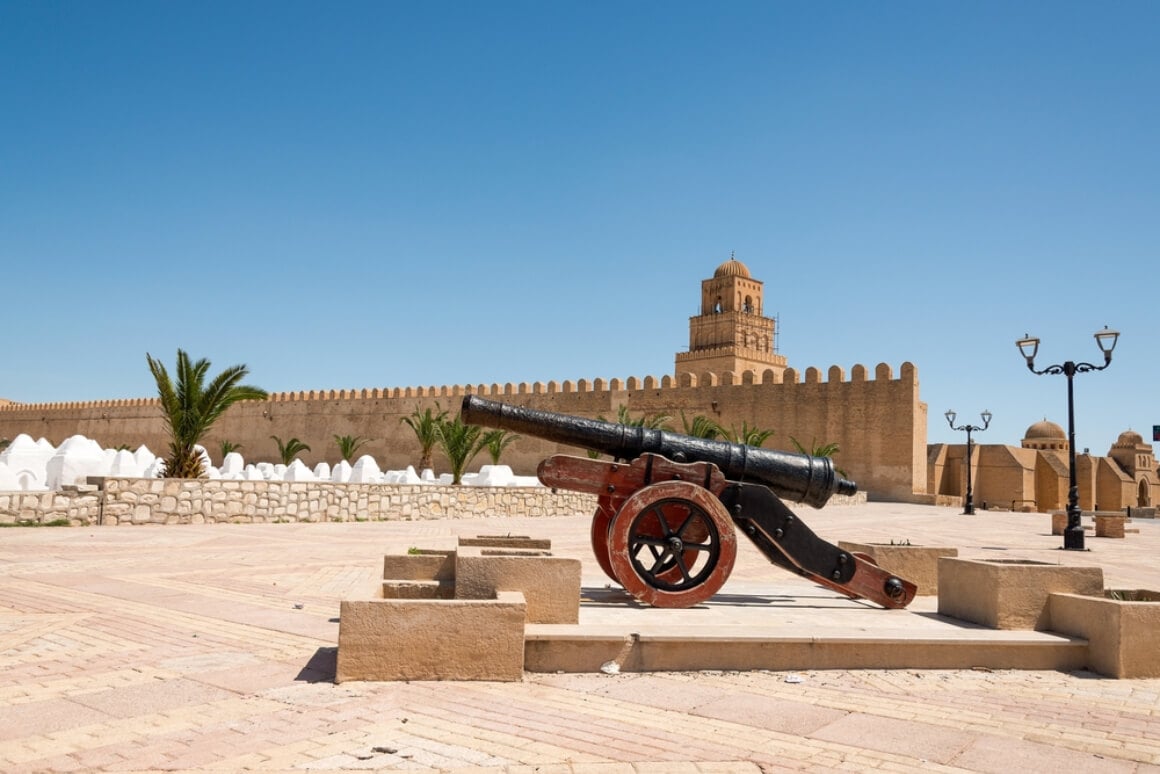
During the Roman era, Tunisia flourished as a province of the Empire. The grandeur of Roman ambition is in full view at the ruins of Dougga and El Jem’s imposing colosseum.
In the 7th century, Tunisia came under Arab rule, and Islam became the dominant religion. The medinas of cities like Tunis, Sousse, and Kairouan boast beautiful examples of Islamic architecture, such as the Great Mosque of Kairouan, one of the oldest mosques in Africa.
In the Middle Ages, Tunisia was a centre of learning and trade. It housed influences from various cultures, including Arab, Berber, Ottoman (whose empire was at the reigns for a few hundred years) and Andalusian. The medina of Tunis showcases the fusion of different architectural styles, with narrow alleys and intricately designed doors.
Next to arrive were the French, who conquered in the late 1800s. Tunisia gained its independence from France in 1956 and has since developed a unique modern culture, while preserving its rich history. (As a result, a great deal of the population speak French, so if you can remember any from school days, you’ll be cruising). The markets are known for their souks, where you can find traditional crafts and spices.
The Arab Spring
The modern history is no less dramatic. The Tunisian Revolution started in 2011 following street vendor Mohamed Bouazizi tragically setting himself alight, while standing in traffic outside the local governor’s office.
Protests against widespread corruption and inequality grew into a historic uprising. The revolution led to the overthrow of the authoritarian regime and president, sparked similar protests in other Arab countries, and is considered a catalyst for the Arab Spring.
Chatting to Tunisians throughout the country, you will get a real sense of the depth and variety of history that contributes to their completely unique identity.

Things go wrong on the road ALL THE TIME. Be prepared for what life throws at you.
Buy an AMK Travel Medical Kit before you head out on your next adventure – don’t be daft!
FAQs About Backpacking in Tunisia
Is tunisia safe to visit .
On the whole, Tunisia DOES feel safe to travel. An overwhelming proportion of people are extremely welcoming. Like everywhere, there are some areas that feel ever so slightly sketchy. The taxi ranks of the ferry port at night may qualify. Don’t be put off. Just be aware. Tourism in Tunisia saw an understandable decline around 2015, when three tragic incidents occurred in Sousse and Tunis. Since then, things have improved , and the vast, vast majority of visits are trouble-free . It is wise to avoid the borders with Algeria and Libya (as per most governments’ advice), and not to get stuck into any protests you come across. On the whole, I would be confident that travellers heading to Tunisia will be looked after and embraced with open arms.
Is Travelling in Tunisia Cheap?
Ah. The Office for Budget Responsibility has arrived. In short, yes. In Tunisia, absolute bargains are plentiful. There’s some really tasty value to be found in the food department, especially if you stick to local dishes and keep a lid on the beer consumption ( most of the time, a Gammarth night out is worth an exception). Follow the tips listed in this guide and Tunisia will remain an extremely affordable travel destination on the proverbial European doorstep.
When Should I Visit Tunisia?
A trip to Tunisia is worthy of your time, any month of the year. BUT, for desert dreamers, the summer is worth avoiding: most Saharan trips won’t be running from June to August. Therefore, we recommend September to May as optimal . Be aware when booking those tickets.
Final Advice Before Visiting Tunisia
On the road, I’ve met a handful of other travellers who found themselves in Tunisia. They all agreed: it’s a criminally underrated destination, made to measure for budget adventuring.
Remember to be respectful on your exploration! In visiting North Africa, we’re fortunate to be welcomed and experience a culture that may be very different from life back home.
Travelling amidst things like Ramadan requires an adequate dose of cultural sensitivity; in fact, Eid celebrations induce a superb atmosphere to get stuck into. Rest assured; if any questions pop up, just ask. Exploring with a positive attitude soon be repaid with great kindness and warmth.
You may go for the desert and the beach, but want to return for the people. The hospitality on display throughout Tunisia is truly special.
If you’re somehow still on the fence, honestly, just do it!
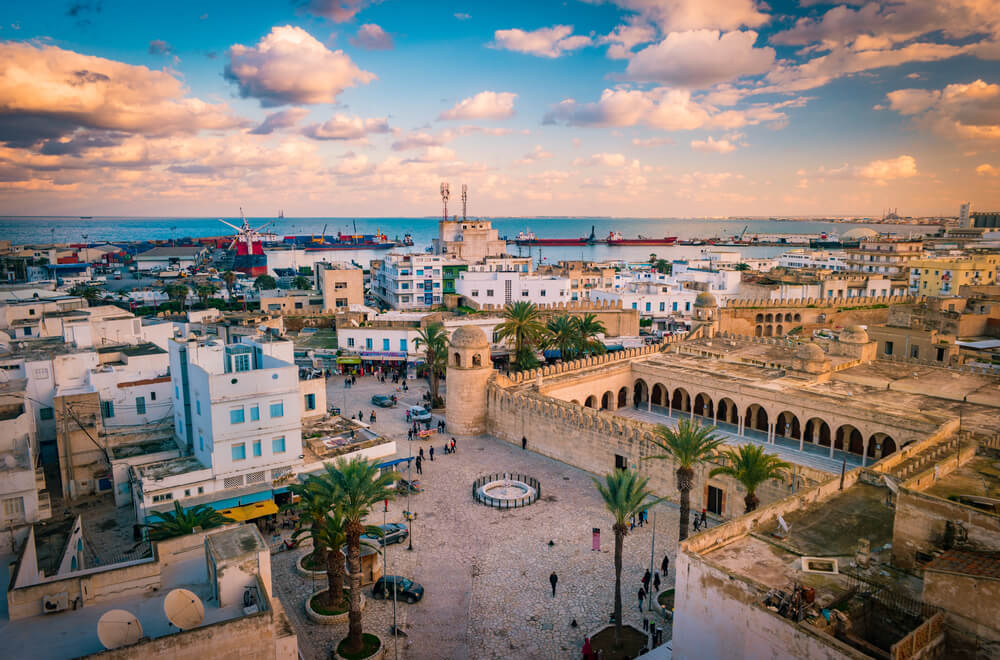
And for transparency’s sake, please know that some of the links in our content are affiliate links . That means that if you book your accommodation, buy your gear, or sort your insurance through our link, we earn a small commission (at no extra cost to you). That said, we only link to the gear we trust and never recommend services we don’t believe are up to scratch. Again, thank you!
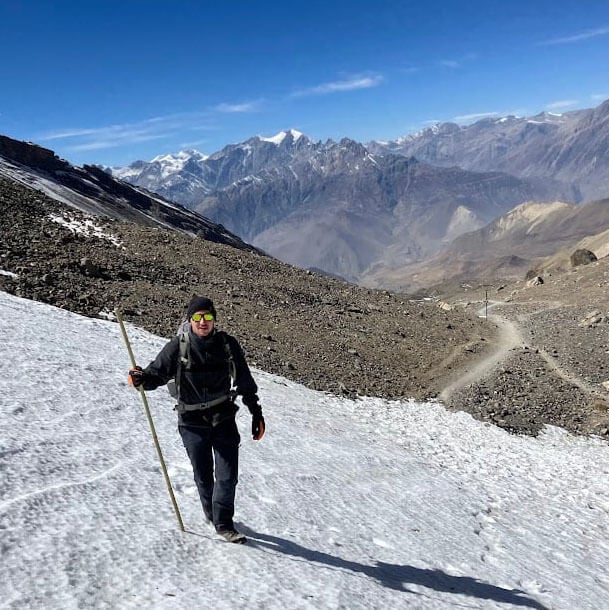
Share or save this post

Leave a Reply Cancel reply
Your email address will not be published. Required fields are marked *
Save my name, email, and website in this browser for the next time I comment.
Notify me of followup comments via e-mail.

How to Get Around in Tunisia: The ULTIMATE Traveler’s Guide

Hello and welcome to Tunisia! We’re Andy and Abi.
As expats living and working in Tunisia for about 3 years (as of Summer 2020), we can testify that Tunisia has a WEALTH of natural beauty, historical sites, and cultural experiences to discover and enjoy.
But, unless you have a guide that is going to hold during your hand during the whole trip, you will need to make some decisions about HOW you will get around to see all these cool places.
Once your plane lands or your ferry docks in Tunisia, you have a wide range of transportation options to choose from. We’ve done our best in this post to give you an overview of them all, as well as some general info that we would share with any friend who is going to be traveling around the country without a guide.
One of the coolest things about traveling in Tunisia is its ACCESSIBILITY. You can get just anywhere in the country within a day.
There’s also a range of options for getting around. From renting a luxury car, to squeezing into a speeding louage van next to a Tunisian family—you can have your choice of how you want to get around.
Abi and I like to be adventurous and do things the way Tunisians do when possible. So, we’ve given a lot of space in this post to some of the more off-the-beaten-track options, which foreigners typically don’t use as much. If you want an immersive cultural experience, or if you just want to save some money, we highly recommend trying out some of these options.
Happy trip planning!
Navigation
Having good navigation is important no matter where you are in Tunisia because important destinations and landmarks are not always well marked, even in the capital city.
Signage can be confusing, and it’s often non-existent. The roads that connect larger towns can be surprisingly desolate and under-repaired, making you wonder if you have gotten lost.
It’s hard to ask for directions if you don’t speak French or Arabic. You can bring along paper maps, but road construction can quickly make those obsolete. If you rent a car, there’s usually an option to have a GPS. Still, our favorite option is Google Maps.
Google Maps works pretty well in Tunisia… except when it doesn’t. There have been some occasions it wants to place us on an undriveable road or take us into an area that is packed with people and would be difficult to get a vehicle through. Maps does not have common sense and it doesn’t always know which streets are one-way.
Still, the Google Maps app functions pretty well in Tunisia, as long as you have data on your phone, and as long as you can get 3G or 4G where you are. You can use 4G pretty reliably in the cities. It is not reliable in many other places, though.
When you travel between cities or visit small towns or remote places, you should download the relevant areas on Google Maps for offline use. There are plenty of good tutorials online for how to do this.
Safety
Pickpocketing does happen a lot on crowded, shared transportation like the train or metro. Other than that, public transportation in Tunisia is pretty safe.
Women visiting Tunisia may understandably be reluctant to get in a taxi alone or at night. One safety measure that we have used before is to use a location tracking app like Find My Friend or Life 360, just to have some extra peace of mind. Someone can keep an eye on your GPS location this way.
Safety is such an important topic for traveling in Tunisia. We wrote two long posts that you should check out. First, How Safe is Tunisia for Tourists? Women? and secondly, How to Have a Safe Vacation in Tunisia .
Renting a Car
If you want maximal freedom to go where you please, and you’re not afraid to share the road with Tunisians, renting a car is your best bet. It is a wonderful feeling to be able to go anywhere in the country within less than a day!
If you’re going to rent a car in Tunisia, check out our post where we warn you about the exciting and sometimes nerve-wracking experience of sharing the road with Tunisian drivers: 19 Tips for Driving in Tunisia .

There are many car rental stores around town. You can find one in almost any neighborhood. There are also many car rental places located in the airport.
You can also make a reservation for a vehicle online before your trip. Most of the car rentals are manual transmission, but there are some automatic transmission cars. If you need an automatic, I would suggest making an online reservation before arriving and be prepared to pay quite a bit more than you would for manual.
You will also want to familiarize yourself with European road signs. Most signs are written in both Arabic and French. If you want more detailed information about car rental, we wrote a whole post about How to Rent a Car in Tunisia that you should check out.
Paying for Public Transportation
You will need to use Tunisian Dinars to pay for public transportation. Even the most central train and bus stations do not accept card payments yet. We wrote a post about using Debit Cards in Tunisia , which explains how to use the ATMs. Don’t worry—dealing with Tunisian currency is pretty easy.
Having correct change is helpful. If you withdraw money from an ATM, you’ll likely get 20’s and maybe 10’s. Buy something small at a hanoot (little convenience store kiosks that are everywhere) to get some change.
Taxis
Taxis are simple and easy to use. By European or American standards, they’re also very cheap. Depending on the time of day, it is very easy to hail a taxi. When we’re getting around Tunis outside of the metro line, a taxi is our first choice.

Taxis Are Metered
Taxis in Tunisia have a meter, so you know how much you are paying. (Except for some taxis at the airport. See Abi’s section on the airport below.) Most short rides across town are from 5-10 Tunisian Dinars. If you taxi from Tunis out to La Marsa or Sidi Bou Said, it will probably go over 10 Dinars. The meter will run even if you’re sitting in traffic, but it obviously runs a lot faster if you get on the highway. For this reason, taxis may frown on you or refuse the ride if you’re asking for a route that goes through a traffic jam.
Using Taxis When Don’t Speak French or Arabic
Before you flag down a taxi, have your destination in mind. If possible, learn from a local how to pronounce the name of your destination. Taxi drivers speak Arabic and French. We’ve taken hundreds of taxis over the years, and only one or two of them could speak English.
If the driver doesn’t know the exact destination, first tell him the neighborhood (use Google Maps). Then, use Google Maps to find a gas station, metro station, grocery store, or something like that. Tunisians do not use road names, at least not the ones listed on Google Maps. You have to use landmarks instead.
I recommend doing this searching ahead of time, not while sitting in the taxi with the driver waiting on you. Once the driver is headed toward a landmark near your destination, you can direct him to the exact destination from there.
Hailing a Taxi
Taxis have a little light sitting on their dashboard that indicates whether they are available or not. It’s kind of counterintuitive, but a red light means that they are available, and a green light means someone is already in the taxi. The light helps because people often sit in the back seat and it’s hard to tell from a distance whether you should bother to wave them down. Also, if you see that a taxi does not have its sign attached to the roof of the car, that means that the driver is not currently working.
Seatbelt Law
There is a law in Tunisia that taxi passengers must wear a seatbelt in the front seat. The police DO enforce this law, even if they are inconsistent with it. If a policeman stops you for not wearing a seatbelt, you—not the taxi driver—will have to pay a fine. The fine is about 40 Dinars per person.
Taxi Etiquette
It is ok to sit in the front or the back seat. Women usually sit in the back. Men who ride alone usually sit in the front. Do not get into the back seat from the driver’s side! The drivers do not like this. Also, don’t plan on eating or drinking in the taxi. Some drivers keep their cars very clean and they would get upset if you spilled something.
Bolt (Ride-Sharing App)
For Americans like us who had never heard of Bolt before… it is the European version of Uber or Lyft. Bolt came onto the scene in Tunisia around 2018-2019. There are a TON of taxi drivers who are now simultaneously driving for Bolt.

Unlike in America, Bolt is not an outright competitor of taxi drivers. So if you use Bolt, you’re not taking business away from hard-working taxi drivers.
How Bolt Works
Bolt works like Uber in the US, with one big difference: you have to pay with cash at the end of your ride . Download the Bolt app in your App Store and enter basic information. It’s pretty self-explanatory how to request a ride from the app.
You will need to have a smartphone with a Tunisian SIM card, since your driver will call you at least once before he arrives.
The car will be a regular taxicab with a green Bolt decal on the side. The app prescribes the route for the taxi driver. This is really nice if you are unfamiliar with the area, as you know that he is taking you by the fastest route. Pay at the end. No tip is expected.
The price is higher than a taxi, but it’s still a lot less than you would pay with a comparable ride-share app in America or Europe. They add an extra 5 Tunisian Dinars to the beginning of the ride, and the mileage rate is higher.
Pro’s of Using a Taxi
- Cheaper than Bolt (sometimes half the cost)
- If taxis are available, they are faster
- Don’t have to deal with the App
Pro’s of Using Bolt
- You can quickly get a ride during rush hour without competing with others for a taxi.
- You can get picked up from places where taxis don’t frequent.
- Bolt takes you to your exact destination
- Choose your destination on the app, so you don’t have to explain it to the driver.
- The driver must follow the prescribed route, so you know you’re not going on any unwanted detours.
Transportation From Tunis-Carthage Airport
There are NO trains or metros that offer transportation from the airport. Here are your options.
1. Use one of the Taxis waiting for passengers
The most common way to leave the airport is through a line of taxis waiting on passengers. The arrivals area will place you on the lower floor of the airport. As soon as you start walking towards your exit, you will most likely be approached by taxi drivers attempting to get your business.
These drivers will get in a taxi line and wait long times for passengers. They charge a flat rate which you will want to haggle for before entering the taxi. On top of this rate they will also ask for a fee for suitcase. They will charge anywhere from 10 to 20 TND as a base rate, and another 5 to 10 TND for suitcases.
2. Find a Taxi at the Arrivals Door
If you are wanting to save a few bucks, you can go to the second floor of the airport where the departures are located and grab a taxi from a passenger who is arriving. These taxis will be the normal metered taxi, although you will still want to give them an extra 5-10 TND tip for your suitcases. As they are pulling out, check the meter to make sure it is on and running. It will start at approximately 0.500 TND and be counting up.
3. Arrange a Private Pickup
Many resorts and tourism companies can arrange a driver to pick you up from the airport. When you exit the baggage claim through customs, you will most likely find them off to your right holding a sign with your name or the company’s name.
4. Order a Taxi with Bolt
Bolt is an app with many hired taxi drivers that you can request a ride through their app system. If you want to use Bolt, you will need to get a Tunisian Sim card in your phone. This can easily be done in the airport. Often there are workers inside the baggage claim signing people up for sim cards. All you need is a passport for this sim. The better option is to exit baggage claim and grab some cash from an ATM then head over to either the Orange or Oreedoo booth and buy your sim have them set up the 4G for you there. Then you can sign up for Bolt with your new Tunisian number and order your ride. You will also now be set up with your phone working with 4G for the rest of your visit.
5. Take the City Bus
This is the least glamorous option available from the airport. There are two bus lines that leave from the airport. It is a little bit of a walk to get to the station. One line goes into many of the neighborhoods in Tunis. The other line goes to downtown station where you can get on the metro lines and train station, that will take you to La Marsa or many places all over Tunis.
6. Rent a Car at the Airport
(See the longer section below about car rentals in general.)
There is the option of renting a car from the airport and starting your driving adventure from the start. The car rental booths are on the bottom floor with the arrivals towards the left of the airport when coming out of baggage claim. You can make a reservation online or rent same day at the airport. There are some car rental places that will also do a meet-and-greet at the airport. When you reserve your car online, you will also provide your flight information and they will be waiting for you as you exit baggage claim.
Most rental cars are manual transmission, so if you need automatic transmission, it’s probably smarter to do an online reservation. You will need your driver’s license, passport, and credit card to rent a vehicle.
Train s
Trains are the most comfortable form of public transportation between cities. Even when crowded, trains a good deal more relaxing and spacious than taking a shared taxi. You also don’t have to worry about the crazy driving habits of louage drivers. When we visit friends in Sfax or other cities and don’t want to drive, taking the train is our first choice.

The government agency called SNCFT runs the trains. There are 246 passenger trains in Tunisia with 80 main lines. The trains go up to 130 km per hr (80 mph). The stops between major cities are short.
Keep in mind that the hours of operation vary for different train stations. Check the SNCFT website for detailed info about your specific trips.
Getting to the Train Stations
The train stations are all well-marked on Google Maps. Search with the phrase “ Gare de [Name of city].” For example, Gare de Tunis . You could take a bus to the train station, but it’s a lot easier to just taxi there.
Tunis . The train station in Tunis is called Gare de Tunis . Search Gare de Tunis on Google Maps. It is right next to the Barcelone metro stop. It’s only a 7-minute walk from Avenue Habibi Bourguiba, which is the main avenue in the middle of downtown Tunis. It’s also a 15-minute drive (without traffic) from Tunis-Carthage Airport.
Sousse . Search Gare de Sousse on Google Maps. It’s less than a 10-minute walk from Sousse’s Avenue Mohammed V.
Hammamet . The main station is Gare de Hammamet on Google Maps. This station is a good 25-minute walk from the medina and the beach, so you may want to taxi to get there.
Sfax . Search Gare de Sfax on Google Maps. It’s one block from the southeast corner of the medina.
Where Do Trains Go in Tunisia?
There are 74 train stations. They will take you to most major cities, but not all. Notable exceptions are Tabarka in the northwest, and the southern town of Douz, which is the starting point for a lot of desert adventures.
Here’s a complete list of all 74 train stations from the SNCFT website.
- AOUINET
- BEKALTA
- BIR BOU REGBA
- BIR M’CHERGA
- BIZERTE
- BOUARADA
- BOUARGOUB
- BOU FICHA
- BOU SALEM
- CHEYLUS
- DAHMANI
- DEPIENNE
- EL AKHOUAT
- EL AROUSSA
- EL JEM
- ENFIDHA VILLE
- FOUSSANA
- GÂAFOUR
- GABES
- GAFSA
- GHANNOUCH
- GHARDIMAOU
- GROMBALIA
- HAMMAM-LIF
- JEDEIDA
- JEMMAL
- JENDOUBA VOY.
- JENDOUBA MAR.
- JERISSA
- KALAÂ KEBIRA
- KALAÂ KHASBA
- KALAÂ SGHIRA
- KASSERINE
- THE GOULETTE
- THE PÊCHERIE
- LE KEF
- THE KRIB
- MAGEN BEN ABBES
- MAHDIA
- MAKNASSY
- MATEUR
- MANOUBA
- MEDJEZ EL BAB
- MENZEL BOURGUIBA
- MENZEL BOU ZAIEN
- METLAOUI
- MEZZOUNA
- MOKNINE
- MONASTIR
- MOULARES
- NABEUL PV
- NABEUL VILLE
- OUED ZARGA
- PONT DU FAHS
- RADÈS
- REDEYEF
- SEBEITLA
- SEJNANE
- SENED
- SIDI BOU ROUIS
- SOUSSE
- THELEPTE
- TINJA
- TUNIS PV (MARCH)
- TUNIS (VOYAG)
- TOZEUR
Cost of Train Tickets
It’s very cheap to travel by train. The longest one-way trips in the nicest seats are still under 30 Tunisian Dinars ($10). Children under 10 travel at a reduced rate, and children under 4 travel for free.

How to B ook Train Tickets
You can book train tickets in advance on the state’s SNCFT website. You can only book 3 days in advance. Or, you can go to the train station in person and buy tickets.
The Train Experience
The trains vary in cleanliness and comfort. First Class or Class Confort seats on some of the newer trains are very nice. However, other trains like on the Tunis-Sousse-Sfax-Gabes line are leave some luxury to be desired.
My (Andy’s) first experience on a train in Tunisia was to go with Abi from Tunis to Sfax and back. It was the middle of July, and there was no AC on the train, so it was extremely hot. There was only one row with two open seats for us, and one of these seats was broken, so I sat kind of lopsided. The seats had old, fabric seat-covers, and since we were sweating profusely, we couldn’t help but wonder how much grime these things had accumulated over the years. While we were waiting to take off, a little kid next to us leaned over and threw up in the aisle between us. Since Abi and I were only weeks away from returning to the US and getting married, we were in too good of a mood to be bothered by all this. But, if you’re expecting luxury on the trains in Tunisia, just be aware that conditions can be less than glamorous!
Other Train Tips
- Attendants will come around and check your paper tickets, so don’t lose them.
- You are free to get up and move around on the trains.
- The train will have a modest snack bar that serves coffee, snacks, and bottled water. Like other vendors, they will not be serving food during Ramadan.
- There are bathrooms on the train, but they are unfortunately some of the most stinky and unclean bathrooms you can find in all of Tunisia! Bring your own toilet paper, hand sanitizer, and hazmat mask.
- Don’t expect temperature-controlled train cars. Dress for the outside weather.
- You are able to open windows to get a breeze. Keep in mind, though, that Tunisians are sometimes uncomfortable with wind blowing on them even when it’s hot.
Tunis-Goulet-Marsa Rail Line (TGM)
The TGM is a rail line that runs from downtown Tunis out to La Marsa. Taxing a taxi is faster and easier, but the TGM is just another way to get to La Goulet, Carthage, and Sidi Bou Said. Buy tickets at the train station.

The TGM is run by Transtu (Société des transports de Tunis). This is a different organization than the SNCFT, which operates the trains going outside of the capital. Unfortunately Transtu doesn’t have a website in English.
The starting point for the TGM in Tunis is called Tunis Marine on Google Maps. Do not confuse this with Gare de Tunis. Tunis Marine is located on La Goulette Road, which is the same road as Avenue Habib Bourguiba. It’s a 5-minute walk from the big clock tower, and a 20-minute walk down the avenue from Bab Bhar, the main entrance to the medina.
Here’s a complete list of stops on the TGM:
- Tunis Marine
- Le Bac
- La Goulette
- La Goulette Neuve
- La Goulette Casino
- Khereddine
- L’Aéroport*
- Le Kram
- Carthage Salammbô
- Carthage Byrsa
- Carthage Dermech
- Carthage Hannibal
- Carthage Présidence
- Carthage Amilcar
- Sidi Bou Saïd
- Sidi Dhrif
- La Corniche
- Marsa Plage
*Please be aware that the stop called L’Aeroport is in fact nowhere near the airport!
Tunis Metro
Tunis is the only city in Tunisia with a metro system. It’s an above-ground, light rail network. The official name for the metro is the Métro léger de Tunis.
We wrote a whole post about taking the Metro that you should check out if there’s any chance you’ll use the Metro on your trip: 9 Tips for Riding the Metro in Tunis .

The Metro is a quick, cheap, and easy way to get to important places in the city such as the Bardo Museum. However, there are some neighborhoods that the metro unfortunately doesn’t reach. If you are staying in some of the Meza or Manar neighborhoods, which are some of the largest residential neighborhoods in the city, you will have to supplement your metro trip with a taxi ride or a long walk.
The Metro has 8 lines with 66 stations. The stations are easy to get in and out of. They are white and green, one-story buildings. The ticket booths are all on ground level. Some of the bigger stations downtown have an underground tunnel to get you from one track to another, but in most places, you just walk across the track to get on the correct side.
Go to the booth and just say the name of your stop. Use Google Maps to find the names of stops. Tickets range in price between 0.320 and 1.550 Dinars (between $0.11 and $0.53). You’ll be issued a paper ticket. Keep the ticket with you, as there are random ticket checks by the police. If you don’t have the ticket on you, you’ll be given a fine of about 20 Dinars ($6.90).

As with the train service, the metro is free for kids under 4. And it’s a reduced price for kids under 10.
The Metro gets very crowded during the morning and afternoon rush hours. At the busiest times, you will have to stand in very close contact with all of the other passengers. In the summer, it is like a steamy oven.
Watch out for pickpockets! They are there, and they are watching you if you’re a tourist. Do NOT keep valuables in your pockets. Put things in a closed bag and keep the bag in front of you. Tunisians tend to ride the metro in complete silence, so use that quiet time to focus on not getting your things stolen.
City Buses
To be honest, I was not at all experienced with using the city bus system until we started writing this post, so I finally decided to go out and learn how the bus system works. Here’s what we found….

Buses Aren’t Tourist-Friendly
The bus system is the least tourist-friendly mode of transportation. City buses are made for Tunisian commuters–not for tourists! There are several aspects of taking the bus that will make it less-than-optimal for traveling through Tunis if you’re a first time visitor.
Bad signage . The bus stops do not have signs or maps. The buses themselves do not have signs or maps inside them either. There is nowhere that you can get a printed copy of the bus route. Basically, you have to know which bus number you’re taking. People who ride the bus regularly know their route from experience and word-of-mouth.
Language Barrier . If you don’t know Arabic or French, you will feel hopelessly lost using the city buses. The only signage on the bus is an electronic sign on the front windshield that shows the bus number (a number and a letter). The sign also says the destination, but it’s written in Arabic.
How to Use the Bus
That being said, you should still feel free to try the bus as long as you’re not in a hurry, and if you like tackling new challenges in an unfamiliar country. If you’re short on change, it’s still better than walking.
How to pay . You can pay on the bus or at a ticket booth if you’re at a bus station. You usually get in the back door of the bus, not the front. In the back, there’s a little ticket counter with a guy selling tickets. Tell him your stop if you know it. If not, you can just say “terminus” for terminal and pay the full price, which is only about 700 milims.
Wait time & hours . City buses run more frequently in the early mornings than they do during the day. If you show up to a bus stop in the afternoon, the bus may come by only every hour. We waited a good 45 minutes the first time we took a bus, and we started waiting at about 2:30 PM. Unfortunately, there’s no schedule posted for you to know when the bus is going to come. In Tunis, the city buses start at 5:30 AM and finish around 7:30 PM.
The experience . City buses are not luxurious. The worst part is that they’re crowded, and you may not get a seat. If you jump on a bus half-way through its route, you may have to cram in and stand shoulder-to-shoulder with other commuters.
Inter-City Buses
Each city has a bus station. These busses are white with green lettering. The buses run from city to city. They follow a schedule, but often are not quite on time. You can ask at the bus station for times or find them online by clicking here .
In Tunis, there are two inter-city bus stations based on whether your destination is the North or South. Confusingly, these bus stations are about 5 km apart , so take care not to choose the wrong one!
If you’re in Tunis but going North , search Gare Routiere Tunis Nord on Google Maps. It’s near Bab Saadoun on the West side of the medina.
If you’re going South , search Gare Routiere Tunis Sud . It’s near Bab Alioua.
A louage is a minivan that can hold nine passengers. Every city in Tunisia has one or two louage stations. Where I (Abi) lived in Sfax there was the north louage station taking you to any cities in a northern direction, and a southern louage station that had louages going south. The vans will have the two cities they travel between written on a sticker somewhere on the taxi. These taxis will take off to their destination, only after every seat in the van is full.

How to pay . When you first arrive at the louage station, if there are any signs, they will be written in Arabic. There will be plenty of people wanting to help you out. The drivers are anxious to get their vans full and be off. You will first be directed to a ticket booth. You will pay a fee based on the distance you are traveling. A trip from Sfax to Sousse cost me about 9 Dinars ($3 USD). They will give you a printed receipt. That receipt is what you will take into the station. There will be many queues (lines) for destinations. You can tell people where you are going or show them the receipt and they will direct you to the correct van.
Where to sit . When you do find your correct van, there are nine seats and all of them must be filled before the van will leave. There are two seats up front by the driver that are included in this. Most men and women segregate as much as possible. The seating choice is mostly first come first serve. People will often claim a seat with their bag and then go grab a snack, coffee, or stand around the vehicle until all passengers have arrived.
Wait times . There is no way to estimate the wait time. If you are going to a popular destination at a popular time, it is very likely that you will get in a van and leave very quickly. If it is not a high peak travel time, or just not as popular of a destination, you will have to wait for a full ride. If you are the first one to buy a ticket, your wait will be longer than if you are filling one of the last seats. On a louage ride from El Djem to Sfax, we once waited for an hour for the final two seats to be filled. The driver offered that we could all pitch in and buy the final seats, and then he could leave.
The experience . If you are on a longer louage trip, the driver will make stops on the highway at a gas station about every hour and a half for the passengers to get out and stretch their legs. These stations will have fast food, coffee, restrooms, and snacks for sale.
Shared Taxi
Inside the city there are yellow minivans that drive on a fixed route. These are called taxi jemaya in Arabic, meaning group taxi or shared taxi. If they have an empty seat, you may flag them down anywhere on their route and catch a ride.

These taxis will have their destinations written in on the bumper or on the top… however, they are mostly written in Arabic. If you plan on using one of these taxis, ask a local to help you know what road to wait on and to help you flag down the vehicle as well.
You will pay the driver based on how many kilometers you are away from the destination. You can also exit anywhere along the fixed route.
If the taxi has a seat available, it will often blink its headlights at you to ask if you want it to stop. Wave at them to get them to stop.
Once inside the taxi, first find an empty seat as the taxi takes off. You then can tell them if you want them to drop you off early or take you to the end destination. You can ask for the price at this point. You will hand your money to the driver often being passed along by your fellow passengers. The driver will hand your change back in the same way while driving.
Inti-Go
Last but not least is Intigo, which means “You go.” Intigo is another new addition to the public transportation options in Tunis. It’s basically a moped taxi.
Intigo mopeds are bright orange, and they have a little roof to keep the sun off of you. The driver usually carries an extra helmet with him that you can wear, if you don’t mind sharing a helmet with hundreds of strangers.
As of Summer 2020, we’re not seeing a ton of Intigo mopeds around town. Maybe it’s still to-be-determined whether it will last.
So these are your options for transportation in Tunisia! We wish you the best as you visit this country, and we hope this posts equips you to get out there and see all that there is to see in Tunisia!
Share this:
Andy & Abi
Andy & Abi live in Tunis and enjoy exploring everything that Tunisia has to offer!
Recent Posts
What Things Cost in Tunisia: A Traveler's Guide
One of the biggest draws for tourists coming to Tunisia is the relatively low cost of things: meals at restaurants, drinks, transportation, adventure activities... pretty much everything on your trip...
How to Shop Online While in Tunisia
Online shopping has made life a whole lot easier for many people in the world. However, from the time we moved to Tunisia, a lot of the wonderful conveniences of online shopping are no longer...

Ready for your Tunisian Experience?
Get access to 45 instructional videos in our Survival Skills Crash Course!
- Travel Planning Guide
The Prices of Tours to Tunisia

- Package Tour Options
- Typical Tour Costs
- The Best Tours
- Budget Tours
- Luxury Tours
- Three-Day Tours
- Other Types of Tours
Are group tours to Tunisia worth it?
Is a group tour cheaper than solo travel to tunisia.
- Group Tours vs. Indepenent Travel in Tunisia
How far in advance should I book my tour to Tunisia?
How many people are in group tours to tunisia, how much time do i need for a group tour to tunisia.
Curious about the cost of tours in Tunisia? Look no further! In this article, we'll explore the prices, tour types, amenities, and travel styles of a variety of guided and organized tours to help you plan your dream vacation. With 23 tours analyzed in our research, we've gathered valuable information for outdoor enthusiasts, adventure seekers, and cultural travelers alike. You'll find tours here that cover all types of travel styles such as family, in-depth cultural, active adventure, and historical. These guided tours are popular because of their high quality and well-organized itineraries, ensuring a stress-free and all-inclusive holiday experience. So, let's dive into the details and discover the tour prices in Tunisia to make your next vacation unforgettable.
Recommended
The best of tunisia & all-inclusive beach extension…, what are the package tour options in tunisia.
Curious about the diverse range of tours? Prepare to be amazed by the array of options available to suit every traveler's preferences. It comes as no surprise that visitors adore these tours, given their exceptional average guest rating of 4.33 out of 5 stars. When it comes to group sizes, the average maximum capacity stands at 14 people, allowing for a comfortable and sociable experience. The shortest tour is 3 days, while the longest is 14 days. When it comes to physical activity , tour options are organized as easy, relaxing, and moderate, with a majority being easy tours. With a comprehensive analysis encompassing 23 tours, you can rest assured that Tunisia has something tailored to your interests and preferences, promising an unforgettable experience for all.
- The length of tours range from 3 to 14 days.
- The maximum group size of tours range from 4 to 100 people.
The tour packages are also categorized as follows:
- Relaxing (1)
- Moderate (1)
- Family (17)
- Tours Available 23
- Average Rating 4.33
- Average Group Size 14
- See More See Tours in Tunisia
How much do organized tour packages to Tunisia cost? Are tours expensive?
Analyzing the comprehensive list of available tours, you'll easily find a range of fantastic choices to suit your travel preferences. Considering the financial aspect, the average daily price for tours in Tunisia stands at a highly reasonable $275 per day . Taking a broader perspective, the overall average cost of all tours amounts to $2,084 , derived from meticulous data analysis of 23 captivating tours. It's worth noting that the lowest-priced tour starts at an enticing $773, while the most extravagant option reaches a remarkable $4,601.
- Tours to Tunisia range in price from $773 to $4,601, based on data from 23 tours.
How much should I pay for a tour through Tunisia?
This table shows the range of guided, organized, and all-inclusive tour prices that visit, start in, or end in Tunisia. If you're trying to figure out how much you should pay for an organized tour, this table breaks down the costs by price range.
(All tour prices are in US Dollars before taxes, and come from a base price that is reported by TourRadar. Peak season prices can vary significantly, particularly in destinations where seasonal travel fluctuates dramatically. Price costs can also vary by group size, amenities offered, transportation type, promotional sale prices, and addons not inlcuded in the base prices.)
Prices for the Best Tours to Tunisia
What are Tunisia's top rated tour packages? And how much do they cost? These tours are the highest rated tours by previous guests.
By only looking at the absolute best and highest rated tours (the top 25% by guest rating), visitors will find a wide range of terrific options when choosing a tour to Tunisia. The average daily price for the highest-rated tours to Tunisia is a very reasonable $223 per day , with the overall average cost of all tours being $1,570 (based on data from 6 tours). The cheapest tour is $773, and the most expensive tour is $2,084. Also, visitors tend to love all of these tours because the average guest rating is 4.62 out of 5 stars.
What are the best tours to Tunisia?
These are the highest rated tours from previous customers.
The Best of Tunisia & All-inclusive Beach Extension (Stay connected),…
Taste of tunisia, small group tour, tunisia discovery, small group tour, immersive tunisia, small group tour, prices for the best budget tours to tunisia.
Considering only budget-friendly tours, Tunisia has you covered with an array of fantastic options. You'll be thrilled to know that the average daily price for budget tours is a very economical $279 per day . Looking at the bigger picture, the overall average cost of all tours comes in at a reasonable $1,955 , based on data from 1 incredible options. The cheapest tour available is a great deal at just $1,955, while the most lavish option reaches up to $1,955. Rest assured, these tours have captured the hearts of visitors, as they boast an impressive average guest rating of 0 out of 5 stars. So, get ready to explore Tunisia and its amazing destination, and prepare for an unforgettable journey filled with awe-inspiring experiences.
What are the best budget tours to Tunisia?
Camel riding adventure at great oriental erg 7 days/ 6…, prices for the best luxury tours to tunisia.
By only looking at the luxury and comfort category of tours, visitors will find a wide range of terrific options when choosing a tour to Tunisia. The average daily price for luxury tours to Tunisia is a very reasonable $269 per day , with the overall average cost of all tours being $1,970 (based on data from 21 tours). The cheapest tour is $773, and the most expensive tour is $3,482. Also, visitors tend to love all of these tours because the average guest rating is 4.33 out of 5 stars.
What are the best luxury tours to Tunisia?
Prices for the best 3-days or less tours to tunisia.
By only looking at the shortest 3-days or less tours, perfect for a quick getaway, the array of tour options available in Tunisia is diverse. The average daily price for 3-day tours stands at a very reasonable $308 per day . Drawing from an extensive analysis of 2 tours, we've determined that the overall average cost of all tours is a modest $925 . It's worth noting that among these options, the cheapest tour can be enjoyed for as little as $773 per person, while those looking to splurge a bit more can opt for the most expensive tour at $1,078. The popularity of these tours speaks volumes, with an average guest rating of 4.5 out of 5 stars, showcasing the satisfaction and appreciation expressed by previous customers.
What are the best 3-days or shorter tours to Tunisia?
Desert tour kairouan to el jem 3d/ 2n, prices for family tours to tunisia.
When we look at this type of tour, visitors will find a wide range of terrific options when choosing a tour to Tunisia. The average daily price for family tours to Tunisia is a very reasonable $251 per day , with the overall average cost of all tours being $1,726 (based on data from 17 tours). The cheapest tour is $773, and the most expensive tour is $3,482. Also, visitors tend to love all of these tours because the average guest rating is 4.33 out of 5 stars.
What are the best family tours to Tunisia?
Prices for in-depth cultural tours to tunisia.
For these tours, in Tunisia you'll discover plenty of fantastic in-depth cultural options. Get ready to be pleasantly surprised, as the average daily price in this category is an affordable $264 per day . Furthermore, the overall average cost of all tours stands at a reasonable $1,771 , based on data from 13 available tour options. Now, for the overall price range: the cheapest tour available comes in at a pocket-friendly $773, while the most luxurious option reaches a maximum of $3,209. What's more, visitors can rest assured that these tours are well liked, as they boast an impressive average guest rating of 4.33 out of 5 stars. So, get ready to explore Tunisia and embark on an unforgettable journey that will make the memories of a lifetime.
What are the best in-depth cultural tours to Tunisia?
Prices for active adventure tours to tunisia.
Looking at this type of tour, a wide range of terrific options in Tunisia are offered. Based on data from 9 tours, the average daily price for active adventure tours to Tunisia is a very reasonable $249 per day , and the overall average total price is $1,930 . The cheapest tour is $1,177, and the most expensive tour is $2,799. Also, previous customers have mostly enjoyed these tours because the average guest rating is 4.1 out of 5 stars. If you're looking for a active adventure tour to Tunisia, these are some terrific options.
What are the best active adventure tours to Tunisia?
Highlights of tunisia, small group tour, prices for historical tours to tunisia.
When we look at this type of tour, in Tunisia you'll discover plenty of fantastic historical options. Get ready to be pleasantly surprised, as the average daily price in this category is an affordable $293 per day . Furthermore, the overall average cost of all tours stands at a reasonable $2,248 , based on data from 6 available tour options. Now, for the overall price range: the cheapest tour available comes in at a pocket-friendly $1,078, while the most luxurious option reaches a maximum of $4,601. What's more, visitors can rest assured that these tours are well liked, as they boast an impressive average guest rating of 4.03 out of 5 stars. So, get ready to explore Tunisia and embark on an unforgettable journey that will make the memories of a lifetime.
What are the best historical tours to Tunisia?
Tunisia tour, small group tour, step back into the millennium, small group tour.
Yes, paying a bit extra for a tour in Tunisia is absolutely worth every penny and, in some cases, a must to unveil the country's hidden treasures. Given the challenge of reaching remote areas independently, tour operators provide exclusive access to these difficult to reach spots. Therefore, choosing a guided tour is the most common decision among the majority of travelers. Local experts and tour guides can arrange your entire trip, covering transportation, lodging, dining, activities, excursions, tickets, and more. Opting for a package tour creates a worry-free journey, with every detail sorted out and an up-front price tag.
You can find many situations where tours in Tunisia are more cost-effective compared to an independently planned trip. The affordability of a tour depends on factors such as the destinations covered, level of luxury, and duration. Each tour and independent trip is unique, but tour providers often offer competitive prices that match the luxury level of an independent trip with the same amenities. On average, a tour in Tunisia costs $275 per day, with many tours priced below this average, although some are higher. Prices for tours in Tunisia range from $773 to $4,601. When comparing costs with independent travel, it's important to consider that guided tours typically include accommodations, transportation, guides, meals, tickets, and even more. To accurately compare prices, it is essential to understand the inclusions of a tour package and thoroughly research the costs of independent travel in Tunisia.
Group Tours vs. Independent Travel in Tunisia
For many travelers, it is a hard decision whether to travel with an organized tour package or to plan a trip independently. Organized tour packages are a great way to travel in Tunisia in 2024 or 2025 because a variety of great deals and sales are now available. Also, because guided tours tend to be all-inclusive, they will provide great values on accommodations, transportation, entry tickets, food, and other travel necessities. You'll also have the benefits of knowledgable guides as well as the peace of mind that you don't have to plan out the entire trip. On the other hand, traveling independently provides more flexibility and control over your travel plans instead of the fixed schedule of a tour package. You can shift your schedule and budget around as needed. Also, it's easier to get closer to local cultures and visit those harder to reach destinations that tours usually don't visit.
What are the benefits of a package tour to Tunisia?
Traveling with a tour provides a multitude of advantages. One of the most significant benefits is the convenience of having all the details sorted out for you. From arranging transportation to securing accommodations and planning activities, everything is taken care of, allowing you to have a worry-free experience. This means you won't have to stress about finding suitable places to stay, figuring out logistics, or potentially missing out on any important sights. Additionally, most tours offer all-inclusive pricing, giving you a clear understanding of the total cost of your trip before you depart. The beneifits of a tour are
- knowledgeable guides
- comfortable amenities
- not having to plan
- reliable service and schedule
- fixed budget
- meeting other like-minded travelers
- eliminating risks
What are the benefits of independent travel in Tunisia?
The advantages of independent travel include freedom, control, and flexibility. When you travel independently, you have the freedom to decide where to stay, which attractions to visit, when and where to eat, and how to navigate the destination. Taking charge of these choices also gives you greater control over your budget, schedule, itinerary, and the level of luxury you desire during your trip. Other benefits include:
- in-depth cultural opportunities
- off-the-beaten-path destinations
- flexible schedules
- flexible budget
To ensure your spot on the tour to Tunisia, it is recommended to plan and book well in advance, preferably a few months or more prior to the departure date. While it is not uncommon for many people to reserve their tours up to a year ahead, our experience indicates that booking around 6 to 9 months in advance is typically adequate. It is essential to consider that numerous tours get fully booked ahead of time, so early booking guarantees your place on the trip. Moreover, booking early can result in significant cost savings, as tour companies often offer early booking sales and discounted prices. However, it is important to be aware that some tour companies may occasionally offer last-minute discounts for tours that are not fully booked. Nevertheless, waiting for last-minute discounts entails the risk of missing out on a spot if the tour reaches full capacity.
When it comes to tours in Tunisia, group sizes can range from as small as 4 to as large as 100 people, with an average group size of 14. Nevertheless, it's worth mentioning that the size of the tour does not necessarily correlate with its cost or overall experience.
Most organized tour packages to Tunisia typically last around 8 days, although the duration can vary. Tours can range from 3 to 14 days, or even longer. It is important to note that longer tours may be more expensive initially, but their cost per day tends to decrease. Additionally, longer tours offer the opportunity to visit multiple destinations at a comfortable pace, making them a worthwhile investment.
Where do group tours go in Tunisia?
A visit to Tunisia wouldn't be complete without experiencing the allure of Tunis, Kairouan, El Jem, Hammamet, Sousse, Douz, Sidi-Bou-Said, and Tataouine, which serve as excellent representations of the beauty and charm of the country.
What tour and travel companies offer packages to Tunisia?
Plenty of companies are offering package tours to and around Tunisia, but not all of them are the same. Some of the companies are large international operators that have solid reputations. Other companies are smaller and offer more unique and locally-based insights into the country. With larger companies, tours are rarely cancelled and customer service is generally high. With smaller companies, you're more likely to have a trip that gives you more local and personable experiences.
The companies offering the most tours in Tunisia are Tunisie Voyages , Across Africa Tours & Travel , Agate Travel , Bucket List Group Travel LLC , and Wingbuddy . All of them tend to offer quality trips with high guest ratings.
What is the best tour company offering trips to Tunisia?
When it comes to tours in Tunisia, Tunisie Voyages takes the top spot with their highly-rated tour packages. Their dedication to quality service and captivating journeys has won them plenty of accolades from previous guests.
More Information
See also The Best Family-Friendly Tours to Tunisia , The Best Historical Tours in Tunisia , The Best Christmas & New Years Tours in Tunisia , The Best Adventure Tours to Tunisia , The Best Cultural Tours in Tunisia , The Best Romantic Tours for Couples in Tunisia , or The Best Tours for Seniors to Tunisia for more tour ideas. With so many options, there's a guided tour or vacation package for every type of traveler.
Also, if you're departing from a specific destination, see The Best One-Week (7-Day) Tours from Tunis for more package tour options.
And for more information on Tunisia, see Tunisia Travel Costs and Tunisia Hotel Costs .
Subscribe to our Newsletter
By signing up for our email newsletter, you will receive occasional updates from us with sales and discounts from major travel companies , plus tips and advice from experienced budget travelers!
Budget Your Trip

Some of the links on this website are sponsored or affiliate links which help to financially support this site. By clicking the link and making a purchase, we may receive a small commission, but this does not affect the price of your purchase.
- Privacy / Terms of Use
- Activities, Day Trips, Things To Do, and Excursions

The Perfect 14 Days Itinerary for Tunisia
Tunisia is a fantastic destination and if you’re looking for an itinerary to follow, you came to the right place!
While many visit Morocco and Egypt, somehow Tunisia remains less explored.
Hi, we’re Rach & Marty!
We’ve visited every country in the world and want to help you get the most out of your travels!
Whether you need an expertly planned itinerary , some experienced hints and tips , or just craving a delicious food adventure , we’ve got you covered!
We may earn affiliate commissions from websites we link to, at no cost to you. Click here for details.
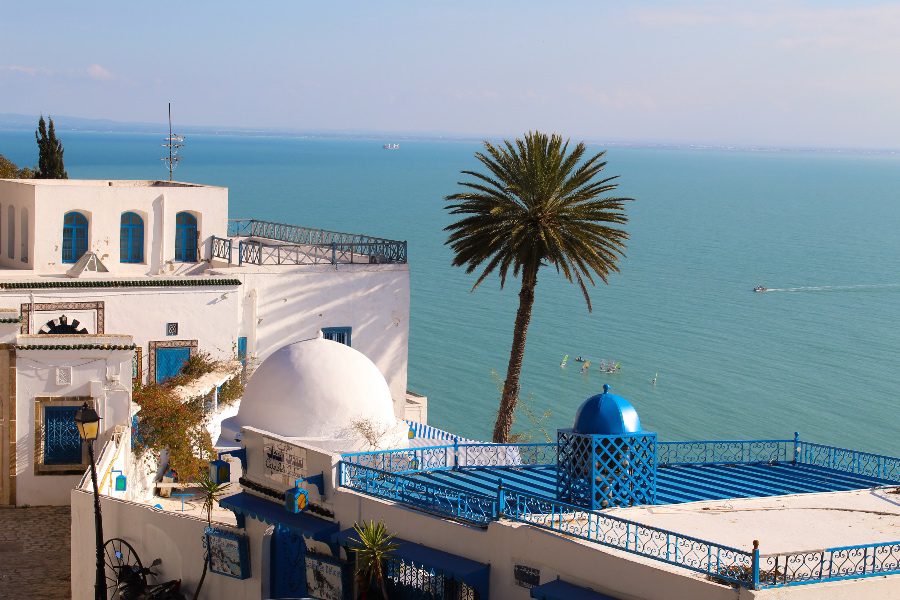
We’ve spent three weeks in Tunisia travelling independently and decided to write this perfect 14-day itinerary for Tunisia. But don’t worry, we have some suggestions if you wish to stay longer or shorter.
The country has so much to offer: gorgeous beaches, Mediterranean towns, exceptional Roman Ruins, islands, Star Wars Movie sets, the Sahara desert, great food, honest and friendly people, and great infrastructure, so getting from A to B is easy.
We travelled to Tunisia in late November and early December 2021. The prices quoted in this itinerary for Tunisia are in local currency, Tunisian Dinar (TND).
At the time 1 USD = 2.9 TND
Let’s go! The Perfect 14 Days Itinerary for Tunisia
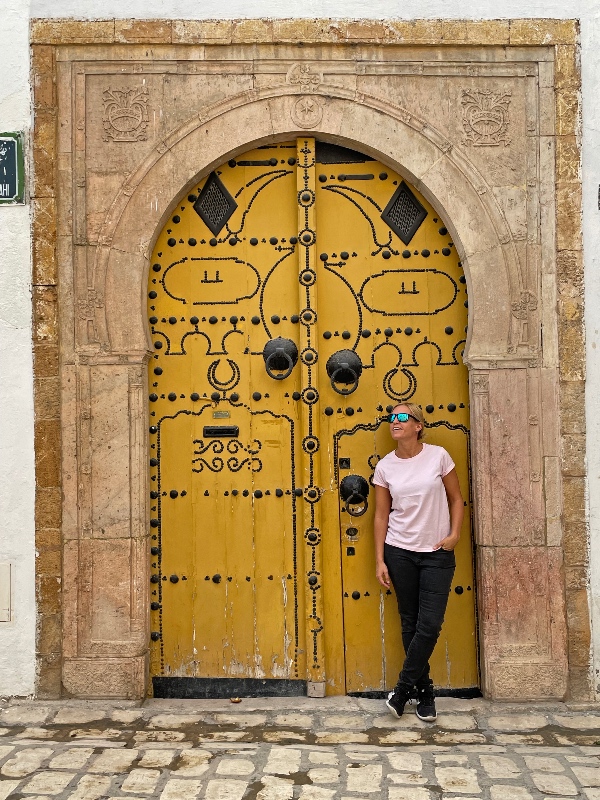
Table of Contents
DAY 1: TUNIS
The capital city of Tunisia is a bustling city that combines modern and traditional. The best place to stay on your first visit is the medina so you can explore it. You can choose to stay in the new city at the end of your trip.
The Tunis Medina dates from the 7th century when it was built around the Zitouna Mosque.
Don’t miss the souks, especially on Friday/Saturday mornings. And, if you’re after some great views, then head up to the Cafe Panorama and enjoy a coffee or tea while you’re there.
And for a delicious lunch in the medina, stop by Restaurant The Ben Arous. You could spend a lot of time strolling through the maze of the medina with incredible doors and shops.
Read our post on the top 5 experiences of Tunis Medina.
Another highlight is the Bardo Museum, Africa’s second-biggest museum.
The museum also boasts one of the world’s most exquisite Roman mosaic collections. Definitely add this to your itinerary for Tunisia if you are an art lover. It’s closed on Monday.
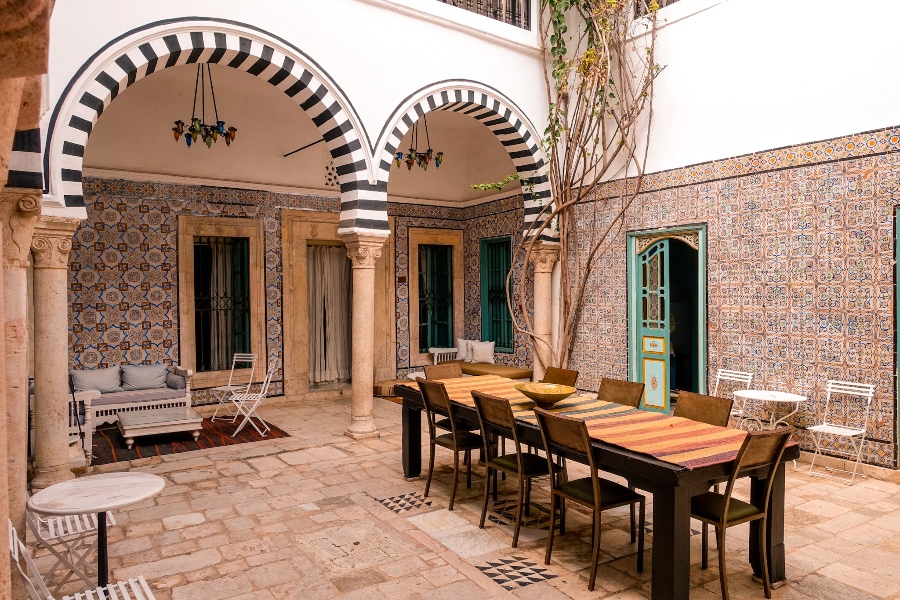
Where to stay in Tunis
Budget : Dar Ya – A great budget option in the heart of Medina. Rooms are clean and comfortable, yet only shared bathroom facilities are available. Breakfast is included in the price. The staff is very welcoming and helpful in providing local knowledge to explore Tunis and the surrounding area.
Midrange : Dar Ben Gacem – A beautifully restored old Tunisian home, now a boutique hotel. Rooms are beautiful, and an amazing breakfast is included in the rate (the best omelette and coffee in Tunisia).
The young staff is always around to help with anything you need, even if it’s just to prepare you a hot pot of tea or coffee after a long day of exploring.
Luxury: Treat yourself: Hôtel Belvédère Fourati – If you’ve got the budget that allows a swish stay in this hotel in Tunis, I recommend it.
DAY 2: TUNIS – CARTHAGE – SIDI BOU SAID
Spend the morning walking across the medina and catch the metro to Carthage (ticket is approx 0.700TND ($0.25).
This is the ancient city that once ruled a huge empire across the Mediterranean The entry ticket of 12 TND ($4.20) will get you into multiple sites.
I recommend starting at Antonine Baths and walking from there to the Roman Villas (amazing mosaics), checking out the Theatre next door, and walking up to Byrsa hill with some epic views and museums.
There are other archeological sites in Tunisia, but this one should be on anyone’s itinerary for Tunisia as it is also a UNESCO World Heritage site.
From Carthage grab a BOLT (ride-sharing app) to get to Sidi Bou Said. This picturesque seaside town is famous for its white and blue architecture (very Greece-like), make sure you explore the small side streets where you lose the crowds.
There is a famous place on the main street, Rue Hédi Zarrouk to get a hot bambalouni (Tunisian hot doughnut).
It’s a blue, hole-in-the-wall stand and you can smell sugar as you approach it. You can’t miss it.
It’s the perfect place for an afternoon stroll or stays for sunset @Cafe Des Delices.
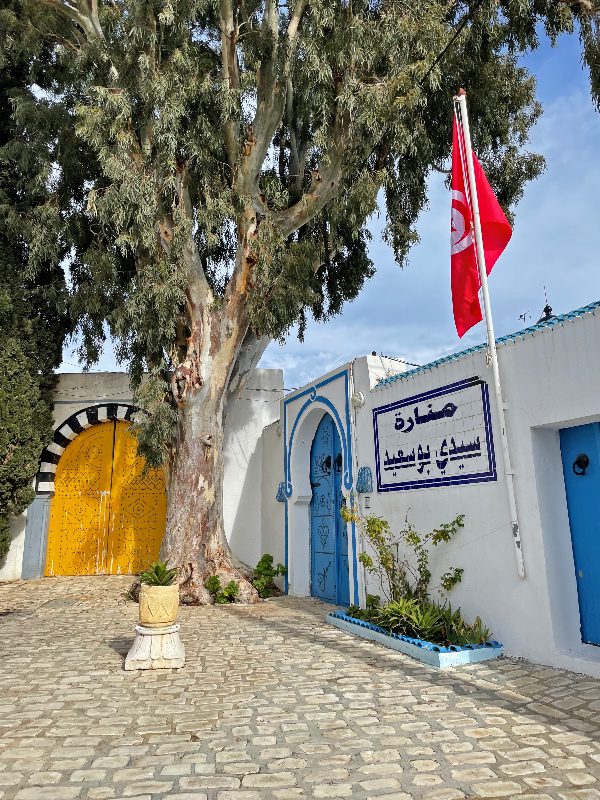
DAY 3: TUNIS TO SOUSSE
Distance: 147 km (1 hour 50 mins journey time in car)
This morning head to the Louage Station Moncef Bey to catch a louage to Sousse (11.9 TND or $4.20). This 14-day itinerary for Tunisia is based on using public transport – for us, louage was the fastest option.
LOUAGE is essentially a shared taxi, a van that fits 8 passengers, and once full it departs from the station for the destination. More about that further below.
(You could also head to Monastir directly and spend the night there at Marina Cap Appart Hotel , explore the town, and then return to Sousse the next day).
It’s only a 15 min louage ride away, a ticket is 2.25 TND and they depart regularly.
Sousse can feel pretty touristy at times but the medina is nice although it mostly feels like a market. The Ribat (fortress) is worth visiting and you can stroll down to the beach. You might choose to stay in the medina.
We stayed at Hotel Paris, a comfortable budget option located in the medina.
For breakfast get some coffee from Beanery Cafe and pastries from the amazing french bakery just around the corner (across the entrance to the Institute of Arts) and have lunch at Restaurant du Peuple – an amazing set lunch menu not to be missed.
You can also choose to stay at one of the nice resorts along the beach in Sousse. I recommend either the Sousse Pearl Marriott Resort or Mövenpick Resort & Marine Spa .
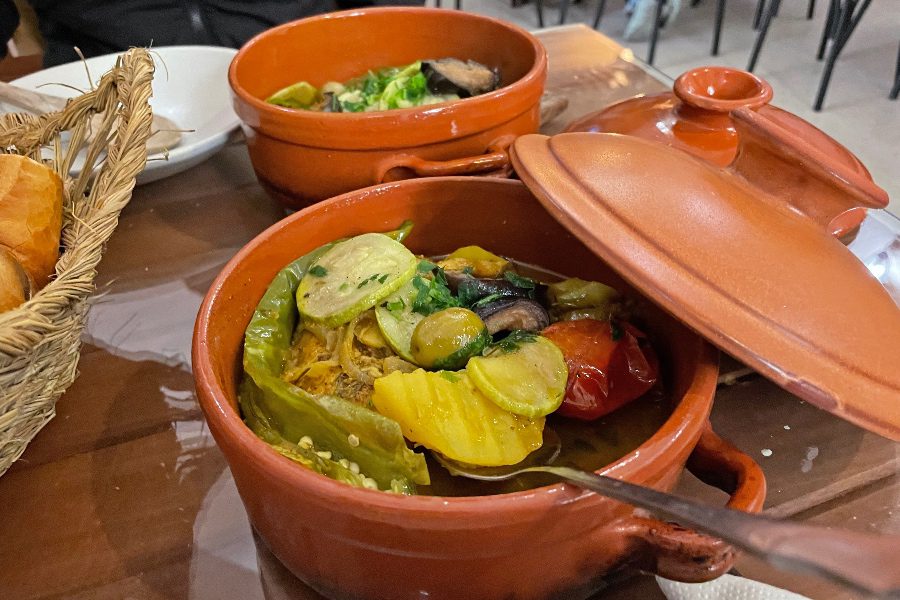
DAY 4: DAY TRIP TO MONASTIR AND EL JEM
Distance: Sousse to Monastir 22 km (25-30 mins journey time in car)
Distance: Monastir to El Jem 73km (1 hour journey time in car)
Only 30 minutes away Monastir is an easy day trip from Sousse (ticket for louage is 2.25 TND). We actually spent a few nights here as we got a great deal at the marina, staying at Marina Cap Appart Hotel. It was a nice place to chill for a few days.
You can walk from the station to the Ribat which is well restored. Across from the ribat is the Mausoleum of Habib Bourguiba containing the remains of former president Habib Bourguiba, the father of Tunisian independence and the former president.
Don’t miss the picturesque marina only a short walk from the Ribat.
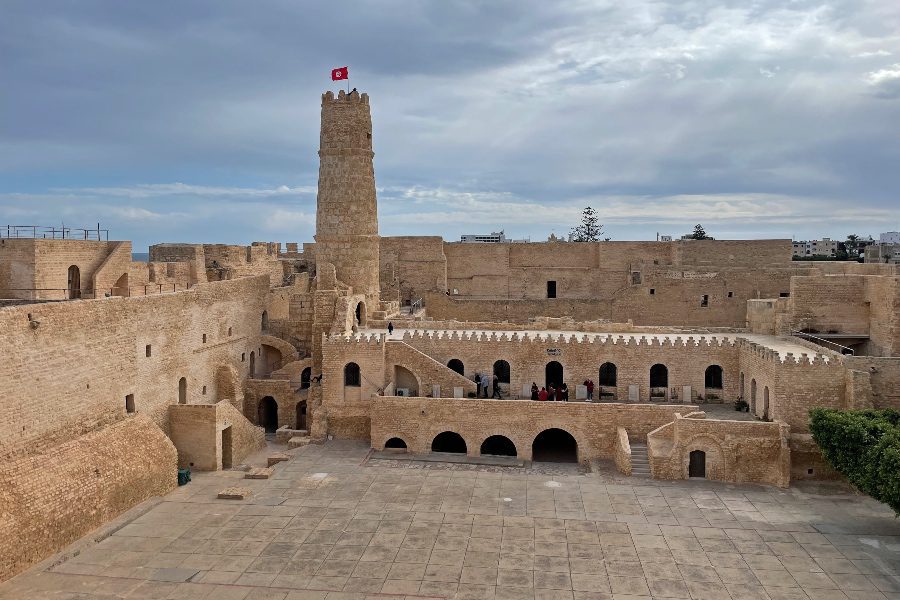
Afternoon in El Jem
Catch a louage back to Sousse and head down to El Jem. The louage ticket is 5.9 TND from Sousse to El Jem, allowing one hour journey time.
This was one of our absolute highlights of Tunisia – an ancient amphitheatre built by the Romans in 238AD. This is the largest and best-preserved Roman amphitheatre in Africa and it was designed to seat 35,000 people. This must be on anyone’s itinerary for Tunisia.
Entry is 12 TND each and be ready to be blown away!
For more detailed information and tips, read our post about how to get to El Jem in Tunisia using local transport.
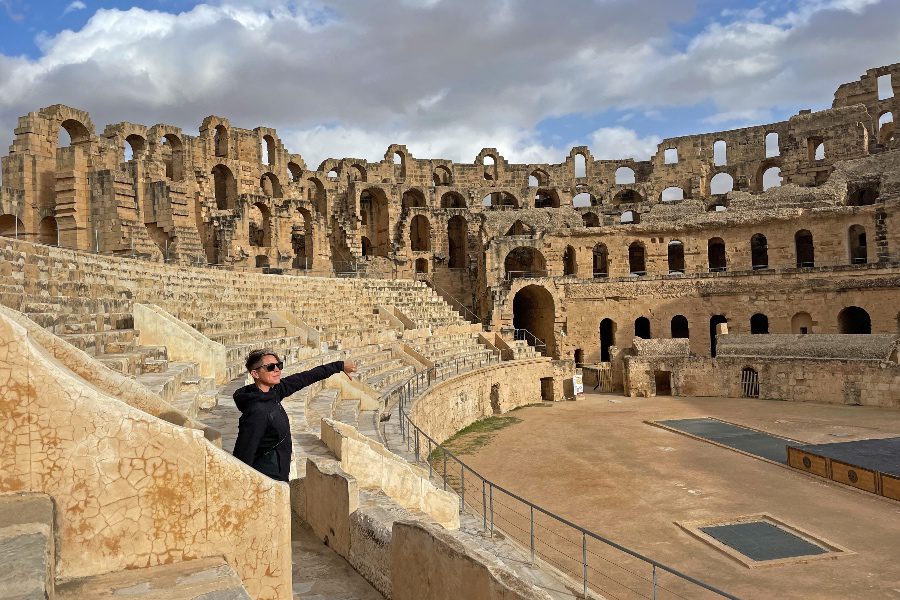
DAY 5: SOUSSE TO TATAOUINE
Distance: 405 km (5 hours 30 mins journey time in car)
A travel day to the south. Take a louage from Sousse to Medenine first. The price is 23.5 TND ($8.20), journey time is about 5.5 hours, including two brief bathroom stops and a 25 min stop for lunch.
Change to a different louage at Medenine station heading to Tataouine. The ticket is 3.65 TND ($1.30), journey time is 45 minutes.
Don’t miss the patisseries in Tataouine that have the special: Cornes de Gazzelle (crescent-shaped cookies filled with almond filling then fried in oil and soaked in honey)
Overnight at Auberge Alferdaous , a good budget option located in the centre of Tataouine .
The owner is a great guy, has fantastic English, and can give you some good tips for exploring the area.
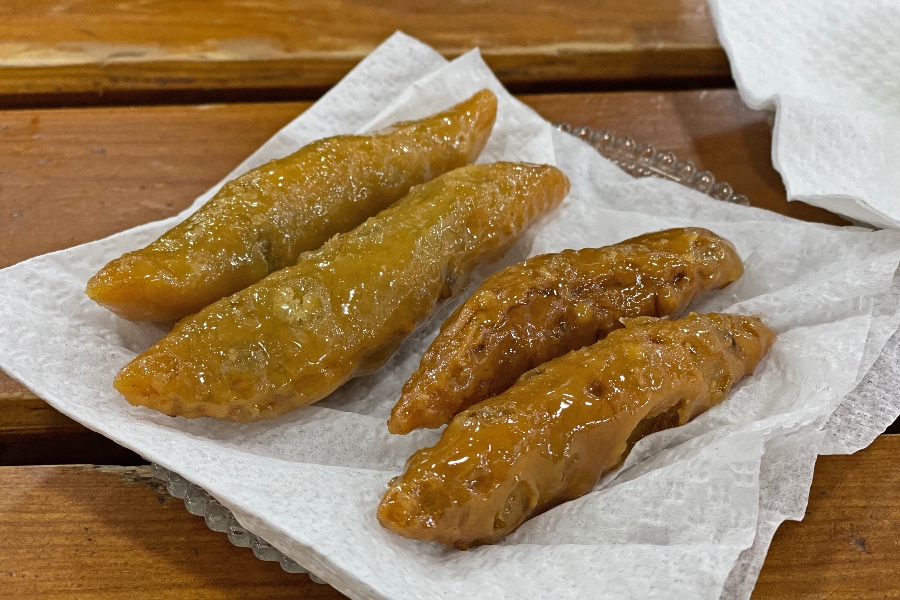
DAY 6: VISIT KSAR OULED AND MOVE TO CHENINI
Distance: Tataouine to Chenini 18 km (25 mins journey time in car)
Grab a cheap and easy breakfast in a bakery and head out (best to grab a taxi for 20 TND) to Ksar Ouled.
Alternatively, you can take louage for around 2.5 TND each, but it does take time to fill up with passengers here. However, if you have the time, it’s a cheap option.
This 15th-century granary is not to be missed. Not only because it was a set from Star Wars movies, but because it’s truly stunning.
You probably won’t need more than an hour here so it’s worth asking the taxi to wait or you can catch a louage back to Tataouine.
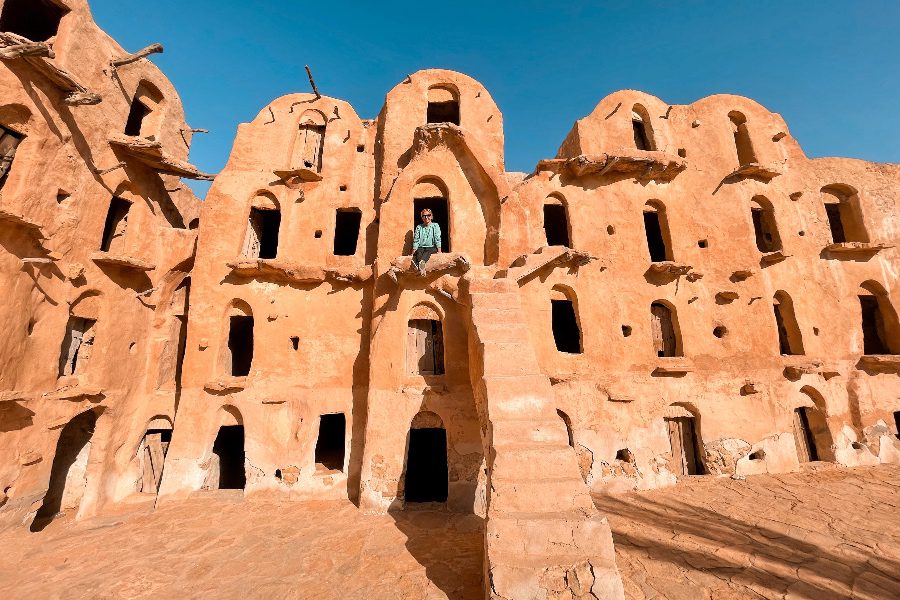
Grab lunch in Tataouine (I recommend Restaurant Sindbad for a good lunch menu) and then head out to Chenini.
It’s only about 20 minutes ride and the scenery is spectacular. We have stayed at Residence Kenza for another unique stay – in a cave. It was really cosy and had incredible views.
Chenini is a small village, part of it is an abandoned Berber stone village that you can stroll through on top of the hill.
There is a mosque on top of the hill and don’t miss the sunset or sunrise over the valley.
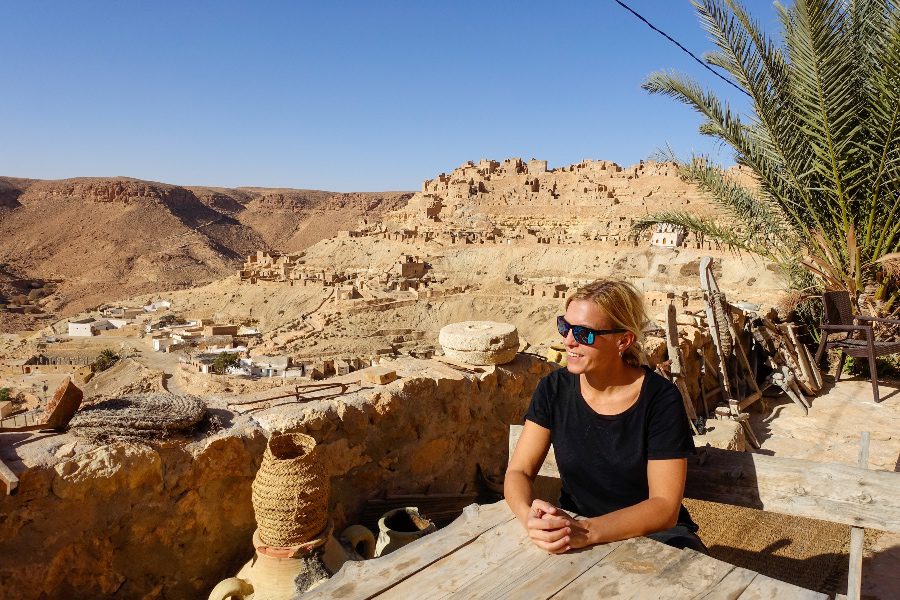
DAY 7: CHENINI TO DJERBA
Distance: 143 km (2 hours journey time in car)
Breakfast in Chenini, and then walk down the hill to catch a louage to Tataouine again. From here there are direct vans to Djerba.
The journey to Djerba was actually really quick and we had time to grab lunch once we arrived in Djerba near the louage station – Restaurant Central Djerba .
We took a taxi after a wonderful lunch of chicken and couscous (highly recommended) to our accommodation and checked in to enjoy the afternoon at leisure.
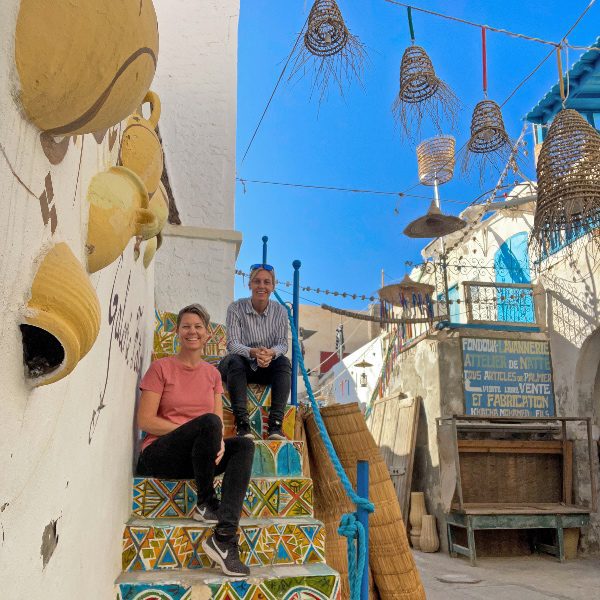
We treated ourselves in Djerba and found fantastic online rates (during late November) with Booking.com at Ulysse Palace Djerba Resort.
The resort is located approximately 9km from the centre of Djerba, however, private taxis are very affordable. We paid just a few dollars from Djerba directly to our resort (all taxis are metered).
If you’re looking for a good budget option in the heart of Djerba, I recommend Hôtel Olympic Djerba.
DAY 8: DJERBA ISLAND
Djerba is a really popular summer destination if you arrive during the summer or shoulder season.
As we visited in the cooler months, the old medina in Houmt Souk was so nice to walk around. Check out the souks, street art, maybe have a coffee in the trendy El Fondouk .
Don’t miss out on Djerbhood (street art event) and El Ghriba Synagogue.
If you have a few more days to play with, you can extend your time here.
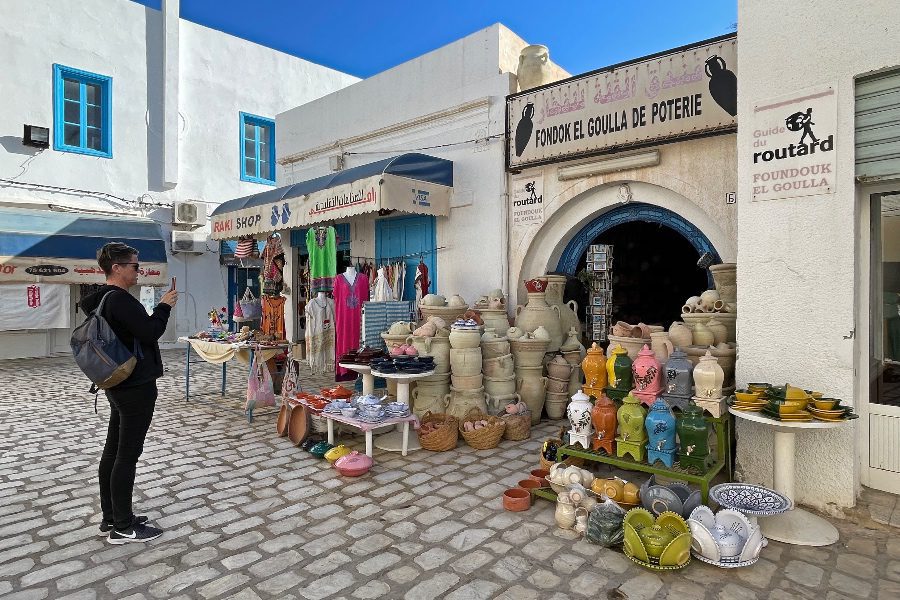
How to Get to El Jem in Tunisia
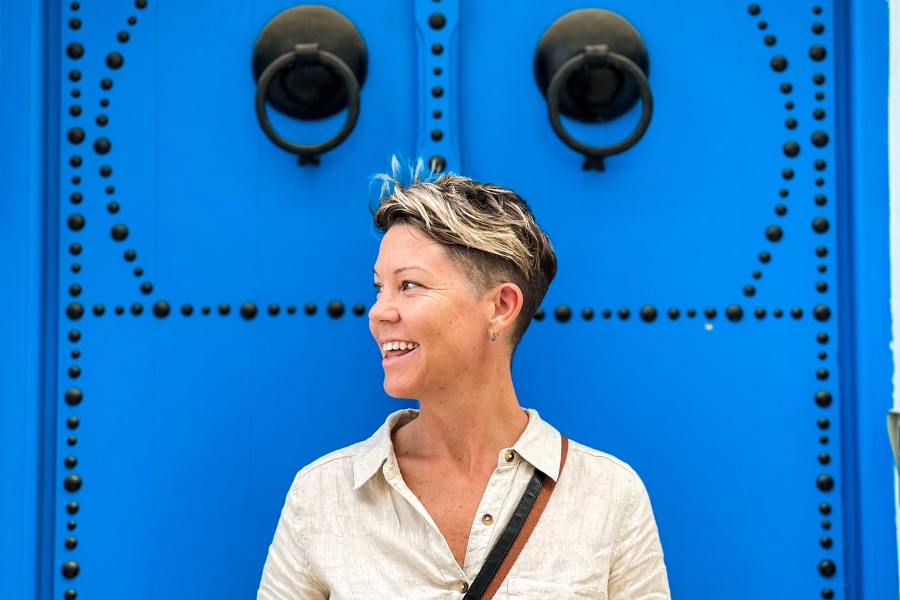
The Fascinating Medina in Tunis – 5 Unique Things To Do
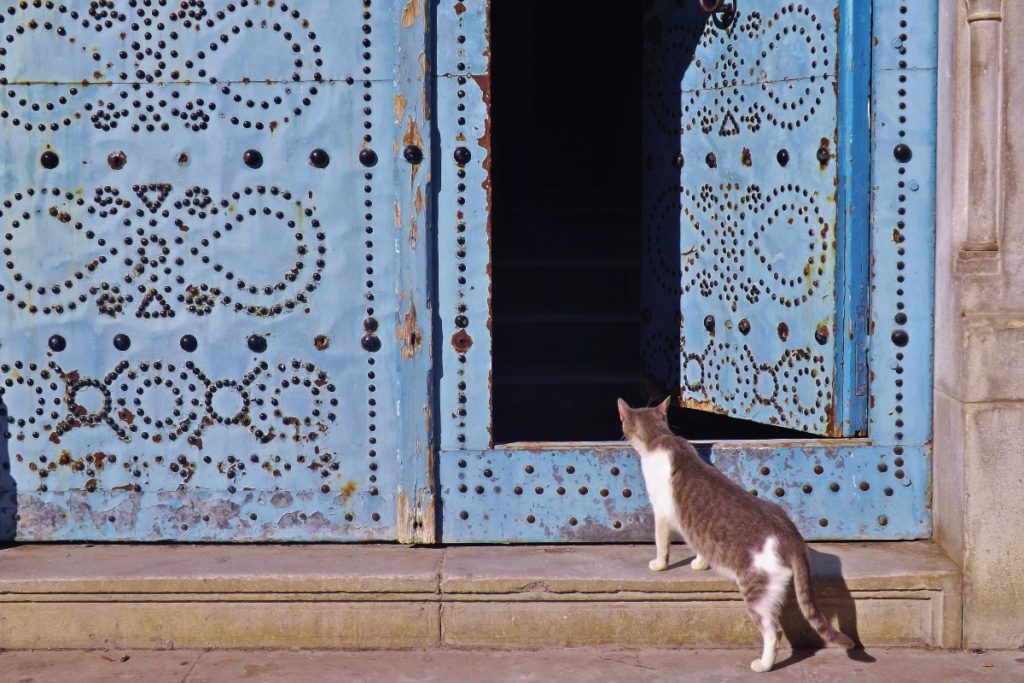
DAY 9: DJERBA TO MATMATA (STAY IN STAR WARS HOTEL)
Distance: 130 km (2 hours 45 mins journey time in car – allow time to change transport at stations)
From Djerba, you can head back north or if you only had 9-10 days you could simply fly out of Djerba as there are direct flights to France and Germany.
So you could alter your itinerary for Tunisia and fly from here. We always find the most competitive prices for flights using Skyscanner .
Subscribe to our newsletter!
Expert travel tips, resources and exclusive discounts worldwide
Getting north is easy. Once again catch the louage to Gabes and from there we took two vans to the small town of Matmata.
This place is known for troglodytes – houses that were built completely underground to keep cool during hot summers and warm in winter.
One of them, Hotel Sidriss has been turned into a hotel after it was used as the film set for Star Wars Episode 4 movie.
The hotel is very basic with shared bathrooms, but if you are a Star Wars fan it’s really cool to stay here. You can also just come in for a visit.
They charge 3 TND (1 euro) per person to come inside and explore.
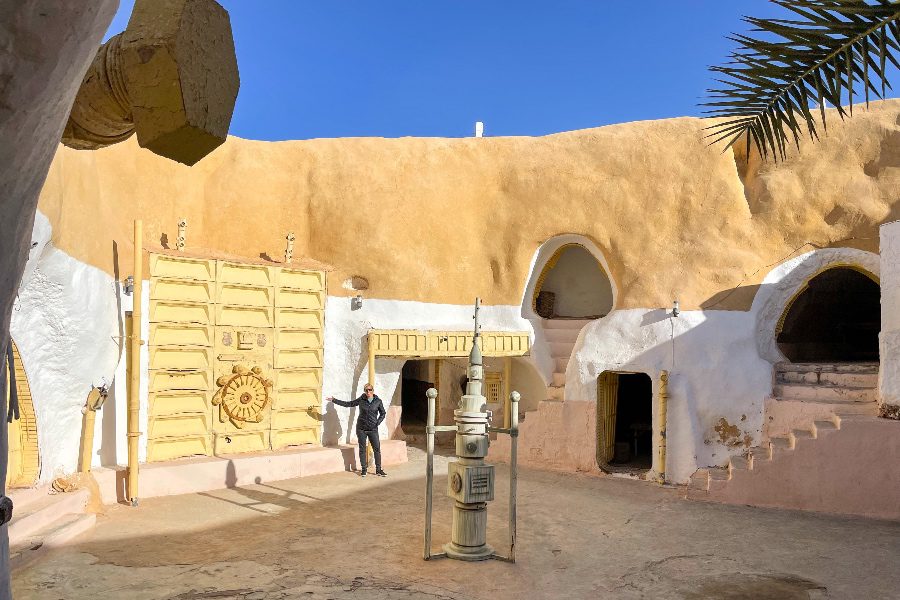
DAY 10: MATMATA TO TOZEUR
Distance: 215 km (3 hours 30 mins journey time in car – allow for time changing transport at station)
Another big day on the road, but plenty of scenery. You will need to change transport (Matmata Nouvelle a v Gabes).
Tozeur is a town surrounded by the Tunisian desert and it has a really unique feel. There are dates palms everywhere and the best dates come from here so make sure you buy some.
They’re incredibly affordable, only a couple of euros for 1kg.
The town architecture is another reason why Tozeur is so special, most buildings are decorated with small bricks, and especially the medina is a beautiful place to stroll through.
Today you should book your day trip for the next day – we booked it at the agency Au Coeur Du Desert across from our hotel, Residence El Arich .
The price quoted for a private 4WD with an English-speaking driver/guide for the day was 250 TND ($87).
The car can fit a maximum of 7 passengers, so if you have a group of people/friends to share the cost, it would considerably reduce the price per person.
We were happy to take the day trip with just the two of us and our driver/guide.
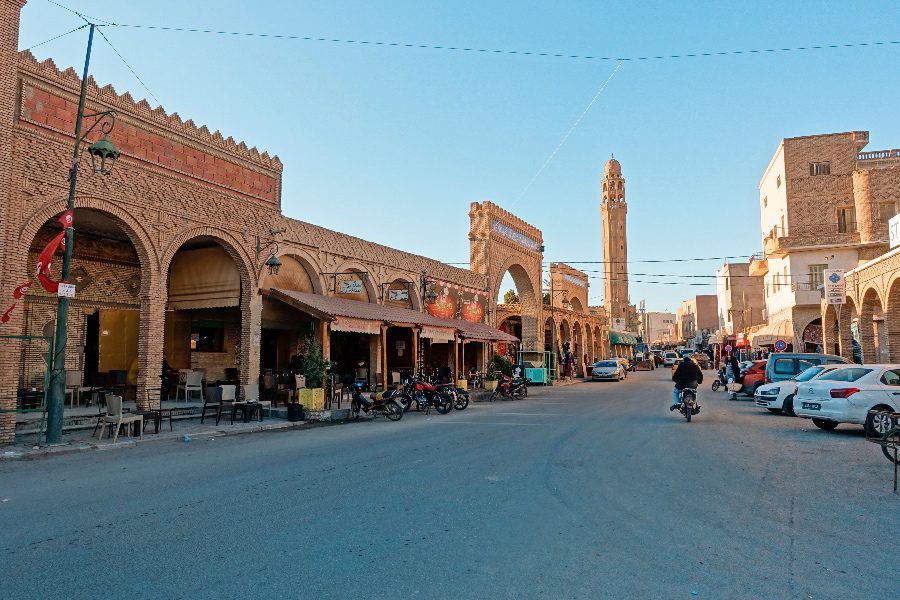
DAY 11: TOZEUR Day trip to Chebika – Tamerza – Mides – Ong Jmel
You can choose a half-day or full-day tour from Tozeur. We chose the full day one.
It included a stop at Chebika Oasis, where you visit an old village and walk down through the wadi and see the waterfall that brings life to this part of the desert.
Next is Tarmeza, another oasis village, and the gorgeous canyon at Mides. You stop for lunch and continue across the desert for some dune bashing in your 4WD to reach Mos Espa (Ong Jemel).
Travel to the Mos Espa film site, beautifully located amongst the Sahara dunes. Here, find the Pod-racing arena, the Mos Espa streets, Watto’s shop, the market, and Sebulba’s Café. Return to Tozeur at the end.
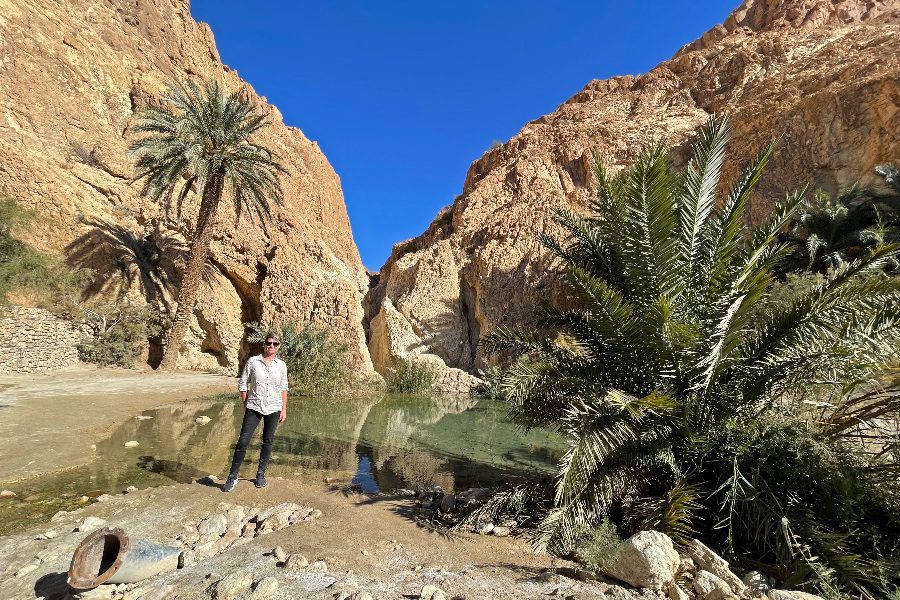
DAY 12: TOZEUR TO KAIROUAN
Distance: 295 km (4 hours 30 mins journey time in car)
Take a louage to Kairouan this morning, one of the holiest places of Islam in Tunisia and it was the first capital of the Maghreb.
A UNESCO World Heritage site, it conceals several marvels, but the medina and the Great Mosque are not to be missed.
Overnight: The budget option is to stay at Chema chaabani.
I’d recommend a very comfortable stay at Hotel Continenta l if you can afford to spend a little more.
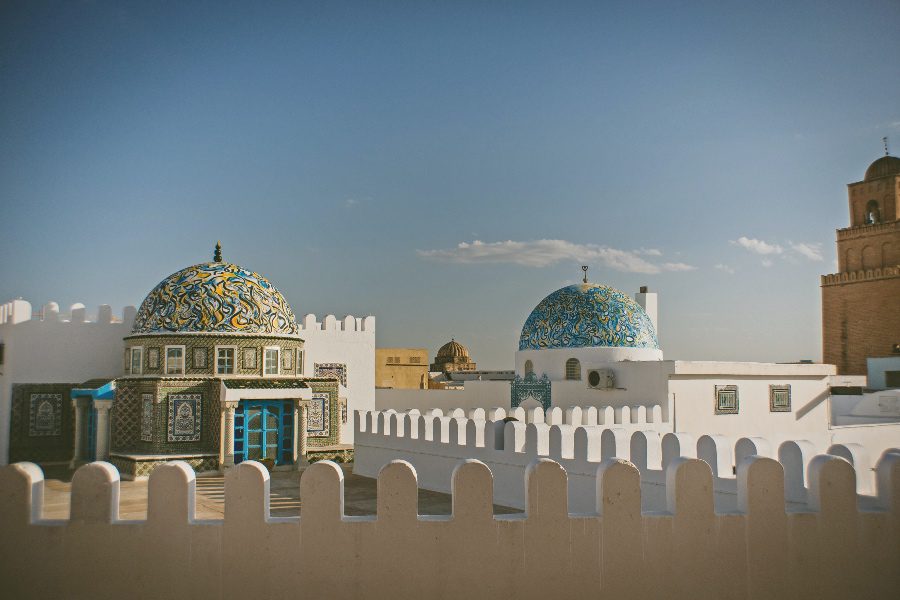
Get Connected with eSIM

Get connected easily on your travels—buy an eSIM! An eSIM works like an app: buy it, download it, and get connected in minutes! It’s easy, affordable, and convenient. Keep your original phone number, too!
Click below and view which eSIM data plan you need for your next adventure. Use our referral code: RACHEL5045 , to get $3 off your first purchase !
DAY 13: KAIROUAN TO TUNIS
Distance: 165 km (2 hours 20 mins journey time in car)
Spend the morning exploring Kairouan and depart to Tunis later on. Once you arrive in the capital, you can visit the medina or head to the Bardo museum – whatever you didn’t get to do in Tunis last time.
A suggestion for a comfortable, newly renovated business hotel in central Tunis is Golf Royal Hotel .
We stayed here for our final few nights in Tunis and highly recommend it. Good prices, comfortable beds, fantastic breakfast, and great service.
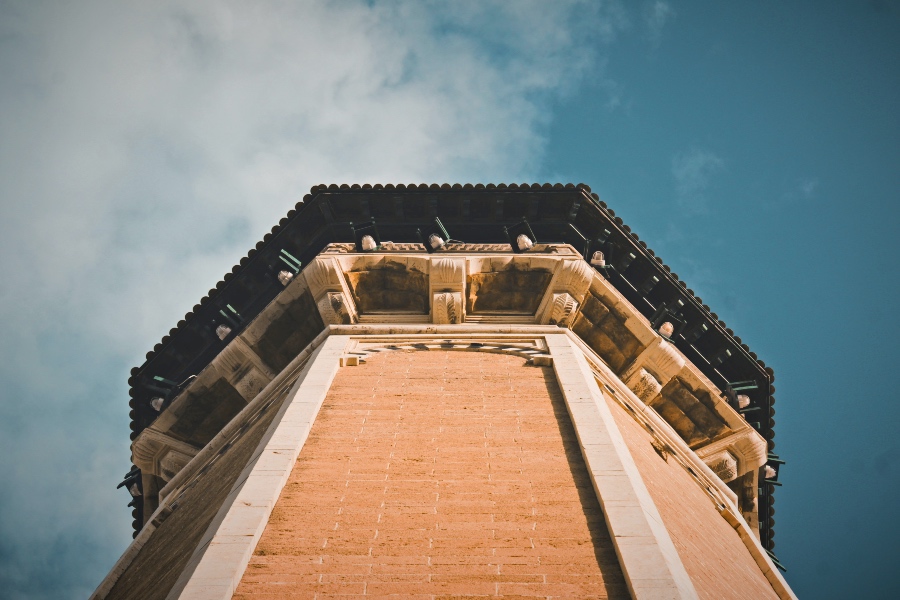
- 🔥 Hot Tip: Book accommodation in advance on Booking.com
- 🎟 Book your attractions and tickets online: We recommend Viator and GetYourGuide
- 🔋 Stay charged: This Belkin Power Bank is essential!
- 📸 Join a Group Tour: Find some amazing Group Tours here
- ✅ Get Connected with an eSIM: Fast, easy and affordable! View easy eSIM options here
DAY 14: TUNIS DEPARTURE DAY
Your itinerary for Tunisia ends in the capital. There is always plenty to do, see or eat in Tunis, depending on when your flight is.
Grab BOLT to the airport instead of a taxi, it will probably cost around 10-12 TND.
Travel Insurance for Tunisia
Make sure you get Travel Insurance before hitting the road. We recommend Heymondo & SafetyWing Travel Insurance.
Click here and get 5% off Heymondo from us!
Things to know before you travel to Tunisia
- Language: The official language is Arabic and French and English is not as common. Many people in the tourism industry speak Spanish and German as well.
- Cafes are often highly men-dominated. You can look for Salon du The for cafes that are more mixed and usually nicer.
- Food in Tunisia is amazing. Don’t miss our post about the 8 most popular Tunisian street foods to try while you’re here.
- Download the BOLT App before you arrive (or when you’re here). It will save you time and money. If your French or Arabic language skills are non-existent, this app will help you to get from A to B without any hassle.
- Always keep loose change and coins handy for paying for taxis, bottled water, or street food snacks.
- Internet connection isn’t great in Tunisia. I’d recommend picking up a SIM Card for your phone with one of the phone providers at the airport. There are several to choose from. I got an Orange SIM Card for free, then topped it up with 10GB for 20 TND (USD $7). You can get 2GB for 10 TND also, but if you’re travelling on my suggested itinerary for Tunisia, I’d recommend buying the larger package. Alternatively, the most convenient and affordable way to get connected in Tunisia is to buy this Tunisia eSIM Data Pack online.
- Keep any foreign currency receipts or ATM currency withdrawal receipts on you. At the end of your trip to Tunisia, ensure you convert all of your Tunisian Dinar to Euros/USD before you depart. Tunisian Dinars are impossible to exchange once you’ve departed the country. If you exchange currency at the airport before your departure, you may be asked for the receipt proving where you got the cash initially.
- Download Maps.me App on your phone, it’s a very useful offline map for Tunisia. I’d also recommend downloading an offline map of Tunisia on Google Maps as a backup to access maps if you cannot get online.
- Download Arabic and French in your Google Translate App. You never know when you may need to use it.
- To book any day trips or short multi-trips in Tunisia, we recommend Viator .

Travel Tips for Tunisia
We recommend you read our 10 best tips for independent travellers to Tunisia in the planning stages of your trip. These are essential things to know that will make your travels here much smoother.
Our post explaining 8 of the best street eats in Tunisia cannot be missed!
Also, it’s worth checking out our ESSENTIAL Packing List for Africa . We used this exact packing list to travel to all 54 African nations.
If you’re interested to read about some of our crazy adventures, our 2019 recap of our travels in West Africa will give you an idea of how it was. And, if you’re considering travelling to West Africa yourself, read these 17 Important Things to Know Before Travelling to West Africa .
For more travel advice, tips and useful websites we use to travel the world, head to our Travel Resources Page .
Travel Planning Resources
✈️ Flights : We use Skyscanner to book cheap flights worldwide.
🏨 Accommodation : Booking.com is our preferred platform for booking hotels and accommodation.
🏥 Travel Insurance : We recommend Heymondo ( Get 5% off Heymondo) & SafetyWing
🚌 Transportation : Trainline is the best website to reserve trains. We use Omio to book transport worldwide. For travel in Asia, we use 12Go.
🚘 Car Rental : We use DiscoverCars to book rental cars worldwide.
👫 Group Tours : G Adventures OR compare multi-day tours worldwide with Tourradar .
📸 Day Tours & Trips : GetYourGuide & Viator are the only two platforms you need.
📚 Lonely Planet: The Best Range of Travel Guides & Ebooks , and FREE Shipping! (use code RACHELDAVEY10 for a 10% discount)
🎒 Luggage : Osprey Farpoint 40L Backpack or Samsonite Luggage Range.
🛄 What to Pack: Don’t forget your Universal charger and a good power bank . To help you pack the essentials, here is our ULTIMATE Packing List for all Travellers .
🐶 Become a House Sitter: Join Trusted Housesitters and enjoy FREE accommodation worldwide. Use our invite to receive 25% off your new membership.
💰 Send Money Anywhere: WISE & Revolut are the best online accounts that let you send money, get paid, and spend money internationally. Both are so easy to use and way cheaper than any bank transfer.
📶 Stay Connected: Airalo eSIM allows you to get connected the moment you land at your destination, and you can avoid those expensive data roaming charges. We LOVE this product! Use promo code NOMAD15 for 15% off ALL eSIMs (new Airalo users only) OR use NOMAD10 for 10% off ALL eSIMs (for existing Airalo users)
✅ Check out our Travel Gear and Travel Resources for more valuable tips to save you money!
Tasty Food Adventures
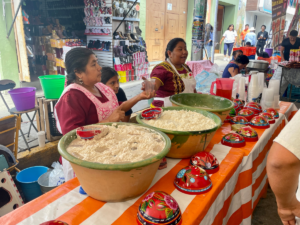
22 Most Popular Mexican Drinks

Food in the Philippines – 10 Most Popular Filipino Dishes
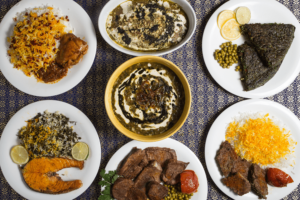
Top 10 Most Delicious Foods from Iran
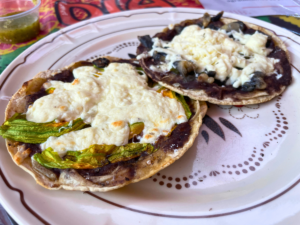
12 Best Breakfast Places in Oaxaca
See all Food Adventure blogs
Expert Travel Guides

10 EXCELLENT Reasons to Travel to Mexico
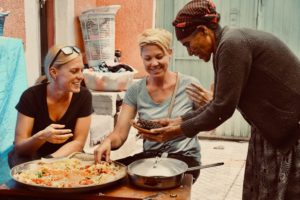
People you meet travelling the world

How to Visit Amazon Jungle Peru – Everything You Need to Know
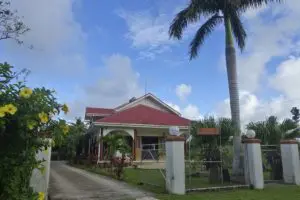
11 Best Budget Accommodation in Tonga
See all our Travel Guides
Trusted Hints & Tips
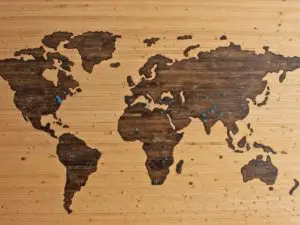
Visiting the New 7 Wonders of the World

21 Productive Things To Do When Bored

20 Signs You’re Addicted To Travel – How Many Apply To You?
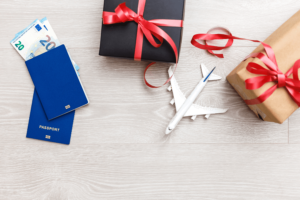
15 Best Travel Gifts for Women
See all our expert Hints & Tips
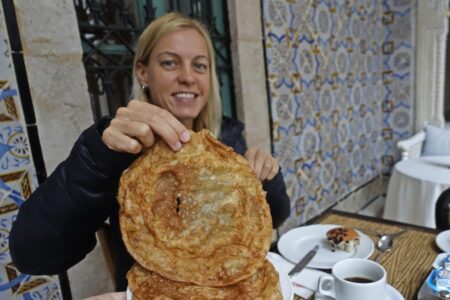
Street Food Tunisia – 8 Most Popular Eats
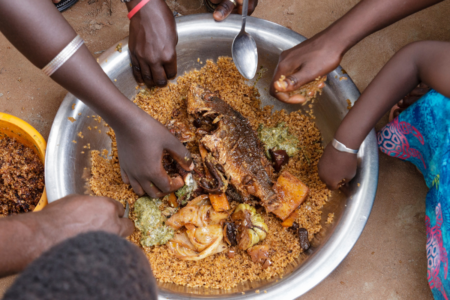
15 Most Popular Foods From Africa

14 Comments . Leave new
thank you for sharing your trip to Tunisia it was definitely helpful.
Thank you, we’re really happy you found value in our post. Happy Travels!
Hi both I stumbled across this page while searching for info and tips on our upcoming trip to Tunisia in 2 months time This itinerary looks spot on, and touches all the things I wanted to see. We just decided to go louage rather than car rental, despite travelling with childre. One thing that I think would bring this page onto a completely new level of usefulness would be having rough estimates of times and costs involved in all the city to city trips: it’s great knowing that you can do Tozeur to Matmata (or the other way round) by louage, but it would even better to know roughly if it’s 2hr, 4hr, 6 hr, etc.. just to plan the itinerary! Anyway, thanks for all the tips and info, really great job!! Giovanni
Thanks for your feedback Giovanni, well noted. We hope you have a fantastic time in Tunisia 😉
Following up on my previous comment, can you remember how long it took you from Kairouan to Tunis (assuming by louage)? we plan to do it the other way round, but distances and times should be the same! thanks Giovanni
Yes, we took a louage taxi and the journey took about 2 hours. It was direct and they drive pretty fast on those roads.
Thanks for this info!! It was really helpful X About how much would you recommend to budget for a 9day trip (very roughly lol) ? Thanks Riya
Based on our trip, we roughly spent around 30 USD per night on accommodation (clean, comfortable rooms in good locations). Food is very affordable, so you can eat street food and great French pastries with coffee for only a dollar or two. It’s easy to find some great sit-down lunches and dinners for around $3.50 – 4.00 pp for a huge couscous with chicken/veg. Transport and getting around is affordable too, if you use Bolt app for short rides and louage (shared taxi) between cities and longer drives.
Roughly, we spent between USD $40-70 per day in total, and we’re two people. So yes, Tunisia can be a very affordable place to travel if you need to stick to a budget. Hope that helps 🙂
These two blogs I wrote below may be quite useful if you’re planning to travel to Tunisa.
– https://www.veryhungrynomads.com/10-best-tips-for-travel-in-tunisia/ – https://www.veryhungrynomads.com/street-food-tunisia-8-most-popular-eats/
Hello, thanks for your blog. I wanted yo ask you if the visits around Tozeur (oasis, canyon, mos espa) can be fone by our own means. With a normal car?
A second question is if djerba in winter for 2 days and 1 night is a place that we shall not miss. I am asking as it is relatively far.
Hi Carlos, I think you could do some self-driving in Tozeur with a normal car, but there are parts you need 4WD (I remember driving on sand when visiting oasis, the Star Wars city etc). As for Djerba, it will probably be quiet and cooler in winter, so might be worth to skip it. Hope that helps. 🙂
Hello, thanks for sharing the tips in your blog! I am travelling to Tunisia soon, and would like to ask if it’s possible to travel to Tatatouine straight after visiting El Jem? Would there be louages from Sousse to Tatatouine say 12pm onwards? By any chance do you know the opening hrs for louages?
We can’t answer for sure whether there would be louage from El Jem or Sousse to Tatouine around that time, but we imagine so. Sousse is a very busy hub or louage station for shared taxis going in all directions..and remember that the cars depart once they fill all seats. This is the primary way that all people move around in Tunisia. And, if you don’t have a car going all the way, perhaps there might be a car going to the city of Gabes, and then you could continue the next morning. Happy travels 🙂
Hello, I went through your blog and it was pretty detailed. I absolutely loved it. Just wanted to ask you if it’s possible to cover Djerba-Matmata-Tozuer in one day? Like starting from Djerba quite early, going to Matmata just to see the troglodytes up close and then head over to Tozeur for the night stay? I know it sounds very hectic, but we are very short of time. I was hoping it can be possible. We’ll not have any car with us, we are solely depending on public transport systems, preferably the louages. Thanks in advance!
Hi Shalini,
Yes, this journey would be possible – as you mentioned, you must get an early start to this day from Djerba. And, if you’re hoping to do a tour around Tozeur the following day (if you’re short on time), it may be an idea to book it online and get a confirmed trip (some suggestions in our blog to do this), or possibly call ahead and see if your hotel can arrange a guide/driver for you.
Happy Travels! This is such a fascinating area of Tunisia to explore 😉
Leave a Reply Cancel reply
Your email address will not be published. Required fields are marked *
Post Comment
Cost of a Trip to Tunis, TN & the Cheapest Time to Visit Tunis
The average price of a 7-day trip to Tunis is $1,366 for a solo traveler, $2,453 for a couple, and $4,599 for a family of 4 . Tunis hotels range from $38 to $173 per night with an average of $67, while most vacation rentals will cost $100 to $320 per night for the entire home. Average worldwide flight costs to Carthage Airport ( TUN ) are between $970 and $1,295 per person for economy flights and $3,044 to $4,064 for first class. Depending on activities, we recommend budgeting $28 to $65 per person per day for transportation and enjoying local restaurants.
See below for average , budget , and luxury trip costs. You can also look up flight costs from your airport for more tailored flight pricing.
The Cheapest Times to Visit Tunis, TN
On average, these will be the cheapest dates to fly to TUN and stay in a Tunis hotel:
- January 1st to April 1st
- September 10th to December 9th
The absolute cheapest time to take a vacation in Tunis is usually early October .
Average Tunis Trip Costs
Average solo traveler.
The average cost for one person to visit Tunis for a week is $1,040-$1,927 ($149-$275 per day)
Food, Travel, and Sightseeing : $28 to $65 per day for one person’s daily expenses
Flights : $586 to $1,088 for economy
Lodging : $48 to $64 per night for one 2 or 3-star hotel room
or $43 to $53 per night for a 1-bed vacation rental
Average Couple’s Trip
The average cost for a couple to visit Tunis for a week is $2,590-$3,884 ($370-$555 per day)
Food, Travel, and Sightseeing : $56 to $130 per day for two people’s daily expenses
Flights : $1,172 to $2,176 for economy
Average Family Vacation
The average cost for 4 people to visit Tunis for a week is $3,542-$6,940 ($506-$991 per day)
Food, Travel, and Sightseeing : $112 to $260 per day for four people’s daily expenses
Flights : $2,344 to $4,352 for economy
Lodging : $96 to $128 per night for two 2 or 3-star hotel rooms
or $69 to $80 per night for a 2-bed vacation rental
Traveling Cheap to Tunis
How cheap can you make a vacation to Tunis? The cheapest trip to Tunis is about $115 per person per day for travelers willing to take standby flights, deal with inconvenience, and otherwise limit travel expenses. About 11% of rentals are available in the $0 to $100 range for an entire place, and vacation rentals can be booked for as low as $20 per night. These inexpensive rentals must be booked as early as possible and may not be in the most desirable areas. 1-star hotels are more likely to be available, with rooms starting at around $33.
Even cheaper trips are possible depending on where you live and whether you can drive. Check the cheapest times to fly for more saving ideas.
Budget Solo Traveler
The lowest cost for one person to visit Tunis for a week is $804-$1,651 ($115-$236 per day)
Food, Travel, and Sightseeing : $14 to $29 per day for one person’s daily expenses
Lodging : $33 to $38 per night for one 1-star hotel room
or $20 to $60 per night for a 1-bed vacation rental
Budget Couple’s Trip
The lowest cost for a couple to visit Tunis for a week is $1,488-$2,942 ($213-$420 per day)
Food, Travel, and Sightseeing : $28 to $58 per day for two people’s daily expenses
Budget Family Vacation
The lowest cost for 4 people to visit Tunis for a week is $2,916-$5,668 ($417-$810 per day)
Food, Travel, and Sightseeing : $56 to $116 per day for four people’s daily expenses
Lodging : $66 to $76 per night for two 1-star hotel rooms
or $30 to $84 per night for a 2-bed vacation rental
Overall it is easy to travel to Tunis cheaply.
The Cost of a Luxury Tunis Trip
There is no true ceiling on the cost of a luxury trip, so our estimates are based on what most people do in Tunis.
Luxury Solo Traveler
The high-end price for one person to visit Tunis for a week is $2,195-$7,829 ($314-$1,118 per day)
Food, Travel, and Sightseeing : $59 to $130 per day for one person’s daily expenses
Flights : $1,266 to $3,079 for first class
Lodging : $86 to $173 per night for one 4 or 5-star hotel room
or $320 to $640 per night for a preferred vacation rental
Luxury Couple’s Trip
The high-end price for a couple to visit Tunis for a week is $3,874-$11,818 ($553-$1,688 per day)
Food, Travel, and Sightseeing : $118 to $260 per day for two people’s daily expenses
Flights : $2,532 to $6,158 for first class
Luxury Family Vacation
The high-end price for 4 people to visit Tunis for a week is $7,748-$21,716 ($1,107-$3,102 per day)
Food, Travel, and Sightseeing : $236 to $520 per day for four people’s daily expenses
Flights : $5,064 to $12,316 for first class
Lodging : $172 to $346 per night for two 4 or 5-star hotel rooms
or $512 to $960 per night for a preferred vacation rental
Tunis Hotel Prices
The cost of staying in Tunis is lower than the average city. On average hotels are less expensive than vacation rentals. Luxury vacation rentals are more expensive in Tunis due to very high property costs. The graphs below show how much cost can vary depending on the type of experience you’re looking for.
Tunis Lodging Cost by Star Status
The average price for the class of hotel is on the (y) axis. The hotel class (out of 5 stars) is on the (x) axis.
Prices are based on Tunis hotel averages and may not reflect current prices. In some cases, we extrapolate prices to estimate costs, and hotels with your desired star rating may not be available.
Vacation Rental Prices
The percent of vacation rentals in the price range is on the left (y) axis. Price range is on the bottom (x) axis.
There are a healthy amount of vacation rentals serving all budgets in Tunis.
Flight Costs to Tunis
Averaging flights around the world, prices go from a high of $1,295 average in mid December to a low of $970 in early October. Median flight price is $1,212. These prices are based on millions of flights. For Tunis our data includes 170 originating airports, and 107 airlines. The area has average variance in price compared with other locations. Flying to Tunis from an airport like Martha’s Vineyard ( MVY ) in Martha’s Vineyard, MA (the United States) for an average $5,746 trip fare will obviously cost a lot more than from an airport like Lyon Saint Exupery ( LYS ) in Lyon (France) at an average of just $201.
Average Flight Cost by Season
Average flight cost by day of week.
The cheapest day to fly in is typically Tuesday, and the cheapest day to fly back is usually Tuesday. Click here to see data for the cost of flights from your airport. In Tunis, the difference between the cheapest and the most expensive week is about $325, so you can easily save about 33% simply by using our free flight guides and booking in advance.
Daily Expenses Budget
Daily vacation expenses vary more based on what you’re interested in doing. A fine dining restaurant with drinks around Tunis can easily cost $220 per person or more, while a standard nice meal might be about $14 per person. Private tours can cost $432 per day, but self-guided tours to see the outdoor sights can be free. Costs vary wildly, so recommendations are made based on the cost of living and averages we see for this type of vacation.
Other Tunis Guides
Travel costs nearby.
- Ariana, Tunisia
- Aryanah, Tunisia
- Gammarth, Tunisia
- La Soukra, Tunisia
- El Aouina, Tunisia
- La Marsa, Tunisia
- Carthage, Tunisia
- Le Kram, Tunisia
- Sidi Bou Said, Tunisia
- Ezzahra, Tunisia
Travel Costs in Popular Places
- Glasgow, the United Kingdom
- Karon, Thailand
- Krakow, Poland
Update April 12, 2024
Information for u.s. citizens in the middle east.
- Travel Advisories |
- Contact Us |
- MyTravelGov |
Find U.S. Embassies & Consulates
Travel.state.gov, congressional liaison, special issuance agency, u.s. passports, international travel, intercountry adoption, international parental child abduction, records and authentications, popular links, travel advisories, mytravelgov, stay connected, legal resources, legal information, info for u.s. law enforcement, replace or certify documents.
Before You Go
Learn About Your Destination
While Abroad
Emergencies
Share this page:
Travel Advisory July 13, 2023
Tunisia - level 2: exercise increased caution.
Reissued with obsolete COVID-19 page links removed.
Exercise increased caution in Tunisia due to terrorism. Some areas have increased risk. Read the entire Travel Advisory.
Do not travel to:
- Within 30 km of southeastern Tunisia along the border with Libya due to terrorism.
- Mountainous areas in the country’s west, including the Chaambi Mountain National Park area, due to terrorism.
- The desert south of Remada due to the military zone.
- Jendouba south of Ain Drahem and west of RN15, El Kef, and Kasserine, next to the Algerian border due to terrorism.
- Sidi Bou Zid in central Tunisia due to terrorism.
Country Summary: Terrorist groups continue plotting possible attacks in Tunisia. Terrorists may attack with little or no warning, targeting tourist locations, transportation hubs, museums, resorts, hotels, festivals, nightclubs, restaurants, religious sites, markets/shopping malls, government facilities and security forces. A country-wide state of emergency, which grants security forces more authority to maintain civil order and enables the government to focus on combating terrorism, is in effect.
The U.S. government has limited ability to provide emergency services to U.S. citizens in some areas of Tunisia. U.S. government employees must obtain special authorization to travel outside greater Tunis.
Read the country information page for additional information on travel to Tunisia.
If you decide to travel to Tunisia:
- Exercise caution when using public transportation, due to safety and security concerns.
- Avoid demonstrations and crowds.
- Monitor local media for breaking events and be prepared to adjust your plans.
- Avoid staying overnight outside of the main cities and tourist locations.
- Obtain comprehensive medical insurance that includes medical evacuation.
- Enroll in the Smart Traveler Enrollment Program (STEP) to receive Alerts and make it easier to locate you in an emergency.
- Follow the Department of State on Facebook and Twitter .
- Follow the U.S. Embassy in Tunisia on Facebook and Twitter .
- Review the Country Security Report for Tunisia.
- Visit the CDC page for the latest Travel Health Information related to your travel.
- Prepare a contingency plan for emergency situations. Review the Traveler’s Checklist .
Border with Libya – Level 4: Do Not Travel
Developments in Libya continue to affect the security situation along the Tunisian-Libyan border in areas such as Ras Jedir and Dehiba along with the cities of Ben Guerdan and Medenine. The border with Libya is frequently closed to all traffic with short notice for extended periods. The Department of State advises U.S. citizens not to travel to Libya.
Visit our website for Travel to High-Risk Areas .
Western Mountains and Chaambi Mountain National Park – Level 4: Do Not Travel
Terrorist groups continue to operate in mountains of Western Tunisia.
The Desert South of Remada – Level 4: Do Not Travel
The desert south of Remada is designated as a military zone by the Government of Tunisia. Special authorization is required for travelers wishing to enter the military zone.
Jendouba El Kef and Kasserine near the Algerian Border – Level 4: Do Not Travel
Terrorist groups continue to operate in these areas.
Sidi Bou Zid in Central Tunisia – Level 4: Do Not Travel
Terrorist groups continue to operate in this area.
Embassy Messages
View Alerts and Messages Archive
Quick Facts
1 page per stamp
Not required for stays under 90 days
Import of Tunisian currency is prohibited. Visitors must declare cash brought into Tunisia in excess of TND 10,000 (or foreign currency equivalent). They must declare amounts above TND 5,000 if they wish to export that amount upon departure.
Export of Tunisian currency is prohibited. Up to TND 3,000 may be re-exchanged into foreign currency upon departure from Tunisia with the original exchange receipt. Visitors may only export up to TND 5,000 (or foreign currency equivalent) if that amount was declared upon arrival.
Embassies and Consulates
U.S. Embassy Tunis Les Berges du Lac 1053 Tunis, Tunisia Telephone: +(216) 71-107-000 Emergency after-hours telephone: +(216) 71-107-000, press 0 and ask for the duty officer Fax: +(216) 71964-360 Email: [email protected]
Destination Description
See the Department of State’s Fact Sheet on Tunisia for information on U.S.-Tunisia relations.
Entry, Exit and Visa Requirements
Please visit the Embassy's COVID-19 page for more information on COVID-19 in Tunisia.
Passports and Visas:
- A valid passport is required.
- For U.S. passport holders, a visa is not necessary for stays up to 90 days.
- A residence permit is needed for stays longer than 90 days. The residence permit can be obtained from the central police station of the district of residence.
- U.S. citizens born in the Middle East or with Arabic names have experienced delays in clearing immigration upon arrival.
- U.S. citizens of Tunisian origin and dual American-Tunisian citizens are expected to enter and exit Tunisia on their Tunisian passports. If a Tunisian-American succeeds in entering using a U.S. passport, he or she will still have to present a valid Tunisian passport to exit the country.
The U.S. Department of State is unaware of any HIV/AIDS entry restrictions for visitors to or foreign residents of Tunisia.
Find information on dual nationality , prevention of international child abduction and customs regulations on our websites.
Safety and Security
Terrorism: Terrorist groups and those inspired by such organizations are intent on attacking U.S. citizens abroad. Terrorists are increasingly using less sophisticated methods of attack – including knives, firearms, and vehicles – and most often target police and military forces in Tunisia. Terrorists may also target crowds and unprotected or vulnerable targets, such as:
- High-profile public events (sporting contests, political rallies, demonstrations, holiday events, celebratory gatherings, etc.)
- Hotels, clubs, and restaurants frequented by tourists
- Places of worship
- Shopping malls and markets
- Public transportation systems (including subways, buses, trains, and scheduled commercial flights)
The U.S. Department of State recommends that U.S. citizens in Tunisia maintain a high level of vigilance throughout the country. U.S. citizens living and working in Tunisia should understand that they accept the risks of remaining in the country and should carefully consider those risks. The threat of anti-Western terrorist activity persists, as does the risk of death or injury as a non-targeted bystander.
Specific Areas to Avoid: Embassy Tunis regulations require advance notification to Embassy security officials of travel by Embassy personnel outside greater Tunis. Certain cities and governorates in Tunisia have a fluid and unpredictable security environment, and these areas require additional scrutiny before U.S. government personnel may travel to them. U.S. citizens should avoid the following areas due to terrorist activity:
- Within 30 km of Libyan border in southeastern Tunisia.
- Mountainous areas in the west of the country, including the Chaambi Mountain National Park area.
- Jendouba south of Ain Drahem and west of RN15, El Kef, and Kasserine, next to the Algerian border.
- Gafsa and Sidi Bou Zid in central Tunisia.
The following groups, including ones on the U.S. government’s list of designated Foreign Terrorist Organizations, pose a high risk to U.S. citizens in the region:
- The Islamic State of Iraq and the Levant (ISIS)
- Al-Qa’ida in the Islamic Maghreb (AQIM)
- Ansar al-Sharia in Tunisia (AAS-T)
For more information, see our Terrorism page.
Crime:
- Travelers should remain vigilant of their surroundings and take care to secure their valuables. Prominently displayed cash or jewelry may attract unwanted attention.
- High-value items left unattended and visible have been stolen from vehicles, hotel rooms, and private residences.
- Criminals have targeted tourists and business travelers for theft, pick pocketing, and scams.
- Incidents of theft, robbery, and burglary have been reported in upscale neighborhoods during day and night. Violent crime is rare, however, an increase in incidents of harassment and assaults against women have been reported in Tunis among the expatriate community. Some of these criminal encounters occurred in dark or isolated areas surrounding commercial zones, public beaches, and parks.
- Any crimes against U.S. citizens should be reported immediately to the local police and the U.S. Embassy.
- Report suspicious activity to the local police.
Demonstrations: They may take place in response to political or economic issues, on politically significant holidays, and during international events. Demonstrations are most common on Saturday mornings and in the month of January.
- Demonstrations can be unpredictable. Avoid areas around protests and demonstrations.
- Past demonstrations have turned violent.
- Check local media for updates and traffic advisories.
International Financial Scams: Internet romance and financial scams are prevalent in Tunisia. Scams are often initiated through Internet postings/profiles or by unsolicited emails and letters. Financial scammers almost always pose as U.S. citizens who have no one else to turn to for help. Common scams include:
- Romance/Online dating
- Money transfers
- Lucrative sales
- Gold purchase
- Contracts with promises of large commissions
- Grandparent/Relative targeting
- Free Trip/Luggage
- Inheritance notices
- Work permits/job offers
- Bank overpayments
See the Department of State and the FBI pages for information.
Victims of Crime: Report crimes to the local police at 197 and contact the U.S. Embassy at +(216) 71-107-000. Remember that local authorities are responsible for investigating and prosecuting crime.
- Help you find appropriate medical care
- Assist you in reporting a crime to the police
- Contact relatives or friends with your written consent
- Provide general information regarding the victim’s role during the local investigation and following its conclusion
- Provide a list of local attorneys
- Provide our information on United States
- Provide an emergency loan for repatriation to the United States and/or limited medical support in cases of destitution
- Help you find accommodation and arrange flights home
- Replace a stolen or lost passport
See our webpage on help for U.S. victims of crime overseas .
Domestic Violence: U.S. citizen victims of domestic violence are encouraged to contact the Embassy for assistance.
Tourism: The tourism industry is generally regulated and rules with regards to best practices and safety inspections are regularly enforced. Hazardous areas/activities are identified with appropriate signage and professional staff is typically on hand in support of organized activities. In the event of an injury, appropriate medical treatment is widely available throughout Tunisia. Outside of a major metropolitan center, it may take more time for first responders and medical professionals to stabilize a patient and provide life-saving assistance. U.S. citizens are encouraged to purchase medical evacuation insurance.
The Tunisian National Guard encourages persons traveling into the desert to register their travel beforehand.
- No special authorization is required to travel to the desert as far south as Remada.
- The desert south of Remada is designated as a military zone by the Government of Tunisia. If travelers wish to enter the military zone, for example to travel to Borma, a special authorization is required. The Department of State advises U.S. citizens against travel to this area.
- Please visit the Embassy’s desert travel page .
See our webpage for more information on insurance providers for overseas coverage ( http://travel.state.gov/content/passports/en/go/health/insurance-providers.html ).
Local Laws & Special Circumstances
Criminal Penalties: You are subject to local laws. If you violate local laws, even unknowingly, you may be expelled, arrested, or imprisoned. Individuals establishing a business or practicing a profession that requires additional permits or licensing should seek information from the competent local authorities, prior to practicing or operating a business.
- Penalties for possessing, using, or trafficking in illegal drugs in Tunisia are severe, and convicted offenders can expect long jail sentences and heavy fines.
- You may be taken in for questioning if you don’t have your passport with you or if you take pictures of certain buildings.
- It is against Tunisian law to photograph police, military, and government buildings.
- Driving under the influence of alcohol could land you immediately in jail.
- If you break local laws in Tunisia, your U.S. passport won’t help you avoid arrest or prosecution.
Furthermore, some laws are also prosecutable in the United States, regardless of local law. For examples, see our website on crimes against minors abroad and the Department of Justice website.
Arrest Notification: If you are arrested or detained, ask police or prison officials to notify the U.S. Embassy immediately. See our webpage for further information.
Counterfeit and Pirated Goods: Although counterfeit and pirated goods are prevalent in many countries, they may still be illegal according to local laws. You may also pay fines or have to give them up if you bring them back to the United States. See the U.S. Department of Justice website for more information.
Faith-Based Travelers: See the following webpages for details:
- Faith-Based Travel Information
- International Religious Freedom Report – see Tunisia reports
- Human Rights Report – see Tunisia reports
- Hajj Fact Sheet for Travelers
- Best Practices for Volunteering Abroad
LGBTQI+ Travelers: Consensual same-sex sexual relations are criminalized in Tunisia. Penalties include sentences of up to three years in prison.
See our LGBTQI+ Travel Information page and section 6 of our Human Rights report for further details.
Travelers with Disabilities: The law in Tunisia prohibits discrimination against persons with disabilities, and the law is generally enforced. Social acceptance of persons with disabilities in public is as prevalent as in the United States. Expect accessibility to be limited in public transportation, lodging, communication/information, and general infrastructure.
Students: See our Students Abroad page and FBI travel tips .
Women Travelers: See our travel tips for Women Travelers .
For emergency services in Tunisia, dial 190.
Ambulance services are:
- not widely available and training and availability of emergency responders may be below U.S. standards.
- not present throughout Tunisia or are unreliable in most areas except Tunis, Sfax, Sousse, and Monastir.
- not equipped with state-of-the-art medical equipment.
- not always staffed with trained paramedics and often have little or no medical equipment.
We do not pay medical bills. Be aware that U.S. Medicare/Medicaid does not apply overseas. Most hospitals and doctors overseas do not accept U.S. health insurance.
Medical Insurance: Make sure your health insurance plan provides coverage overseas. Most care providers overseas only accept cash payments. See our webpage for more information on insurance providers for overseas coverage. Visit the U.S. Centers for Disease Control and Prevention for more information on type of insurance you should consider before you travel overseas.
We strongly recommend supplemental insurance to cover medical evacuation.
Always carry your prescription medication in original packaging, along with your doctor’s prescription. Check with the Tunisia Ministry of Public Health or the Central Pharmacy of Tunisia to ensure the medication is legal in Tunisia.
Vaccinations: Be up-to-date on all vaccinations recommended by the U.S. Centers for Disease Control and Prevention.
Further health information:
- World Health Organization
- U.S. Centers for Disease Control and Prevention (CDC)
Air Quality: Air pollution is a moderate problem in major cities in Tunisia. Consider the impact seasonal smog and heavy particulate pollution may have on you and consult your doctor before traveling if necessary.
Visit AirNow Department of State for information on air quality at U.S. Embassies and Consulates.
The U.S. Embassy maintains a list of doctors and hospitals . We do not endorse or recommend any specific medical provider or clinic.
Health facilities in general:
- Adequate but below U.S. standards health facilities are available in Tunis and other major cities.
- Public medical clinics lack basic resources, supplies, staffing, and hygiene.
- Hospitals and doctors often require payment “up front” prior to service or admission. Credit card payment is not always available. Most hospitals and medical professionals require cash payment.
- Private hospitals usually require advance payment before admitting a patient.
- Travelers should make efforts to obtain complete information on billing, pricing, and proposed medical procedures before agreeing to any medical care.
- Be aware that travelers will not receive a medical report after service unless specifically requested.
- Be aware that some hotels, resorts, etc. have exclusive agreements with medical providers, which may limit your choices in seeking emergency medical attention.
- Medical staff may speak little or no English.
- Generally, in public hospitals only minimal staff is available overnight in non-emergency wards. Consider hiring a private nurse or having family spend the night with the patient, especially a minor child.
- Patients bear all costs for transfer to or between hospitals.
- Psychological and psychiatric services are very limited, even in the larger cities, with hospital-based care only available through government institutions.
Medical Tourism and Elective Surgery
- U.S. citizens have suffered serious complications or died during or after having cosmetic or other elective surgery.
- Medical tourism is a rapidly growing industry. People seeking health care overseas should understand that medical systems operate differently from those in the United States and are not subject to the same rules and regulations. Anyone interested in traveling for medical purposes should consult with their local physician before traveling and visit the U.S. Centers for Disease Control and Prevention website for more information on Medical Tourism.
- Visit the U.S. Centers for Disease Control and Prevention website for information on Medical Tourism, the risks of medical tourism, and what you can do to prepare before traveling to Tunisia.
- We strongly recommend supplemental insurance to cover medical evacuation in the event of unforeseen medical complications.
- Your legal options in case of malpractice are very limited in Tunisia.
- Although Tunisia has many elective/cosmetic surgery facilities that are on par with those found in the United States, the quality of care varies widely. If you plan to undergo surgery in Tunisia, make sure that emergency medical facilities are available, and professionals are accredited and qualified.
Pharmaceuticals
- Tunisia has severe shortages of medications, and not all medications available in the United States are available in Tunisia. Plan in advance before traveling.
- Exercise caution when purchasing medication overseas. Pharmaceuticals, both over the counter and requiring prescription in the United States, are often readily available for purchase with little controls. Counterfeit medication is common and may prove to be ineffective, the wrong strength, or contain dangerous ingredients. Medication should be purchased in consultation with a medical professional and from reputable establishments.
- U.S. Customs and Border Protection and the Food and Drug Administration are responsible for rules governing the transport of medication back to the United States. Medication purchased abroad must meet their requirements to be legally brought back into the United States. Medication should be for personal use and must be approved for usage in the United States. Please visit the U.S. Customs and Border Protection and the Food and Drug Administration websites for more information.
- Check with the Tunisia Ministry of Public Health or the Central Pharmacy of Tunisia to find available medications and restrictions on importing medication.
Non-Traditional Medicine
U.S. citizens have suffered serious complications or died while seeking medical care from non-traditional “healers” and practitioners in Tunisia. Ensure you have access to licensed emergency medical facilities in such cases.
Water Quality
In many areas, tap water is not potable. Bottled water and beverages are generally safe, although you should be aware that many restaurants and hotels serve tap water unless bottled water is specifically requested. Be aware that ice for drinks may be made using tap water.
Adventure Travel
Visit the U.S. Centers for Disease Control and Prevention website for more information about Adventure Travel .
Travel and Transportation
Road Conditions and Safety:
- Driving in Tunisia can be dangerous. Visitors should avoid driving after dark outside Tunis or major resort areas or on country roads.
- Drivers often fail to obey the rules of the road, even in the presence of police. Traffic signs and signals are often ignored, and drivers sometimes drive vehicles on the wrong side of the road or the wrong direction on a one-way street. Defensive driving is a must in Tunisia.
- Faster drivers tend to drive on the left while slower drivers stay to the right. Traffic lane markings are widely ignored. Cars that wish to pass often signal with their headlights.
- Drivers may be stopped for inspection by police officers within cities and on highways at any time, and drivers should comply.
- Bicycles, mopeds, and motorcycles are operated without sufficient lights or reflectors, making them difficult to see darting in and out of traffic. Motorists should also be aware of animals on the roads, particularly in rural areas.
Traffic Laws: Drivers should be aware that if they are involved in a motor vehicle accident that results in death or serious injury of another person, the police may take them into protective custody until they are absolved of responsibility. This can mean spending up to several months in detention. As with any arrest or detention, U.S. citizens taken into custody should immediately request that the police inform the Embassy of their whereabouts.
Public Transportation: Exercise caution when using public transportation, due to safety and security concerns. Trains, buses, and taxi minibuses (known as louages) may be overcrowded, have unsafe driving practices, poor maintenance, and increased likelihood of criminal activity.
See our Road Safety page for more information.
Aviation Safety Oversight: As there is no direct commercial air service to the United States by carriers registered in Tunisia, the U.S. Federal Aviation Administration (FAA) has not assessed the government of Tunisia’s Civil Aviation Authority for compliance with International Civil Aviation Organization (ICAO) aviation safety standards. Further information may be found on the FAA’s safety assessment page .
Maritime Travel: Mariners planning travel to Tunisia should also check for U.S. maritime advisories and alerts . Information may also be posted to the U.S. Coast Guard homeport website , and the NGA broadcast warnings .
For additional travel information
- Enroll in the Smart Traveler Enrollment Program (STEP) to receive security messages and make it easier to locate you in an emergency.
- Call us in Washington, D.C. at 1-888-407-4747 (toll-free in the United States and Canada) or 1-202-501-4444 (from all other countries) from 8:00 a.m. to 8:00 p.m., Eastern Standard Time, Monday through Friday (except U.S. federal holidays).
- See the State Department’s travel website for the Worldwide Caution and Travel Advisories .
- Follow us on Twitter and Facebook .
- See traveling safely abroad for useful travel tips.
Review information about International Parental Child Abduction in Tunisia . For additional IPCA-related information, please see the International Child Abduction Prevention and Return Act ( ICAPRA ) report.
Travel Advisory Levels
Assistance for u.s. citizens, tunisia map, learn about your destination, enroll in step.

Subscribe to get up-to-date safety and security information and help us reach you in an emergency abroad.
Recommended Web Browsers: Microsoft Edge or Google Chrome.
Make two copies of all of your travel documents in case of emergency, and leave one with a trusted friend or relative.
Afghanistan
Antigua and Barbuda
Bonaire, Sint Eustatius, and Saba
Bosnia and Herzegovina
British Virgin Islands
Burkina Faso
Burma (Myanmar)
Cayman Islands
Central African Republic
Cote d Ivoire
Curaçao
Czech Republic
Democratic Republic of the Congo
Dominican Republic
El Salvador
Equatorial Guinea
Eswatini (Swaziland)
Falkland Islands
France (includes Monaco)
French Guiana
French Polynesia
French West Indies
Guadeloupe, Martinique, Saint Martin, and Saint Barthélemy (French West Indies)
Guinea-Bissau
Isle of Man
Israel, The West Bank and Gaza
Liechtenstein
Marshall Islands
Netherlands
New Caledonia
New Zealand
North Korea (Democratic People's Republic of Korea)
Papua New Guinea
Philippines
Republic of North Macedonia
Republic of the Congo
Saint Kitts and Nevis
Saint Lucia
Saint Vincent and the Grenadines
Sao Tome and Principe
Saudi Arabia
Sierra Leone
Sint Maarten
Solomon Islands
South Africa
South Korea
South Sudan
Switzerland
The Bahamas
Timor-Leste
Trinidad and Tobago
Turkmenistan
Turks and Caicos Islands
United Arab Emirates
United Kingdom
Vatican City (Holy See)
External Link
You are about to leave travel.state.gov for an external website that is not maintained by the U.S. Department of State.
Links to external websites are provided as a convenience and should not be construed as an endorsement by the U.S. Department of State of the views or products contained therein. If you wish to remain on travel.state.gov, click the "cancel" message.
You are about to visit:
- Readers Write

Cost of Living in Tunisia — Traveling to Tunisia on a Budget 9 min read

It is possible for anyone to visit Tunisia, regardless of financial means. While your budget may be limited, you will still have an excellent experience in Tunisia.
The inexpensive cost of living in Tunisia is a major draw for travelers. This applies to everything from eating out, drinking, getting around, and participating in adventurous activities. Everything you do in Tunisia is going to be cheaper than if you were to go to a comparable European or North American destination.
What Things Cost in Tunisia: A Traveler’s Guide
Any visitor planning a trip to Tunisia is curious about the costs associated with typical tourist activities. Well, we’ve got you covered!
Suggested Read: Tunisia’s Currency – Tunisian Dinar | TND, Notes, Coins, Exchange Rate
Food in Tunisia
Street food.
As for food, within TND 5 you can have a meal in a local fast food joint, which offer Mlaoui, Chapatie, Malfouf, etc. A grilled chicken or turkey sandwich ( sandwich escalope ) with cheese and lots of veggies at a Tunisian sandwich shop outside of the tourist area of town will cost only TND 4.
Suggested Read: Top 10 Tunisian Street Foods
For sure, the most popular tourist destinations in major cities are a bit more pricy. However, it will not be difficult to find a pleasant joint that suits your budget.
Cooking your own food is also an option if you want to save money. The markets in Tunisia are full with fresh, delectable foodstuffs, and they’re all reasonably priced.
Restaurant Food
If you dine in a resort or hotel restaurant, you’ll pay far more than if you eat at a local eatery. Well, to put things into perspective, and as a general tip: A fancier restaurant doesn’t improve the food’s flavor in any way at all.
Paying TND 50 for a plate of food means you’re getting two things: the experience and a little bit of comfort that the vegetables have been well washed.
Expensive Restaurants
A plate of lamb couscous costs about TND 45 in a traditional Tunisian restaurant in the medina. Salads cost TND 20, starters TND 32, and dinner plates TND 46 at a restaurant in a 4-Star hotel in Hammamet.
In a fancier Tunisian café, a hearty breakfast of coffee, cold meats and cheeses, and an abundance of pastries is the order of the day. About TND 22 will be the cost.
Similar Read: Top 10 Foods to Eat in Tunisia
Foreign Restaurant
Tunisians tend to consume exclusively Tunisian food and avoid experimenting with other cuisines. Only a few truly “international” restaurants may be found here. As a result, they tend to be more costly.
If you’re looking for superb Sushi in a Mediterranean city, Tunis is the place to go. For roughly TND 65, you may have a two-person Sushi box and soup at Go Sushi or Benkay, which are two popular restaurants in the city.
It may surprise you to hear that even though Tunisia is a Muslim-majority country, they consume quite a bit of alcohol. Tunisians are the heaviest alcohol drinkers in the Maghreb region, says a 2016 report published by the World Health Organization (WHO).
If you plan to buy and drink alcohol on your trip, you should give this article a read: Alcohol in Tunisia .
Drinks in Restaurants
Wine & Champagne
Bottles of wine are available from several different countries. A bottle of local Tunisian wine is as little as TND 50. Most bottles from the US, Spain, Italy and Germany were in the TND 120 to 500 range. A few bottles went over TND 1000, and the most expensive you may come across is TND 2,500.
Bottles of Champagne ranged from TND 300 to TND 1,500.
Beer & Liquor
A can of Heineken or the Tunisian brand Celtia at a bar in Gammarth is TND 8. To give you an idea of the markup, the same drink costs TND 3 in a store.
Liquors are sold by the glass and the bottle. They cost between 10 and 80 TND.
Drinks in Stores
Supermarkets that carry alcohol keep a ton of beer in stock, but from only a few brands. Celtia is the most widely consumed brand in Tunisia. It’s a pale lager made in Tunis with a 5% ABV. There are a few Tunisian brands available, as well as some European imports.
6 pack of 24cl cans imported brand costs around 15 TND. 6 pack of 24cl cans local brand costs about 11 TND.
Tunisia has produced wine for thousands of years, and today there are tens of thousands of acres of vineyards in the country. In supermarkets, you can find many Tunisian-made wines, as well as many imports. Wine prices range from 10 to 90 TND.
The price of an espresso varies from TND 1 and TND 6, depending on the venue. If you obtain something blended with milk and sugar, it will cost approximately TND 9 in a nice place.
Cappuccinos and lattés are served in the majority of cafes. Additionally, the majority of coffee beverages are only available in one size. There are a few exceptions, such as Cosmitto’s, a small coffee business that produces excellent frozen coffee drinks.
This really depends on your preferences, if you’re budget is limited to under $50, for $45 or so, you can get a room just a block off of the main Avenue Habib Bourguiba in downtown Tunis.
Alternatively, for $40, you can stay a few blocks from the beach in Hammamet. However, we’d say you can have peace that your room will be clean and “as advertised” in the $50-$100 range.
If you spend over $100 per night you can stay at a resort hotel located on beach in a popular tourist area like Hammamet or Sousse. With over $100, you should certainly expect an Air-Conditioned room, very clean sheets and towels, pleasant views from your room, a working TV, and plenty of other services.
If you spend over $200 for a single room, you’re likely going to have a special experience. There are also some luxury hotels along the beach that go up to $300-$400 per night.
Tunisia has a lot of great Airbnbs where you can really soak up the charming Tunisian culture and hospitality. Prices range from $40 per night for a single room in a flat to more than $300 per night for an entire house.
When it comes to the actual accommodation, you get the same value as you would in the United States or Europe. However, you may find Airbnbs in more convenient, tourist-friendly places and you’re not paying as much for the location as you would outside of Tunisia.
Car Rentals
Short Answer: Around TND 150 ($53, GBP 40, EUR 44) per day.
Suggested Read: How to Rent a Car in Tunisia
If you’re entering Tunisia through the Tunis-Carthage Airport and you want a car right away, there are plenty of rental options right there at the Airport. TND 150 is the cheapest option you can find if you’re driving it away from the Airport.
From the Airport you can rent from one of the companies that are located there, or you can find another company in Tunis and arrange a “meet and greet” where they bring the car to you.
It’s more affordable to rent from a smaller company away from the Airport, although you will have less of a selection and they may not speak English.
Public Transportation
For tourists, public transportation is super affordable.
We have a complete and comprehensive article on How to Get Around in Tunisia . If there’s any chance you’ll take public transportation in Tunisia, you should check it out!
A taxi ride in a normal, metered taxi from one side of Tunis to the other will cost between TND 10 and TND 20, depending on traffic. But if you’re just going from one neighborhood to another it could be less than TND 8.
A slightly more expensive option is to use Bolt. Bolt will cost roughly twice the amount of a regular taxi, which is still not that expensive. Bolt works like Uber or Lyft, except you pay in cash.
Louages and trains are around the same price. If you’re planning to move around cities, head out to this guide: Public Transport in Tunisian Cities .
The current price of gasoline in Tunisia is TND 2.2 per Liter. That’s about TND 7.80 per Gallon.
If you’re planning to drive a rental car from Tunis to Djerba and back again. That’s a 7 hour drive each way, with a total of 520 km. The car may get around 50 MPG since most rental cars in Tunisia are relatively fuel efficient. At that fuel efficiency you’ll spend TND 90.
A 1-liter box of milk is around TND 1.3. A dozen eggs is around TND 5. A baguette bread is only 200 millime, one-fifth of a dinar. Tomatoes and potatoes are less than TND 3 for a kilo.
If you stay in a place with a kitchen while in Tunisia, you can prepare your own meals with fresh meat and vegetables for a very reasonable price.
Many fruits and vegetables are not available all year. If you purchase strawberries, watermelon, or cantaloupe when they are just coming into season or are about to go out of season, they can become significantly more expensive.
The current price of ground beef is roughly TND 31. Chicken is far less expensive, costing roughly TND 14 per kilo. Turkey breast is the least expensive white meat option.
Doctor’s Visit
If you get sick or injured on your visit to Tunisia, you can get relatively affordable treatment in a private clinic. It could cost you as little as TND 60 paying cash without any kind of insurance.
Museum / Historical Sites Entry
Short answer: TND 8-20
The entry fee to the Carthage Museum is TND 15. If you’re going to tour Carthage you can’t miss this place. The museum is located on the grounds of a big church ( the St. Louis Bascillica ), which is itself on top of the famous Byrsa Hill. With the cost of admission, you can tour the outside area that has remains of an ancient Phoenician village, as well as some Romain ruins on top of that.
The entry fee for the Bardo Museum is TND 12. You can easily spend an hour or a few hours at the Bardo museum, even if you’re not that into history. It’s located in the Bardo neighborhood of Tunis , the capital city.
Tunisia’s historical sites can be visited without a tour guide for a very reasonable price. You should indeed pay in cash at these locations.
Hopefully, this article has given you enough information about the cost of living in Tunisia and has provided you with sufficient information to decide what type of holiday you may expect in Tunisia based on your budget.
If you would like to comment on this post or anything else you have seen on Carthage Magazine, leave a comment below or head over to our Facebook page .
And if you liked this article, sign up for the monthly features newsletter . A handpicked selection of stories from Carthage Magazine, delivered to your inbox.

Contributing Editor
Contributing Editor account at Carthage Magazine. Tunisia's premier English general-interest Magazine with thousands of page-views per month and over 200,000 social media followers.
Where is Tunisia Located? Map & Facts
How to rent a car in tunisia, related articles, nabeul, tunisia’s capital of floral water 🌸, young tunisians are turning north hoping for more, april 9th, tunisian martyrs’ day 🇹🇳, the right to ambition: tunisian students on the..., guide to spending a tunisian-spirited ramadan alone abroad, 9 things to know about ramadan in tunisia, how do you eat the tunisian way 5..., from humble beginnings to national icon: mohamed bouazizi..., 10 tunisian podcasts to listen to right now, an iconic tunisian sandwich that is best enjoyed..., leave a comment cancel reply.
Save my name, email, and website in this browser for the next time I comment.
- Taste Tunisia
- No Sugarcoating
- Environment
- Attractions
- Travel Information
- Hotels in Tunisia
- Cost of Living
- Tunisia’s Language
- Tunisia’s Weather
- Tunisia’s Currency
- Tunisia’s Visa
- Traveling Around
- Local Transport
- Flights to Tunisia
- Ferries to Tunisia
- Tunisia Overland
- Heritage Sites
- Historical Figures
- Tech & Startups
- Editors’ Picks
Cost of Living in Tunisia
- A family of four estimated monthly costs are 141,696.7руб (4,839.8DT) without rent.
- A single person estimated monthly costs are 40,221.2руб (1,373.8DT) without rent.
- Cost of living in Tunisia is, on average, 3.5% lower than in Russia .
- Rent in Tunisia is, on average, 52.1% lower than in Russia .
Prices in Tunisia

- Quality of Life in Tunisia
- Crime in Tunisia
- Health Care in Tunisia
- Pollution in Tunisia
- Property Prices in Tunisia
- Traffic in Tunisia
Copyright © 2009-2024 Numbeo. Your use of this service is subject to our Terms of Use and Privacy Policy

IMAGES
COMMENTS
Now I've gone through all the main expenses of your trip, it's time to add everything together, so you can get a good overall idea of what to budget for your trip. Accommodation: $60 per day for a double. Transportation: 21 dinars ($7) per day. Food: 50 dinars ($16.50) per day. Activities: 12 dinars ($4) per day.
Short Answer: They charge Euros, between €50 - €100 for 18 holes. The highest rated course in Tunisia is called Golf Citrus, and it's located in the beach town of Hammamet. It's €98 for 18 holes, €48 for those under 18 years old. On the island of Djerba at the Djerba Golf Course you can play 18 holes for €44.
The price of the flight depends on where are you flying and if it's high or low season. The closer you are to Tunisia the cheaper the flight is. Flights from central Europe to Tunisia during the low season (not in summer months) will cost 200-300 euros and during the high season about 350-600 euros.
hammam Tunisia. B. Is Tunisia cheap to travel? Tunisia is mid range when it comes to travel costs. A budget traveller should budget $60 (USD) per day, while a mid range traveller should budget $80-90 (USD) per day. This includes the cost of accommodation, food and transport!
Winters are warm, and summers are (very) hot. Late autumn and winter are the rainiest season, with spring and summer being quite arid. Further south, Tunisia's climate falls in line with its desert landscape. In hotter seasons the desert can exceed 38°C or 100°F, and is prone to sandstorms.
Tunisia. It may be but a slim wedge of North Africa's vast horizontal expanse, but Tunisia has enough history and diverse natural beauty to pack a country many times its size. With a balmy, sand-fringed Mediterranean coast, scented with jasmine and sea breezes, and where the fish on your plate is always fresh, Tunisia is prime territory for a ...
Petrol/Gas Prices in Tunisia. In Tunisia, gas is extremely affordable. For us, it was priced around 2.52 dinars per litre (£0.65) during our visit. Tunisia is a reasonably compact country anyway, so with low gas prices, it is a cheap place to road-trip. Gas is sold by the litre in Tunisia.
The optimal time for visiting Tunisia is 10-14 days. This way, you can see all the highlights and best attractions in Tunisia as well as relax a bit at the seaside. Of course, the more, the better, but even with only one week in Tunisia, you can see a lot. I spent ten days in Tunisia and was satisfied with what I saw then.
Day 7 - Sfax. Day 8, 9 - Tataouine & around. Day 10, 11 - Tozeur & around. Day 12 - El Kef. Day 13 - Jugurtha Tableland. Day 14 - Dougga. More information. eSIM for browsing, calling and planning your itinerary in Tunisia. With Holafly, you can now get an electronic SIM card for Tunisia from home with just 2 clicks.
Travel Budget Calculator. Calculate how much money you will spend on your vacation in Tunisia. Sample budget for each type of traveler - food, transportation, sightseeing and accommodation expenses. Travel style: 1 Travel style: 3. Food. from 5.17 USD to 7.14 USD. Transportation. from 0.44 USD to 0.63 USD. Sightseeing.
The Cost of a Trip to Tunisia. A trip to Tunisia for one person usually costs between $0 and $0 per day and $0 to $0 for two people. This is a wide range of costs, and the daily average per person from our data is $0 (TND0) per person.
Based on our calculations from previous travelers, a one week trip to Tunisia will cost around $0 per person. This amount includes sightseeing activities, hotels, restaurants, local transportation, and other travel expenses. For two people, a one week trip would cost $0. On average, a two week trip to Tunisia costs about $0 per person.
There's several international airports in this country, but the main ones are…. #1 Tunis-Carthage - best if you want to begin your travels in the capital Tunis or nearby Sidi Bou Said. #2 Enfidha-Hammamet International Airport - best option if you're heading for a beach holiday at the Hammamet resort.
5) Booking.com offers the best range of accommodation for travel in Tunisia. 6) Drink Only Bottled Water or Bring a LifeStraw. 7) Check Viator to book experiences in Tunisia. 8) Download XE currency converter. 9) Exchange your Tunisian Dinars before your departure.
On average, the cost of living in Tunisia in 2024 is 58% less than in the United States (USA). The graphic below shows the percentage of variation between prices United States in in the United States (USA) and United States by types of expenses: % Price variation between Tunisia and United States in 2024 Restaurant Hotel Food Transport Leisure ...
1 Week in Tunisia: A Descent to the Desert…. 1. Tunis, 2.Sidi Bou Said, 3.Carthage, 4.Douz, 5.Kairouan. Most travellers will arrive in Tunis, either by air or sea. Wander the vibrant capital and suburbs: Sidi Bou Said is a beautiful seaside town, with buildings of white and brilliant blue.
Cost of Train Tickets. It's very cheap to travel by train. The longest one-way trips in the nicest seats are still under 30 Tunisian Dinars ($10). Children under 10 travel at a reduced rate, and children under 4 travel for free. The ticket counter at Gare de Tunis. No French or Arabic required if you know your train stop. How to Book Train ...
The average daily price for luxury tours to Tunisia is a very reasonable $267 per day, with the overall average cost of all tours being $1,951 (based on data from 20 tours). The cheapest tour is $767, and the most expensive tour is $3,482.
DAY 3: TUNIS TO SOUSSE. Distance: 147 km (1 hour 50 mins journey time in car) This morning head to the Louage Station Moncef Bey to catch a louage to Sousse (11.9 TND or $4.20). This 14-day itinerary for Tunisia is based on using public transport - for us, louage was the fastest option.
Average Solo Traveler. The average cost for one person to visit Tunis for a week is $1,040-$1,927 ($149-$275 per day). Food, Travel, and Sightseeing: $28 to $65 per day for one person's daily expenses. Flights: $586 to $1,088 for economy. Lodging: $48 to $64 per night for one 2 or 3-star hotel room. or $43 to $53 per night for a 1-bed vacation rental
Call us in Washington, D.C. at 1-888-407-4747 (toll-free in the United States and Canada) or 1-202-501-4444 (from all other countries) from 8:00 a.m. to 8:00 p.m., Eastern Standard Time, Monday through Friday (except U.S. federal holidays). See the State Department's travel website for the Worldwide Caution and Travel Advisories.
Hotels. This really depends on your preferences, if you're budget is limited to under $50, for $45 or so, you can get a room just a block off of the main Avenue Habib Bourguiba in downtown Tunis. Alternatively, for $40, you can stay a few blocks from the beach in Hammamet.
Summary of cost of living in Tunisia: A family of four estimated monthly costs are 1,533.4$ (4,837.8DT) without rent. A single person estimated monthly costs are 435.3$ (1,373.3DT) without rent. Cost of living in Tunisia is, on average, 61.0% lower than in United States. Rent in Tunisia is, on average, 89.4% lower than in United States.